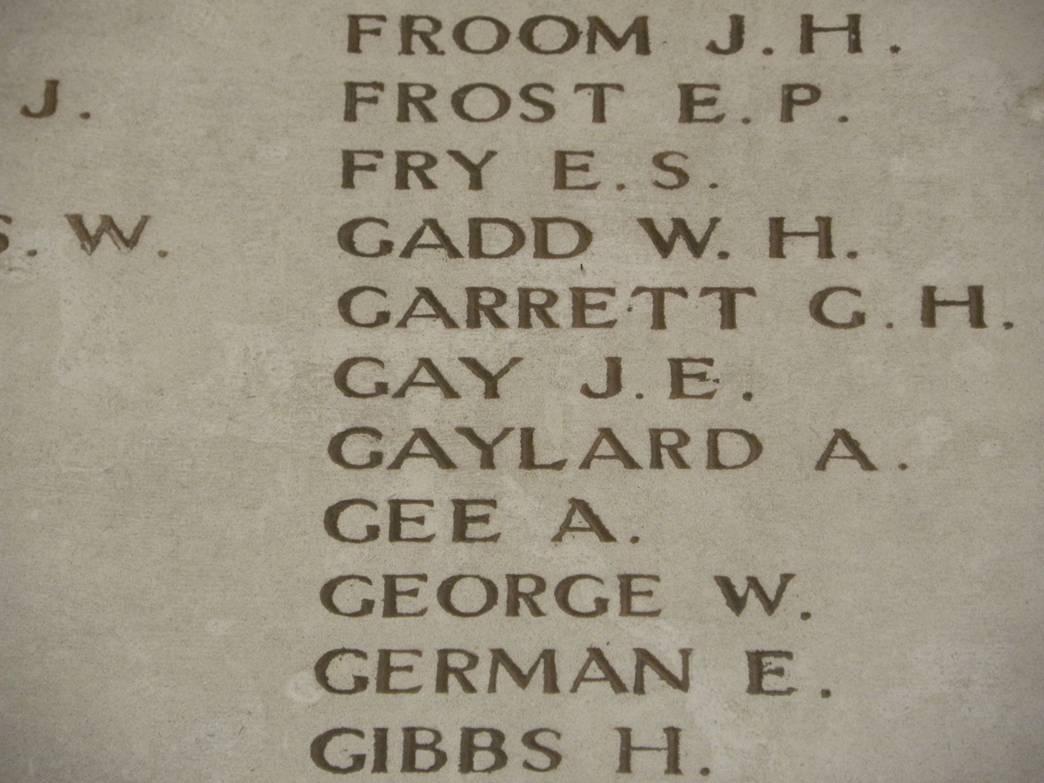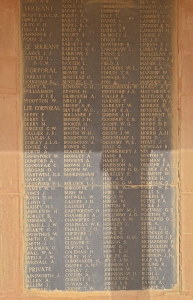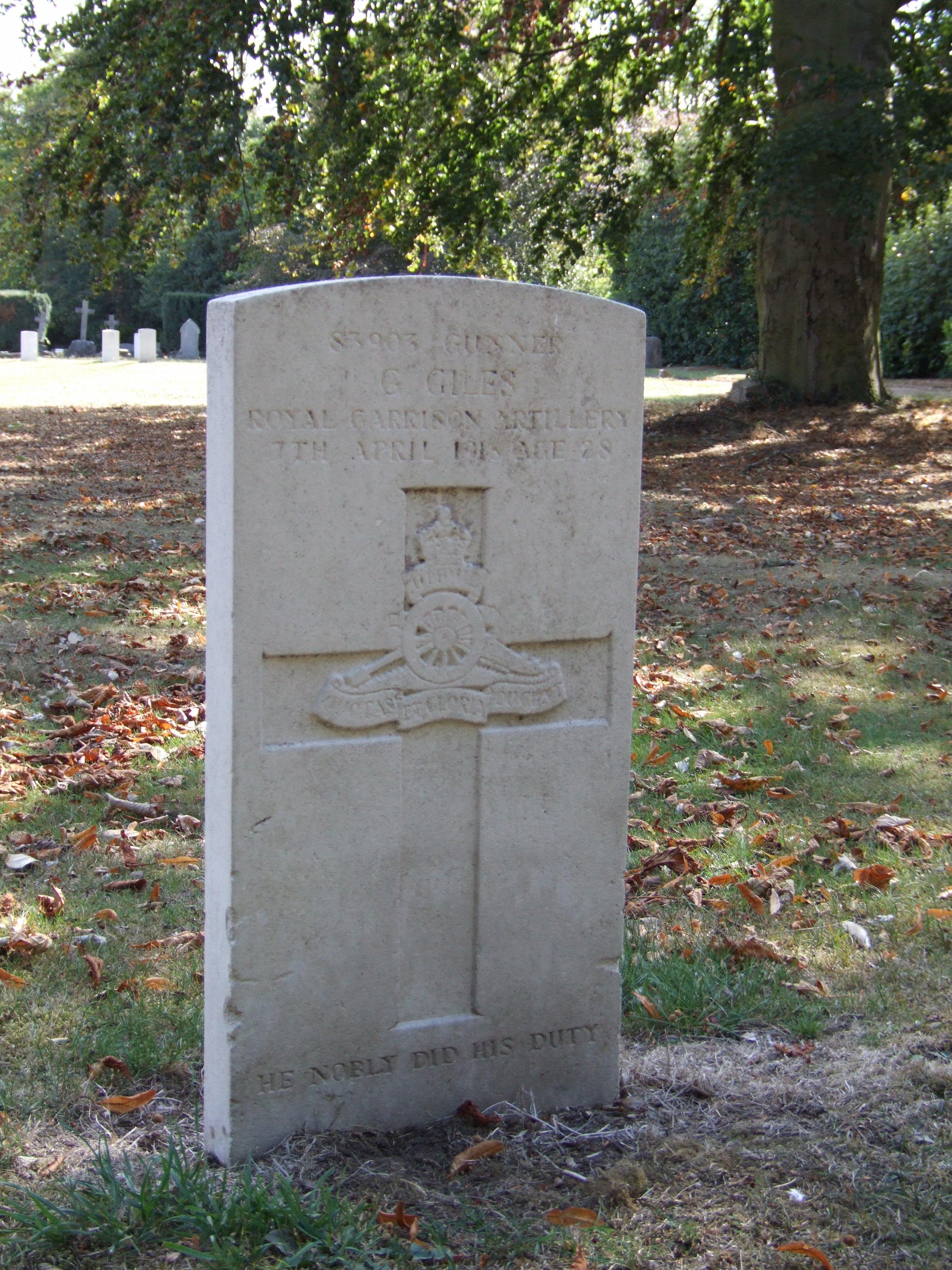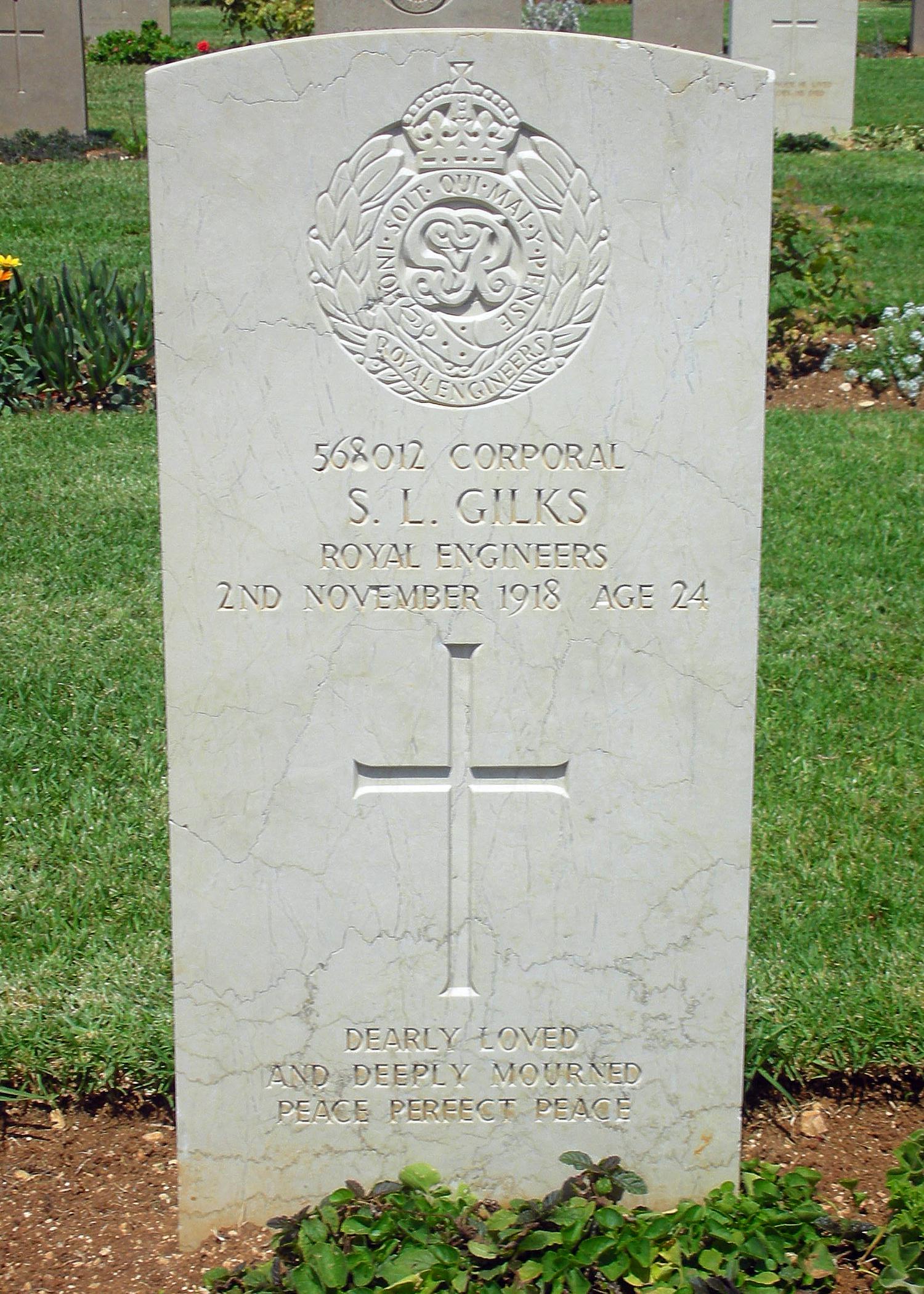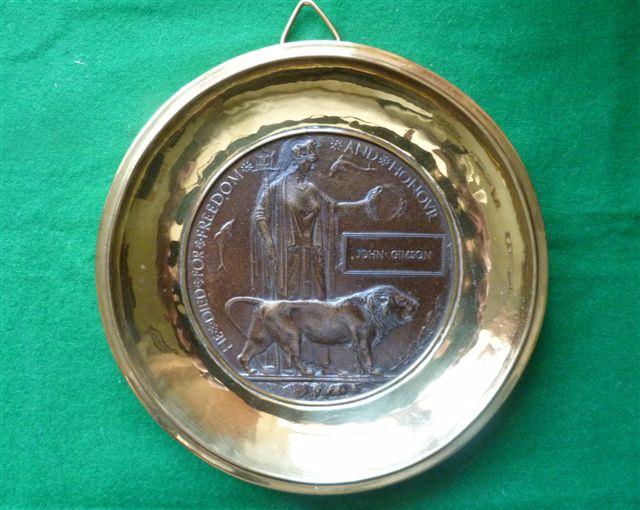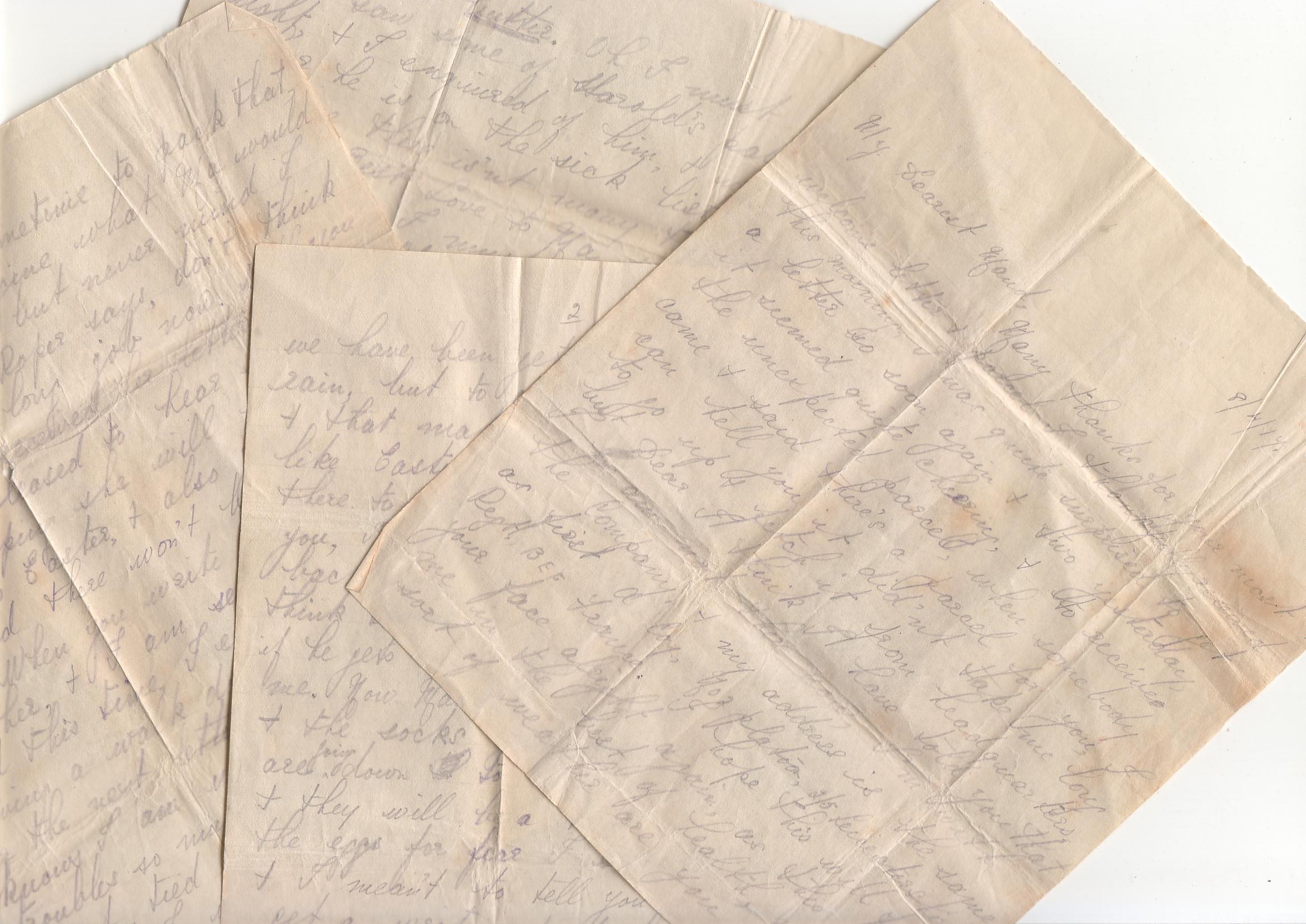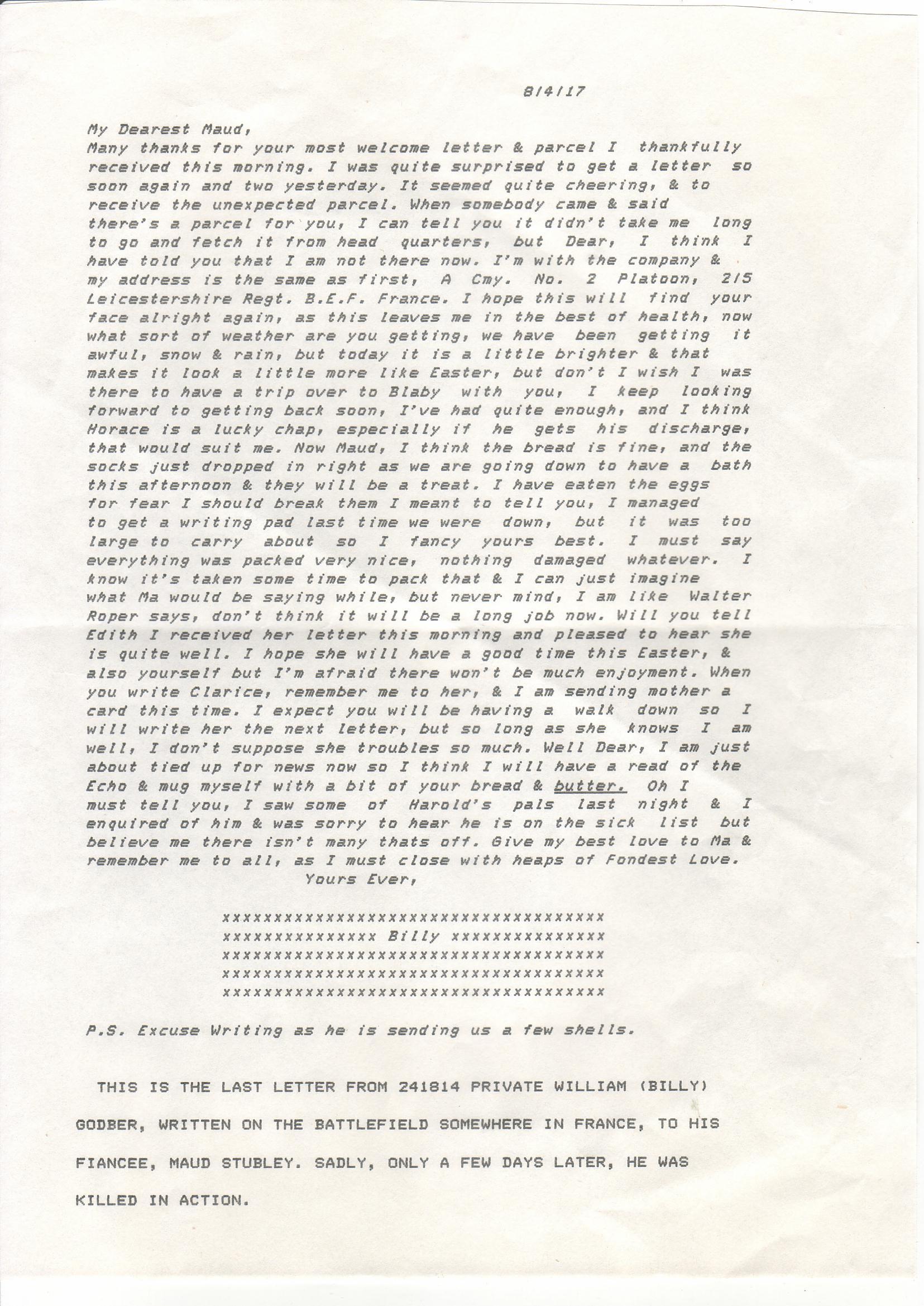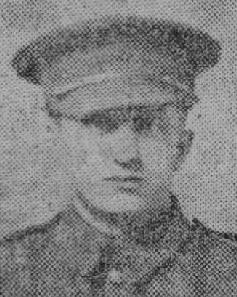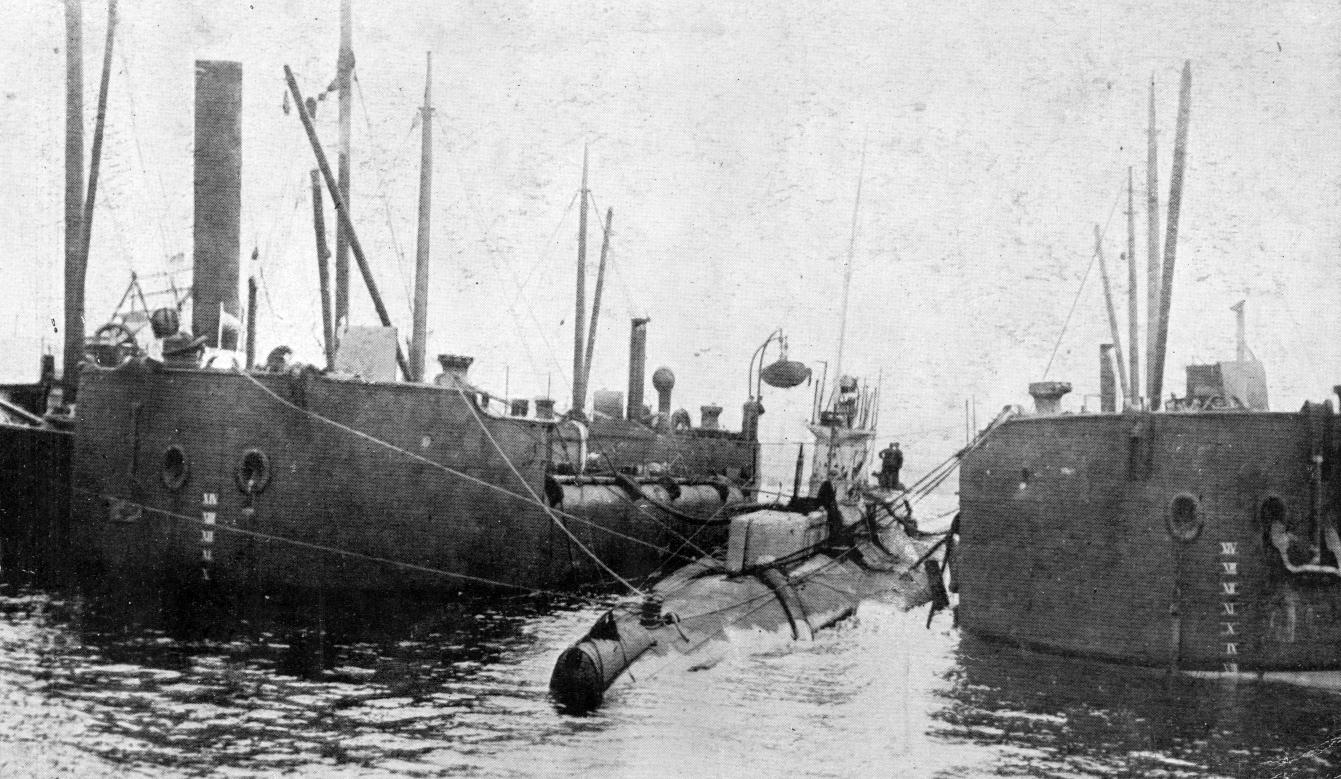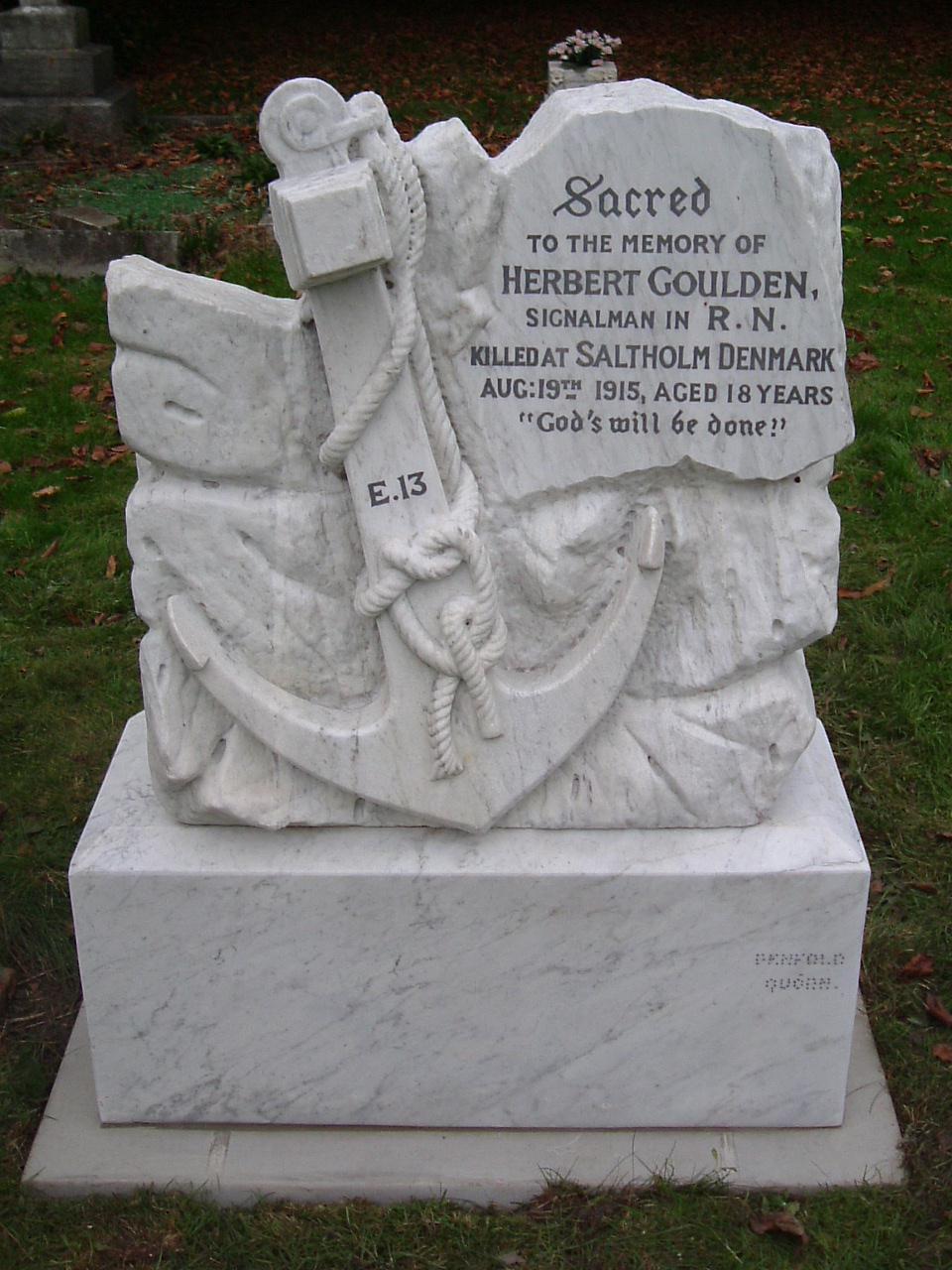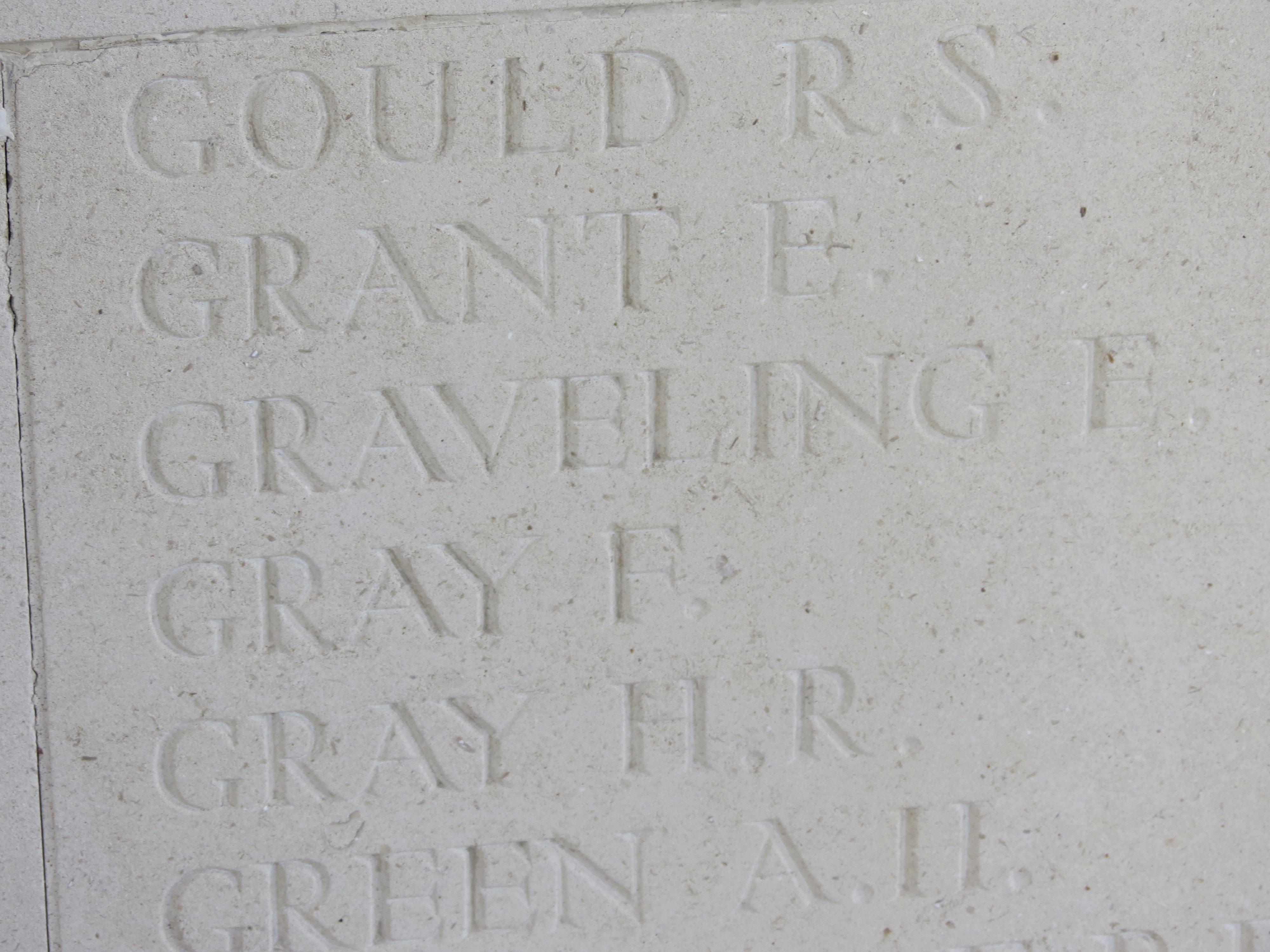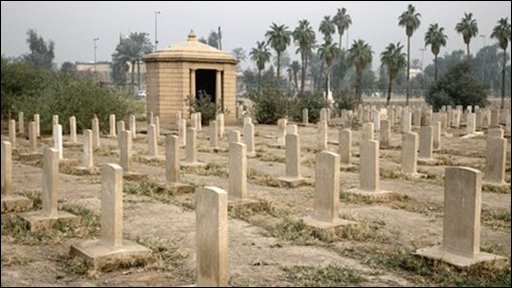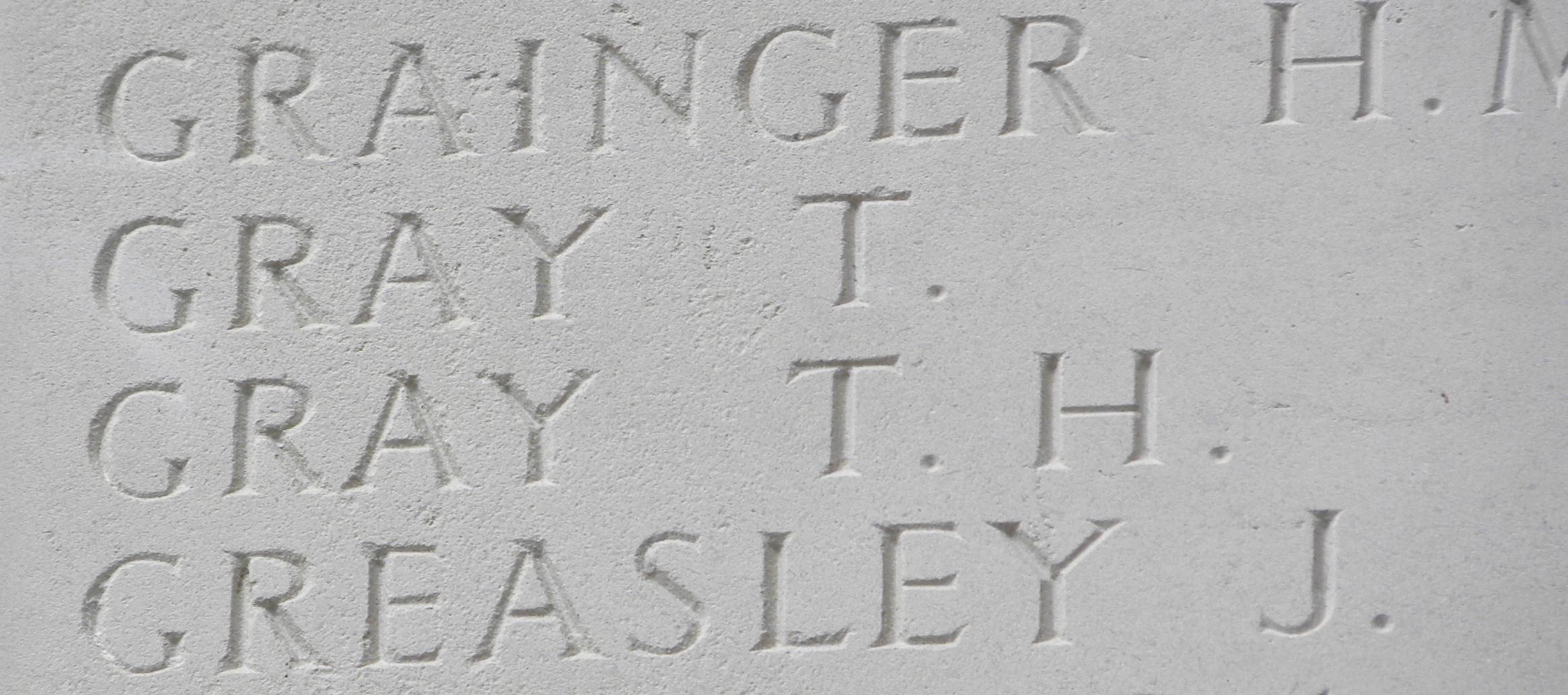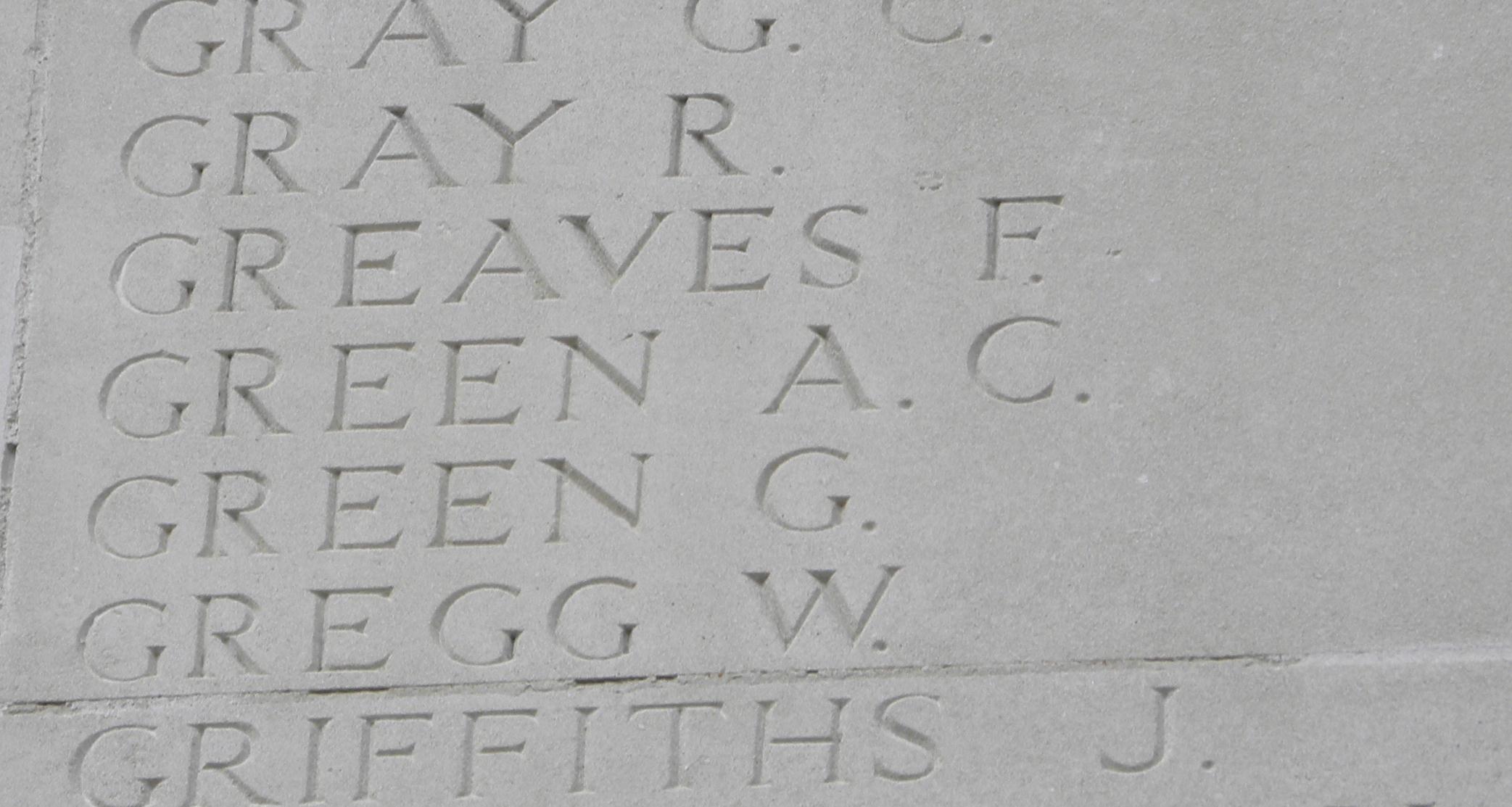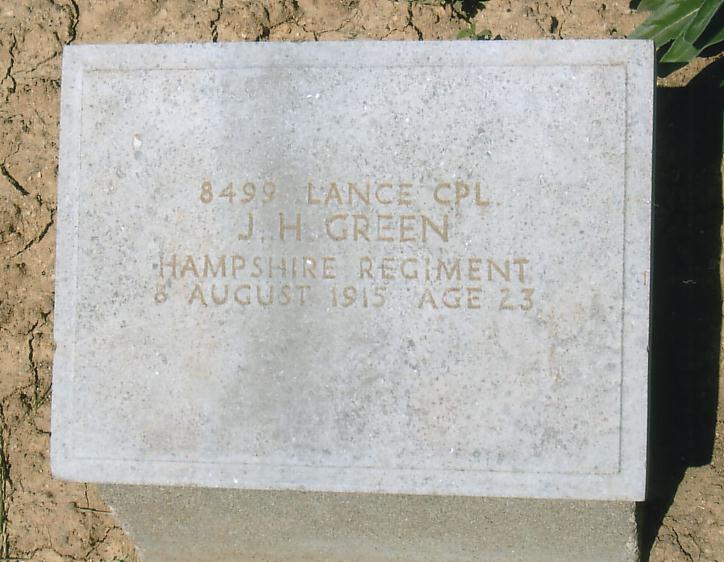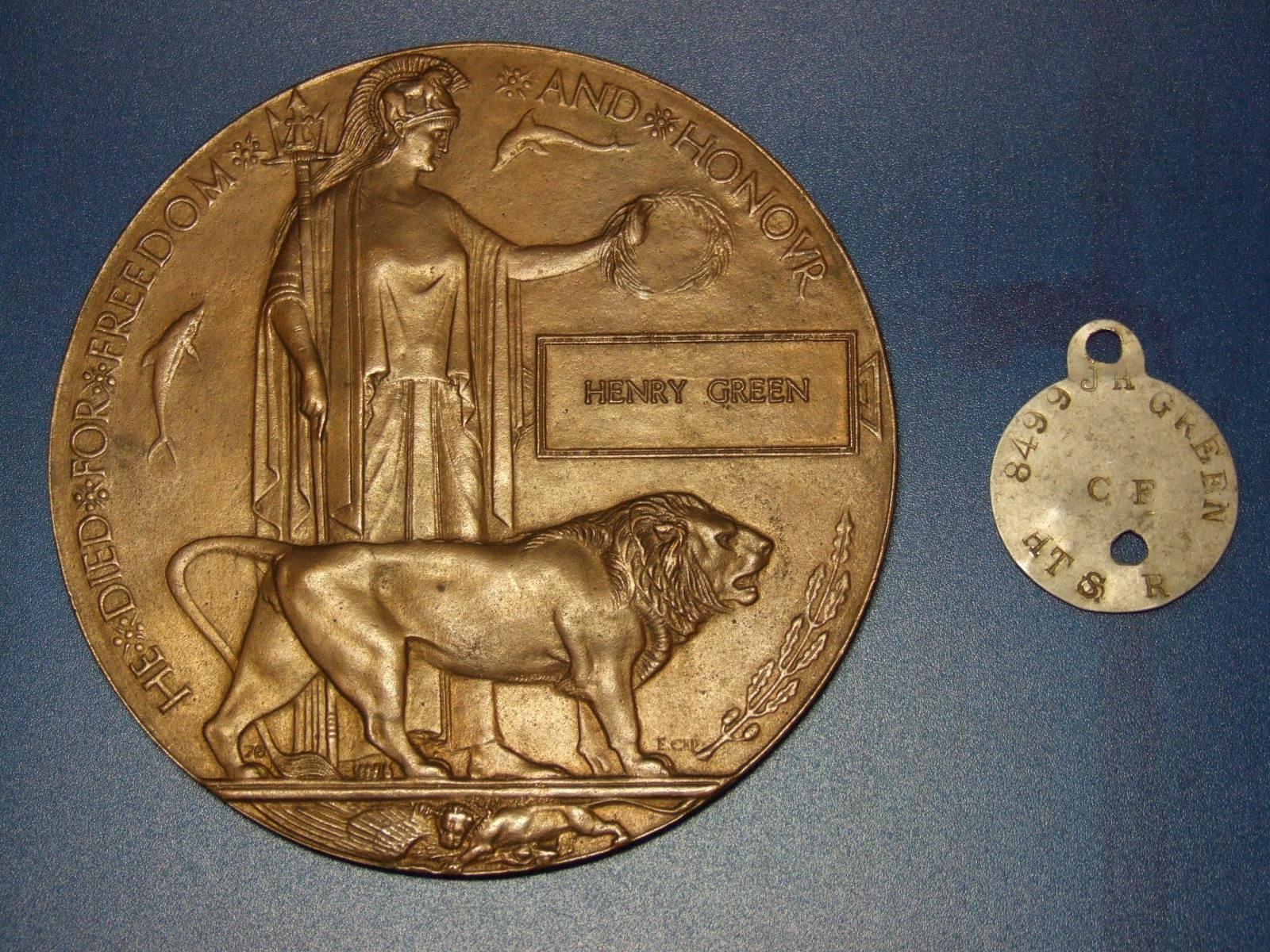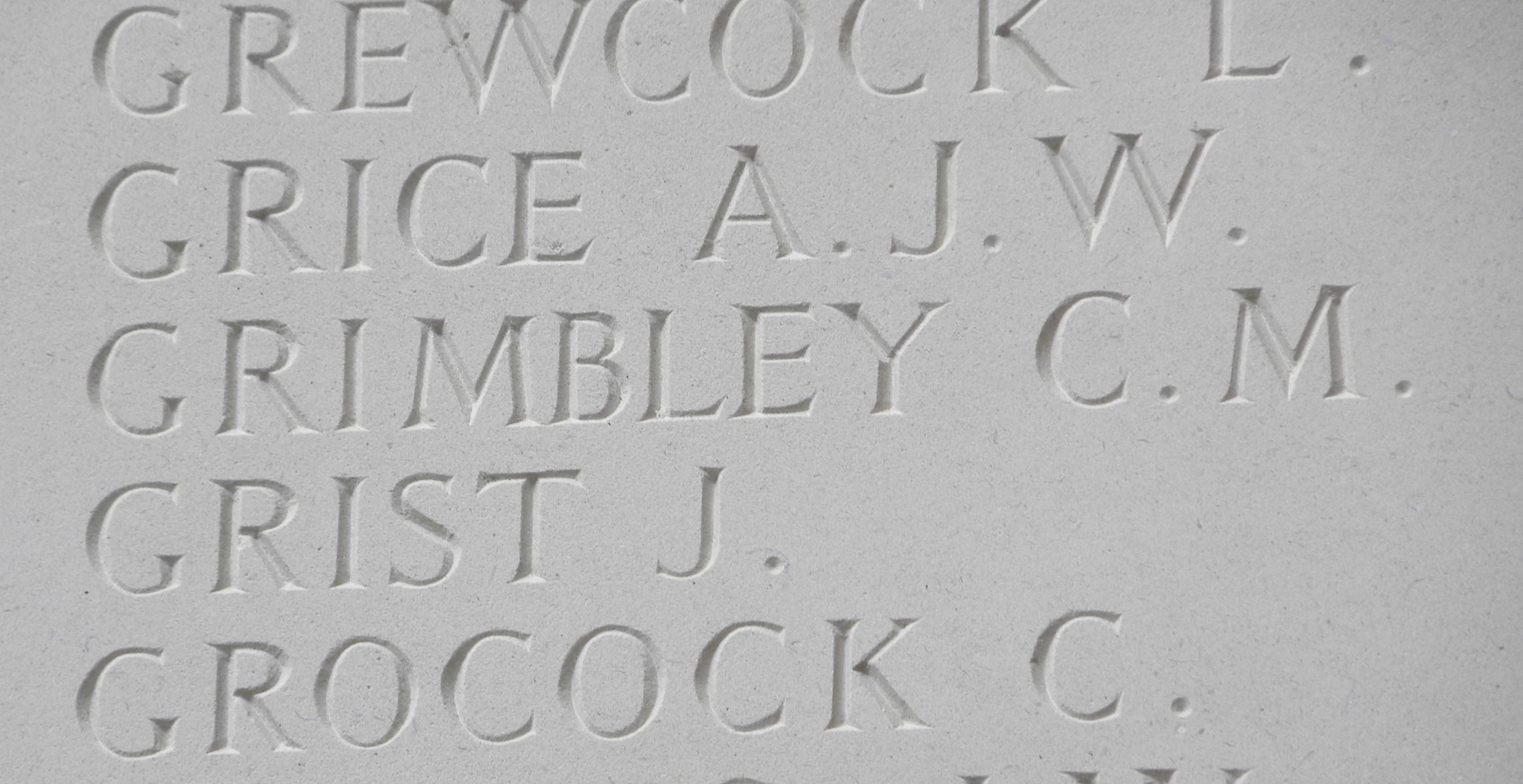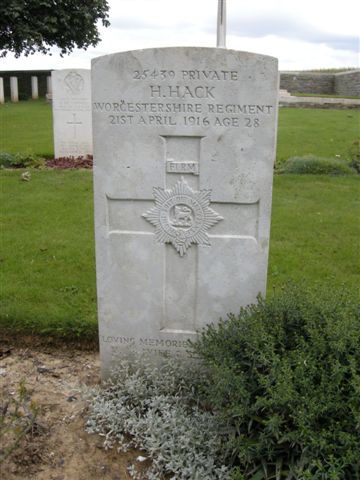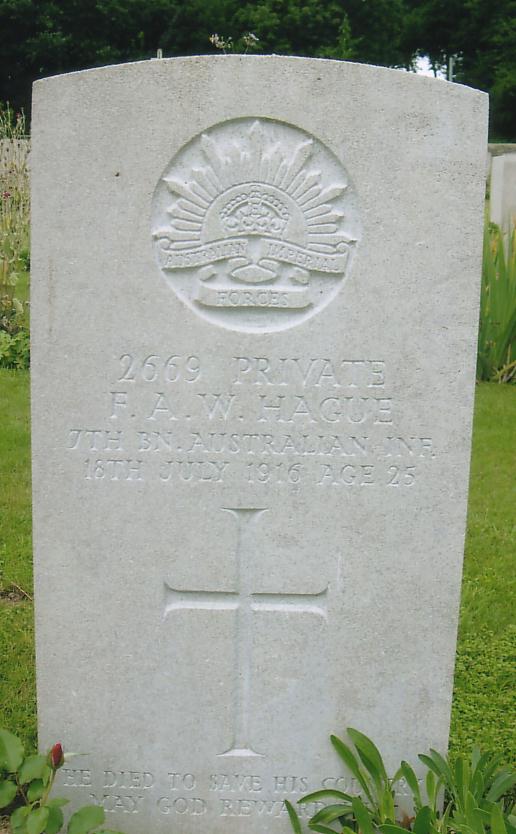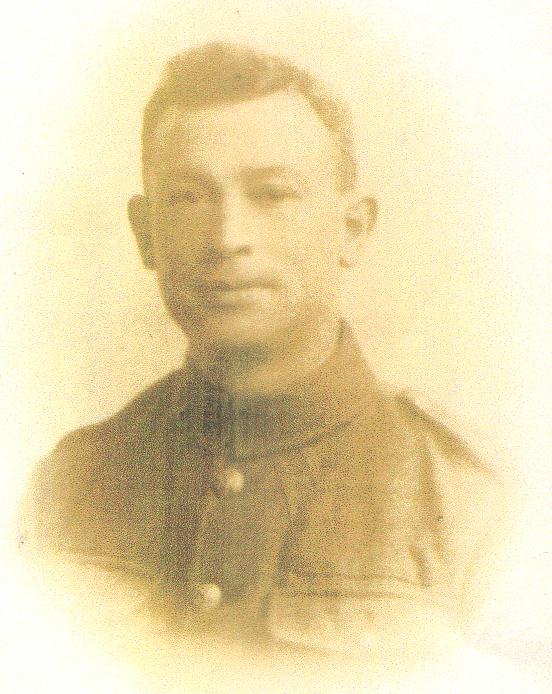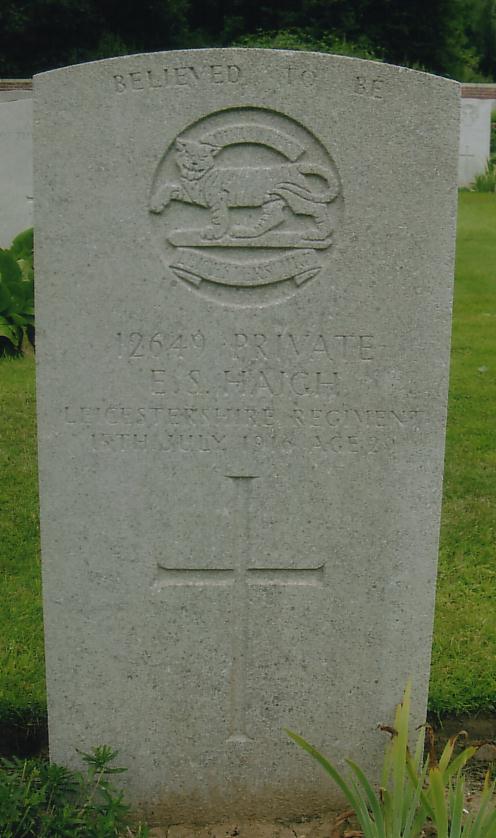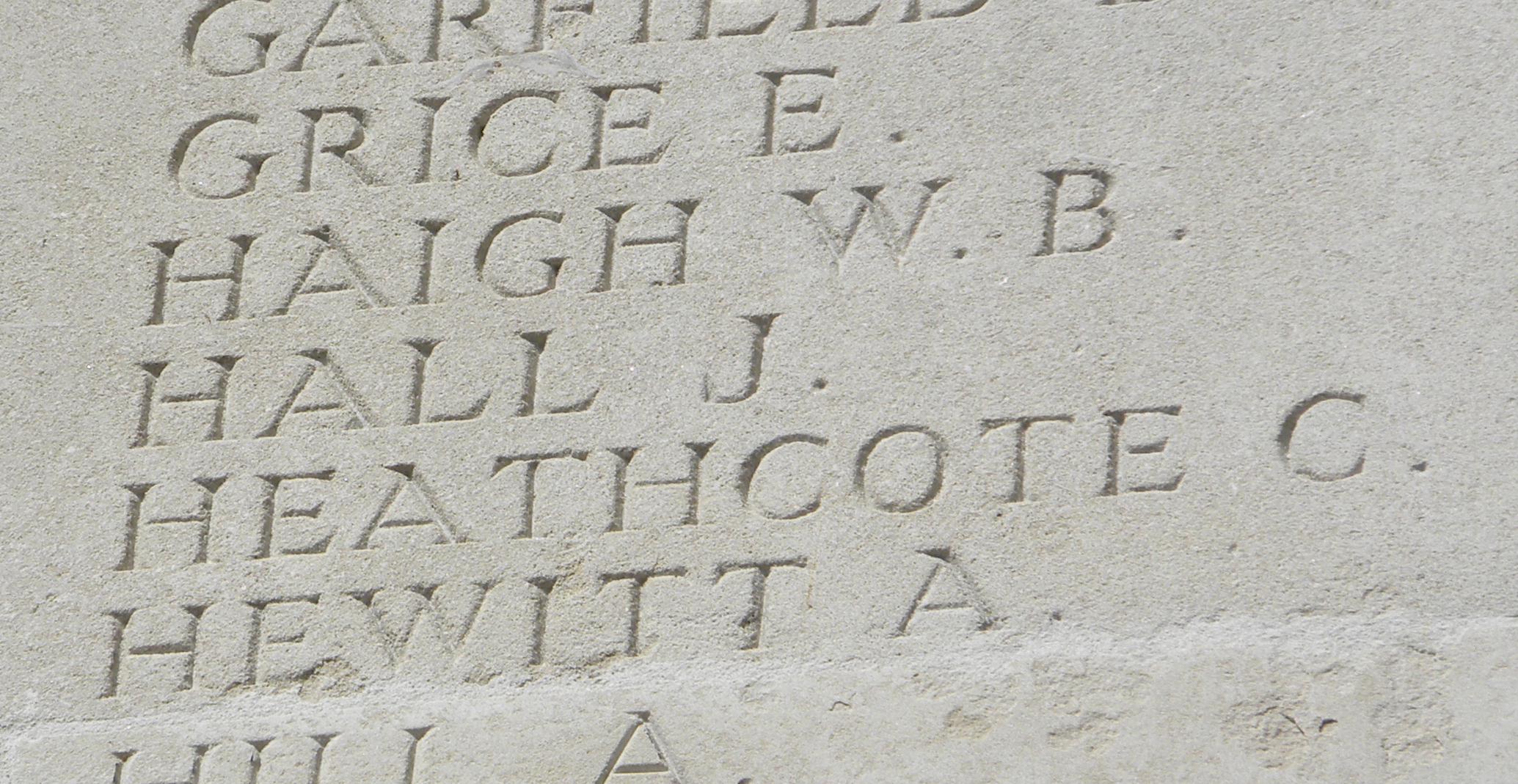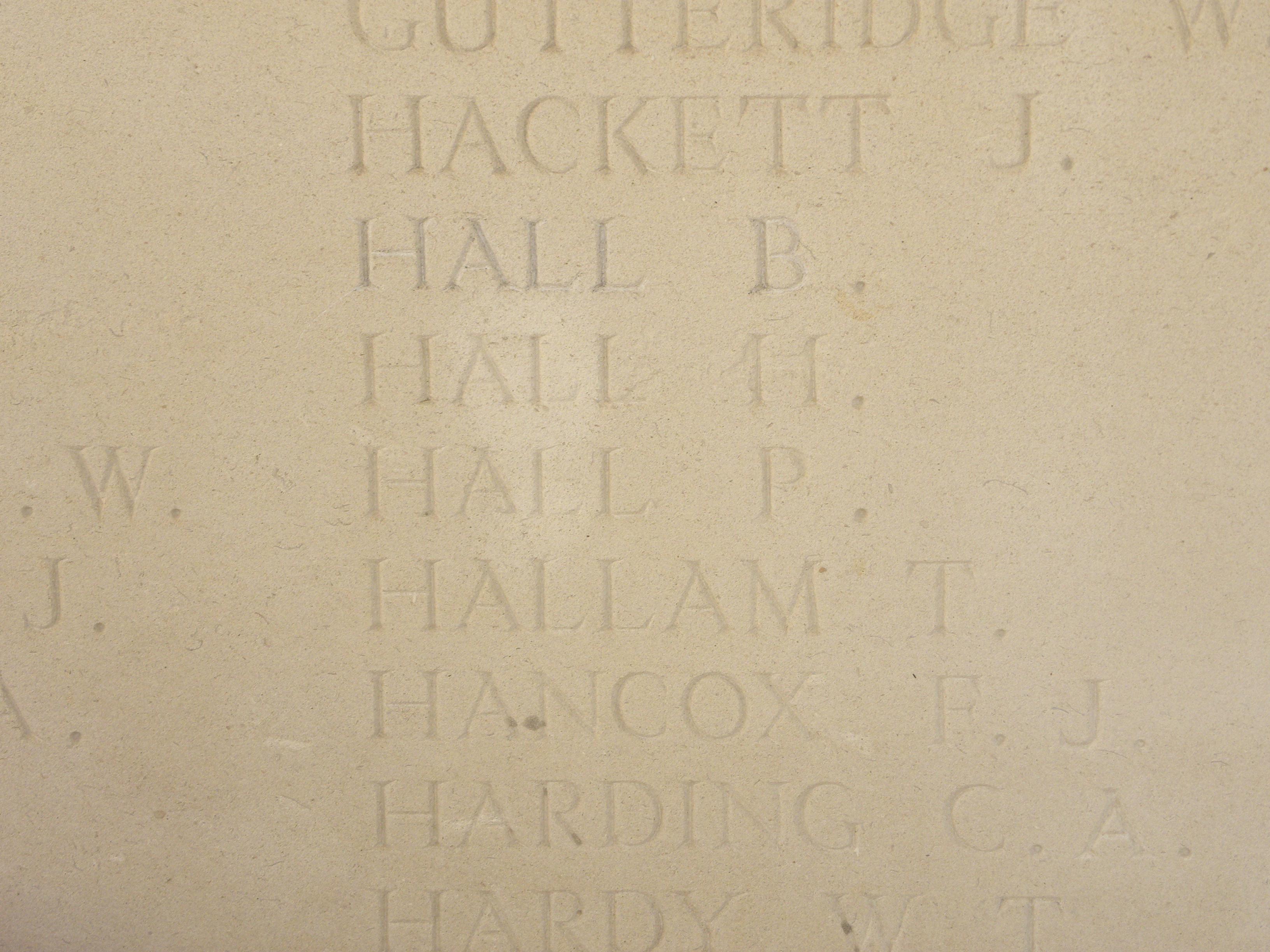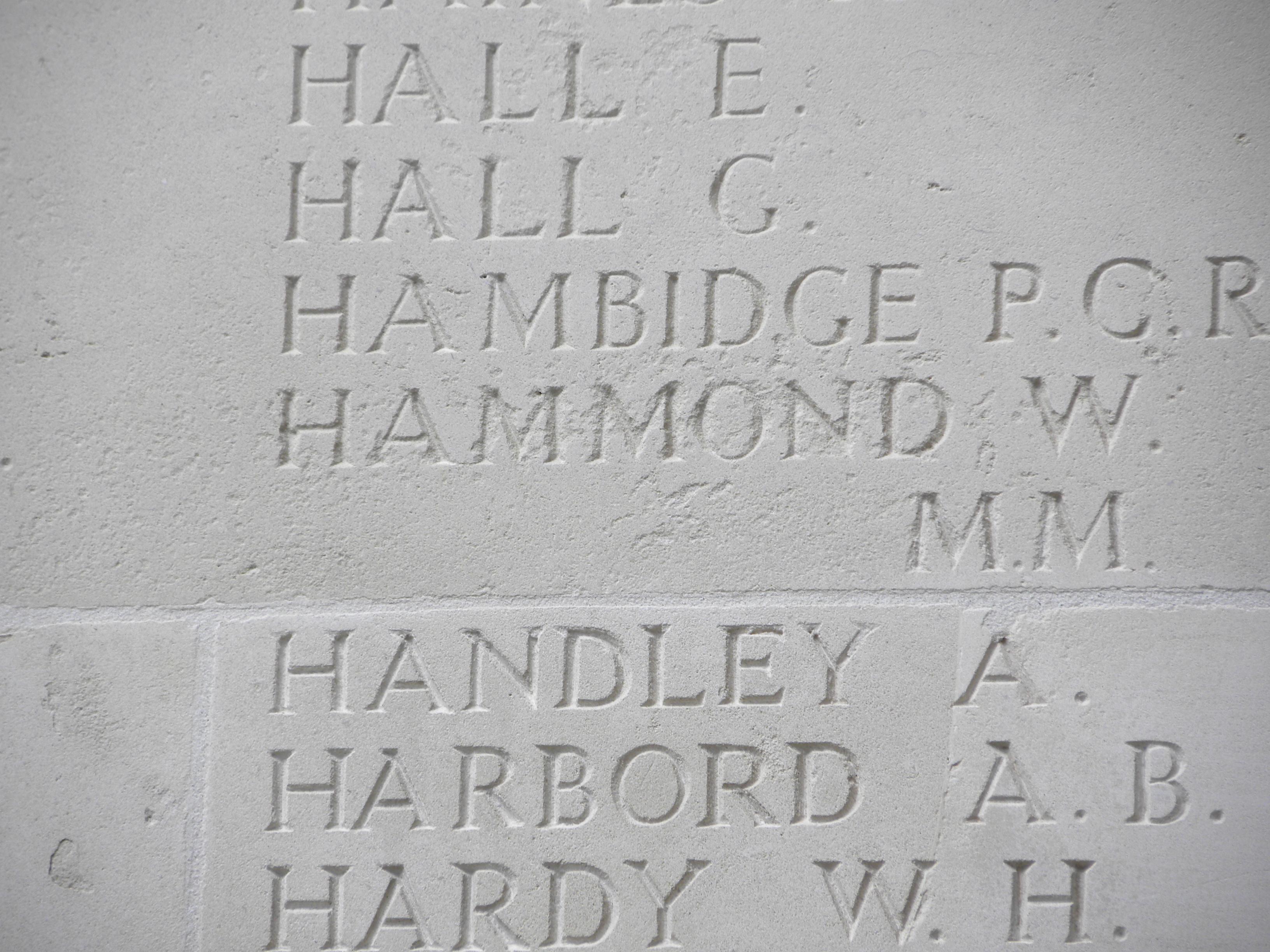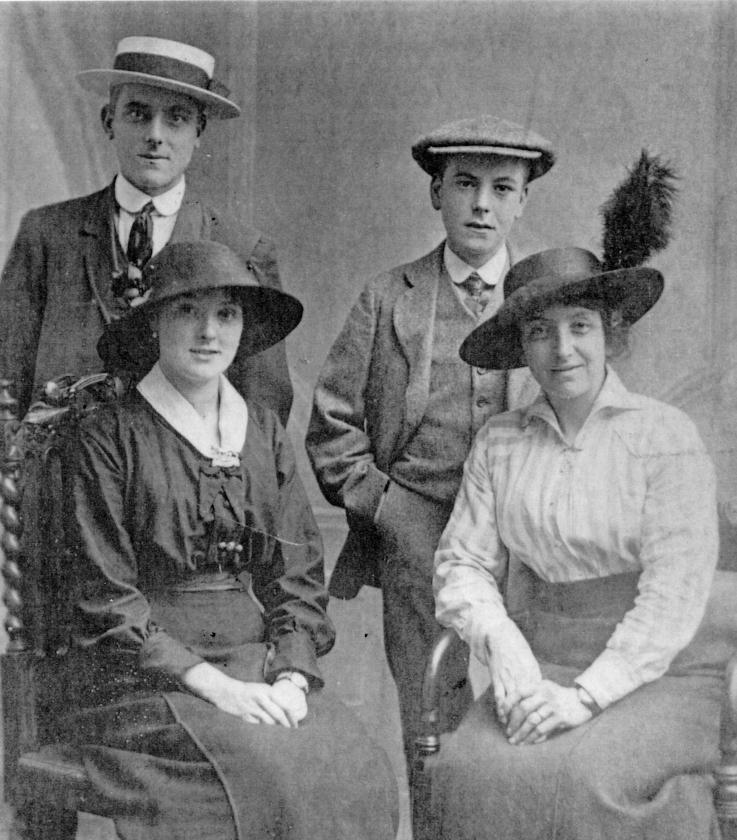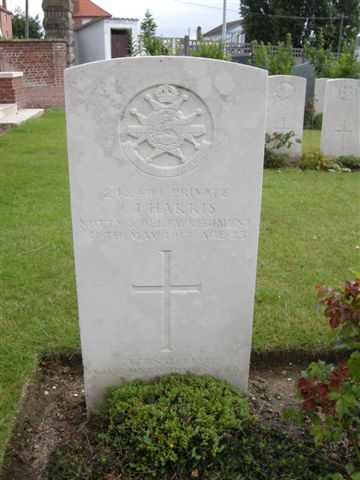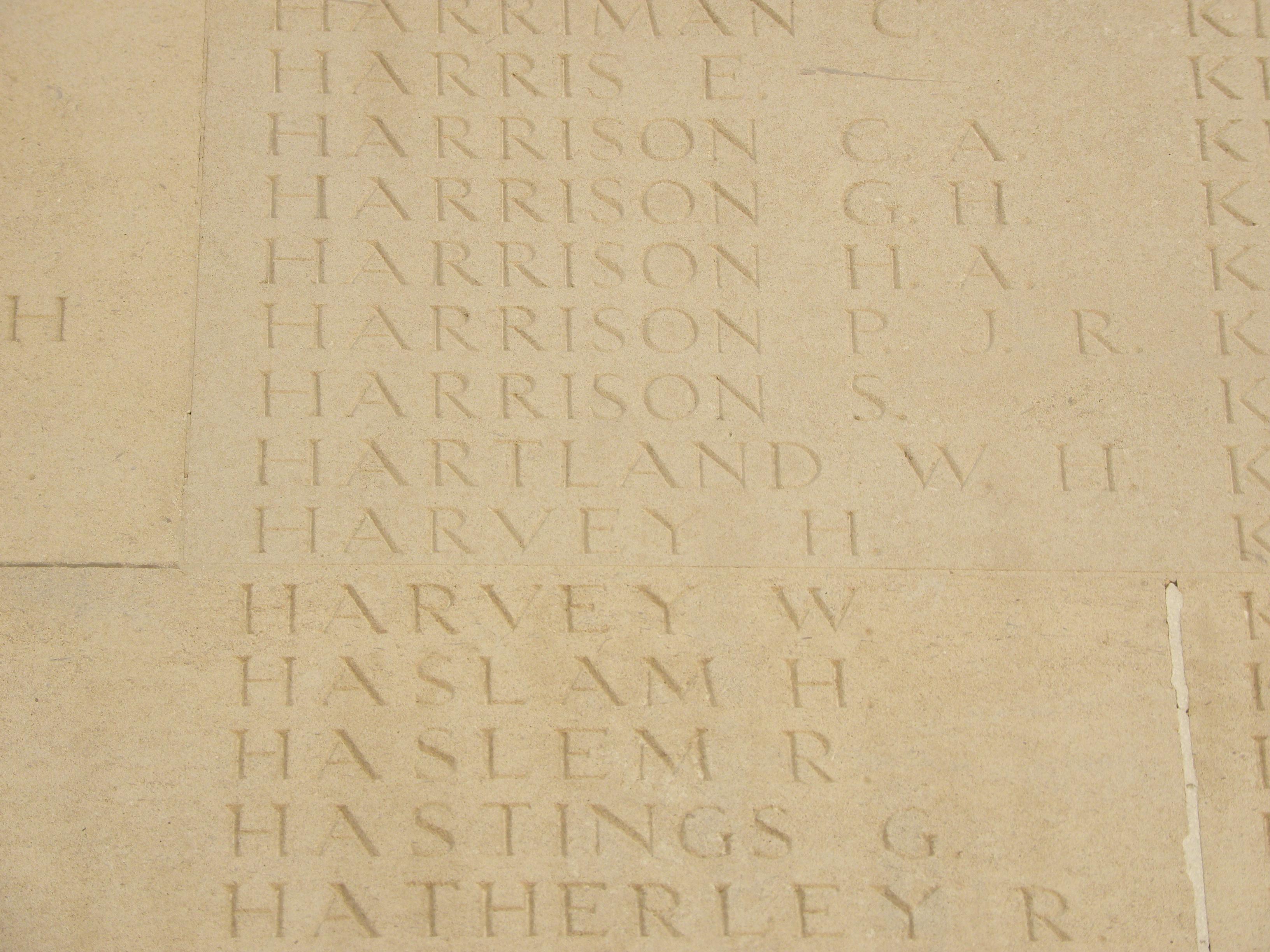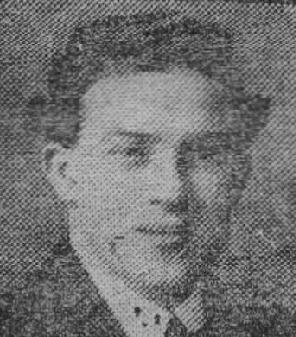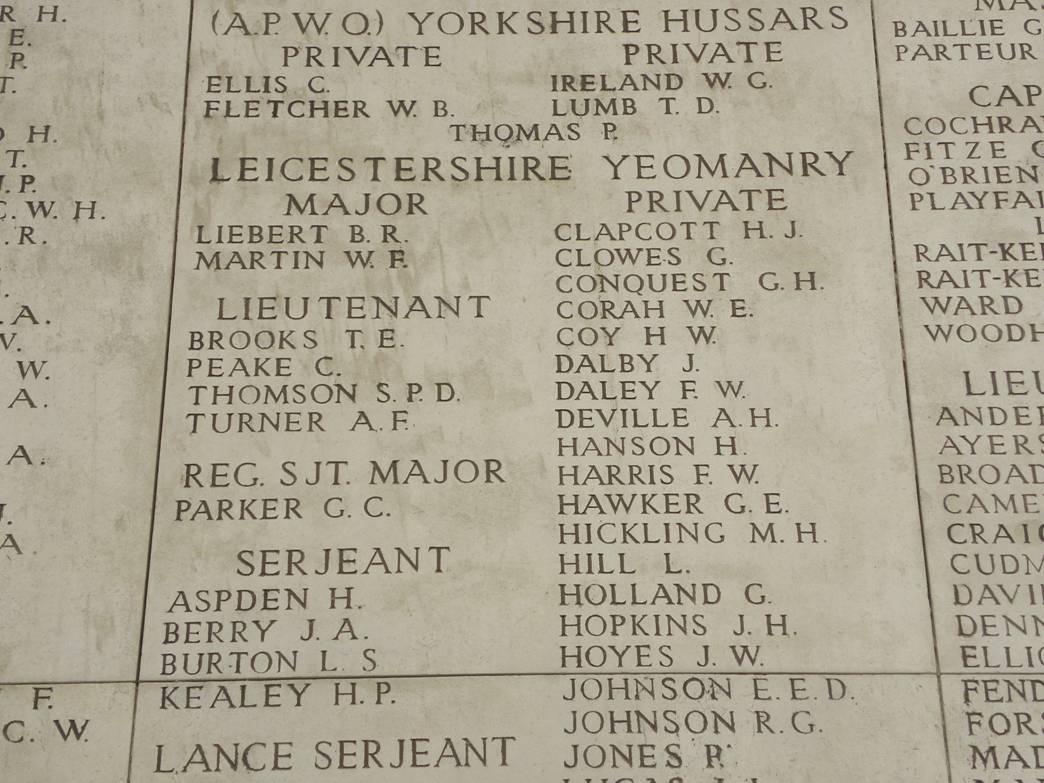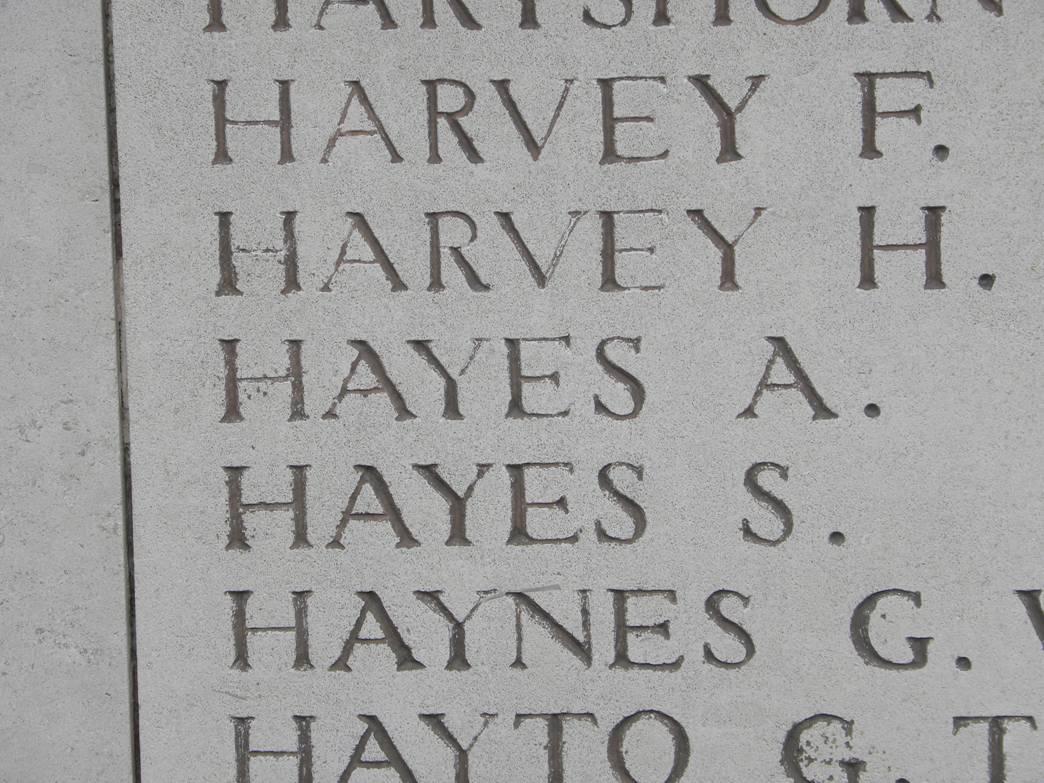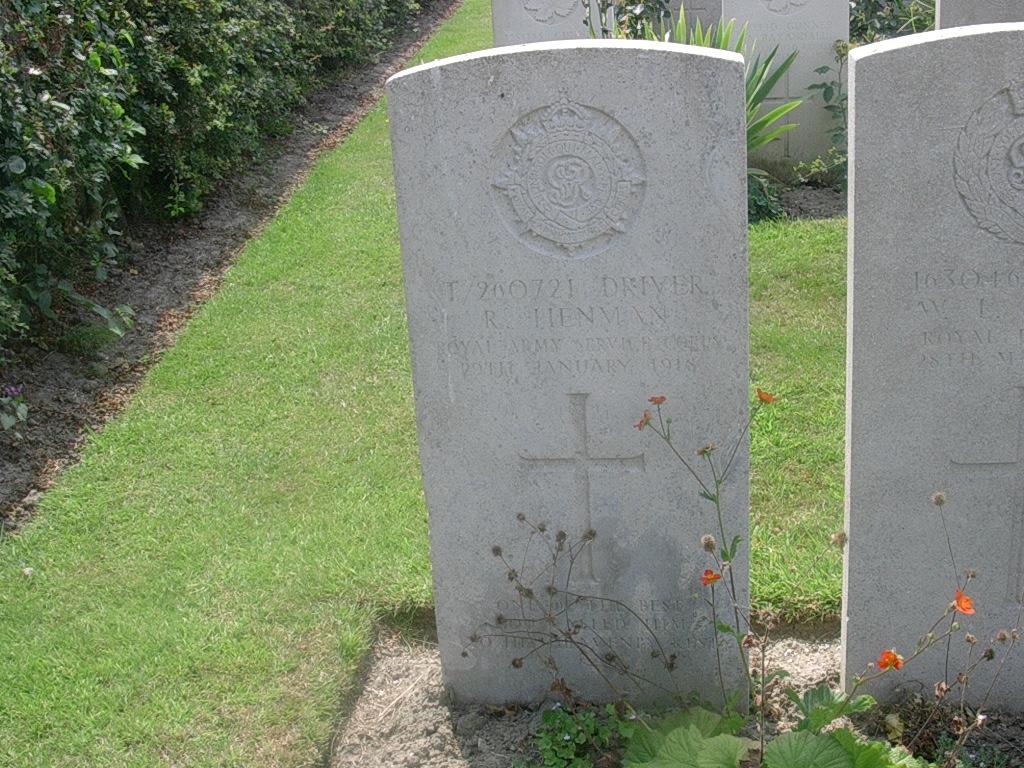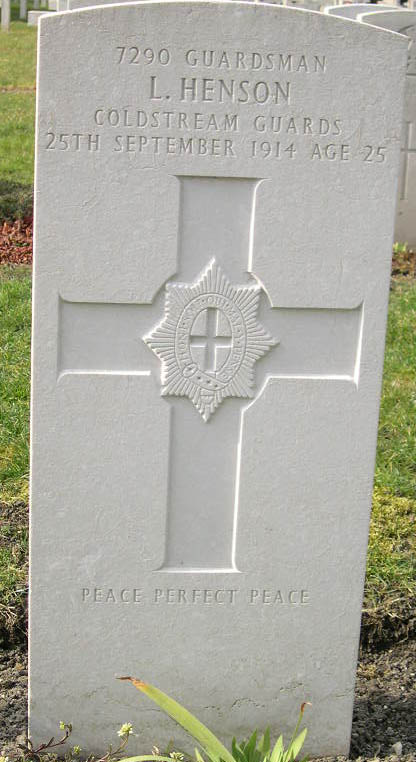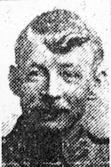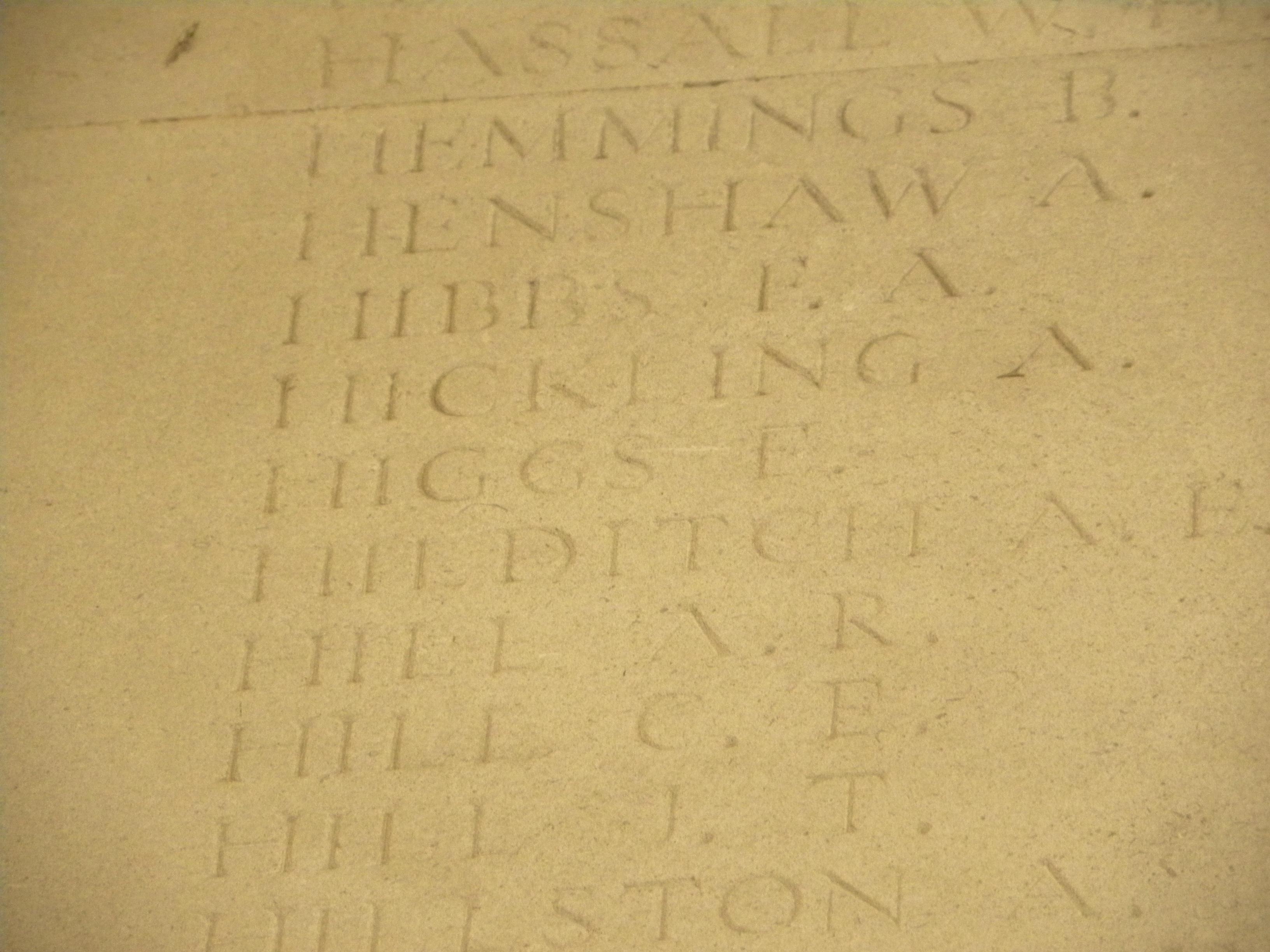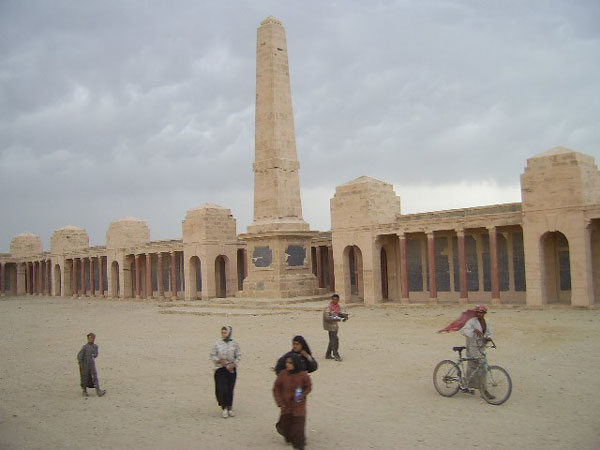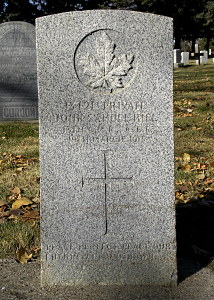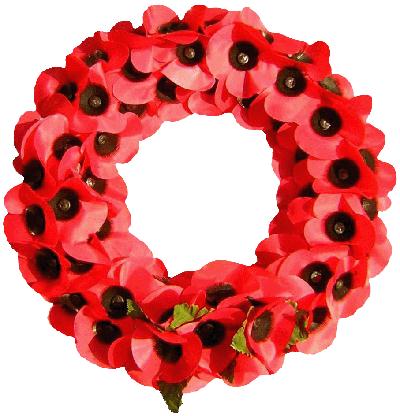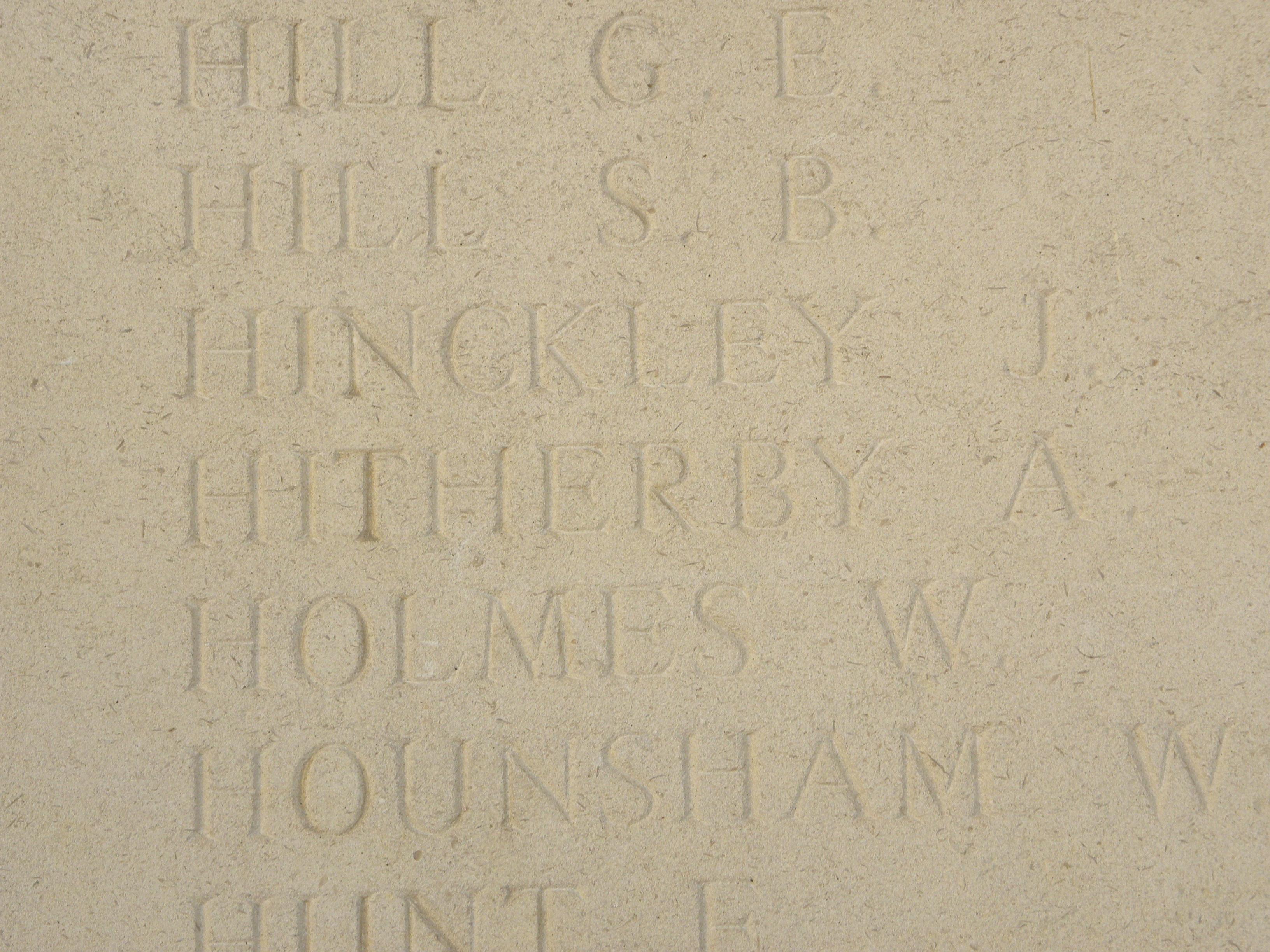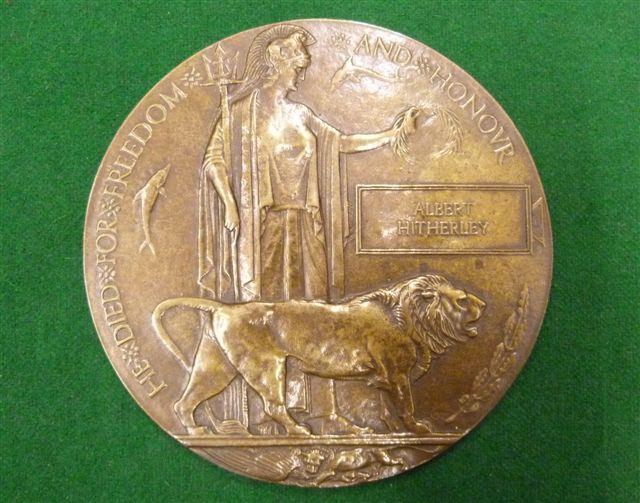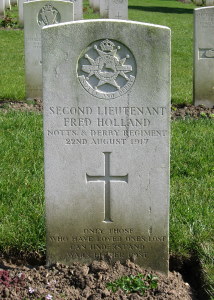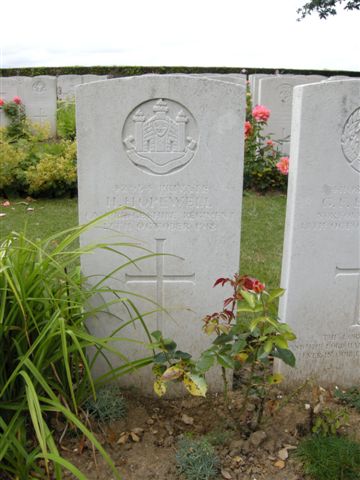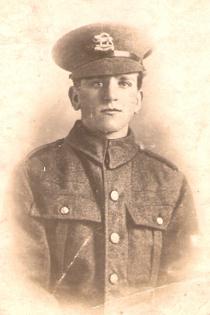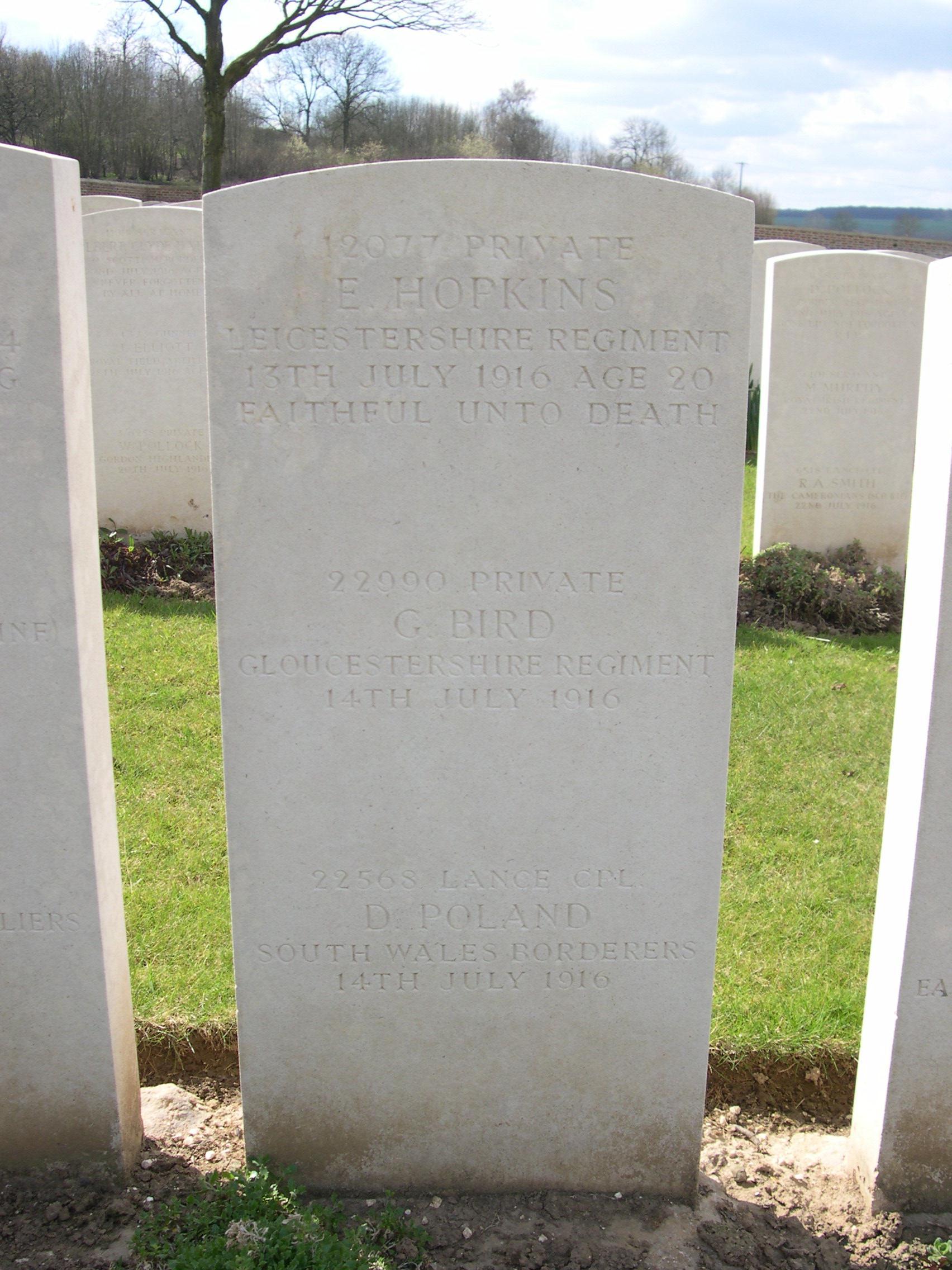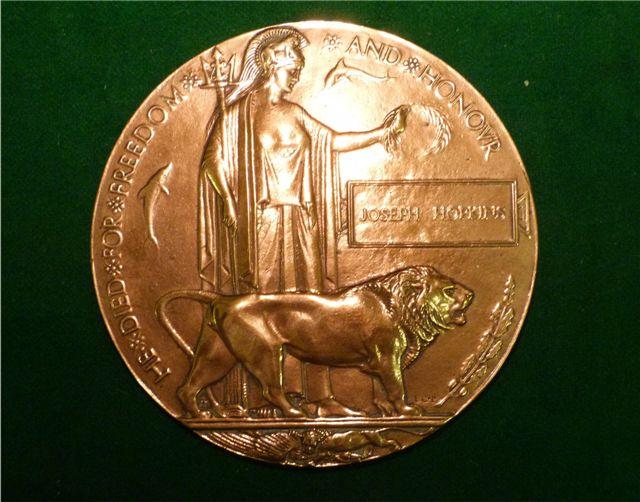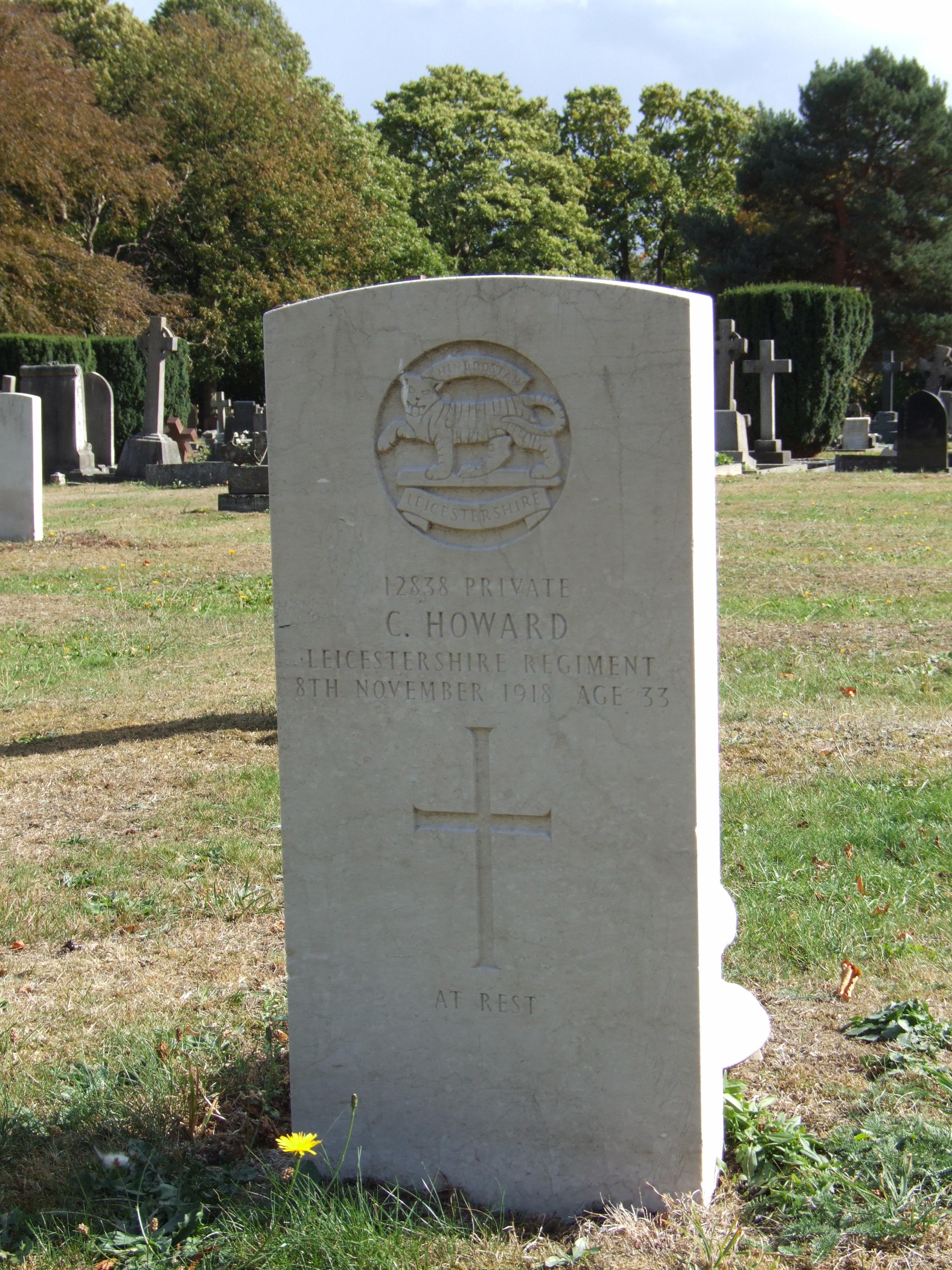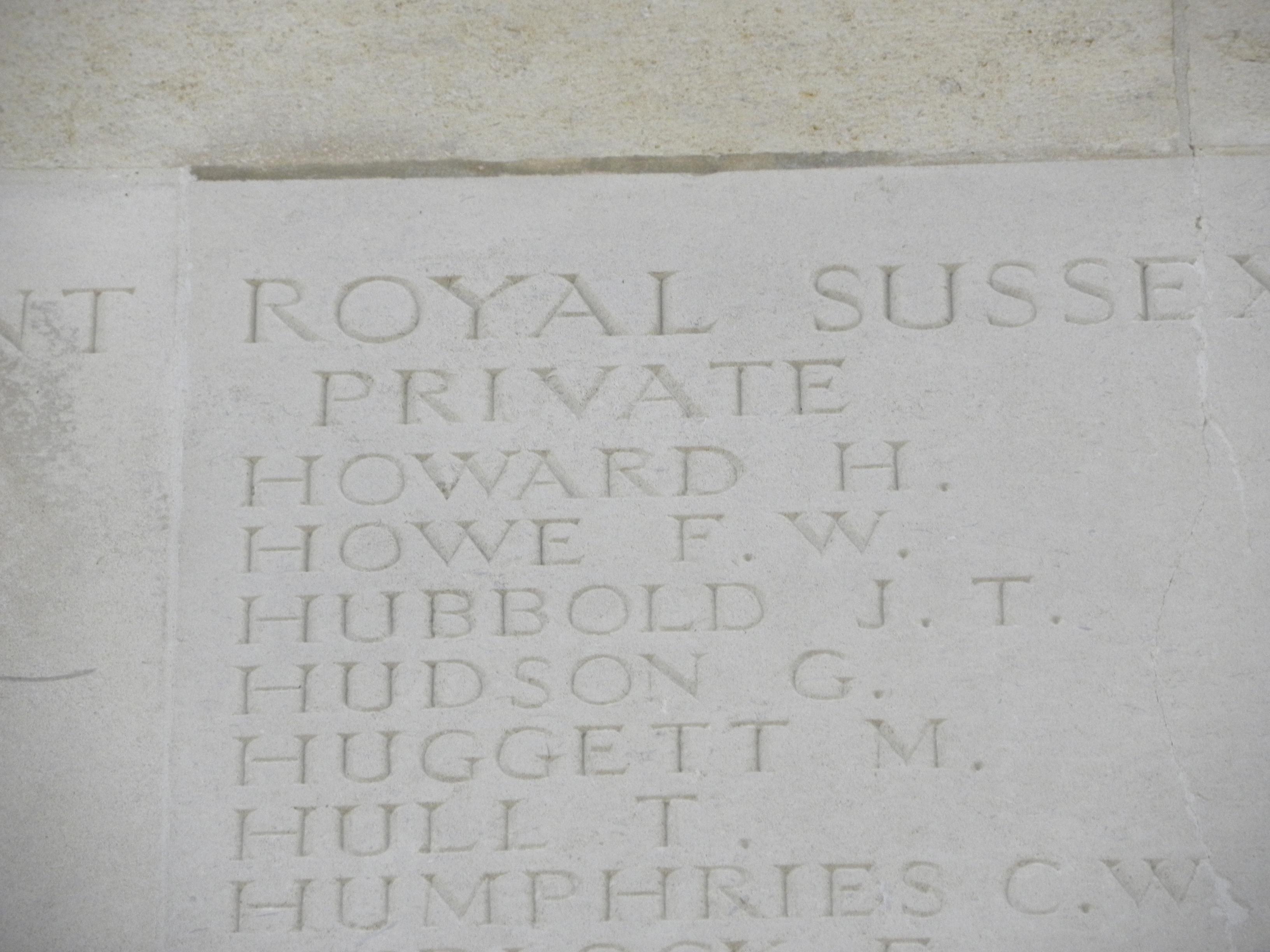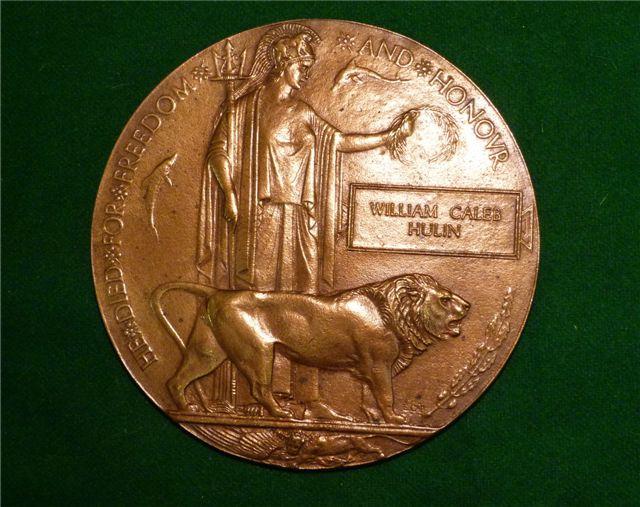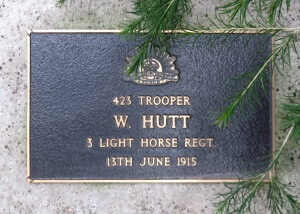|
Private 107512 Ernest James John Ganley
|
|
1st Bn, Sherwood Foresters (Notts & Derby)
Killed in action 27th May 1918, Aged 18.
Commemorated Soissons Memorial, Aisne.
|
Ernest James John Ganley was born in Bushbury, Staffordshire, on 5th July 1899. He was the eldest son of Alexander Ganley and his wife Marguerite (née Brockbank) who were married in St. Helen's, Lancashire, in 1895. In 1901 Ernest's father was an electric coil winder who later become a life insurance agent; his mother was a dressmaker. Ernest had two brothers Wilfred and Arthur and seven sisters Alice, Elsie, Eileen, Winifred, Norah, Dorothy and Hilda. Norah, however, died aged 2, in 1913. In 1901 the family lived at 17 South Street, Bushbury. In 1904, however, they moved to Loughborough, firstly living at 3 Broad Street, later at 101 Rendell Street and then at 70 Wood Gate. In Loughborough the family attended St. Mary's Roman Catholic Church.
When Ernest left school he became an apprentice spinner. In 1915 he was summoned to the Loughborough Petty Sessions Court for stealing a penny packet of cigarettes from a slot machine belonging to Ernest A. White of Ratcliffe Road. He had used a counterfeit brass disc in the machine. As, however, he expressed regret to the Court for what he had done he was acquitted and only had to pay costs.
Ernest enlisted in Loughborough on 7th October 1916. Assigned to Army Reserve he was not mobilised until 26th July 1917 when he was sent to the 87th Training Reserve Battalion. Under one month later, on 22nd August he was posted to the 15th Training Reserve Battalion and on 26th September transferred to the 246th Infantry Battalion at Thoresby Park, Nottinghamshire. On 1st November he was again transferred, this time to the 51st (Graduated) Battalion of the Sherwood Foresters (Notts & Derby Regiment) at Doncaster.
Ernest was granted leave from 2nd-6th March 1918 and not long afterwards, on 5th April 1918, he was sent to France as Private 107512 to join the 1st Battalion of the Sherwood Foresters. He joined them at Hangest-en-Santerre where the battalion was undergoing reorganisation. On 12th April the battalion entrained at Hangest for St. Roche station, Amiens, and marched into Corps Reserve at Querrieu. On 15th April they moved to Blangy and two days later to Blangy-Tronville. On 19th April the battalion went into the front line trenches at Villers-Brettoneaux.
Relieved on 23rd April they marched to Blangy-Tronville but on the following day were ordered to march to Blangy Wood and attack Villers-Bretonneaux. The battalion met the enemy in the Bois l'Abbé where a line was taken up. They held this line for three days and succeeded in extending it by 630 yards to the right. Relieved on the evening of 27th the battalion marched to bivouac in Blangy Wood. On the following day they proceeded to billets in Camon to clean up and rest.
On 2nd May, after an overnight stay in billets in Clairy-Saulchoix, the battalion entrained at Saleux station for Fismes and marched to huts south-west of Chéry-Chartreuse. Training took place at Chéry on 7th and 8th May, followed by a three-day move via Magneux and Rucy to take up the support position at Juvincourt. The battalion then held the front line from 17th-24th May but after being relieved had only been in rest billets at Ventelay for two days when they were ordered forward to Roucy and then to the Aisne line. The Allies had just received information about an impending German attack. On 27th May, the first day of the 3rd Battle of the Aisne, the battalion suffered heavy casualties and Ernest, aged 18, was killed in action.
Ernest's body was never found and he is commemorated on the Soissons Memorial, Aisne. He is also remembered on the memorial in St. Mary's Church, Loughborough, and on the Carillon.
|
|
|
|
Private 54874 John Eli Gay
|
|
16th Bn, Welsh Regiment.
Formerly 35929 Essex Regiment.
Killed in action 1st August 1917, Aged 24.
Commemorated Ypres (Menin Gate) Panel 37
|
John Eli Gay was born in St. Pancras, London, in late 1892 or early 1893. He was the son of Eli Gay and his wife Lucy Agnes (née Clare) who were married in Brighton in 1890. John's father was a Royal Mail driver and in 1901 the Gay family lived at 38 Lismore Road, Gospel Oak, London. By 1911 they had moved to no. 36 in the same road. John had one younger brother William and two sisters Mary and Maud. In 1911 John was an unemployed plumber but by the following year he had obtained employment as a gasfitter's assistant.
On 22nd December 1912 John married Mary Josephine Jessie Charlton at St. James' Church, Hampstead Road, London, and by 1915 they had two children Elsie and Frederick both born in London.
The exact date of John's enlistment is unknown as his service papers have not survived, but it seems likely to have been in the summer of 1916. He joined the Essex Regiment as Private 35929 and was subsequently transferred to the 16th (Cardiff City) Battalion of the Welsh Regiment as Private 54874. The date on which he was sent to France is also unknown although it is likely that he was in a draft of reinforcements joining the 16th Battalion in Boesinghe, a village north of Ypres, on 14th December 1916.
From mid-December 1916 until August 1917 the battalion mostly remained in the Boesinghe sector, apart from two weeks training at Merckeghem in both January and May 1917 and a further two weeks training at Febvin-Palfart in June. In the Boesinghe sector the battalion did front line trench tours, repaired and improved trenches and supplied working parties to assist the Royal Engineers.
On 31st July 1917 Haig opened the Passchendaele Offensive with an attack at Pilckem Ridge, near Boesinghe. On the second day of this battle John was killed in action. He was 24. He is commemorated on the Ypres Menin Gate Memorial, panel 37.
John's widow Mary was remarried to Samuel A. Sutton in 1919 in Loughborough. Samuel was a former Army friend of her late husband and the couple moved to 3 Railway Terrace and then Ratcliffe Road, Loughborough. In April 1920, however, Mary filed for a separation order as Samuel ill-treated her and was violent. In 1953 she married John Henry Toms and in 1954 went with him to live in Australia.
|
|
|
|
Private 37741 Edward Henry Genever
|
|
6th Bn, Leicestershire Regiment.
Death presumed on or since 22nd March 1918, Aged 19.
Commemorated Pozières Memorial, Somme, panel 29 - 30.
|
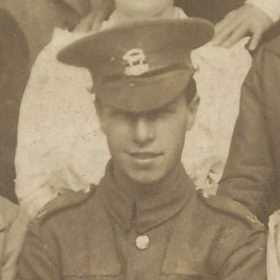 |
Edward Henry Genever was born in Loughborough on 11th August 1898. He was the son of Edward Henry Genever (Senior) and his wife Clara Ellen (née Roadley) who were married on 16th January 1895 at All Saints Church, Loughborough. Edward Junior's father was a plasterer and labourer and in 1901 the Genever family lived at 22 Pinfold Street, Loughborough, with Edward Junior's maternal grandmother Elizabeth Roadley. After Elizabeth Roadley died in the summer of 1901 the Genever family moved to 42 Union Street. Edward Junior's parents later moved to 37 Broad Street. Edward Junior had two brothers Leonard and Victor and two sisters Daisy and Lily.
The Genever and Roadley families were Loughborough-based over several generations but also had strong connections with New Zealand and Australia. Edward Junior's maternal grandmother Elizabeth Roadley had been born in Cox River, Australia. His paternal grandfather Edward Genever had emigrated with his wife Elizabeth in the early 1870s to the South Island of New Zealand and become manager of the Dunedin Gas Light and Coke Company. He subsequently worked in Waterloo and Haverley, New South Wales, Australia and died there aged 36. After he died his widow returned to Loughborough with all her children except one daughter Mary who married an Australian.
When Edward Junior left school he was employed at the Nottingham Manufacturing Company Ltd as a trimmer. He had been there for over four years when he enlisted on 3rd March 1917 and joined the Leicestershire Regiment as Private 37741. Edward's service record has survived but some of it is damaged and unreadable and where he was sent for his initial training is unknown. On 18th August 1917 he was transferred to 9th (Service) Battalion and on 23rd November 1917 was posted to 6th (Service) Battalion in France.
The 6th Battalion of the Leicesters received drafts of reinforcements on 24th, 27th and 28th November 1917 while they were at Coupigny and then in training at Monchy-Breton. On 30th November the battalion received sudden orders to march to Savy and entrain for Tincourt. From there they marched via Buire to Villers-Faucon and on 4th December relieved the 7th Leicesters in the front line at Epehy. Four days later the battalion went into reserve at the railway embankment. Three more trench tours took up the remainder of December with breaks at Villers-Faucon and Saulcourt. In the front line it was bitterly cold, with drifting snow up to four feet in the trenches. The battalion finally enjoyed Christmas dinner on 3rd January 1918.
Back in Divisional Reserve on 4th January the battalion provided working parties for tunnelling and construction of dugouts until 15th January when they moved to a camp at Lieramont. Following another trench tour at Epehy where, amid shelling, extensive patrolling was carried out the battalion completed night work on the village defences.
After two more trench tours the battalion proceeded by march and light railway to Haut Allaines on 7th February. Here, as well as resting and cleaning up the battalion was reorganised and took part in range firing practice and other training. They also attended a concert by the Soarers. After moving to Don Camp, Moislains, to join their Brigade the men were inspected by Sir Douglas Haig. Further training followed until 18th February when the battalion returned to camp at Lieramont to work on the Green Line at Rue du Quinceonce and then on the Yellow Line at Epehy.
From 1st to 7th March every available man was employed constructing posts in Epehy and on the Yellow and Red Lines as well as improving village defences under the Royal Engineers. On 16th March a very successful raid was made on the enemy lines. From 17th-20th March the battalion was in support before being ordered to take up battle positions.
On 21st March the Germans opened their Spring Offensive and broke through part of the British line. The British counter-attacked with tanks. On 22nd March the enemy began an intense bombardment and their snipers began to encroach to the rear of part of the British line. The battalion was forced to fight a rear-guard action and then withdraw to Longavesnes where they were heavily shelled. Edward, aged 19, was presumed to have been killed in action on or after 22nd March 1918.
Edward is commemorated on the Pozières Memorial, Panels 29-30, on the memorial in the former St. Peter's Church building, Loughborough, as well as on the Carillon. The Nottingham Manufacturing Company also paid for one of the bells in the Carillon in memory of their staff lost in the war.
Edward's brother Leonard served with the Leicestershire Royal Horse Artillery Battery at their Territorial Force Depot in Leicester between 1912 and 1916.
|
|
|
|
Private 9829 John Henry Gibbins
|
|
2nd Bn, Leicestershire Regiment.
Killed in Action Mesopotamia 7th January 1916, Aged 21.
Commemorated Basra Memorial panel 12.
|
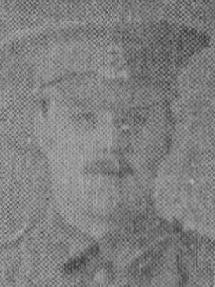
|
John Henry Gibbins was born in Loughborough in 1894, the third son of William and Annie Gibbins who were married in Loughborough in 1886. John had five brothers Philip, Bernard, Francis, Cecil and Reginald and two sisters Nellie and Lucy. John's father was a farm labourer in 1891, become a groom by 1901, and progressed to being a farm foreman by 1911. The family initially lived in Forest Road, Nanpantan, but by 1911 had moved to Bawdon Lodge, Charley Cross Roads, Loughborough.
John became a farm labourer and attested for the Leicestershire Regiment in the autumn of 1913. In September 1914 he was posted as Private 9829 to the 3rd Leicesters at Portsmouth. On 7th December 1914 he was sent to France to join the 2nd Leicesters who had arrived in France from India.
In 1915 John took part in the Battles of Neuve Chapelle (10th-13th March), but missed fighting with his battalion at Aubers Ridge (9th May), the first day of the Battle of Festubert, as he was in hospital. The 2nd Leicesters spent the next couple of months alternately in the trenches or in billets while war training, in the area of Calonne and Vieille Chapelle north-east of Bethune. On 17th July John was once again hospitalised with German measles. He rejoined his battalion just over two weeks later which at the time was being rested in a quiet sector before being deployed for the Battle of Loos.
The initial attack at Loos was made by three divisions, with the Meerut Division leading the attack on the Indian Front. Blackader's brigade, with two Gurkha battalions and the 2nd Leicesters was on its right flank. Whilst the attack successfully crossed no-man's land under cover of the barrage, the right flank of the brigade was caught up in defensive wire and only one battalion successfully made its way into the German trenches. Gas also affected some of the men and the smoke caused a dense fog, making direction difficult. John was fortunate to survive the initial attack at the Battle of Loos on 25th September 1915 - from his battalion 72 men were killed, 217 were wounded, 42 were gassed and 96 were recorded as missing.
The 2nd Battalion was rather depleted after the Battle of Loos, but was ordered to the Persian Gulf where Britain was fighting Turkish forces allied to the Germans. On 10th November 1915 John embarked at Marseilles and arrived at Basra on 8th December 1915. From there he travelled by boat up the River Tigris to Ali Gharbi, 150 miles south-east of Baghdad.
In Mesopotamia General Townshend and his troops were under siege at Kut. On January 4th 1916 General Aylmer's leading troops, under Major General Younghusband, began to advance from Ali Gharbi towards Sheikh Sa'ad, with the intention of relieving General Townshend at Kut.
The Turkish commander Nur-Ur-Din had, however, effectively blocked any progress by placing approximately 22,500 troops and 72 guns on both banks of the Tigris at Sheikh Sa'ad, about 16 miles downstream from Kut. General Aylmer therefore ordered an attack on the enemy and very heavy fighting ensued on 7th January at the Battle of Sheikh Sa'ad, during which John was killed. He was just 21.
John is commemorated on the Basra Memorial, Iraq, Panel 12. He is also remembered on St. Mary's in Charnwood Churchyard Memorial, Nanpantan, and on the memorials at Emmanuel Church, Loughborough, and St Peters Church, Copt Oak, as well as on the Carillon.
|
|
|
|
Gunner 83903 George Giles
|
|
Coast Defences (Tees Garrison) Royal Garrison Artillery.
Died at Normanhurst Hospital 7th April 1918, Aged 27.
Buried Loughborough Cemetery, 44/302.
|
George Giles was born in early 1891 in Loughborough and baptised on 29th March 1891 at All Saints Church, Loughborough. He was the youngest child of Charles Giles and his wife Sarah Elizabeth (née Broom) who were married at St. Mary's Church, Walton-Le-Wolds, on 23rd June 1873. George's father was originally an agricultural labourer but by 1898 had become a plate layer for the Midland Railway.
When George was born the Giles family was living at 3 Falcon Street, Loughborough. Ten years later they had moved to 2 Hartington Street. After George's father died in 1907 the family moved to Fern Cottage, Nottingham Road, Loughborough. George had two older brothers Robert and William and five older sisters Mary, Harriet, Alice, Elizabeth and Sarah. In 1911 George, aged 20, was a blacksmith's apprentice.
George enlisted in Loughborough on 10th December 1915. Classed as Army Reserve he was mobilised on 22nd May 1916 and sent to No. 4 Depot of the Royal Garrison Artillery as Gunner 83903. No. 4 Depot of the Royal Garrison Artillery (RGA) was at Great Yarmouth and mainly trained gunners for coastal defence but also provided drafts for overseas. On 10th June 1916 George was posted to 31 Coy and on 5th July 1916 to 181 Siege Battery.
Siege Batteries RGA were equipped with heavy howitzers, sending large calibre high explosive shells in high trajectory, plunging fire. The usual armaments were 6 inch, 8 inch and 9.2 inch howitzers, although some had huge railway- or road-mounted 12 inch howitzers. As British artillery tactics developed, the Siege Batteries were most often employed in destroying or neutralising the enemy artillery, as well as putting destructive fire down on strongpoints, dumps, stores, roads and railways behind enemy lines.
George embarked with 181 Siege Battery on the SS Mona's Queen at Southampton for Le Havre on 12th October 1916. After two days in the Dock Rest Camp at Le Havre the Battery moved to Bruay by rail. From Bruay the battery went via Olhain to Gouy-Servins and proceeded to the battery position to place the guns and receive delivery of ammunition.
The battery first went into action on 17th November but for the rest of the month and most of December 1916 and January 1917 was severely hampered by poor visibility and heavy snow.
The war diary of the battery gives very little detail regarding movements of the ordinary ranks but it is clear that in December George had been sent to the Royal Garrison Training ground at Harfleur. On 23rd December 1916, while taking part in riding drill there he was thrown by his horse and suffered a contusion to his back. He was admitted to No. 7 Canadian Stationary Hospital at Harfleur on Christmas Eve 1916. There is no record of when he returned to his battery.
181 Siege Battery received an order on 26th January 1917 to 'Move Bty at once to central Bruay'. From Bruay the battery was sent via Lillers to Poperinghe, arriving on 29th January. Between 1st and 5th February the battery positioned the howitzers, took delivery of ammunition and registered the guns. From 8th-12th February they kept up a continuous bombardment of the enemy trenches.
On 15th February the enemy shelled the battery's billets, ammunition dumps and limbers and the battery was forced to move to new billets. After another misty week the battery and guns were withdrawn to Poperinghe on 22nd, Steenvoorde on 23rd, and then to St. Hilaire on 25th where the howitzers went to the workshops for overhaul. The battery then returned to Bruay and during March began preparing the battery positions near Gory, registering the guns, and receiving ammunition.
On 30th March 1917 George was admitted to the 7th Canadian General Hospital at Etaples with a thumb wound after chopping wood. On 10th April he was sent to England on the hospital ship HMHS Stad Antwerpen. He was admitted to the 2nd Western General Hospital in Manchester and from there went to the King's Lancashire Military Convalescent Hospital, Clifton Park, Blackpool, George stayed at the Convalescent Hospital until 9th August for dressings, physical exercises and massage.
George never returned to France. When he was discharged from hospital he was sent to Scotton Camp, Catterick, to join the 1st Durham Royal Garrison Artillery. On 19th August he was confined to barracks for a week for being absent without leave for almost two days. On 16th December 1917 he was posted to the Tees Garrison to join No. 2 Reserve Brigade Siege Artillery, Royal Garrison Artillery, at the Armoury, West Hartlepool, to work on coastal defence.
On 1st April 1918 George was admitted to the Military Hospital, Carlton Terrace, Hartlepool, with a fever. Two days later he was transferred to Normanhurst VAD Hospital, West Hartlepool, where he died on 7th April 1918, aged 27, from pneumonia and cardiac paralysis.
George was buried in Loughborough Cemetery, Grave 44/302. He is remembered on the war memorial in All Saints Church, Loughborough, and on the Carillon.
|
|
|
|
Corporal 568012 Sidney Lewis Gilks
|
|
Base Signal Depot, Royal Engineers.
Died of Pneumonia Palestine 2nd November 1918, Aged 24.
Buried Jerusalem War Cemetery, W. 15.
|
Sidney Lewis Gilks was born in Nottingham on 11th November 1893 and baptised on 11th November 1894 at St. Ann's Church, Nottingham. He was the son of Joseph John Gilks and his wife Harriett Ann (née Pearce) who were married on 2nd April 1888 at St. Andrew's Church, Chew Magna, Somerset. Sidney's father was an ironmonger's bookkeeper.
Sidney had two brothers John and James and one sister Margaret. When Sidney was born the family was living at 14 Livingstone Street, Nottingham. By 1901 they had moved to 55 Cumberland Road, Loughborough, and by 1911 to 27 Arthur Street. In 1911 Sidney was a travelling agent in books and lodging with the Mossendew family at 129 Alderman Drive, Peterborough.
Sidney's service papers have not survived but other records show that he joined the Royal Engineers as a Territorial at Gunton Hall, Norfolk, and was given the service number of 14, later being renumbered as 568012. Sidney trained as a signaller.
The Royal Engineers (RE) Signal Service provided for the Army's signalling and mail requirements throughout the First World War. From 1915 onwards non-telecommunications systems of signalling such as the heliograph and Lucas lamp were used in parallel with and as a backup to telegraph and telephones. Semaphore, using the army's one-flag system, was also in use in the early part of the war but was subsequently banned in the trenches as its use was guaranteed to attract enemy fire.
The most common duties associated with the Signals Service were laying communications wire (over which the telegraph was employed); operating and repairing the same; carrying messages (either on foot or by horse or cycle); handling and dispatching of mail (both official and private); constant trade practice and of course the inevitable trench digging and maintenance which they shared with their infantry colleagues. There were also mundane guard duties and the maintenance of their horses and equipment.
The RE Signals Service, in most cases, was split into small units, none bigger than Company size, and attached to Divisions, Corps and Army HQs. As they were attached to the fighting portions of Divisions men of the Signals Service saw action and were involved in many battles. With the exception of the Trumpeter, all ranks were armed as infantrymen.
Signallers were often used in forward positions to assist the artillery and provide information on their enemy targets. In these, often isolated, positions the signaller became vulnerable to enemy fire, and many signallers lost their lives.
In 1915 Sidney was sent to join the Mediterranean Expeditionary Force and after travelling via Alexandria, Egypt, reached Lemnos, just across from Gallipoli, on 19th April 1915. After the failure of the naval attacks, infantry troops were now being assembled to eliminate the Ottoman forces and the Director of Signals, Royal Engineers, was setting up a signalling service which Sidney joined.
Over the next few months signalling cables were laid from nearby Navy ships and from Tenedos to Gallipoli and small signalling points (with a small hut where at all possible) were set up on the Gallipoli peninsula itself. Great difficulties were encountered. Cables often broke or earthed up and sometimes had to be repaired under shell fire. Operational messages were often disastrously delayed because of poor light. There were also shortages of equipment, particularly field telephones, and on one occasion a supply of insulators arrived without screws and was therefore useless. These problems were all in addition to the fact that the signallers risked their lives much of the time operating in battle zones. Moreover, in the summer heat conditions rapidly deteriorated. Sickness was rampant, food quickly became inedible and there were vast swarms of black corpse flies.
After the decision was taken to evacuate Gallipoli in late 1915 Sidney moved with the Signallers to Egypt, firstly to Cairo and then to Ismailia on the Suez Canal to support the troops guarding the coast railway from Alexandria to Da'aba and the Suez Canal defences. After the Ottoman offensive in Egypt had ended and the Turkish forces retreated into Palestine. The Allies focus then changed from defence of the canal to advance into Sinai and Palestine.
At some point in 1916 or 1917 Sidney appears to have been posted as a signaller to the re-formed 20th Indian Infantry Brigade. This brigade served on the Suez Canal defences in 1916 and 1917. In April 1918 it was attached to the Desert Mounted Corps and with it took part in the 2nd Transjordan attack (30th April-4th May 1918).
From 25th July to 3rd September 1918 Sidney was sent to G Squadron, No.3 Cadet Wing of the Royal Air Force for a course of instruction. For this he would have been sent to Aboukir, near Alexandria, Egypt. He would have been there as the first step in his training for aircrew (pilot or observer). An Air Force record noted that Sidney had 'a general knowledge of the working of an internal combustion engine and Army signals'.
Sidney then rejoined the 20th Indian Infantry Brigade in the Jordan Valley. As part of the Final Offensive in Palestine, the brigade operated here and in the hills to the east of the Jordan, taking part in the 3rd Transjordan attack (19th - 25th September) which lead to the capture of Amman (25th September).
Sidney died, aged 24, of pneumonia in Palestine on 2nd November 1918. He may have been a victim of the world wide flu epidemic. By the time he died he had achieved the rank of Corporal. He was buried in Jerusalem War Cemetery, Grave W.16.
Sidney's brother John served in the Royal Field Artillery and his brother James in the Army Service Corps. Both survived the war.
|
|
|
|
Private 40902 John Henry Gimson
|
|
8th Bn, Leicestershire Regiment.
Previously served as 4777.
Killed in Action 6th October 1917, Aged 38.
Commemorated Tyne Cot Memorial panel 50 - 51.
|
John Henry Gimson was born in Loughborough in 1879 and baptised at All Saints Church, Loughborough, on 8th October 1883. He was the son of John Gimson and his wife Sarah Ann (née Cook) who were married at Emmanuel Church, Loughborough, on 31st March 1877. John Henry's father was a carpenter and joiner.
John Henry had three brothers William, Samuel and Albert and four sisters Ethel, Emily, Sophia and Eliza. In 1881 the family lived at 17 Mill's Yard, Loughborough. By 1883 they had moved to 58 Brown's Yard, Ashby Road, and by 1891 to Court A, Ashby Square. By 1911 John Henry's parents had moved again to 79 Ashby Road and they later lived at 13 Railway Terrace and 37 Hastings Street.
On 1st April 1901 John Henry, who was a labourer, married Alice Pickering at All Saints Church, Loughborough. Both bride and groom gave their address as Rectory Place, Loughborough, and they already had one child John Henry Junior, born in late 1900. By 1908 they also had three daughters Charlotte, Alice and Olive Ivy. In 1902 the family lived in Ashby Road but by 1911 had moved to 2 Providence Square, Sparrow Hill. They later moved to Meadow Lane but were evicted in July 1914 and moved to a lodging house at 33 The Rushes.
In 1900 John Henry was fined at Loughborough Petty Sessions Court for using obscene language. In 1902 he was charged with stealing a meerschaum pipe from the White Horse Inn. In October 1911 he and his wife were fined for stealing potatoes from a farmer at Cotes.
Between 1903 and 1911 John Henry and Alice were warned on a number of occasions by the NSPCC about neglecting their children and in December 1911 both parents were sent to jail for six weeks while the children were sent to the workhouse. In 1913 John Henry and Alice had a fourth daughter Minnie.
Between 1911 and 1914 John Henry was fined three times for the irregular attendance of his children at school. In July 1915 John Henry was again prosecuted for neglecting his children and sent to jail for two months while his wife Alice was sent to jail for two months for pickpocketing. Their children were taken into the care of the Loughborough Guardians.
On 29th October 1915 the NSPCC successfully applied to remove two of the girls into care and in March 1916 also removed a third girl. Charlotte, Alice and Olive Ivy were all sent to Dr. Barnado's.
On 10th December 1915, not long after he left jail, John Henry enlisted with the Leicestershire Regiment. As Private 4777 he initially joined the 3/5th Battalion and was then transferred to the 4th (Reserve) Battalion. On 7th September 1916 he was sent to France, renumbered as Private 40902, and posted to the 8th Battalion of the Leicesters in the field on 30th September 1916.
John Henry joined his battalion in the trenches at Ridge Wood near St. Hubertushoek. The battalion remained in the Hohenzollern sector, with breaks at Mazingarbe and Vermelles until 15th December when they marched to billets in the candle factory at Béthune.
From Béthune the battalion moved to Auchel where they remained until 26th January 1917 training. On 28th December the troops were entertained by a Lena Ashwell concert party. From Auchel the men moved to Winnezeele to continue training in tactical manoeuvres before returning to Béthune and the front line trenches at Sailly-Labourse.
In April 1917 the battalion moved to Hamelincourt and occupied the Outpost Line on the Hénin-Croisilles road until 13th April, then transferred to Bailleulmont for training before going into support at St. Leger. On 3rd May the battalion took part in an attack on the village of Fontaine-lès-Croisilles where casualties were high. After the attack the battalion bivouacked at St. Leger before going back into the line on 9th May. On 11th May the battalion marched to Berles-au-Bois for musketry training and practice in tactical schemes, brigade sports and inspections which lasted until the end of May.
On 1st June the battalion marched to huts in Hamelincourt for additional training in bombing and rifle grenades and field exercises until 7th June. On the night of 7th/8th the battalion went into the trenches in the Hindenburg Line. From there they attacked the enemy on 15th June but were compelled to withdraw. They remained in the front line until 19th June when they returned to camp at Hamelincourt. A period of rest at Blairville then lasted until 1st July, after which the battalion returned to Hamelincourt. On 9th July 1917 the battalion was in the trenches near Croisilles before going into Brigade Reserve. After one more front line trench tour at Croisilles the battalion moved to Camp A at Moyenville for eight days training. Following this the battalion was in brigade Support in the forward area until 17th August when it moved to a hutment camp in Ervillers for training. On 25th August the battalion moved by motor bus to Barly and from there, on the following day, marched to Ambrines. Two further periods of training followed, firstly at Ambrines and then at Avesnes-le-Comte.
On 16th September the battalion marched to Savy, entrained for Caestre and went into camp for more training. On 23rd September the battalion began a series of moves, firstly to Meteren, then by bus to Hallebast before marching to Sint Hubertushoek and from there to Ridge Wood south-west of Ypres. On 30th September they moved up to the front line at Polygon Wood.
On 1st October the enemy attacked the 9th Leicesters who were nearby and got possession of their front line. The 8th Leicesters went to assist but the enemy made repeated attacks. Counter-attacks were hit by a heavy enemy barrage in the neighbourhood of Joist Farm. On the night of the 2nd/3rd October the battalion was relieved and marched to Scottish Wood Camp. On 4th October the 8th and 9th Battalions of the Leicesters were amalgamated because of their high casualty rate. On 5th October the combined battalion moved to railway dugouts at Zillebeke.
John Henry was killed in action on 6th October, aged 38. He is commemorated on the Tyne Cot Memorial, Panel 50 - 51.
John Henry's mother died in Loughborough in 1916. At the time of John Henry's death his widow was living at 4 Dog and Gun Yard, Wards End.
In 1920 John Henry and Alice's three daughters, Charlotte, Alice and Olive Ivy, were sent to Canada by Dr. Barnardo's as 'Home children'. They arrived from London in Quebec on the SS Scotian on 29th June 1920 and travelled to the Hazelbrae Home in Peterborough, Ontario. They did not return to the UK.
|
|
|
|
|
Captain Walter Stanley Gimson MC
|
|
King's Own Yorkshire Light Infantry.
Killed in Action 16th August 1917, Aged 32.
Buried Bard Cottage Cemetery, Ieper. IV. B. 48.
|
Walter Stanley Gimson was born in Leicester on 3rd March 1885. He was the son of William Gimson, a timber merchant, and his wife Martha (née Williams) who were married at St. Peter's Church, North Rauceby, Lincolnshire, on 11th April 1876. Walter had four brothers William, Henry, Edward and Albert, and four sisters Emily, Annie, Mary and Margery. In 1891 the family was living at 110 Regent Road, Leicester, but by 1901 had moved to Rothesay, Victoria Road (now University Road), Leicester.
Walter became a cabinet maker and for some years was a principal in the firm Gimson and Slater, cabinet makers of Nottingham. Walter became well-known in Nottingham and was a prominent playing member of the Notts Rugby Club as well as a keen cricketer and golfer. In Nottingham he boarded with the Slater family at Hawthorns, Dagmar Grove, Alexandra Park. He subsequently moved to 9 Forest Road, Loughborough, and joined the Longcliffe Golf Club.
At the outbreak of war Walter enlisted with the Nottingham athletes in the Sherwood Foresters and joined the 10th (Service) Battalion as Private 17286. He was soon promoted to the rank of Corporal and then Sergeant. The precise dates of his enlistment and promotions, however, are unknown.
The 10th Battalion was formed at Derby in September 1914 and came under orders of 51st Brigade in 17th (Northern) Division of the Army. The battalion moved to Wool, Dorset, and on to West Lulworth in October 1914, returning to Wool in December. In June 1915 the battalion moved to Winchester for final training. On 14th July 1915 the battalion travelled to Folkestone and on 15th July landed at Boulogne.
From St. Omer the battalion moved to Reninghelst and went into the trenches near Hooge on 27th July. Further trench tours followed in August with a break at Ouderdom. By September the battalion was in Sanctuary Wood repairing trenches and was heavily shelled by the enemy on several occasions. On 25th September the enemy began a particularly fierce attack on Sanctuary Wood and two counter-attacks failed. On October 6th the battalion was withdrawn to Eecke and Caestre for two weeks rest but was back in the trenches at Sanctuary Wood by 21st October. November began with working parties for the Royal Engineers, followed by trench tours at Ypres. On the 22nd November 1915 Walter was admitted to hospital suffering from influenza. He was discharged on the 25th November and returned to duty.
On 14th December enemy shelling cut all wires on the Allied front, blew in all dugouts on the front and support line. This was followed by a phosgene gas attack and an assault by German raiding parties. Walter was admitted to hospital again on 14th December, this time with a shrapnel wound in his side. He was transferred to the Divisional Rest Station three days later.
It seems likely that Walter returned to his battalion sometime in early January 1916 while they were undergoing reorganisation and training at Houlle. The battalion left Houlle by rail for Poperinghe on 5th February and marched to Ouderdom before going into the trenches north of the Ypres-Comines canal in an area known as the Bluff. Here on the night of the 14th/15th February the Germans began an extensive shelling operation before invading the front and support lines of the Allies. Counter-attacks were again unsuccessful and the 10th Sherwood Foresters suffered heavy casualties. A further counter-attack on 2nd March, however, achieved better results. From 7th-18th March the battalion was in training at La Crèche.
On 15th March 1916 Walter received a commission as a Temporary 2nd Lieutenant in the King's Own (Yorkshire Light Infantry). On 23rd May 1916 he was transferred to the General List for duty with Trench Mortar Batteries and on 30th July 1916 he was promoted to Acting Captain while commanding the 61st Trench Mortar Battery, part of the 61st Brigade of the 20th (Light) Division. Walter joined the 61st Trench Mortar Battery in the line in the Ypres area. Front-line trench mortars, known in the British Army as 'flying pigs' played an important role in any attack as they were always certain to draw enemy fire.
In the New Year's Honours List on the 1st January 1917 Walter was awarded the Military Cross 'for an act or acts of exemplary gallantry during active operations against the enemy'.
Between April and June 1917 while on leave from the front Walter married Isabel Beatrice Soher (née Moss) at Fulham Register Office, London. Isabel was the daughter of Edwin Moss of Loughborough and in 1914 was divorced from her first husband Le Roy Soher, an American car mechanic with Straker and Squire. Walter and Isabel had only been married for a few months when Walter, aged 32, was killed in action on 16th August 1917, the first day of the Battle of Langemarck.
Communicating the news of his death to his wife a fellow officer said: 'Gimson was one of the most popular officers in the Division and when killed in the advance towards Langemarck was acting like a hero'.
Walter is buried in Bard Cottage Cemetery, near Ypres, Grave IV. B. 48. A group of members of the Longcliffe Golf Club visited his grave and placed a wreath on behalf of the members of the golf club. Walter's name was also added to his parents' headstone in Welford Road Cemetery, Leicester.
Walter's widow died in County Armagh, Northern Ireland, in 1927.
|
|
|
|
Corporal 8608 John Marshall Glover
|
|
2nd Bn, Leicestershire Regiment.
Killed in action 25th September 1915, Aged 23.
Commemorated Loos Memorial panel 42 - 44.
|
John Marshall Glover was born in Barton in Fabis, Nottinghamshire, in 1891. He was the only son of James Glover and Ellen Glover (née Marshall) who were married in 1889 in Barton in Fabis. John's father was a farm labourer who subsequently became a labourer in a limestone quarry and his mother was a hosiery seamer. John had three sisters Kate, Edith and Jane and between 1891 and 1901 the family moved from Barton to Loughborough Road, East Leake. After John's father died sometime between 1901 and 1911 his widowed mother moved to 5 Steeple Row, Loughborough, with her youngest daughter Jane.
On 4th January 1909 John, a labourer, attested at Loughborough and on 9th January joined the 1st Battalion of the Leicestershire Regiment as Private 8608. He was stationed at Shorncliffe, near Cheriton, Kent, for a year and then sent to Aldershot. On 15th August 1911 he was found fit for service in India and subsequently posted to the 2nd Leicesters. On 27th November 1911 he sailed for India on the HMT Dongola, arriving there on 2nd January 1912. He remained in India until October 1914 and served in various locations including Madras, Wellington, Bareilly and Ranikhet.
When war broke out the 2nd Leicesters were brought from India to France as the British Battalion of the Garhwal Brigade of the 7th Indian Division. They arrived in Marseilles on 11th October 1914 and travelled north to the war zone. They were one of the units chosen to spearhead the allied assault at Neuve Chapelle (10th-13th March 1915).
Along with their Indian comrades the 2nd Leicesters attacked the German position known as Port Arthur, near La Bombe crossroads. The Garhwal Brigade's Indian battalions were held up by uncut wire, but the 2nd Battalion of the Tigers led the attack on the right and smashed a way through or over all obstacles and quickly overwhelmed the enemy holding the trenches covering the village and woods at Neuve Chapelle. John, who had been appointed a Lance Corporal at the beginning of the year, was unfortunately wounded in the thigh and hand in this battle. From No. 19 Field Ambulance he was sent to No. 2 Hospital in Boulogne and from there to England. He remained in England until late May when he rejoined the 2nd Leicesters in France where the corps was being rested in a quiet sector until it was deployed for the Battle of Loos.
John had been promoted to the rank of Corporal in August 1915, but this new position was short-lived. He died on the 25th September, the first day of the Battle of Loos.
|
|
|
|
Private 241814 (Stretcher Bearer) John William Godber
|
|
2/5th Bn, Leicestershire Regiment.
Killed in Action 16th April 1917, Aged 21.
Buried Roisel Communal Cemetery SP. Memorial 10.
|
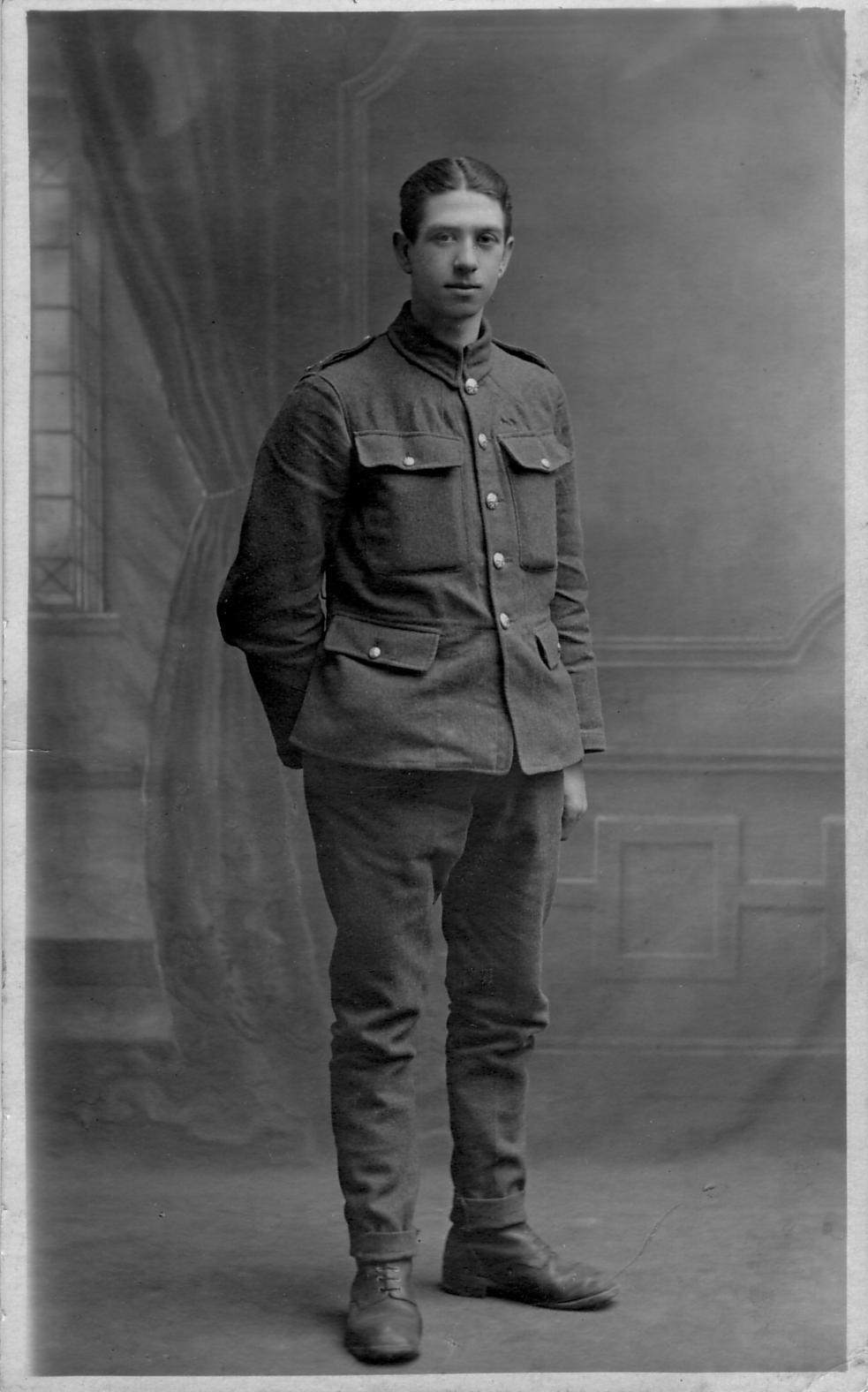
|
John William Godber, known as 'Billy' to his family, was born on 22nd January 1896 in East Leake, Nottinghamshire and baptised at St. Mary's Church, East Leake, on 31st October 1897. He was the eldest son of John Thomas Godber and his wife Henrietta (née Smith) who were married in Loughborough in 1895. Billy had three brothers Sidney, Morton and Harold and four sisters Beatrice, Doris, Sarah and Hilda. Billy never knew his brother Harold who was born about the time he was killed in France in 1917. Billy's father was a basket maker but in later life he was an engineering works stores labourer. For much of his youth Billy's family lived at Loughborough Road, East Leake, but they later moved to 10 Thomas Street and then to 98 Wharncliffe Road both in Loughborough. In 1911 Billy was a grocer's assistant at the Maypole Dairy in Market Place, Loughborough.
According to Billy's youngest sister Hilda (the late Mrs. Onions) who was only seven when Billy died his parents were extremely upset when Billy joined up to serve in the First World War. Billy's date of enlistment is not known as his service records have not survived but he joined the 2/5th (Territorial) Battalion of the Leicestershire Regiment as Private 4881 (later renumbered as Private 241814).
The 2/5th Battalion had its HQ in Loughborough as part of the Lincoln and Leicester Brigade, North Midland Division and was mobilised in September 1914. In January 1915 the battalion moved to Luton being billeted in private homes, and in February and March they were in Epping digging practice trenches. In July they moved to the St. Albans area, under canvas at Briton Camp for training and route marches. In August 1915, the Brigade was retitled 177th Brigade, 59th Division (2nd North Midland) and in October they were moved back to billets in Harpenden. Throughout 1915 some members of the 2/5th Leicesters also provided guards for the prisoner of war camp at Donington Hall.
In January 1916 parties of Officers were sent to France on tours of instruction in the trenches and in March, the long awaited orders to proceed overseas were received. On Easter Monday, however, the rebellion in Ireland forced a rapid change of plans.
The 177th Brigade was recalled from leave, ordered to Liverpool, and sailed for Ireland on the SS Ulster, a fast mailboat, escorted by a Royal Navy destroyer. Their first taste of action was not in the trenches of the Western Front, but in the streets of Dublin. By the end of the month the main uprising was over and the 2/5th Battalion were employed as search parties in Ballsbridge and guarded railways, bridges and other key infrastructure. On the 10th May they moved out of the city to tackle pockets of resistance in Co. Kerry. In June the Battalion told they would be moving to France and training resumed with long route marches through Ireland. In August they marched from Tralee to Fermoy Barracks, where they remained until January 1917, engaged in live fire training in trench warfare. The return trip from Ireland was made aboard the SS Ulster and they arrived at Fovant Camp in Wiltshire by train on 6th January 1917.
After embarkation leave they proceeded to France via Southampton, arriving at Le Havre on 24th February 1917. They were sent to the Somme area of Fouencamps and Morcourt where the enemy was retreating to the Hindenburg line. They made their first attack on the villages of Hesbecourt and Hervilly on 31st March 1917, capturing both villages and suffering a number of casualties.
In a letter to his fiancée, Maud, on 8th April 1917, Billy thanked her for the parcel she had sent him containing a copy of the Loughborough Echo, some bread, butter and eggs. He wrote: 'I am looking forward to coming back soon, I've had quite enough'.
Billy's battalion remained in the area of Hesbecourt and Hervilly and on 16th April, at Brosse Woods, the enemy opened a heavy barrage. Eight men were killed or died of wounds and Billy who was a stretcher bearer and carrying an injured comrade was killed by a sniper's bullet. He was 21 years old.
Billy was buried at Roisel Communal Cemetery Extension Sp. Memorial 10 and is remembered on the memorial from Holy Trinity Church, Loughborough, as well as on the Carillon.
Billy's mother shared the honour with General Lord Home of laying the foundation stone of the Carillon.
|
|
William's last letter
|
Letter translated
|
|
|
|
Lance Corporal 12857 Walter Gould MM
|
|
7th Bn, Leicestershire Regiment.
Died from gas poisoning 28th April 1918, Aged 28.
Buried Boulogne Eastern Cemetery IX. A. 51.
|
|
Walter Gould was born in Loughborough in 1889 and baptised at Emmanuel Church on 8th November 1889. He was the son of James Gould and his wife Fanny (née Bramley) who were married on 3rd October 1874 at Emmanuel Church. Walter's father was a bricklayer's labourer. Walter had four brothers John, Harry, Arthur and Ernest and two sisters Sarah and Florence (known as 'Flossie').Three other brothers, all called William, and one sister Ellen had died in infancy. Walter's sister Sarah (Mrs. Robinson) died in 1904 at the age of 29.
The Gould family lived in Ward's End, Loughborough. In 1891 they were at 10 Court 6, and after that at 13 Ward's End. After Walter's mother died in 1911 and his father two years later Walter lived with brother Arthur and sister-in-law Elizabeth at 21 Ward's End.
Walter attended Emmanuel Church and when he left school he became a brickyard labourer for Messrs. Tucker. In September 1906, when he was16, he was fined four shillings at Loughborough Petty Sessions for letting off fireworks in the street.
Walter enlisted when war broke out and joined the 7th (Service) Battalion of the Leicestershire Regiment as Private 12857. Walter's service record has not survived and his exact date of enlistment is unknown but from the Depot at Glen Parva he was sent with the 7th Battalion to Salamanca Barracks, Aldershot. Here the emphasis was on individual training, squad and platoon drill. At the beginning of 1915 the battalion began route marches and more strenuous training. In March the battalion moved into billets in the Andover area and in April to Cholderton on Salisbury Plain. On 25th June they were inspected by King George V at Sidbury Hill and on 29th July 1915 they received orders to proceed to France.
Walter's battalion gathered with the 37th Division at Tilques, near St. Omer. In September the 7th Battalion was sent to the area of Berles-au-Bois, south-west of Arras. The battalion remained in this area around Bienvillers and Bailleulmont until April 1916 and was engaged in localised operations seeking a tactical advantage. When not in the trenches being subjected to enemy shelling the 7th Leicesters received intensive training in bombing, Lewis gunnery, visual signalling and a host of other activities. In April 1916 they were moved to the Doullens area and formed working parties to cut down trees and prepare brushwood for the front line as well as preparing the support trenches in the area. In May they worked on building a new railway line between Le Bret and Bienvillers-au-Bois. Towards the end of May the battalion returned to the trenches in the Bienvillers-Bailleulmont area.
At the beginning of July the 7th Battalion moved on to the Somme. They were at Fricourt on 13th July and at Mametz Wood and in the attack on Bazentin-le-Petit on 14th July. By 14th July 1916 the 7th Battalion had suffered 553 casualties on the Somme.
On 6th August 1916 the 7th Battalion took over a section of battered trenches at Agnez-lès-Duisans, near Arras. On 12th September, after ten days training at Denier and Sars-le-Bois, the battalion returned by train to the Somme and bivouacked outside Montauban north-east of Bernafay Wood. On 25th September they fought very bravely and successfully at Gueudecourt in an action which was part of the Battle of Morval. On 4th October the battalion entrained once more for the north and the countryside of Loos, taking over positions opposite the Hohenzollern Redoubt with rest billets at Mazingarbe, Philosophe, or Vermelles.
Training at Cauchy-à-la-Tour and Houtkerque followed until 12th February 1917. On 13th February the battalion entrained at Proven for Fouquerieul and marched to billets in the tobacco factory in Béthune. Moving on to Labourse they were back in the trenches in the Hohenzollern sector on 15th February, going into the front line on 21st February. Breaks from the trenches were taken in Noyelles. In March 1917 the battalion experienced what one soldier called 'the bombardment of our lives'.
On 29th March the battalion entrained at Noyelles for Saulty-L'Arbret and marched to La Cauchie and on to Moyenville. On 4th April the battalion went into the front line at St. Leger Croisilles, with breaks at Moyenville. From 15th to 23rd April the battalion was in training at Bailleulval before returning to the trenches at St. Leger Croisilles. On 28th April the battalion was in action at the Battle of Arleux and on 3rd May in reserve for the 2nd Battle of Bullecourt, moving into the front line on 4th May. From 4th -11th May the battalion suffered from very heavy enemy shelling. From 12th-31st May the battalion was withdrawn for training at Bienvillers. Further training and trench tours followed in the Moyenville area in June, July and August, followed by a break in Hamelincourt.
On 25th and 26th August the battalion marched to Gouy-en-Artois and then Beaufort for training. After a further move to Hauteville for more training and a football tournament and boxing competition, both of which the 7th Leicesters won, on 16th September the battalion entrained at Savy station for Caestre.
On 23rd September the battalion marched to Berthen. On 26th September they moved by bus to Scottish Wood and then to Bedford House as reserve in the forward area. After two days rest at Micmac Camp the battalion was back in the forward area on 29th. The 3rd Battle of Ypres had been raging for two months and the ground was full of water-logged shell holes, which had to be negotiated over duckboards. The 7th Leicesters joined the battle on the night of the 30th September, marching up to Polygon Wood, which had been captured by the Australians. The 9th Leicesters took over positions in the right half of the Polygon sector just outside the wood with the 7th Battalion behind them in support and the 6th Leicesters in reserve.
On 1st October the enemy began a heavy barrage. The Leicesters nevertheless pushed forward. An intense artillery duel followed on 2nd October before the battalion was relieved and marched south-east of Zillebeke Lake to Wiltshire Farm. On 4th October the battalion moved up again to south of Zillebeke Lake, bivouacking there. On the following day they were back in the support line west of Polygon Wood. On 6th October two companies moved up to the front line at Reutel, with the other two companies in support. On 10th October, amid a hostile barrage, the battalion was relieved and moved to Anzac Camp. On the 11th October they entrained at Ouderdom station for Ebblinghem and marched to billets in La Carnois. After four days rest they marched to Les Ciseaux and were taken by bus to dugouts in the railway embankments at Shrapnel Corner. After remaining here until 24th October they moved to B Camp at Chateau Segard for reorganisation and training.
After three days cable laying at Clapham Junction at the beginning of November the battalion returned to B Camp before moving to dugouts on the Zillebeke Bund on 7th November and to the front line on the following day. After returning to A Camp at Chateau Segard on 13th November the battalion moved on to Devonshire Camp in the Reninghelst area and on 17th began a five day transfer by march to Coupigny. On 25th November they moved again to Frevillers for training. On 30th November the battalion received urgent orders to entrain at Savy for Tincourt.
On 1st December 1917 the battalion went into the front and support lines near Tincourt, moving into the support trenches at Epehy on 4th. Back in the front line from the 8th-11th December the battalion installed wiring, improved trenches and dug a new front line. After a break at Villers Faucon they returned to the front line from 16th-20th. On Christmas Eve the battalion returned to the trenches for four days, but were given their Christmas dinner at Saulcourt on 29th December.
The new year of 1918 began with a four day trench tour, followed by training at Lieramont and Haut Allaines until 19th January. On the 20th the battalion moved to Epehy by light railway and began another trench tour before moving into Brigade Reserve at Saulcourt on 28th. On 4th February the battalion moved into support at Epehy. Relieved on 7th February the battalion moved by light railway to Moislains, where training took place until 18th February. The battalion then moved to B Camp, Templeux-la-Fosse, and worked on the trenches and railway at Flamincourt. From 24th -28th February the battalion was based at Adrian Camp, Villers Faucon, for wiring work and trench digging.
In March it became clear that the Germans were planning a Spring Offensive. On the morning of the enemy assault, 21st March 1918, the 7th Battalion was holding the left hand portion of the front between Pezières and Epehy village when it was attacked by German stormtroopers. The battle for Epehy raged all day. On 22nd March the battalion was ordered to retreat towards the old Somme battlefield of 1916, crossing the Péronne Canal to Aizecourt-le-Bas and Feuillaucourt and taking up position on a ridge to the north of Hem. During the retreat the battalion was severely bombarded.
On 23rd April the battalion was ordered to occupy a line east and north-east of Epinette Wood but after the enemy continued to attack the line was drawn back to the Peronne-Nurlu road, next to the Midenette, then to the hill south of Moislains. On 24th the enemy continued their advance and the battalion was withdrawn south-west of Maurepas and to billets at Suzanne. Between 25th and 30th March the battalion moved from Bray-sur-Somme to Allonville. Casualties between 21st and 20th March numbered 456.
On 2nd April the battalion entrained at St. Roch, Amiens, for Hopoutre and were transported by lorry to Monmouthshire Camp, Dranoutre, for reorganisation, cleaning up and inspections. Between the 4th and 8th April they were accommodated in a series of camps before entraining at Zevecten siding on 9th for Scottish Wood Camp. After two days in support at Manduratu Camp the battalion went into the trenches and held the line. Between 20th and 22nd April forty-four Ordinary Ranks, including Walter, were gassed.
Walter was taken to a hospital in Boulogne but died from gas poisoning, aged 28, on 28th April 1918. During his time with the 7th Leicesters he had been promoted to Lance Corporal and was awarded the Military Medal for his bravery on the battlefields of the Somme in July 1916.
Walter was buried in Boulogne Eastern Cemetery, Grave IX. A. 51. He is remembered on the memorial in Emmanuel Church, Loughborough, and on the Carillon.
|
|
|
|
Ordinary Signalman J/26716(PO) Herbert Goulden
Silver Cross of St. George (Russia)
|
|
H.M. Submarine E. 13. Royal Navy.
Killed in Action Saltholm 19th August 1915, Aged 18.
Buried Loughborough Cemetery 42-256
|
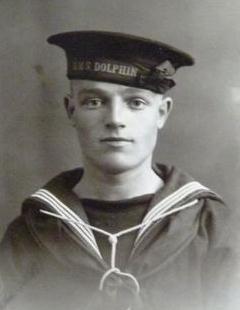
|
|
Herbert Goulden was born on the 24thJune 1897, at 38 Blackwell Street, Stockport. He was the son of Joseph Goulden, a labourer and bricklayer, and his Dunedin-born wife Florence Isabella (née Genever). In 1901 Joseph's family was living at 19 Borron Street, Stockport, Cheshire. By 1909 the Gouldens and their children Florence, Herbert, Harry and William had moved to Loughborough where their relations lived and another daughter Mabel was born in 1909. When Joseph suddenly died in 1910, Florence supported herself and her children by working as a charwoman. She initially lived at 43 Mill Street in Loughborough but then moved to 33 Station Street. In 1923 Florence was remarried to George E.V. Woods in Loughborough.
In 1913, at the age of sixteen, Herbert enlisted in the Royal Navy, and on the 23rdof August 1913, he joined H.M.S. Ganges. On his eighteenth birthday he signed on for a further twelve years service. He joined the crew of the submarine E.13 on the 11thJanuary 1915.
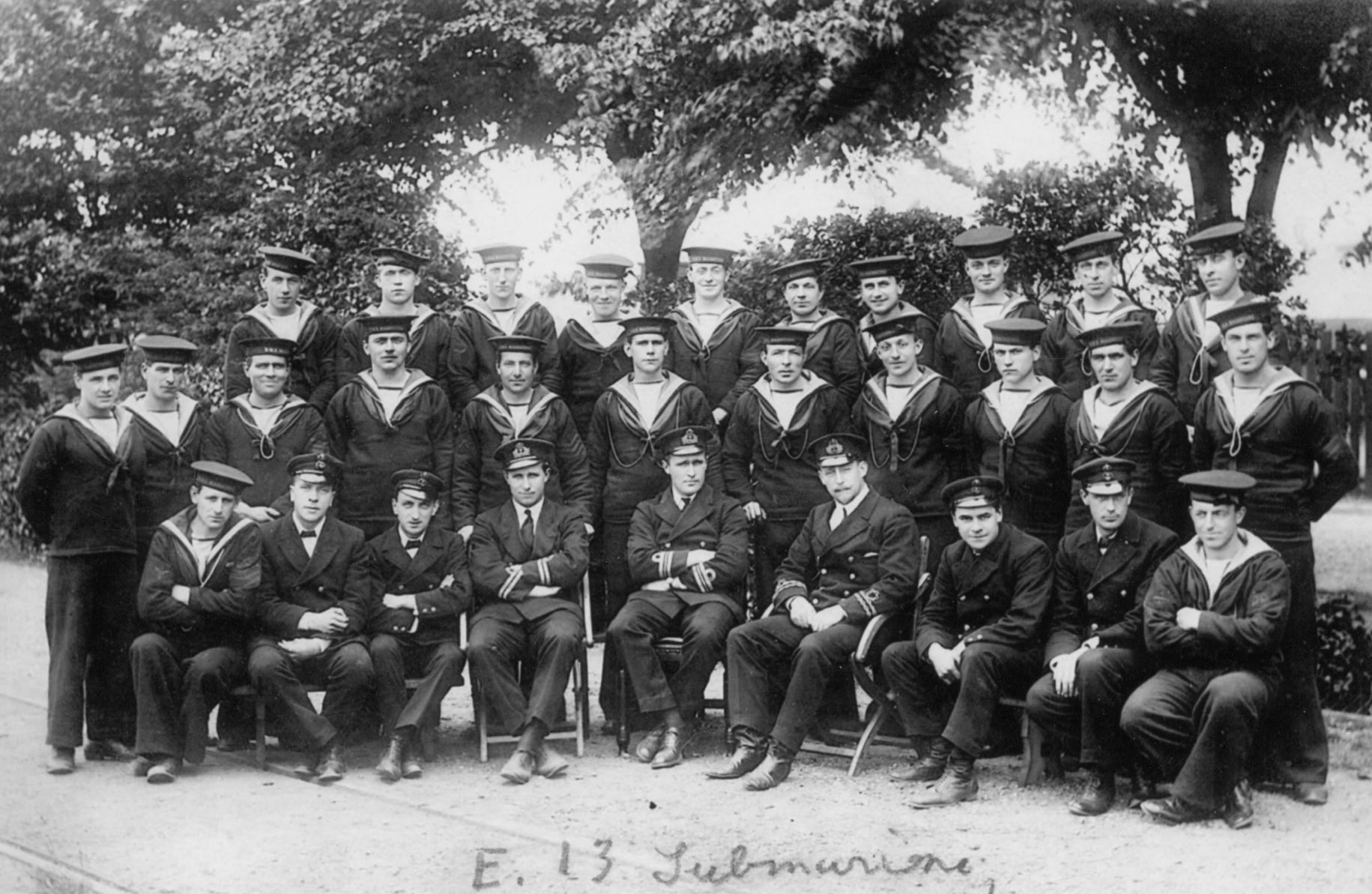
Officer and crew of HMS/m 'E13' (E-class) April 1915
Front row, Left to Right: Stoker PO. ERA Staples. ERA Lukey, Lt. Eddis, Lt. Layton, Lt. Armstrong RNR, ERA Abrams (?) ERA Varcoe (?), PO LTO Bowden (?) or Lincoln. Middle row: Includes Ord. Sig. Goulden, Ord. Tel. Holt (?). Back row: Includes Stoker Yeardsley, Stoker Wilson.
On the 13th August 1915, after 3 days leave at Loughborough, Ordinary Signalman Goulden returned to Harwich to resume his duties. On the 15th August E13 sailed from Harwich at 1800 with E8 for the Baltic. On August 18th at 2300, due to compass failure, E13 ran aground on Saltholm Island, Denmark. Saltholm, an island about five miles long, is in the sound, six miles E.S.E. of Copenhagen and W.N.W. of Malmo in Sweden.
A Danish Torpedo boat appeared on the scene and communicated to E13, that she would be allowed a day to get herself refloated. At the same time a German Torpedo Destroyer arrived and remained close to E13, until two more Danish boats came close. The German boat then withdrew. While three Danish Torpedo boats were anchored close to E13, two German Torpedo Destroyers approached from the south. When about half a mile away one of these destroyers hoisted a commercial flag signal, but before the commanding officer Layton had time to read it the German Destroyer fired a Torpedo at her from a distance of about 300 yards, which exploded on hitting the bottom close to her.
At the same moment the German Destroyer fired with all her guns, and Lieutenant Commander Layton seeing that his Submarine was on fire, and unable to defend himself owing to being aground, gave orders for the crew to abandon her. While the men were in the water they were fired on by machine guns, and with shrapnel. One of the Danish torpedo boats immediately lowered her boats and steamed between the submarine and the German Destroyers, who therefore had to cease-fire and withdraw.
Casualties:
Discharged Dead from E13 on 19 August 1915
| PO. W.G. Warren Sto. |
W.A. Yearsley |
Ord. Sig. H. Goulden |
Ord. Tel. B.S.C. Holt (aka E. S. Holt)
|
| AB. H. Joyner |
AB. A.J. Payne |
AB. R.T. Smart |
LS. H.T. Pedder |
| ERA. H. Staples |
C. Sto. B. Pink |
Sto. T.C. Greenwood |
Sto. A. Long |
| L. Stc. W.H. Thomas |
Sto. W.T. Wilcox |
Sto. F. Wilson |
E13 being towed into Copenhagen.
E13 alongside at Copenhagen, damaged.
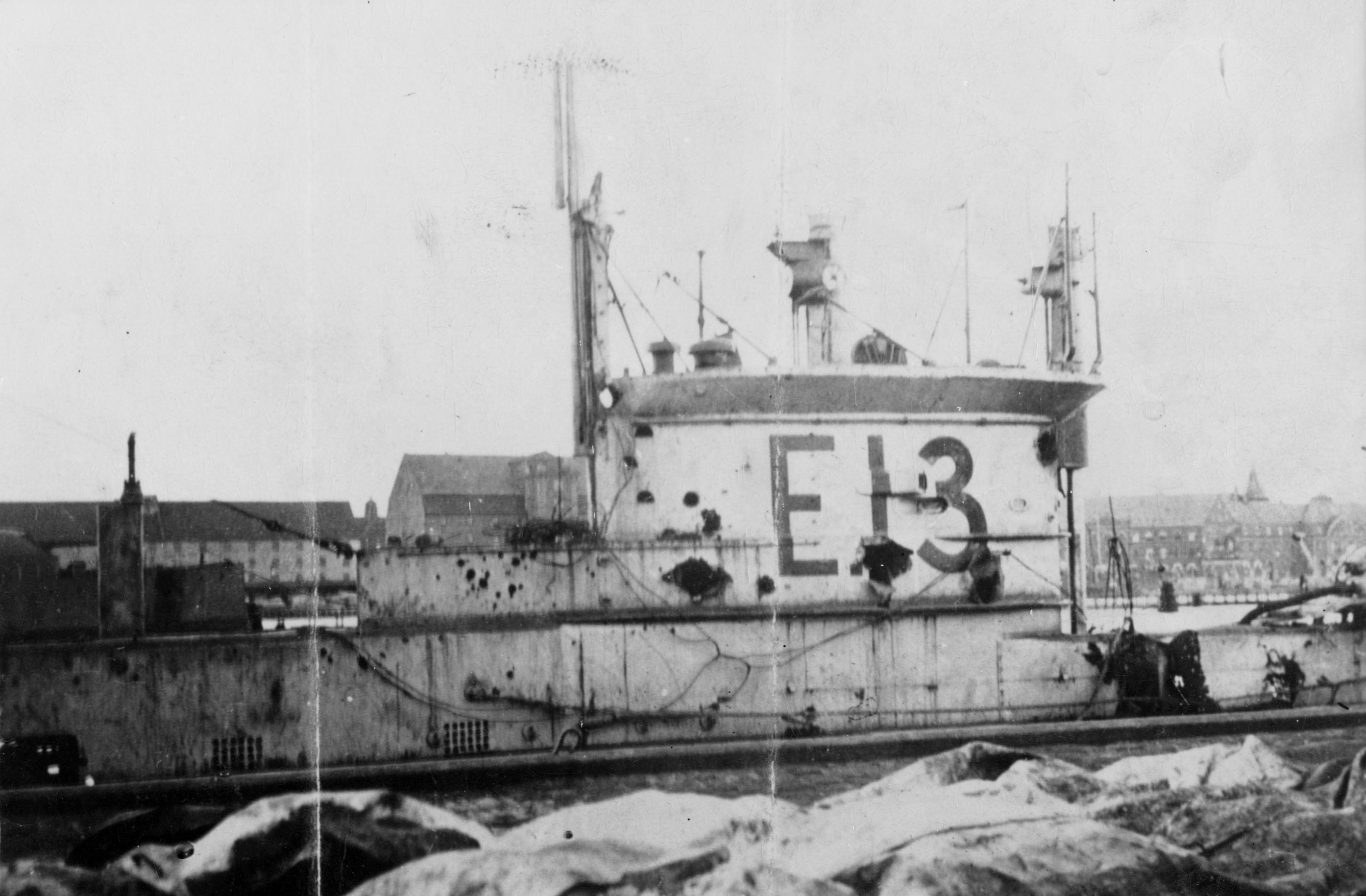
E13 alongside at Copenhagen, August 1915, Note damage caused by German gunfire.
Herbert Goulden was awarded the Silver Cross Of St George 4th Class (Russia), for bravery in the face of the enemy.
According to a newspaper report 'The British government accepted the offer of the Danish Admiralty to carry the fourteen bodies back to England. The
mail steamer Vidar had been specially fitted out for this purpose. The Vidar's Salon was transformed into a temporary
chapel, and before the departure a funeral service was held, alongside the Maritime Wharf. There was an affecting
scene when the British sailors arrived, and many were moved to tears. The ceremony…was short, but impressive, the
coffins were covered with hundreds of wreaths in Danish and British colours. Flags were flying at half-mast over the
whole of Copenhagen'.
The Vidar left for Hull, escorted by the Danish Torpedo boats, Springeren and Storen. Only fourteen bodies left
Copenhagen on board SS Vidar (1 victim missing was later recovered and brought to England). SS Vidar arrived at
Riverside Quay at 7.pm on August 27th. On Saturday morning at 10.00am, the fourteen coffins were transferred to
fourteen horse drawn hearses, which were drawn to the Paragon Station. On entering the large gateway to the Station
yard, the coffins were arranged in a row. A shooting party fired a volley over the bodies and the "Last Post" was
sounded.
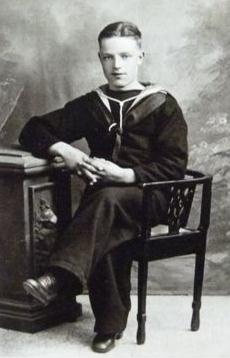
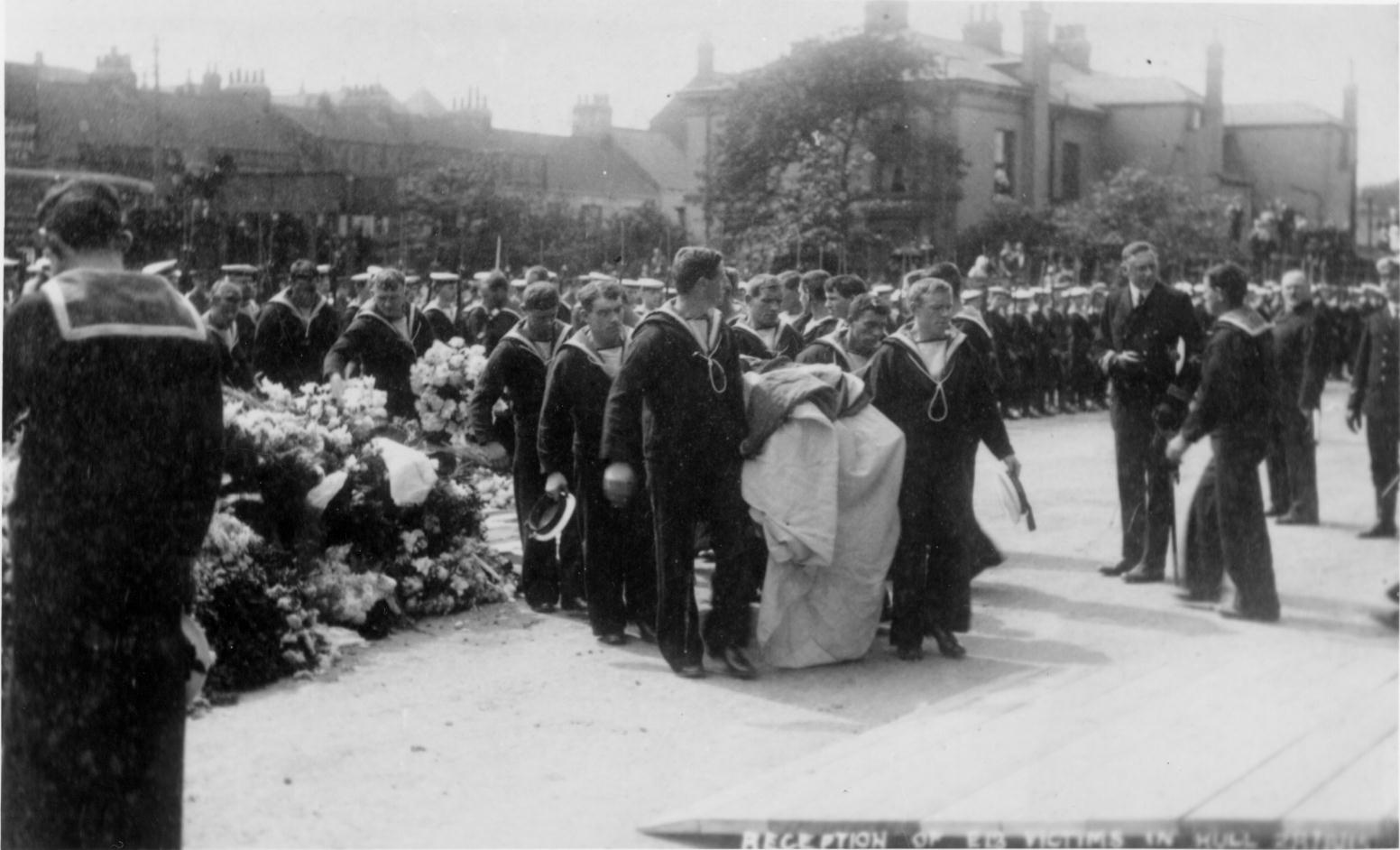
Reception of E13 victims in Hull
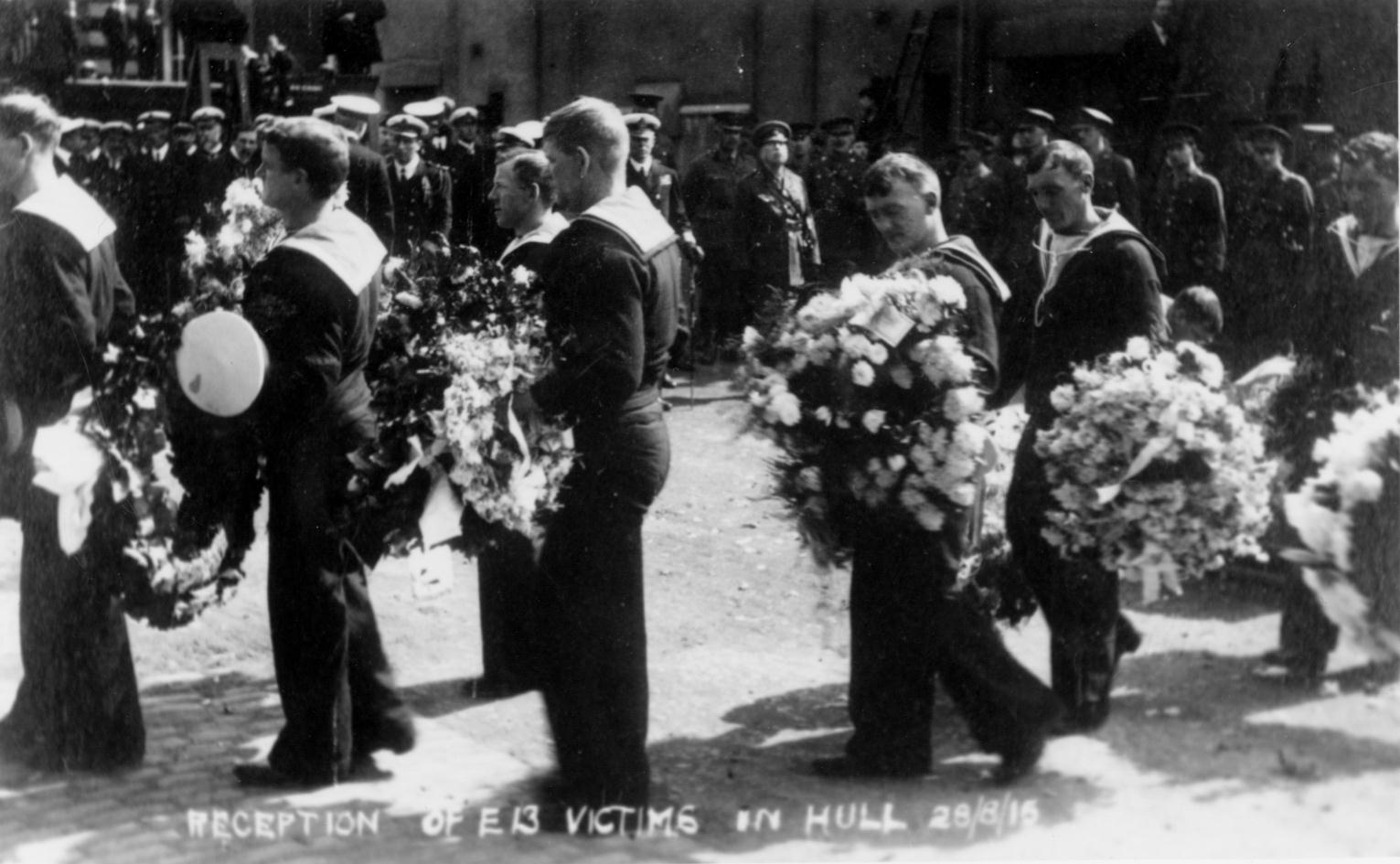
Reception of E13 victim in Hull, Floral tributes.
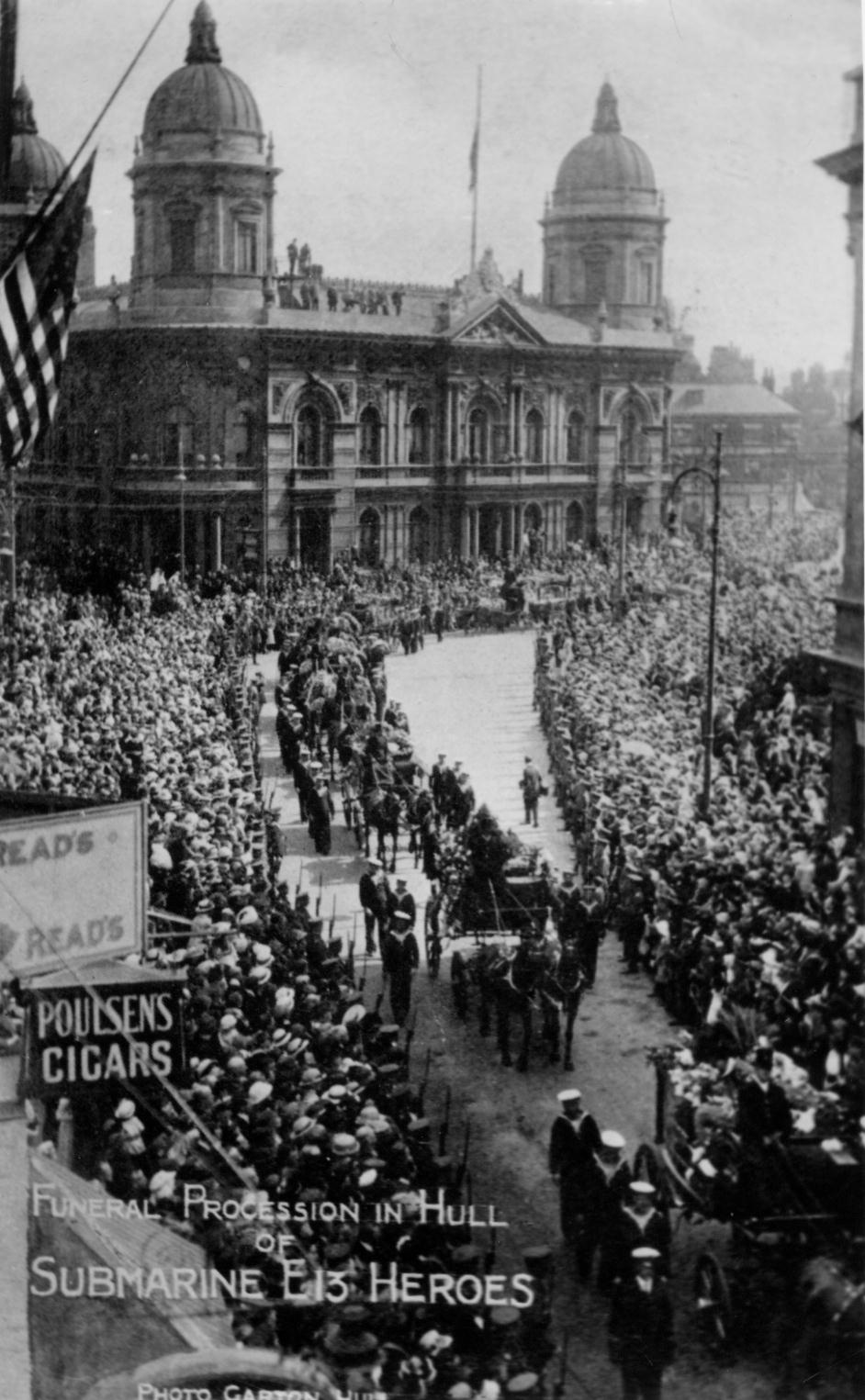
Funeral procession in Hull of submarine E13 heroes.
The coffins of Herbert Goulden and his fellow blue jackets were placed on a train, and sent to the following places:
Seven to Gosport, one each to York, Pembroke, Loughborough, Wimbourne, London and Verwood. Herbert Goulden's
body, enclosed in a massive coffin on which was a plate bearing the name of the young blue jacket, arrived in
Loughborough by the Great Central Railway on Saturday and was removed to the lad's home in Station Street. With
the remains also came no less than 72 floral tributes, including the beautiful wreath inscribed 'In memory of the brave
blue jackets who gave up their lives for King and Country from Alexandra'. There were tributes from Russia, Belgium,
Denmark, France, and the members of the Hull exchange. Another wreath bore the inscription 'We salute you Crew of
E13, your immortal example can but encourage Briton's sons to deeds of similar valour for the honour of old
England'.
Ordinary Signalman Herbert Goulden's funeral took place on Monday 30th August 1915. A strong detachment of the
3/5th Leicestershire Regiment attended the funeral. The Parade lined up in Station Street as a bodyguard and escorted
the funeral party to St. Peter's Church. The coffin was covered with the Naval Ensign, on which were two wreaths, and
the deceased Sailor's cap. A service was held at the church; afterwards the body was conveyed to Loughborough
cemetery for interment in plot 42, section 256. Sailors on leave followed the coffin to the graveside. The 3/5th Leicesters
provided the bearers and a detachment of the same battalion fired volleys over the grave after the interment.
On the 26th May 1916 Mrs. Henshaw [sic. or rather Woods] (formerly Goulden) 33 Station Street Loughborough,
received her son's award of the silver Cross of St George; enclosed with the order was a diploma from the Chapter of
the Russian Imperial and Royal Orders, printed in the Russian language.
'E13's' bell is currently on display at the RN Submarine Museum, Gosport. A section of HP airline from 'E13', pierced
by German machine-gun bullets when she was stranded on Saltholm Island, is currently on display at the RN
Submarine Museum. It was presented to the museum by Admiral Layton, her CO at the time. Lt. Cdr. Layton later rose
to become Vice Admiral Sir Geoffrey Layton. Lt. Cdr. Eddis was in charge of L24 when she was sunk with all hands
after collision with the battleship Resolution on 10 Jan 1924.
|
|
Herbert Goulden's final resting-place, Loughborough cemetery.
|
|
Private 203861 Ernest Albert Grant
|
|
7th Bn, Lincolnshire Regiment.
Previously 2/4th Bn, Lincolnshire Regiment
Killed in Action 21st March 1918, Aged 29.
Commemorated Arras Memorial, bay 3 & 4.
|
Ernest Albert Grant was born in late 1888 or early 1889 in Quorn. He was the son of John Grant and his wife Kate (née Green) who were married at Kibworth Beauchamp, Leicestershire, in 1883. Ernest's father was a carpenter and in 1891 the Grant family lived in Mountsorrel Road, Quorn. Between 1891 and 1908, however, they moved to 128 Howard Road, Leicester. In late 1908 Ernest's father died and in 1911 Ernest, then aged 21, was working as a shoe stock room hand. Ernest had four brothers Fred, Percy, Jack and Bertie and one sister Evelyn. Two other siblings had died in infancy.
On Boxing Day 1914 Ernest, who was now working as a labourer in Loughborough, married Florence Bagley at St. Bartholomew's Church, Quorn, and the young couple set up home at 7 Union Lane, Loughborough. In 1916 their daughter Gertrude was born and baptised on 5th March 1916 at St. Peter's Church, Loughborough and at that time Ernest was working as a stoker.
Ernest's service record has not survived but he appears to have enlisted at Loughborough around May 1917. He initially joined the 2/4th Battalion of the Lincolnshire Regiment as Private 203861 but was subsequently transferred to the 7th (Service) Battalion. When he was sent to France is unknown but the 7th Lincolnshires received batches of reinforcements in July, September, October, November and December 1917. Ernest could have been in any one of these batches.
On 2nd July 1917 the battalion was in the Chemical Works sector near Roeux, a village east of Arras. Over the following days a heavy enemy bombardment caused a number of casualties. After a break at St. Nicholas Camp the battalion was sent to the trenches in the Greenland Hill sector. Further trench tours followed in August and September at Gavrelle Switch and in the Chemical Works sector.
On the night of the 23rd/24th September the battalion marched to billets in Arras and then moved on to Warlus. From Warlus they marched to Grand Rullecourt where training took place until 2nd October. On 3rd October the battalion entrained at Saulty for Peselhoek near Poperinghe, marched to Sarawak Camp at St. Sixte and then to Herzeele for two more days training. On 9th October, from St. Sixte, they entrained at International Corner for Elverdinghe and proceeded to Roussel Farm. From there they went into support in the area of Namour Crossing. On 10th they moved up to the front line of shell-holes by the railway and on 12th October they successfully attacked the enemy's positions south of Houthulst Forest. The attack, however, cost the battalion 250 casualties.
After the attack the battalion was taken by lorry to Roussel Farm, entrained at Elverdinghe for Proven and proceeded to Pitchcott Camp. After a week's training at Proven and Audenfort they entrained at Proven for Boesinghe and Baboon Camp. At the end of October they were back in the trenches, this time near Broembeek, before returning to Proven for reorganisation.
From 1st-12th November training took place at Wormhoudt, after which the battalion moved by rail to Soult Camp at Elverdinghe. On 19th November they moved into reserve at Huddlestone Camp. A trench tour followed and then a period of training at Dragon Camp. On 1st December the battalion went into Divisional Support and occupied White Mill Camp at Elverdinghe. They moved to Camp Canada near Proven on 4th December, by rail to Licques and then to billets at Audenfort on 8th, and marched to Norteulinghem on 11th for one day's training. On 13th December they marched to Wizernes, entrained for Bapaume and moved into North Camp, Barastre, where training continued until 20th December. For three nights the battalion provided working and carrying parties for the front line and on Christmas Day took over in a sector of the front. At the end of December the battalion moved into billets at Bertincourt for training.
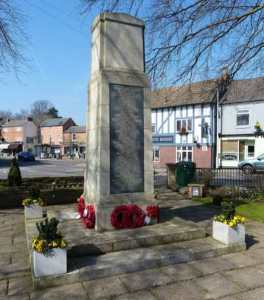 Quorn War Memorial
Quorn War Memorial
On 3rd January 1918 the battalion marched to Hermies and spent five days constructing defences there. A front line trench tour at Demicourt followed from 9th-15th January, after which the battalion provided more working parties for cable burying. January ended with another trench tour. February 1918 began with the battalion in Reserve at Yorkshire Bank. From here the companies of the battalion took turns in the support trenches for most of the remainder of February before moving back into Divisional Reserve at Bertincourt on 25th of the month.
On the night of 2nd/3rd March the battalion returned to the front line at Graincourt, moving back into the support trenches from 8th - 17th March. Between 17th and 20th March the battalion garrisoned Hermies and on 21st March, the first day of the Battle of Saint-Quentin, the enemy opened a heavy bombardment during which Ernest, aged 29, was killed.
Ernest is remembered on the Arras Memorial, Bay 3 and 4, on the war memorial at Quorn, and on the memorial in the former St. Peter's Church building, Loughborough, as well as on the Carillon.
Ernest's second daughter Phyllis was born around the time Ernest was killed. His widow moved to 1 Church Lane, Quorn, to be near her family.
|
|
|
|
Corporal 10554 Fred William Grant
|
|
2nd Bn, Leicestershire Regiment
Killed in Action 15th May 1915, Aged 23.
Commemorated Le Touret Memorial, panel 11.
|
Fred William Grant was born in Enderby, Leicestershire, in 1891. He was the oldest son of Edward Grant and Mary Jane Grant (née Follows) who were married in Lutterworth, Leicestershire, in 1889. Fred had two younger brothers Sidney and Harold, and two younger sisters Elsie and Ivy. By 1901 the family had moved to Stone Quarry Lodge, Stanton and Fred's father was an engine driver in the quarry. By 1911 the family had moved again and was living at 24 Grange Street, Loughborough, Fred's father having secured an engine driving job with the Borough Council. Fred had begun an apprenticeship as a moulder in an iron foundry.
On 29th December 1909 Fred had attested at Leicester and joined the 3rd Leicestershire Regiment Territorial Force. In the summer of 1910 he was specially trained in musketry and he was promoted from Private to Corporal on 8th August 1914.
He embarked for France on 19th March 1915 and joined the 2nd Leicesters in the field just after the battalion had taken part in the Battle of Neuve Chapelle (10th - 13th March). On 9th May the battalion was again in action at the Battle of Aubers Ridge and on 15th May, the first day of the Battle of Festubert, took part in a military operation north-east of Béthune.
Fred was wounded in action and reported missing on 15th May 1915 'and was regarded for official purposes as having died'. He was 23 years old.
Fred is commemorated on the Le Touret Memorial, Panel 11.
|
|
|
|
Private 31270 Samuel David Grant
|
|
7th Bn, South Lancashire Regiment.
Formerly 28264 Leicestershire Regiment.
Died at Home 11th December 1916, Aged 32.
Buried Horninglow (St. John) Churchyard, Staffordshire, Grave 242.
|
Samuel David Grant was born in Shepshed in 1884. He was the son of David Grant and his wife Emma (née Driver) who were married in the Barrow on Soar registration area in 1877. The Grants had eleven children, only seven of whom survived infancy. Samuel had two brothers William and Ernest and four sisters Eliza, Lucy, Ethel and Gladys. Samuel's father was a traction driver. In 1891 the family lived in Warner Street, Loughborough. By 1901 they had moved to 5 Granville Street and by 1911 to 54 Station Road. In 1911 Samuel was a general labourer.
In the late spring of 1916 Samuel married Annie Newman from Horninglow, Burton on Trent, Staffordshire, in Loughborough. The couple were not together for long, however, as Samuel enlisted with the Leicestershire Regiment in May 1916 as Private 28264. From the Leicestershire Regiment Samuel was almost immediately transferred to the 7th (Service) Battalion of the Prince of Wales's Volunteers (South Lancashire Regiment) as Private 31270 and sent to France in late August 1916.
Samuel joined the 7th Battalion in the field near Locre, West Flanders. On 3rd September the battalion moved to billets in the Romerin area of De Seule before moving to provide support in Ploegsteert Wood the following day. After the enemy shelled the wood they moved to nearby billets and then to camp at De Seule before proceeding to Outtersteene, France, and the training camp at St. Omer. At this point Samuel was sent to hospital for one day with dental problems. On 5th October the battalion entrained at Bailleul for Doullens and marched to billets at St. Léger-lés-Authie.
From 7th-11th October the battalion was in the front line trenches near Hébuterne where they were on the receiving end of shelling and Minenwerfer. From 11th-16th they were in shelters at Coigneux for training and attack rehearsals after which they marched to Contay on 18th. On 22nd they moved to the front line trenches north of Albert and during the move 7 ordinary ranks were killed and 28 ordinary ranks and 4 officers were wounded. After two days they went to billets in Aveluy before relieving troops at Wood Post and Leipzig Redoubt and then transferring to the front line on 30th October for two days.
When they were relieved on 1st November the transfer process was the most difficult they had so far experienced. The relief battalion was three hours late arriving; the enemy was shelling the communication trenches and the rain was torrential. After a beak at Aveluy they were back in the trenches on 5th November and amidst continuous enemy shelling.
Zero day for a planned attack had finally been settled as 13th November, and on 12th the battalion moved to Ovillers to stand ready. By the end of the Battle of the Ancre on 18th November 6 officers in the battalion had been killed and 6 wounded and of the ordinary ranks 14 had been killed, 80 wounded and 26 were missing. It is likely that Samuel was wounded in this battle and brought back to England. He died in hospital in Sheffield on 11th December 1916, aged 32.
Samuel is remembered on the memorial at the Church of St. John the Divine, Horninglow, on the memorial in the former St, Peter's Church building, Loughborough, and on the Carillon.
Samuel's wife Annie gave birth to their only daughter Elsie in late 1916; whether Samuel ever saw her is not known. In 1916 Annie had lost not only her first husband but also two of her brothers William and Arthur Newman who were killed within four days of each other in July on the Somme. Annie had another daughter Phyllis in 1918 in Burton-on-Trent and married a widower John Cheadle in 1919. With John Cheadle she had at least six more children
|
|
need photo
|
|
Corporal 297435 Thomas Bertie Graves
|
|
157th Heavy Bty, Royal Garrison Artillery.
Died Persian Gulf 21st August 1917, Aged 33.
Buried Baghdad (North Gate) War Cemetery, Iraq, VI. D. 10.
|
Thomas Bertie Graves was born at 30 East Laith Gate, Doncaster, Yorkshire in 1884 and baptised at Christ Church, Doncaster, on 21st September 1884. His parents were George Graves, a blacksmith, and Susan Graves (née Robson) who were married on 28th October 1876 at St. George's Church, Doncaster. Thomas had three brothers George, Henry and Richard and two sisters Lillie and Helen. Two other sisters Alice and Annie died young. By 1891 the family had moved to Britannia Terrace, 6 East Laith Gate and by 1901 to the Horse and Groom, 15, East Laith Gate. In 1901 Thomas was a butcher's apprentice. Thomas's parents later moved to 40 Rockwood Road, Wheatley, Doncaster.
On 4th September 1905 Thomas, now a butcher at Ranmoor, Sheffield, married Martha Ann Corbett at the Church of St. John the Baptist, Chapeltown, near Ecclesfield, Yorkshire. By 1911 the young couple had moved to 5 Meadow Lane, Loughborough, and Thomas was manager of a butcher's shop, working in the service of the British and Argentine Meat Company. Thomas and Martha later moved to 5 Albert Promenade. They had two daughters Edna and Jessie but Edna sadly died aged one.
Thomas probably enlisted in late 1915. The exact date of his enlistment at Leicester is unknown as his service papers have not survived. He had previously been a member of the Volunteer Training Corps in Loughborough, and was quickly promoted to the rank of Corporal. He joined 157 Heavy Battery of the Royal Garrison Artillery.
Heavy Batteries were equipped with heavy guns, sending large calibre high explosive shells in fairly flat trajectory fire. The usual armaments were 60 pounder (5 inch) guns, although some had obsolescent 5 inch howitzers. As British artillery tactics developed, the Heavy Batteries were most often employed in destroying or neutralising the enemy artillery, as well as putting destructive fire down on strongpoints, dumps, store, roads and railways behind enemy lines.
In early April 1916 Thomas's battery was at Hornsea, Lincolnshire. On 20th April the battery moved to Winchester on 29th May, to Bordon, Hampshire, for mobilization and then to Larkhill, Wiltshire, for firing practice. After returning to Bordon at the beginning of July the battery went to Devonport and on 11th July sailed on HMT Nestor for Bombay. The battery arrived in Bombay on 4th August and had two days for acclimitisation at Kinkee before embarking on HMT Janus for Basra.
The war diary for 157 Heavy Battery for 9th August to 31st October 1916 has been lost, but the record resumes on 1st November when the battery was at Makina, Basra. In Mesopotamia, under General Maude's reorganisation, the battery was now in the 3rd Corps, 14th Division.
On 23rd November the battery embarked on Steamer P24 for Sheikh Saad. From Sheikh Saad the battery marched via Serin Banks and Shafi to Kurna at the confluence of the Rivers Tigris and Euphrates, arriving on 7th December to take part in an offensive operation with the purpose of dislodging the enemy from the right (or western) bank position of the Tigris and severing the enemy's communication channels.
From Kurna the battery's route was via Sakricha, Ezra's Tomb, Abu Rubah, Qulat Salah and Abu Sidrah to Amara, reached on 14th December. By 18th December General Maude's Tigris Corps had extended their grip on the Turkish defences and had cut in opposite Kut between the outer Turkish defences and the west of the Hai, while simultaneously bombarding Sannaiyat and by Christmas Eve 157 Heavy Battery had returned to Sheikh Saad.
General Maude now directed his force in a steady advance up the Tigris, winning the Battles of Mohammed Abdul Hassan, Hai Salient, and Dahra B in January 1917, recapturing Kut in February 1917, and taking Baghdad on 11th March 1917.
After Baghdad fell there were still 10,000 Ottoman troops north of the city, led by Khalil Pasha, who could represent a threat to Anglo-Indian forces. Furthermore, another 15,000 Ottomans under Ali Ihsan Bey were being driven out of Persia by the Russians, and were attempting to join Khalil's forces. General Maude decided that, in order to avert these threats, he had to take control of the Samarrah railroad north of Baghdad.
Operations began on March 13th with 45,000 British troops. On March 19th they conquered Fallujah, a crucial step toward the offensive's goal. The British continued their attacks until April 23rd when the town of Samarrah and its railroad fell into their hands.
The summer of 1917 in Mesopotamia was extraordinarily hot. In Baghdad the British Army set up a special hospital in July 1917 on the Tigris at the Hinaidie Bend primarily to deal with the large numbers of heat stroke cases. Some of these were fatal in older soldiers whose temperatures rose to 110 degrees, resulting in heart failure. Thomas died of heat stroke in Baghdad on 21st August 1917, aged 33. He was one of 613 fatalities due to heat stroke in Mesopotamia in the summer of 1917.
He was buried in Baghdad (North Gate) War Cemetery, Iraq, Grave VI. D. 10.
|
|
|
|
Private 20467 Thomas Gray
|
|
D Coy. 6th Bn, Leicestershire Regiment.
Killed in Action 17th July 1916, Aged 38.
Commemorated Thiepval Memorial, Somme, pier & face 2 c & 3 a.
|
Thomas Gray was born in Loughborough in 1878, the son of James Gray and Elizabeth Gray (née Hunt) who were married in Loughborough in 1869. Thomas never knew his mother as she died about the same time as Thomas was born. In 1881 Thomas's widowed father, a dyer's labourer, was living with his own parents Patrick and Annie Gray at 14 Bridge Street, Loughborough. Thomas's older siblings Charles, James, and Bridget were also at 14 Bridge Street with their father and grandparents while Thomas, aged two, was two doors away at 18 Bridge Street being looked after by James Pratt, an elderly shoemaker, and his wife Mary. After both Thomas's grandparents died in 1887 the Gray family moved to 16 Shakespeare Street and the household included Thomas, his brother James and sister Bridget, his father, Thomas's uncle Thomas Gray and his aunt Maggie Gray. Thomas's father James died in 1892. Thomas next appears in 1911 as an unemployed labourer lodging in premises run by John Hueck at 5 Green Close Lane.
Thomas enlisted at Leicester in August 1914 and joined D Company of the 6th (Service) Battalion of the Leicestershire Regiment, part of Kitchener's First New Army, as Private 20467. Thomas was then sent to Bordon, near Aldershot, Hampshire where the emphasis was on individual training, squadron and platoon drill. In March 1915 the battalion went into billets in Liphook.
In April 1915 the 6th Battalion became part of the 37th Division of the Army and concentrated at Cholderton on Salisbury Plain. On 25th June the 37th Division was inspected by King George V at Sidbury Hill. On 22nd July 1915 most of the Division began to cross the English Channel but Thomas remained in England until December 29th 1915 when he was sent to France. At this point Thomas's battalion was near the front line south-west of Arras. In the months that followed the 6th Battalion did tours in the trenches, alternating with the 8th Leicesters who relieved them. The battalion was engaged in localised operations seeking a tactical advantage and remained in the area around Bienvillers and Bailleulmont until July 1916.
On 1st July 1916 the 6th Battalion moved from Saulty to Humbercamps, where it was held in reserve for the Somme Offensive which had just begun. On 6th July the battalion marched to Talmas to join the Army's 21st Division. From 7th to 10th July the battalion was in Hengest-sur-Somme, and from there on 10th marched to Ailly, entrained for Méricourt, took buses to Méaulte, and then proceeded to Fricourt. Between 14th and 17th July the battalion took part in an attack on and successfully captured Bazentin-le-Petit Wood and village. Thomas, aged 38, was killed in action in this battle.
Thomas is commemorated on the Thiepval Memorial, Pier and Face 2C and 3A.
Thomas's brother James lived at 18 Station Road, Loughborough, and his sister Bridget (Mrs.Hunt) at 8 Lower Cambridge Street.
|
|
|
|
Able Seaman Bristol Z/4431 Albert Charles Green
|
|
Howe Bn, R.N. Div, Royal Navy Volunteer Reserve.
Killed in Action 17th February 1917, Aged 19.
Commemorated Thiepval Memorial, pier & face 1 a.
|
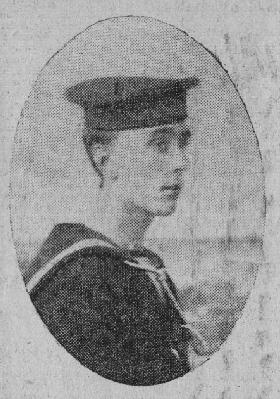
|
|
Albert Charles Green, known to his family as 'Chas', was born in Loughborough on 29th May 1897, the son of Richard Green and his wife Topsy (née Redding). Both parents originally came from Buckinghamshire and Chas's father was a navvy's excavator. Chas had two brothers Richard and Frederick and three sisters Alice, Susan and Gladys. In 1901 the Green family lived at 2 Court C, Baxter Gate, Loughborough, but by 1911 had moved to 1 Canal Bank, Bridge Street. In 1911 Chas's mother was now working as a charwoman and his father, although still working as a labourer, was in poor health. Chas himself was working as an assistant to a brushmaker. Chas's father died, aged 49, in 1913 and after this the family moved to 21 Edward Street. Chas now gained employment as a woodworking machine hand for the Brush Electrical Engineering Company.
Chas joined the Royal Naval Volunteer Reserve (RNVR) as Ordinary Seaman Z/4431 on 11th October 1915. He was attached to the 6th Battalion and sent to the training depot HMS Victory VI at Crystal Palace. He gave his religion as Church of England and stated that he was unable to swim. On 9th December 1915 he was put on the list of Royal Naval Division Reserves at HMS Victory IX and posted to the 7th Reserve Battalion at Blandford, Dorset, being rated as an Able Seaman. He spent eight days in Portland Hospital in February 1916 and on 10th May 1916 was transferred from 7th Reserve Battalion to the 2nd Anson Battalion at Blandford where he remained for almost one month before being transferred to the 2nd Reserve Battalion. On 9th September 1916 he was transferred again, this time to A Reserve Battalion. On 15th December 1916 Chas was lent to the Woolwich Recruiting Office for a trade test and not long afterwards, on 2nd January 1917 he was drafted to the Howe Battalion of the British Expeditionary Force.
Howe Battalion was one of eight battalions of the 63rd (Royal Naval) Division which, from July 1916, came under the aegis of the War Office rather than the Admiralty. Chas embarked at Folkestone for Calais on 3rd January 1917. On disembarking he was sent to the base depot at Calais and on 24th January he joined Howe Battalion which was taking part in the winter operations around the River Ancre in Picardy. The battalion was relieved from the trenches on 25th, marching to Engelbelmer on the following day. The battalion was back in the trenches on 1st February amid heavy snow and remained there until 8th, on the receiving end of enemy shelling and night firing. They nevertheless managed to capture 200 enemy prisoners. On being relieved the battalion moved to Engelbelmer and dugouts at Thiepval. On 10th February they moved to Forceville where three days training took place. On 14th the battalion proceeded to the area of Beaucourt in order to relieve the 7th Royal Fusiliers as a support battalion. On 16th February they moved up to the front line and occupied a position over 400 yards at Puisieux.
On 17th February an attack on the enemy began, with a preliminary barrage before Howe Battalion advanced. The attack was successful and the battalion captured 40 prisoners. The enemy nevertheless kept up hostile fire and there were about 180 casualties. Chas was killed in action, aged 19. He is remembered on the Thiepval Memorial, Pier and Face 1A. He is also commemorated on the memorial at Emmanuel Church, on the memorial in the former St. Peter's Church building, both in Loughborough, and on the Brush Company Memorial (in the Carillon Museum) as well as on the Carillon.
|
|
|
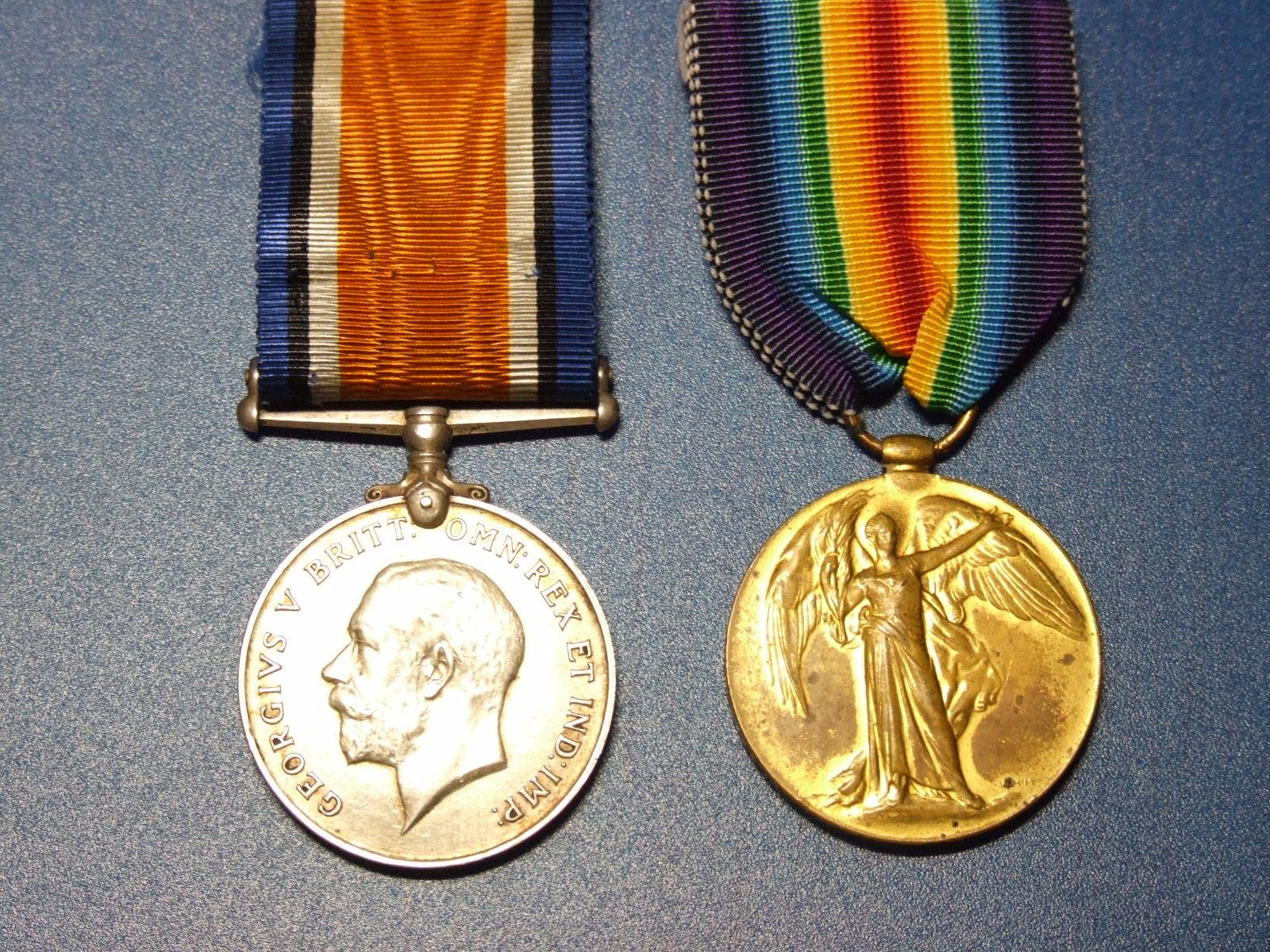
Albert's Medals
|
|
Private 255519 Alfred William Green
|
|
1/1st Leicestershire Yeomanry.
Died of Wounds 22nd June 1917, Aged 22.
Buried Villers-Faucon Communal Cemetery C 36.
(his brother Richard Green also fell see below)
|
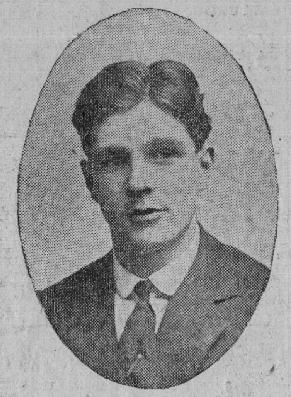
|
Alfred William Green was born on 25th November 1894 in Lichfield, Staffordshire, and baptised on 2nd January 1895 at Christ Church, Lichfield. He was the son of George Green and Annie Beatrice Green (née Gough) who were married at St. Paul's Church, Burton on Trent on 5th May 1884. George Green, formerly a Quartermaster in the Queen's Own Staffs Yeomanry, was a butcher and meat contractor with a shop in Lichfield and in the 1890s the Green family lived at Boston House, Walshall Road, Leomansley, Lichfield. Alfred had two brothers George and Richard and two sisters Nellie and Queenie. Two other siblings had died young.
After Alfred's father died, aged 40, in February 1900 Alfred's mother moved to 6 Bird Street, Lichfield, and carried on running her husband's butchers shop. By 1911, however, she had moved to 49 Toothill Road, Loughborough, and was running a boarding house. In 1911 Alfred, aged 16, was a packer in the hosiery trade in Loughborough. Alfred's mother later moved to 33 Clarence Street, Loughborough.
Alfred joined the 1/1 Leicestershire Yeomanry initially as Private 2587, but later renumbered as Private 255519. The Leicestershire Yeomanry had been formed on the creation of the Territorial Force in April 1908 and placed under orders of the North Midland Mounted Brigade. It was headquartered in Leicester and C Squadron was based in Loughborough.
Alfred was sent to France on 27th May 1915. He was in a draft of 200 ordinary Ranks who joined the Yeomanry in billets at Wittes, Ypres, on 31st May. Throughout June and July 1915 the Yeomanry remained in Wittes, providing working parties for digging trenches at Neuve Eglise, Sailly-sur-la-Lys and Elverdinghe. On 6th August they moved to new billets in villages near Hervarre while they dug trenches at Armentières, and on 29th September moved on again to Le Nieppe. In mid-October they moved to Noordpeene and then Fruges. Early November was spent digging trenches at Lynde, Ouderdom, Zillebeeke lake and north of Bielen. From there they moved to Wicquinghem on November 16th and dug trenches at Ebblinghem and Lynde. The regiment remained at Wicquinghem until 14th March 1916.
From then until 6th May 1916 the Leicestershire Yeomanry was in billets at Herly and Rollez before moving to Bourthes. From 15th to 20th May they were in training at Neuilly l'Hôpital, returning afterwards to Bourthes until 24th June. Between 24th June and 4th July the regiment transferred via Crécy en Ponthieu, Berteaucourt-les-Dames and Corbie to Fontaine-sur-Somme, where on 5th July they were sent to clear the battlefield. From 8th July to 1st August and back at Corbie they provided working parties to mend the roads at Henencourt and to clear the battlefield at Bécourt. The first five days of August were spent moving back to Bourthes where they remained until 11th September, providing working parties and sniping parties. From 11th September the regiment was continually on the march, which ended when squadrons moved into billets at Lebiez, Torcy and Rimboval in the Pas de Calais on 24th September. Here a group of 8 Officers and 256 Ordinary Ranks proceeded to form part of the 7th Cavalry Pioneer Battalion.
They did not move again until 1st February 1917 when they went into new billets at Merlimont Plage, on the Channel coast south-west of Etaples, where they spent until the beginning of April training men and horses and trialling the comparative effects of rifle and Hotchkiss machine gun fire. Between 4th and 19th April they marched to Arras and then on to Estruval (Somme). Between 12th and 24th May they proceeded to the area east of Epehy. At the beginning of June, at Buire, they provided trench parties in the outpost and support lines of the front.
On 22nd June 1917 the Germans attempted a raid. Three soldiers of the Yeomanry were brought in wounded and all died. Alfred was one of them. He was 22 when he died. Alfred was buried in Villers-Faucon Communal Cemetery, north-east of Peronne, Grave C 36. He is commemorated on the memorial in the former St. Peter's Church building, Loughborough, and on the Carillon.
Alfred's brother Richard who served with the Grenadier Guards, died of wounds received in action in 1914.
|
|
|
|
Sapper WR/282461 David Green
|
|
23rd Light Railway, Royal Engineers.
Died 5th December 1918.
Buried St Pol British Cemetery, St Pol Sur Ternoise, D 13.
|
Nothing is known about David Green's origins and life prior to the war except that he was married and that his wife Isabella M. Green was living and possibly working at the Bull's Head Hotel, Loughborough, when David died in France in 1918.
David's service papers have not survived but he enlisted with the Royal Engineers (RE). He became Sapper 255885 (later renumbered WR/282461) in the 23rd Light Railway Operating Company of the RE. The 23rd Light Railway Company was raised at Longmoor in Hampshire and the prefix 'WR' to David's service number indicates that his area of speciality was waterways and railways. The precise date of his enlistment is unknown.
The Longmoor Military Railway (LMR) was built by the Royal Engineers in 1903 in order to train soldiers on railway construction and operations. The railway was relaid to 4 ft 8 1⁄2 in (1,435 mm) standard gauge in 1905-1907 and was initially known as the Woolmer Instructional Military Railway. As a training railway, it was often constructed and deconstructed. The layout often changed, and at one time it housed a machine which could lay 1,500 yards (1,400 m) of track a day.
A Light Railway Company consisted of approximately 200 men, in a number of trades: drivers, brakesmen, guards, wagon repairers, repair shop engineers, traffic controllers and storemen, with a few supervising officers. The job of the Company was to run the trains, with the tracks being laid by RE Railway Construction Companies - often with the assistance of whatever Labour Corps Company or 'resting' infantry were at hand.
Although the British Army on the Western Front had used the French standard gauge railways to move men, equipment and supplies along the lines of communication from the Channel Ports to the Divisional railheads from the earliest days of the Great War, it relied largely on horsed transport and manual effort to move it from the railhead to the front lines. In 1915 the French Army built a narrow gauge railway along the Somme Canal between Péronne and Froissy which greatly aided the transport of supplies to the Somme battlefield in 1916.
The formation of the RE Light Railway Companies in early 1917 was a factor that transformed the operational abilities of the Allies. Goods and men could now make the last leg of the journey to the front by light rail. For the final leg petrol engines were used so that no smoke or steam could be spotted by the enemy. Until 1917 ammunition supply in particular had been subject to delays and required vast numbers of men and horses, and the light railways helped overcome both problems. Traffic and wear on the roads and tracks leading up to the front was eased, and fewer men were required to repair them.
The 23rd Light Railway Company went to France on 23rd March 1917. It was a Miscellaneous Trades Company and was probably co-located with the Light Railway Workshops, possibly at Berguette and then after the German Spring Offensive in March 1918 at Beaurainville, thirty miles away from the front. The move from Berguette to Beaurainville took three months. The workshops at Beaurainville remained operational until July 1919, helping to keep vital supplies moving in the months after the Armistice.
David died on 5th December 1918 in No. 12 Stationary Hospital, St. Pol-sur-Ternoise, France. He was buried in St. Pol British Cemetery, Grave D13.
|
|
|
|
Lance Corporal 8499 John Henry Green
|
|
2nd Bn. Hampshire Regiment.
Died of Wounds Gallipoli 8th August 1915, Aged 21.
Buried Lancashire Landing Cemetery, Turkey, G 27.
|
John Henry Green was born in 1894 in Derby, the son of William Henry Edward Green, a cooper working with ale barrels, and his wife Minnie Marianne (née Taylor) who were married at St. James the Greater Church in Derby in 1882. William and Minnie had a large family of at least ten children, although not all seem to have survived to adulthood. The family initially lived at 4 Charlotte Street, Derby, but by 1901 had moved to 53 St. Helen's Street. It is clear that family life was not easy for the parents as one of their daughters, Alma, was in Bristol Industrial School for Girls in 1901. Life became even more difficult when the children's father William Green died in 1907 and their mother Minnie died five years later in 1912. It is possible that young John was also sent away from home or simply left Derby as he attested for the military in Bristol before 1911. In 1911 he is listed, aged 17, as a Private with the 1st Battalion of the Hampshire Regiment, occupation musician, in Badajos Barracks, Wellington Lines, Aldershot, Surrey.
In August 1914 the 1st Battalion was in Colchester as part of the 11th Brigade of the 4th Division. Shortly after moving to Harrow they went to France, landing at Le Havre on 23rd August 1914. From August to November 1914 they were in action at the Battles of Le Cateau, the Marne, the Aisne, Messines and Armentieres.
At some point between November 1914 and March 1915 John Green was promoted to Lance-Corporal in the 2nd Battalion of the Hampshires. The 2nd Battalion was in Warwick and training for France when orders arrived to depart for Gallipoli. They embarked from Avonmouth on the 20th and 21st March 1915 sailing via Malta, Alexandria, Egypt, and Lemnos, Greece, then on to Mudros , Turkey. The battalion joined the Gallipoli landings on the morning of 25th April on 'V' Beach and suffered many casualties while wading ashore in deep water.
The battalion continued to have a difficult time at Gallipoli, and lost a lot of men on one particular day - 6 Aug 1915. On that day they attacked two trenches at 1550 hrs in four waves, and all went well until they reached a low crest. They were then raked by Turkish machine gun fire, and only a few men reached the trenches. The casualties for that one attack were 18 officers and 224 other ranks killed or missing, with two officers and 210 other ranks wounded. Many of the wounded had to stay out in the open until it got dark, whereupon they crawled back to their own lines or
were brought back. John Green was one of those wounded and he died two days later.
John was the brother of Mrs Gertrude M. Chell of 40 Station Street, Loughborough.
|
|
|
John's Memorial Plaque
|
|
Private 12758 Richard Green
|
|
2nd Bn, Grenadier Guards.
Died of Wounds 14th September 1914, Aged 26.
Commemorated La Ferte - Sous - Jouarre Memorial, Seine et Marne.
(his brother Alfred Green also fell see above)
|
Richard Green was born in Lichfield in 1888 and baptised on 21st April 1888 at Christ Church, Lichfield. He was the son of George Green and Annie Beatrice Green (née Gough) who were married at St. Paul's Church, Burton on Trent on 5th May 1884. George Green, formerly a Quartermaster in the Queen's Own Staffs Yeomanry, was a butcher and meat contractor with a shop in Lichfield and in the 1890s the Green family lived at Boston House, Walshall Road, Leomansley, Lichfield. Richard had two brothers George and Alfred and two sisters Nellie and Queenie. Two other siblings had died young.
After Richard's father died, aged 40, in February 1900 Richard's mother moved to 6 Bird Street, Lichfield, and carried on running her husband's butchers shop. By 1911, however, she had moved to 49 Toothill Road, Loughborough, and was running a boarding house. She subsequently moved to 33 Clarence Street, Loughborough.
In 1911 Richard, aged 23, was a van driver. He was later employed at the Working Men's Industrial Trading Society in Loughborough. On 26th November 1912 Richard married Florence Annie Allen at St. Peter's Church, Loughborough, and the couple set up home at 22 Paget Street. Their son George was born early in 1913 and their son Richard in early 1915.
When war broke out Richard, a Reservist with the Grenadier Guards, left Loughborough to re-join his regiment at Wellington Barracks on August 4th 1914. A fortnight later, as Private 20467, he left Southampton for the front and was in active service at the Battle of Mons, the First Battle of the Marne, and the First Battle of the Aisne where he was severely wounded. Suffering from gunshot wounds he was being sent to England on the hospital ship Carisbrooke Castle when he died at sea on 14th September 1914. He was buried at sea.
Richard is remembered on the memorial in the former St. Peter's Church building in Loughborough as well as on the Carillon.
His brother Alfred who was with the Leicestershire Yeomanry was killed in 1917.
Richard's widow Florence was remarried in 1920 in Loughborough to George Pepper.
|
|
|
|
Private 12181 Charles Matthew Grimbley
|
|
8th Bn. Leicestershire Regiment.
Killed in Action 25th September 1916, Aged 26.
Commemorated Thiepval Memorial, pier & face 2c & 3a.
|
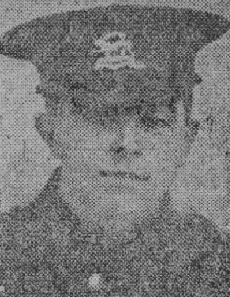
|
|
Charles Matthew Grimbley was born in Loughborough in late 1889 or early 1890. He was the son of Charles Grimbley, a boiler maker, and his wife Hannah (formerly Percival, née Smith) who were married in Loughborough in 1883. Charles's mother had been previously married in 1875 to Andrew Percival who had died, aged 26, in 1882. Her three children by Andrew Percival -Clara, Emma and Thomas-were in the Grimbley household at 15 Cross Street, Loughborough, in 1891. Hannah had five more children with Charles Grimbley but only two lived to adulthood, Charles Matthew and his sister Beatrice. In 1901 the Grimbley/Percival household was still in Cross Street, but at house no. 3. Charles Matthew's mother died in 1906 and by 1911 Charles Matthew was a puncher and shearer for a boilermaker. His father died in 1913 having moved from Cross Street to 51 Morley Street.
Charles enlisted in early September 1914 and joined the 8th (Service) Battalion of the Leicestershire Regiment as Private 12181. From the Depot he was sent firstly to Aldershot for training. He moved to Shorncliffe in Kent at the end of February 1915. In April 1915 Charles's battalion became part of the newly established 37th Division of Kitchener's 2nd New Army and the Division began to concentrate on Salisbury Plain. On 25th June the units were inspected by King George V at Sidbury Hill. On 22nd July the Division began to cross the English Channel and Charles travelled to France on 29th July 1915. Initially the 37th Division concentrated near Tilques.
The 8th Battalion then moved via Watten, Houlie, St. Omer, Eecke and Dranoutre to Wulverghem and Berles-au-Bois, a short distance from the front line. In the months that followed the 8th Battalion did tours in the trenches, alternating with the 6th Leicesters who relieved them. They were Involved in operations in Bailleul, Le Bizet, Armentières, Mondicourt, Beauval and Berles-au-Bois.
In April 1916 Charles had moved with the 8th Leicesters to the Doullens area for six weeks cleaning up, resting and training. In mid-May they returned once more to the trenches in the Bienvillers-Bailleulmont sector, but nearer Gommecourt. In June there was a series of nightly excursions into No-Man's Land with patrols attempting to gather information on the enemy's dispositions. On other occasions there were working parties out repairing the British barbed wire entanglements. The situation became increasingly hazardous as the month wore on when the Germans began to use a new and more accurate type of trench mortar.
The 8th Battalion did not participate in the first days of the Somme Offensive but was held in reserve. On 6th July Charles's battalion left billets at Humbercamps and marched to Talmas, continuing on the following day to billets in Soues. On 10th July the battalion marched to Ailly-sur-Somme, entrained for Méricourt and travelled from there by lorry to bivouacs in Méaulte. Between 10th and 13th July the battalion was in the trenches near Fricourt and subjected to fairly continuous enemy fire.
On the 14th July the battalion was in action at the Battle of Bazentin Ridge. After the battle the battalion withdrew to Ribemont and then to Méricourt, and having entrained for Saleux, marched to Soues. From Soues the battalion moved to Longeau, Gouy-en-Ternois, Lattre St. Quentin and then to Arras where they went into the trenches on 29th July. Casualty figures for the battalion in July had been high: 17 officers and 415 other ranks had been killed, wounded or were missing.
The battalion went into Divisional Reserve at Agnez-les-Ouisans on 8th August but went back into the trenches at Arras on 18th August where they were on the receiving end of trench mortar bombs and heavy shells until 2nd September. They were relieved on 2nd September and marched to Duisans and on the following day proceeded to Lignereuil. On 13th September they marched to Frevent and entrained for Dernancourt. On 15th they reached a point between Fricourt and Méaulte before proceeding to Trônes Wood on 16th.
From 17th-23rd September the battalion was in reserve and supporting the troops in the front line by providing carrying parties. In the evening of 24th September the battalion marched up to take their position ready for an attack but before they reached this point the men were heavily shelled by the enemy. Just after midday on 25th September the 8th Leicesters launched a successful attack in waves on the right of Flers and then pressed on to Gueudecourt, Considerable losses, however, were suffered in this action.
Charles was killed in action on 25th September, aged 26. He is commemorated on the Thiepval Memorial Pier and Face 2C and 3A, and on the memorial at All Saints Church, Loughborough, as well as on the Carillon. His effects were divided equally between his sister Beatrice Grimbley and his half-sister Clara Housley (née Percival).
|
|
|
|
Private 1754 Henry Archer Grudgings
|
|
1/1st Leicestershire Yeomanry.
Killed in Action 13th May 1915, Aged 24.
Buried Bedford House Cemetery, Enclosure no, 4 V. F. 10.
|
|
Henry Archer Grudgings was born in Loughborough in late 1891 or early 1892 and baptised at Emmanuel Church, Loughborough, on 21st August 1892. He was the son of Daniel Grudgings and his wife Emma (née Start) who were married at Emmanuel Church, Loughborough, on 27th October 1874. Henry had one brother Daniel and three sisters Bertha, Ethel and Florence. Two other siblings died young. When Henry was born the family lived at 1 Albert Street, Loughborough, but by 1901 had moved to 20 Beacon Road. Henry's father died in 1904.
Henry was the first cousin of William 'Bill' Grudgings who kept the war diary which is on Twitter. Their respective fathers Daniel and William, both sons of Daniel Grudgings (1829-1876) and his wife Ann (née Hobill), were in business together and operated the hosiery needle manufacturing company 'Daniel Grudgings and Bros.' of Albert Street, Loughborough. There was a second needle manufacturing company owned by a related branch of the Grudgings family 'J. T. and C. Grudgings', in School Street.
Henry was educated at Loughborough Grammar School and started work as an electrical engineer with a lifting gear manufacturer (probably Herbert Morris Ltd.).
Henry joined the Leicestershire Yeomanry as Private 1754 at the end of January 1911, aged 19.
The Leicestershire Yeomanry was headquartered in Leicester and C Squadron was based in Loughborough.
The 1/1st Leicestershire Yeomanry was mobilised on 5th August 1914 and billeted in the village of Palgrave, Suffolk, until 1st November 1914. On 2nd November they entrained at Diss with the horses and travelled to Southampton Docks. They sailed for France, arriving at Le Havre the following day, and proceeded to No. 2 Rest Camp. On 4th November they entrained for St. Omer and marched to Esquerdes where they remained for four days to carry out bayonet and entrenching exercises.
On 11th November they marched to Eecke to join the 3rd Cavalry Division and on the following day proceeded via Poperinghe to Bellewaarde Farm on the Hooge Road east of Ypres. Here they joined the 7th Cavalry Brigade and were sent to the support and reserve trenches. On 16th they moved to billets in Ypres where they were heavily shelled. From 17th - 21st November A and C Squadrons were in the advance, support and reserve trenches east of Zillebeeke and B Squadron was in dugouts near the Menin-Ypres road. From 22nd November to 4th December they were at St. Sylvestre near Caestre refitting and exercising while being on duty in General reserve.
On 3rd December they paraded with the 7th Cavalry Brigade for an inspection by His Majesty the King. From 7th -17th December they were based at Oxlaere and then Berthen for drill and entrenching practice while again being in General reserve. On 18th December they moved to an area south of Hondeghem and the Caestre road. Here classes for reserve stretcher bearers and machine gunners took place. On 22nd December they moved to La Brearde where they remained until 2nd February 1915 for training in an advanced guard scheme, hand grenade and entrenching instruction, route marches and inspections.
On 3rd February they were transported by bus to Ypres and marched to Zillebeke where they took over the front line trenches. They spent several days draining and improving the trenches amid enemy sniping. Relieved on 8th February they moved to billets in Ypres as part of the General reserve. On 11th February there was heavy shelling near their billets and on the following day they moved by bus back to La Brearde. Training took place there until 11th April.
On 12th April they moved to Renescure and on 23rd April marched via Abeele to Godewaersvelde. On 24th they proceeded to Vlamertinghe before moving at night to Reninghelst. On 25th and 26th April they moved via Poperinghe and Watou to Forge, where they left the horses, and returned to Vlamertinghe. On 27th they were shelled out of their huts and bivouacked in a field. On 28th they moved to Abeele and over the next three days met up with the Brigade at Forge.
In early May they left the horses at Vlamertinghe and marched to Hazebrouck before going by bus to Brielen near Ypres. On 12th May, as dismounted infantry, they took over the trenches north of the railway near Bellewaarde Farm and immediately became involved in the Battle of Frezenberg Ridge (otherwise called the 2nd Battle of Ypres). During this battle on 12th and 13th May the Leicestershire Yeomanry suffered 186 casualties.
Henry was killed in action on 13th May 1915, aged 24. He was buried in Bedford House Cemetery, Enclosure no, 4 V. F. 10. He is commemorated on the memorial in Emmanuel Church, Loughborough.
[Note: Henry is erroneously recorded on some official documents as 'Henry Arthur
Grudgings'.]
|
|
|
|
Private 82181 Thomas Cyril Guest
|
|
20th Bn. Durham Light Infantry.
Killed in Action 12th September 1918, Aged 19.
Buried Grootebeek British Cemetery, G. 8.
|
Thomas Cyril Guest was born in Loughborough in 1899. He was the son of David Henry Guest, a cycle maker, and his wife Elizabeth Florence Mary (née Townley) who were married on 12th December 1891 at St, Luke's Church, Chorlton upon Medlock, Lancashire. Thomas had four brothers Henry, Gilbert, Harold and David, and one sister Nellie. In 1901 the family lived at 47 Mersey Street, Warrington, Lancashire. In 1908 Thomas's father died and in 1911 Thomas and his brothers were with their widowed mother at 46 Matlock Road, Birkdale, Southport, while Nellie, aged 7, was with their aunt Isabella Golder (née Townley) and her husband George at 23 Wood Street, Blackpool.
On 4th August 1912 Thomas's mother married Henry Finegan, an engineer's labourer in the shipbuilding industry, at St. Peter's Church, Birkdale, Southport. Henry, however, unfortunately died three years later.
Thomas, now a butcher's assistant, enlisted as soon as he was eighteen years old, on 27th August 1917. He was sent to the 43rd Training Reserve Battalion at Wareham, Dorset, as TR/3078. On 12th December 1917 he was transferred to the 4th Reserve Battalion of the Loyal North Lancashire Regiment as Private 41334.
On 4th April 1918 Thomas was sent, via Folkestone and Boulogne, to an Infantry Depot in Etaples. On the following day he was transferred to the Durham Light Infantry with the new number of 82181 and sent to join their 20th Battalion in the field.
Thomas joined the 20th Battalion at Steenvorde on 6th April. He was one of a draft of 448 Ordinary Rank reinforcements for the battalion. On 7th April the battalion marched to a camp in west Vlamertinghe and on 8th entrained at Brandhoek station for St. Jean, where they went into Reserve for reorganisation and specialist training. On 12th April the battalion was suddenly ordered to dig a new line of strongposts at the rear of the front line. They spent the next two days completing the strongposts. After this A and C Coys were left to guard the strongposts while the rest began digging new trenches behind this new strongpost line.
On 19th April the enemy attacked one of the new posts on Hill 35. The battalion fought back but were driven off. They remained in the line until 26th April and then proceeded to Ypres to occupy a line of trenches in front of Dead End. Here they experienced hostile shelling and heavy artillery fire. From 2nd-10th May the battalion was in Brigade reserve in camp near Vlamertinghe, working on a new line under the Royal Engineers and undergoing specialist training. Back in the front line from 11th-26th May the battalion was occupied with working parties and night patrols.
From 26th May to 2nd June the battalion was at Brake Camp for working parties and training. On 3rd June they left Brake Camp by light railway for Proven, travelled by broad gauge railway to Watten and marched to billets in Lederzeele. Most of the rest of June was spent in billets at Bonningues-lès-Ardres and Oudezeele for training and sports before the battalion moved via Abele, back to the line at Kemmel on 30th June.
During July and early August the battalion carried out several trench tours in the front and support lines with a break in Brigade reserve at Reninghelst. From 10th-23rd August they were kept at Reninghelst for inspections, training and work on the Scherpenburg and Dickebusch Lake line. From Divisional reserve at the end of August they carried out night patrols.
The battalion returned to the front line in the Dickebusch area on 2nd September and two days later launched an attack on the enemy. Having taken their first objective they were forced to withdraw as their flanks were being enfiladed by machine gun fire. On 11th September 1918, while three companies of the battalion were on a night working party, three Ordinary Ranks were killed and nine wounded. Thomas, aged 19, was one of those killed.
Thomas was buried in Grootebeek British Cemetery, west of Ypres, Grave G 8.
|
|
|
|
Engine Room Artificer 4th Class M/2616 Walter Craig Gunn
|
|
Royal Navy HMS Queen Mary
Killed in Action Jutland 31st May 1916, Aged 21.
Commemorated Portsmouth Naval Memorial panel 15.
|
Walter Craig Gunn was born in Tyne Dock, South Shields, on 8th May 1895. He was the son of Walter Craig Gunn senior and his wife Grace Ann (née Miles) who were married in the district of South Shields in 1892. In 1901 the family was living at 14 Rosebery Street, Sunderland, and Walter Gunn senior was a grocer's manager. Walter junior had three brothers Ronald, Stanley and Frederick and one sister Ailsa.
Walter junior's father died, aged 30, in December 1901 and on Christmas Day 1907 his mother was married again at St. Leonard's Church, Hoton, Leicestershire, to Walter Elliot. In 1911 the Elliot/Gunn family was living at 94 Burder Street, Loughborough, and Walter's step-father was employed as a wood machinist at the Brush Electrical Works. Walter now had two step-brothers Arthur and William Elliot and one step-sister Kathleen Elliot. In 1911, however, Walter and his brother Ronald were no longer at home. Ronald was boarding at Durham School and Walter, aged 15, was training as an Artificer with the Royal Navy.
The Royal Navy had initiated a training programme for engineers and artificers in response to concerns that the Imperial German Navy seemed likely to overtake the Royal Navy in seagoing technical expertise. Training took place in Victorian hulks training centres at Portsmouth and Walter trained aboard HMS Fisgard II. On 8th May 1913 Walter signed up with the Navy for twelve years' service.
When war broke out Walter was fully qualified as an Engine Room Artificer 4th Class, with the service number of M/2616. On 22nd January 1915 he was assigned to HMS Queen Mary, a battlecruiser in the 1st Squadron.
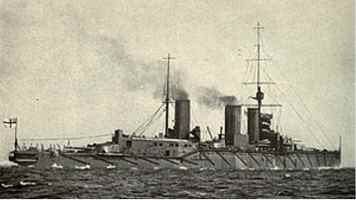
HMS Queen Mary
The HMS Queen Mary sailed in support of the 5th Battle Squadron in the opening phases of the Battle of Jutland on 31st May 1916. A shell from SMS Derfflinger struck Queen Mary, detonating one or both of its forward magazines. The resulting explosion broke the battlecruiser in half near its foremast. A second shell from Derfflinger may have hit further aft. As the ship began to roll it was rocked by a large explosion before sinking.
The wreck of the HMS Queen Mary was discovered in 1991, resting on the bed of the North Sea. The wreck is designated as a protected place as it is the grave of 1266 Officers and men, including Walter. Only 20 of the ship's crew were rescued.
Walter was only 21 when he died. He is commemorated on the Portsmouth Naval Memorial, Panel 15, and on the memorial in St. Mary's Church, Heworth, east of Gateshead.
Walter's brother Ronald, a 2nd Lieutenant with the Sherwood Foresters, was killed in action in 1917. His brother Stanley, who served with the King's Own Yorkshire Light Infantry, survived the war.
|
|
Rifleman 51987 John Frederick Gutteridge
|
|
D Coy. 4th Bn. 3rd. N.Z. Rifle Brigade.
Killed in Action 7th January 1918, Aged 24.
Buried Oxford Road Cemetery, III. G. 10.
|
|
John Frederick Gutteridge was born in Loughborough in late 1892 or early 1893 and baptised on 19th March 1893 at All Saints Church, Loughborough. He was the son of John Thomas Gutteridge, a framework knitter, and his wife Sarah Jane (née Charles) who were married at All Saints Church on 2nd March 1889. John Frederick had three brothers Arthur, Harold and Frank and three sisters Alice, Nellie and Elsie. In 1901 the Gutteridge family was living at 22 Lower Cambridge Street, Loughborough, but they later moved to 19 The Avenue, Gladstone Street and then to 72 Gladstone Street. In 1911 John Frederick, aged 18, was a joiner's apprentice in greenhouse construction at Messenger and Co.
Having completed his apprenticeship in early 1914 John Frederick emigrated to New Zealand. There he was initially employed as a carpenter for Trevor Brothers Ltd, building contractors of Wellington and Palmerston North. He was subsequently occupied with war work up to the spring of 1917 and living at 13 Dixon Street, Wellington.
On 1st March 1917 he enlisted with the New Zealand Forces and began military training as Rifleman 51987. On 19th June 1917 he embarked on the HMNZT 85 Willochra as part of a batch of 26th Reinforcements, G Company, for the New Zealand Expeditionary Force. He had previously been rejected for service as he had been suffering from a hernia. All New Zealand military records for John are under the surname of 'Gutheridge'. Whether this was an error or whether John had now changed his surname is unknown as his signature on his enlistment documents is very unclear. He arrived in Devonport, England, on 16th August 1917 and went to Brocton Camp, Cannock Chase, Staffordshire. On 23rd October he was sent to France, reaching Etaples three days later. On 3rd November he was posted to D Coy of the 4th Battalion of the 3rd New Zealand Rifle Brigade. The New Zealand Rifle Brigade (Earl of Liverpool's Own) was affectionately known as 'The Dinks'.
John joined his battalion in the field at Cremarest and Belle Brune between St. Omer and Boulogne. The Brigade remained here until 8th November resting, reorganizing and training. On 9th November the Brigade moved eastward again to Seninghem, Bayenghem and Coulomby, and continued training in that area until the 12th. On 13th November they moved up by rail to Houpoutre, near Poperinghe, and marched to Scottish Wood Camp, east of Dickebusch. On the following day the Brigade commenced the relief of the 13th and 15th Brigades in the Becelaere Sector of the Ypres Salient, the 4th Battalion initially being positioned in reserve at Railway Dugouts, close to Zillebeke Lake, before proceeding into the front line at Reutel.
The front line was continuously swept by enemy machine gun and artillery fire. Places as 'Dead Mule Gully' and 'Hellfire Corner' were appropriately named. Miles of duckboard tracks gave the only access to the trenches and every hollow was a bog.
Relieved on the night of 19th/20th November the 3rd Battalion moved back to the support position and after six days into Divisional Reserve at Walker Camp, north of Dickebusch. From here the men supplied working parties for the Divisional Salvage Officer to remove wreckage and to collect valuable material of all kinds, such as rifles, machine-guns, harness, wagons and limbers; cartridges, bombs, shell-cases and live shells of all calibres; coils of barbed-wire, stakes and tools; discarded clothing and web-equipment-the flotsam and jetsam of recent battles.
On 1st December the 4th Battalion moved into the front line in the Becelaere sector, with the headquarters in an old German Pill-box. Each battalion had a tour of about a week in the line, followed by a similar period in support, and then went out to reserve for the same length of time. On the night of 9th/10th December the battalion moved back into Divisional Reserve at Dickebusch Camp and continued with salvage work as well as participating in recreational training.
Christmas Day was celebrated in festive fashion before the Brigade returned to Divisional support, with Headquarters at Lille Gate, one battalion in the line and the 4th Battalion moving to Manawatu Camp to continue with salvage. On 2nd January 1918 the 4th Battalion moved into the front line at Noord. John was killed in action on 7th January, aged 24. In a letter to John's parents, the Chaplain wrote: 'Your son was starting out with a working party at 3 am, when the platoon was filing round a shell hole a Boche shell burst killing your son and a corporal, and wounding others. Some of the pieces of shell struck him on the head and the body, and death was instantaneous. The funeral was attended by his C O and the remainder of the platoon.'
John was buried at Oxford Road Cemetery, near Zonnebeke, Grave III. G. 10.
John's Commanding Officer wrote to John's parents saying: 'Your son died doing his duty for his Empire and his loved ones, He was respected by all his mates'.
John is commemorated on the New Zealand Roll of Honour under the surname of 'Gutheridge' and on the memorial in All Saints Church, Loughborough, and on the Carillon, under the surname of 'Gutteridge.
|
|
|
|
Private 25439 Henry (Harry) Hack
|
|
4th Bn, Worcestershire Regiment.
Killed in Action 21st April 1916, Aged 28.
Buried Mesnil Ridge Cemetery, Somme, F. 4.
|
Henry Hack, known as 'Harry', was born on 28th September 1887 in Loughborough, the youngest son of William Hack and his wife Ann (née Clark). Harry had three older brothers William, Charles and John and three older sisters Ada, Ellen and Mary Ann. Harry's parents were married in Loughborough in 1865. In 1865 his father was a shoemaker in Leicester, but he eventually joined the Hack family's butchery business at 3 The Rushes, Loughborough and became a tripe dresser.
Harry grew up at 3 The Rushes in a household which included not only his parents and siblings but also his two maiden aunts Emma and Mary Ann Hack. Harry also joined the family business and became a tripe dresser with his father and older brother Charles. His father died in 1900 and his mother in 1904 and two years later in 1906 Harry married Sarah Elizabeth Ferrin in Loughborough. Harry and Sarah set up home just off The Rushes at 23 Shakespeare Street and by 1908 had two sons Sidney and William. Sarah Hack also had another son Frank Hack in 1917 but Frank's father was not Harry Hack.
Harry enlisted in November 1915 and joined the Worcestershire Regiment as Private 25439. He was sent to join the 4th Battalion in the Dardanelles on 6th December 1915. On the nights of 7th and 8th January 1916, the battalion was evacuated from Gallipoli and sent to Egypt where orders were received on 25th February for a move from Suez to France. Harry sailed from Alexandria on 15th March and arrived at Marseilles on 20th March.
From Marseilles the battalion travelled by train to the area east of Pont Remy in the Somme area of Picardy, arriving there on 23rd March. Various route marches took place until the beginning of April, followed by training at Louvencourt until 12th April when the battalion was ordered to proceed to Mailly-Maillet for trench work. On 18th April orders were received for the battalion to relieve the Royal Munster Fusiliers and part of the Royal Dublin Fusiliers in the firing line. On 21st April, while the men were repairing the trenches, a dugout was hit by a mortar shell, killing four men instantaneously including Harry Hack.
In a letter to a relative the captain of the company said that it was a most unfortunate occurrence, but such was the fortune of war. The letter concluded with a note that the battalion regretted the loss of such good soldiers greatly.
Harry Hack was buried at Mesnil Ridge Cemetery, Somme, Grave F. 4.
|
|
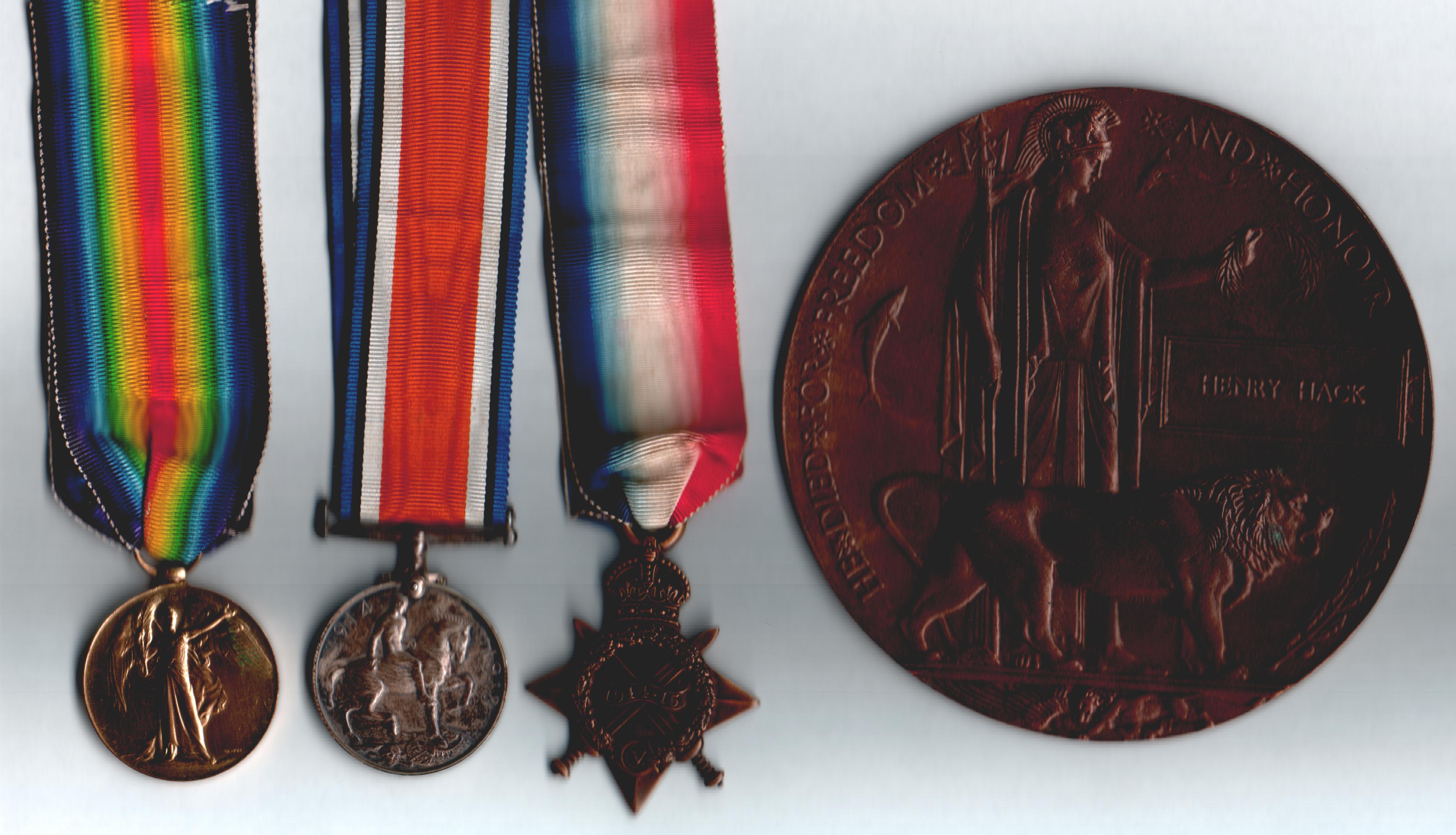
Henry Hack Medals & Death Plaque
|
|
|
|
Private 2669 Frederick Arthur William Hague
|
|
7th Bn, Australian Infantry, A.I.F.
Died of Wounds 19th August 1916, Aged 25.
Buried Becourt Military Cemetery, Somme, I. T. 6.
(his brother Leonard Hague also fell see below)
|
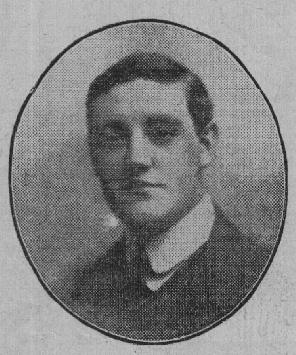
|
Frederick Arthur William Hague was born in Loughborough in 1890. He was the eldest son of William Goodacre Hague and his wife Emma (née Gibson) who were married in Loughborough in 1879. William, a hosiery machine fitter, and Emma had nine children, eight of whom survived to adulthood. Frederick had five sisters Edith, Carrie, Gertrude, Florence and Hilda and two brothers Leonard and Everard. In 1891 and 1901 the family lived at 3 Cobden Street, Loughborough, but by 1911 had moved to 1 Forest Road. Frederick attended Holy Trinity Church in Loughborough.
Frederick, who in 1911 was a clerk in the timber trade in the offices of Messrs, J. Griggs and Co., in Loughborough went to Australia in 1913 to take up farming. By 1915 he was living at 145 Blythe Street, Brunswick, Melbourne, Victoria, Australia and was employed as a farm labourer. He also had connections with Vectis East, near Horsham, Victoria.
Frederick enlisted in Melbourne on 4th August 1915. As Private 2669 he embarked in Melbourne, Australia on H.M.A.T. Ulysses on the 27th October 1915 with the 6th Reinforcements, 24th Battalion, of the 6th Australian Infantry Brigade (Australian Imperial Force). In Egypt he was initially sent to the 6th Training Battalion at Zeitoun but was taken on the strength of D Company of the 7th Battalion of the Australian Infantry at Serapeum, Egypt, on the 24th February 1916. Frederick embarked in Alexandria, Egypt, to join the British Expeditionary Force on the 26th March 1916, disembarking in Marseilles on 31st March. Upon arrival, his battalion was sent to Morbecque, west of Armentières and it was in this area that the men entered the front line trenches for the first time on 3rd May. The battalion's first major action in France was at Pozières in the Somme valley where it fought between 23rd-27th July and 15th-21st August 1916.
Frederick was wounded in action on 17th August 1916. He was admitted to the 1st Australian Field Ambulance suffering from a gunshot wound to the neck on 19th August 1916. He died from his wound on the same day, aged 25, and was buried in Becourt Military Cemetery, Becordel-Becourt, near Albert, by the Officer Commanding the 1st Australian Field Ambulance on the 19th August 1916. A package of personal effects was forwarded to his father and included a religious book, 8 coins, 2 photos, a stud, 2 pieces of ribbon and a linen bag.
Frederick is remembered on the Memorial from Holy Trinity Church, Loughborough, as well as on the Carillon. His brother Leonard who was with the 8th Leicesters was killed in 1917. His brother Everard who served with the London Territorial Engineers survived the war.
|
|
|
|
Sergeant 241432 George Hague
|
|
7th Bn, Leicestershire Regiment.
Killed in Action 8th October 1918.
Commemorated Vis-en-Artios Memorial, panel 5.
|
|
George Hague was born in Belper, Derbyshire, in 1879 and baptised at Christ Church, Belper, on 25th July 1879. He was the only child of George Hague and his wife Ellen (née Harriman) who were married on 19th February 1876 at All Saints Church, Loughborough. George Senior was a machine fitter and by 1881 the Hague family was back in Loughborough at 25 Mill Street. By 1891 the family had moved again to Countesthorpe Road, Wigston Magna, Leicestershire, and by 1901 to 21 Irlam Street,South Wigston. In 1901 George Junior, aged 21, was a leather carrier, and still living at home.
In 1903 George Junior married Charlotte Solomon in the Blaby registration area and in 1911 he and Charlotte were living at 51 Morley Street, Loughborough. George Junior was now employed as an iron machinist at an electrical engineering works and he and Charlotte had six children Doris, George, William, Albert, Frank and Winifred. Doris, at the time of the census, was with her great-aunt and uncle Sarah and Alban Piggott at 42 Ashby Road. George Junior and Charlotte had four more children between 1911 and 1918: Elsie, Arthur, Douglas and Percy. Percy, however, died in infancy.
George Junior's service record has not survived and it is not known when he enlisted or exactly when he was sent to France, although his medal record indicates that he was not sent abroad until 1916 at the earliest. He joined the Leicestershire Regiment, possibly the Territorials, with the service number of 4106, and would appear to have transferred to the 7th (Service) Battalion at a later date, being subsequently renumbered as 241432. By 1918 he had been promoted to the rank of Sergeant but the record of his progression has similarly been lost.
By 14th July 1916 the 7th Battalion had suffered 553 casualties on the Somme and between 29th July 1916 and the end of August 1917 the battalion received regular drafts of reinforcements. George could have been in any one of these drafts.
On 6th August 1916 the 7th Battalion took over a section of battered trenches at Agnez-lès-Duisans, near Arras. After ten days training at Denier and Sars-le-Bois the battalion entrained for the Somme on 12th September and bivouacked outside Montauban north-east of Bernafay Wood. On 25th September they fought very bravely and successfully at Gueudecourt in an action which was part of the Battle of Morval.
On 4th October the battalion entrained once more for the north and the countryside of Loos, taking over positions opposite the Hohenzollern Redoubt with rest billets at Mazingarbe, Philosophe, or Vermelles.
Training at Cauchy-à-la-Tour and Houtkerque followed until 12th February 1917. On 13th February the battalion entrained at Proven for Fouquerieul and marched to billets in the tobacco factory in Béthune. Moving on to Labourse they were back in the trenches in the Hohenzollern sector on 15th February, moving up to the front line on 21st February. Breaks from the trenches were taken in Noyelles. In March 1917 the battalion experienced what one soldier called 'the bombardment of our lives'.
On 29th March the battalion entrained at Noyelles for Saulty-L'Arbret and marched to La Cauchie and on to Moyenville. On 4th April the battalion went into the front line at St. Leger Croisilles, with breaks at Moyenville. From 15th to 23rd April the battalion was in training at Bailleulval before returning to the trenches at St. Leger Croisilles. On 28th April the battalion was in action at the Battle of Arleux and on 3rd May in reserve for the 2nd Battle of Bullecourt, moving into the front line on 4th May. From 4th -11th May the battalion suffered from very heavy enemy shelling. From 12th-31st May the battalion was withdrawn for training at Bienvillers. Further training and trench tours followed in the Moyenville area in June, July and August, followed by a break in Hamelincourt.
On 25th and 26th August the battalion marched to Gouy-en-Artois and then Beaufort for training. After a further move to Hauteville for more training and a football tournament and boxing competition, both of which the 7th Leicesters won, on 16th September the battalion entrained at Savy station for Caestre.
On 23rd September the battalion marched to Berthen. On 26th September they moved by bus to Scottish Wood and then to Bedford House as reserve in the forward area. After two days rest at Micmac Camp the battalion was back in the forward area on 29th. The 3rd Battle of Ypres had been raging for two months and the ground was full of water-logged shell holes, which had to be negotiated over duckboards. The 7th Leicesters joined the battle on the night of the 30th September, marching up to Polygon Wood, which had been captured by the Australians. The 9th Leicesters took over positions in the right half of the Polygon sector just outside the wood with the 7th Battalion behind them in support and the 6th Leicesters in reserve.
On 1st October the enemy began a heavy barrage. The Leicesters nevertheless pushed forward. An intense artillery duel followed on 2nd October before the battalion was relieved and marched south-east of Zillebeke Lake to Wiltshire Farm. On 4th October the battalion moved up again to south of Zillebeke Lake, bivouacking there. On the following day they were back in the support line west of Polygon Wood. On 6th October two companies moved up to the front line at Reutel, with the other two companies in support. On 10th October, amid a hostile barrage, the battalion was relieved and moved to Anzac Camp. On the 11th October they entrained at Ouderdom station for Ebblinghem and marched to billets in La Carnois. After four days rest they marched to Les Ciseaux and were taken by bus to dugouts in the railway embankments at Shrapnel Corner. After remaining here until 24th October they moved to B Camp at Chateau Segard for reorganisation and training.
After three days cable laying at Clapham Junction at the beginning of November the battalion returned to B Camp before moving to dugouts on the Zillebeke Bund on 7th November and to the front line on the following day. After returning to A Camp at Chateau Segard on 13th November the battalion moved on to Devonshire Camp in the Reninghelst area and on 17th began a five day transfer by march to Coupigny. On 25th November they moved again to Frevillers for training. On 30th November the battalion received urgent orders to entrain at Savy for Tincourt.
On 1st December the battalion went into the front and support lines near Tincourt, moving into the support trenches at Epehy on 4th. Back in the front line from the 8th-11th December the battalion installed wiring, improved trenches and dug a new front line. After a break at Villers Faucon they returned to the front line from 16th-20th.
On 1st December 1917 the battalion went into the front and support lines near Tincourt, moving into the support trenches at Epehy on 4th. Back in the front line from the 8th-11th December the battalion installed wiring, improved trenches and dug a new front line. After a break at Villers-Faucon they returned to the front line from 16th-20th. On Christmas Eve the battalion returned to the trenches for four days, but were given their Christmas dinner at Saulcourt on 29th December.
The new year of 1918 began with a four day trench tour, followed by training at Liéramont and Haut Allaines until 19th January. On the 20th the battalion moved to Epehy by light railway and began another trench tour before moving into Brigade Reserve at Saulcourt on 28th. On 4th February the battalion moved into support at Epehy. Relieved on 7th February the battalion moved by light railway to Moislains, where training took place until 18th February. The battalion then moved to B Camp, Templeux la Fosse, and worked on the trenches and railway at Flamincourt. From 24th -28th February the battalion was based at Adrian Camp, Villers-Faucon, for wiring work and trench digging.
In March it became clear that the Germans were planning a Spring Offensive. On the morning of the enemy assault, 21st March 1918, the 7th Battalion was holding the left hand portion of the front between Pezières and Epehy village when it was attacked by German stormtroopers. The battle for Epehy raged all day. On 22nd March the battalion was ordered to retreat towards the old Somme battlefield of 1916, crossing the Peronne Canal to Aizecourt-le-Bas and Feuillaucourt and taking up position on a ridge to the north of Hem.
On 2nd April the battalion marched to Dranoutre and entrained at St. Roch station, Amiens, posted once more to the Ypres Salient. They proceeded by lorry to Monmouthshire Camp, moving on to Butterfly and Leeds Camps, La Clytte, Chipawa and Scottish Wood Camps and arriving at Manawatu Camp on 11th. On 12th April the battalion went into the trenches, holding the front, reserve and support lines until 17th April during the second major German offensive which had opened on the Lys. In spite of a heavy German attack the battalion held out until relieved on 1st May. Having been withdrawn to Oost Houck they marched to Wizernes on 4th May and entrained for Labery where training took place until 12th May.
On 14th May the battalion marched via Prouilly to the trenches west of Hermonville in the valley of the River Aisne. On 26th May the battalion entered the 2nd Battle of the Aisne, part of the Nivelle Offensive, a Franco-British attempt to inflict a decisive defeat on the German armies in France. On 27th May the battalion was outflanked and ordered to withdraw to high ground east of Prouilly and then to the south bank of the River Vesle. After an increase in hostile shelling on 29th May the withdrawal continued to Mery Premecy, Pourcy, and St. Martin d'Ablois. The battalion then bivouacked in the Forêt d'Epernay before marching to Etrechy.
On 3rd June most of the battalion moved to Courjeonnet, with a small group proceeding to Igny-le-Jard. Between 9th and 14th June the battalion was training at Moeurs before entraining at Sommesous for Hangest-sur-Somme and travelling by bus to Framicourt. Training continued at Framicourt and at Monchy-sur-Eu until the end of June.
On 1st July the battalion entrained at Eu for Puchvillers and marched to Arqueves for further training until 17th July. The rest of July was spent training at Acheux Wood and on a trench tour at Englebelmer. At the end of July 170 Ordinary Ranks and 3 Officers were affected by temporary blindness and sickness.
By 4th August there were signs of an enemy withdrawal from Albert and Aveluy Wood. The battalion gradually moved forward and on 28th August crossed over the River Ancre. On 2nd September the battalion attacked the sugar factory at Beaulencourt but were driven back. After a break at Sailly-Saillisel and Manancourt the battalion supported an attack on Heudicourt on 9th September and another attack near Villers-Guislan on 18th September. On 25th September the battalion went into the trenches south of Gouzeaucourt. On the last day of September they pushed forward to the canal only to find that all bridges had been destroyed.
At the beginning of October the battalion was in the support line opposite Banteux and on 7th October moved up in preparation for an attack on the Beaurevoir line on 8th October. George, aged 39, was killed in action on 8th October 1918. He is commemorated on the Vis-en-Artois Memorial, Panel 5. He is also remembered on the memorial in All Saints Church, Loughborough, and on the Carillon.
|
|
|
|
Private 24943 Leonard Gibson Hague
|
|
8th Bn, Leicestershire Regiment.
Killed in Action 21st October 1917, Aged 24.
Commemorated Tyne Cot Memorial, Zonnebeke, panel 50 - 51.
(his brother Frederick Hague also fell see above)
|
Leonard Gibson Hague was born in Loughborough in 1893 and baptised at Holy Trinity Church, Loughborough, on 17th September 1893. He was the son of William Goodacre Hague and his wife Emma (née Gibson) who were married in Loughborough in 1879. William, a hosiery machine fitter, and Emma had nine children, eight of whom survived to adulthood. Leonard had five sisters Edith, Carrie, Gertrude, Florence and Hilda and two brothers Frederick and Everard. In 1891 and 1901 the family lived at 3 Cobden Street, Loughborough, but by 1911 had moved to 1 Forest Road. In 1911 Leonard was a hosiery warehouseman for the Nottingham Manufacturing Company.
Leonard enlisted on 17th November 1915 and was put on a list as being 'Army Reserve'. He was mobilised on 25th January 1916 and sent to the Depot of the Leicestershire Regiment on 8th February 1916. Two days later he was posted as Private 24943 to the 3rd (Reserve) Battalion of the Leicestershire Regiment and sent to Patrington, near Hull, for duty with the Humber Garrison. By 20th October 1916 he had qualified as a First Class Signaller. On 14th December 1916 he was posted to the 7th Battalion of the Leicesters and embarked at Folkestone for France. He joined the 7th Battalion in training at Cauchy-à-la-Tour on 21st December but nine days later was re-posted to the 8th Battalion of the Leicesters, joining them at nearby Auchel on 30th December 1916.
The 8th Battalion remained at Auchel until 26th January 1917. On 28th December the troops were entertained by a Lena Ashwell concert party. From Auchel the men moved to Winnezeele to continue training in tactical manoeuvres before returning to Béthune and the front line trenches at Sailly Labourse.
In April 1917 the battalion moved to Hamelincourt and occupied the Outpost Line on the Hénin-Croisilles road until 13th April, then transferred to Bailleulmont for training before going into support at St. Leger. On 3rd May the battalion took part in an attack on the village of Fontaine-lès-Croisilles where casualties were high. After the attack the battalion bivouacked at St. Leger before going back into the line on 9th May. On 11th May the battalion marched to Berles-au-Bois for musketry training and practice in tactical schemes, brigade sports and inspections which lasted until the end of May.
On 1st June the battalion marched to huts in Hamelincourt for additional training in bombing and rifle grenades and field exercises until 7th June. On the night of 7th/8th the battalion went into the trenches in the Hindenburg Line. From there they attacked the enemy on 15th June but were compelled to withdraw. They remained in the front line until 19th June when they returned to camp at Hamelincourt. A period of rest at Blairville then lasted until 1st July, after which the battalion returned to Hamelincourt. On 9th July 1917 the battalion was in the trenches near Croisilles before going into Brigade Reserve. After one more front line trench tour at Croisilles the battalion moved to Camp A at Moyenville for eight days training.
Another trench tour followed before the battalion moved to a hutment camp at Ervillers on 17th August. On 25th August the battalion moved by motor bus to Barly and from there, on the following day, marched to Ambrines. Two periods of training followed, firstly at Ambrines and then at Avesnes-le-Comte.
On 16th September the battalion marched to Savy, entrained for Caestre and went into camp for more training. On 23rd September the battalion began a series of moves, firstly to Meteren, then by bus to Hallebast before marching to Sint Hubertushoek and from there to Ridge Wood south-west of Ypres. On 30th September they moved up to the front line at Polygon Wood.
On 1st October the enemy attacked the 9th Leicesters who were nearby and got possession of their front line. The 8th Leicesters went to assist but the enemy made repeated attacks. Counter-attacks were hit by a heavy enemy barrage in the neighbourhood of Joist Farm. On the night of the 2nd/3rd October the battalion was relieved and marched to Scottish Wood Camp. On 4th October the 8th and 9th Battalions of the Leicesters were amalgamated because of their high casualty rate. On 5th October the combined battalion moved to railway dugouts at Zillebeke and on 7th they went into the front line. The weather was very wet, the men suffered severely in the open trenches and shell holes and on 8th and 9th October 53 Ordinary Ranks were killed or wounded.
Relieved on 11th October the battalion moved to Anzac Camp where the combined battalion was restored to two units. On 12th October the 8th Battalion entrained at Ouderdom station for Ebblinghem and marched to Le Croquet. From here three days later the battalion moved by motor lorry to the Gheluvelt area on the Menin Road for six days of cable trench digging. The men worked under heavy hostile barrages, moving to and from the area under shellfire and there were heavy casualties. Trench digging nevertheless continued and Leonard was one of 86 casualties among the Ordinary Ranks killed between 17th and 22nd October. Leonard was 24 when he was killed.
The letter conveying the sad news was sent to Leonard's parents by an Officer, who said that Signaller Hague was struck by a shell. He added that 'He was a good soldier and well-liked by the company for his cheerful disposition'.
Leonard is commemorated on the Tyne Cot Memorial, Zonnebeke, Panels 50-51. He is also remembered on the Memorial of Holy Trinity Church (now in All Saints with Holy Trinity Church, Loughborough) and on the Carillon.
Leonard's brother Frederick who served with the Australian Infantry died of wounds in 1916. His brother Everard who served with the London Territorial Engineers survived the war.
|
|
|
|
Private 12649 Edward Sidney Herbert Haigh
|
|
8th Bn, Leicestershire Regiment.
Killed in Action 15th July 1916, Aged 29.
Buried Flatiron Copse Cemetery, Mametz, IV. C. 10.
(2 brothers also fell Joseph & Walter Haigh see below)
|
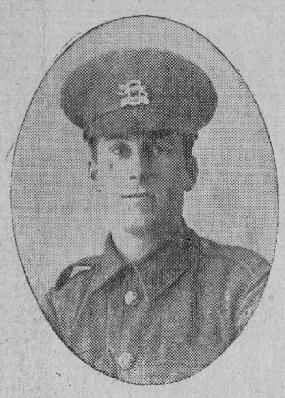
|
Edward Sidney Herbert Haigh was born in Worsborough near Barnsley, Yorkshire, in 1887, the son of Walter Haigh and his wife Sarah Ann (née Wiggins). He was known to his family and friends as 'Ted' and always spelled his second forename as 'Sidney' even though his birth was registered as 'Edward Sydney H. Haigh'. His parents were married on 12th May 1883 at St. George's Church, Barnsley. Both Ted's parents were schoolteachers and his father was headmaster at Worsborough Common School. The Haigh family lived in the School House at 35 Highstone Road, Worsborough Common. Ted had two brothers Joseph and Walter Bertram and a sister Ida.
After Ted's mother died in 1904 all the family except Joseph stayed on for a while at Worsborough - in 1911 both Walter Bertram and Ted were assistant teachers at their father's school while Joseph was working as an elementary school teacher in Hitchin, Hertfordshire. Sometime between 1911 and 1914, however, Ted secured a teaching position at Church Gate Boys' School in Loughborough and he, his brother Walter Bertram and their father relocated to 131 Derby Road, Loughborough. Ida, meanwhile, moved to 209 Park Road, Barnsley.
Ted enlisted in Loughborough on 1st September 1914 and on enlistment declared that he had previously served with the York Dragoons (a Yeomanry regiment). He joined the 8th (Service) Battalion of the Leicestershire Regiment as Private 12649 and was sent to Aldershot. On 1st February1915 he was promoted to Lance Corporal (paid). He moved to Shorncliffe Camp near Cheriton in Kent at the end of February 1915. On 30th April Ted was sent to hospital in Deal for a month suffering from an inguinal hernia. On 17th May 1915 Ted requested to return to the rank of Private. His battalion had now become part of the newly established 37th Division of Kitchener's 2nd New Army and the Division began to concentrate on Salisbury Plain. On 25th June the units were inspected by King George V at Sidbury Hill. On 22nd July the Division began to cross the English Channel and Ted travelled to France on 29th July 1915. Initially the 37th Division concentrated near Tilques.
The 8th Battalion then moved via Watten, Houlie, St. Omer, Eecke and Dranoutre to Wulverghem and Berles-au-Bois, a short distance from the front line. In the months that followed the 8th Battalion did tours in the trenches, alternating with the 6th Leicesters who relieved them. They were Involved in operations in Bailleul, Le Bizet, Armentières, Mondicourt, Beauval and Berles-au-Bois. In April 1916 the battalion moved to the Doullens area for six weeks for cleaning up, resting and training. In mid-May they returned once more to the trenches in the Bienvillers-Bailleulmont sector, but nearer Gommecourt. In June there was a series of nightly excursions into No-Man's Land with patrols attempting to gather information on the enemy's dispositions. On other occasions there were working parties out repairing the British barbed wire entanglements. The situation became increasingly hazardous as the month wore on when the Germans began to use a new and more accurate type of trench mortar.
The 8th Battalion did not participate in the first days of the Somme Offensive but was held in reserve. On 6th July they left billets at Humbercamps and marched to Talmas, continuing on the following day to billets in Soues. On 10th July the battalion marched to Ailly-sur-Somme, entrained for Méricourt and travelled from there by lorry to bivouacs in Méaulte. Between 10th and 13th July the battalion was in the trenches near Fricourt and subjected to fairly continuous enemy fire. On 14th and 15th July the battalion advanced on Bazentin Le Petit Wood. During this operation Ted, aged 29, was killed in action on 15th July 1916. Ted is buried at Flatiron Copse Cemetery, Mametz, Grave IV.C.10. He is commemorated on the memorial at the former St. Peter's Church, Loughborough, as well as on the Carillon. He was mourned by his family and his fiancé Clara Edith Butler of 301 Humberstone Road, Leicester, whose family lived in Loughborough.
Ted's brother Walter Bertram was killed in action in September 1916 and his brother Joseph died of wounds in 1918. Their father died in 1917 in Loughborough.
|
|
|
|
Private 23696 Joseph Reginald Haigh
|
|
7th Bn, Leicestershire Regiment.
Died of Wounds 29th March 1918, Aged 32.
Buried St Sever Cemetery, Rouen, P. VII. L. 11A.
(2 brothers also fell Edward & Walter Haigh see above & below)
|
Joseph Reginald Haigh was born in Worsborough near Barnsley, Yorkshire, in January 1886 and baptised at Worsbrough on 4th February 1886. He was the son of Walter Haigh and his wife Sarah Ann (née Wiggins). His parents were married on 12th May 1883 at St. George's Church, Barnsley. Both Joseph's 's parents were schoolteachers and his father was headmaster at Worsborough Common School. The Haigh family lived in the School House at 35 Highstone Road, Worsborough Common. Joseph had two brothers Edward (known as 'Ted') and Walter Bertram and a sister Ida.
After his mother died in 1904 Joseph took a position as an elementary school teacher in Hitchin, Hertfordshire and in 1911 he was lodging with the Tuck family at Lakenham, Lancaster Road, Hitchin. The rest of the Haigh family stayed on for a while in Worsbrough, Joseph's brothers being assistant teachers in their father's school. Sometime between 1911 and 1914, however, Joseph's brother Ted secured a teaching position at Church Gate Boys' School in Loughborough and he, his brother Walter Bertram and their father relocated to 131 Derby Road, Loughborough. Ida, meanwhile, moved to 209 Park Road, Barnsley. At some point between 1911 and 1915 Joseph returned to Loughborough and was employed as a clerk.
Joseph, who had previously served with the City of London Royal Garrison Artillery (a territorial force) enlisted in Loughborough on 9th December 1915. He joined the 2nd (Reserve) Battalion of the Leicestershire Regiment as Private 23696 and on 8th January 1916 was sent to Rugeley Camp in Staffordshire. He remained there until 14th July 1916 when he was sent to France. After arriving in Etaples he was posted to the 7th Battalion of the Leicesters, joining the battalion in the field on 2nd August 1916.
By August 1916 the 7th Battalion had suffered 553 casualties on the Somme and was being rapidly reinforced. When Joseph joined the battalion it was in training at Agnez-lès-Duisans, near Arras and on 6th August 1916 took over a nearby section of battered trenches. Further training ensued at Denier and on 11th September, while the battalion was at Denier, Joseph was admitted to No. 64 Field Ambulance suffering from syphilis. He was transferred to No. 105 Field Ambulance, sent to a Casualty Clearing Station and transferred to No. 6 General Hospital in Rouen. He was discharged from hospital on 4th October 1916 to a depot in Rouen before being transferred to No. 12 Infantry Base Depot at Calais on 9th November. He rejoined the 7th Battalion, which was now in the more northern Hohenzollern sector, on 16th November. From the front line trenches there on 29th November Joseph was admitted to No. 65 Field Ambulance suffering from debility. He returned to duty on 12th December. After one more trench tour and three days rest at Philosophe the battalion moved to Cauchy-à-la-Tour and then Houtkerque for training until 12th February 1917.
On 13th February the battalion entrained at Proven for Fouquerieul and marched to billets in the tobacco factory in Béthune. Moving on to Labourse they were back in the trenches in the Hohenzollern sector on 15th February, moving up to the front line on 21st February. Breaks from the trenches were taken in Noyelles. In March 1917 the battalion experienced what one soldier called 'the bombardment of our lives'.
On 29th March the battalion entrained at Noyelles for Saulty-l'Arbret and marched to La Cauchie and on to Moyenville. On 4th April the battalion went into the front line at St. Leger Croisilles, with breaks at Moyenville. From 15th to 23rd April the battalion was in training at Bailleulval before returning to the trenches at St. Leger Croisilles. On 28th April the battalion was in action at the Battle of Arleux and on 3rd May in reserve for the 2nd Battle of Bullecourt, moving into the front line on 4th May. From 4th -11th May the battalion suffered from very heavy enemy shelling. From 12th-31st May the battalion was withdrawn for training at Bienvillers. Further training and trench tours followed in the Moyenville area in June, July and August, followed by a break in Hamelincourt.
On 25th and 26th August the battalion marched to Gouy-en-Artois and then Beaufort for training. After a further move to Hauteville for more training and a football tournament and boxing competition, both of which the 7th Leicesters won, on 16th September the battalion entrained at Savy station for Caestre.
On 23rd September the battalion marched to Berthen. On 26th September they moved by bus to Scottish Wood and then to Bedford House as reserve in the forward area. After two days rest at Micmac Camp the battalion was back in the forward area on 29th. The 3rd Battle of Ypres had been raging for two months and the ground was full of water-logged shell holes, which had to be negotiated over duckboards. The 7th Leicesters joined the battle on the night of the 30th September, marching up to Polygon Wood, which had been captured by the Australians. The 9th Leicesters took over positions in the right half of the Polygon sector just outside the wood with the 7th Battalion behind them in support and the 6th Leicesters in reserve.
On 1st October the enemy began a heavy barrage. The Leicesters nevertheless pushed forward. An intense artillery duel followed on 2nd October before the battalion was relieved and marched south-east of Zillebeke Lake to Wiltshire Farm. On 4th October the battalion moved up again to south of Zillebeke Lake, bivouacking there. On the following day they were back in the support line west of Polygon Wood. On 6th October two companies moved up to the front line at Reutel, with the other two companies in support. On 10th October, amid a hostile barrage, the battalion was relieved and moved to Anzac Camp. On the 11th October they entrained at Ouderdom station for Ebblinghem and marched to billets in La Carnois. After four days rest they marched to Les Ciseaux and were taken by bus to dugouts in the railway embankments at Shrapnel Corner. After remaining here until 24th October they moved to B Camp at Chateau Segard for reorganisation and training.
After three days cable laying at Clapham Junction at the beginning of November the battalion returned to B Camp before moving to dugouts on the Zillebeke Bund on 7th November and to the front line on the following day. After returning to A Camp at Chateau Segard on 13th November the battalion moved on to Devonshire Camp in the Reninghelst area and on 17th began a five day transfer by march to Coupigny. On 25th November they moved again to Frevillers for training. On 30th November the battalion received urgent orders to entrain at Savy for Tincourt.
On 1st December 1917 the battalion went into the front and support lines near Tincourt, moving into the support trenches at Epehy on 4th. Back in the front line from the 8th-11th December the battalion installed wiring, improved trenches and dug a new front line. After a break at Villers Faucon they returned to the front line from 16th-20th. On Christmas Eve the battalion returned to the trenches for four days, but were given their Christmas dinner at Saulcourt on 29th December.
The new year of 1918 began with a four day trench tour, followed by training at Lieramont and Haut Allaines until 19th January. On the 20th the battalion moved to Epehy by light railway and began another trench tour before moving into Brigade Reserve at Saulcourt on 28th. On 4th February the battalion moved into support at Epehy. Relieved on 7th February the battalion moved by light railway to Moislains, where training took place until 18th February. The battalion then moved to B Camp, Templeux-la-Fosse, and worked on the trenches and railway at Flamincourt. From 24th -28th February the battalion was based at Adrian Camp, Villers Faucon, for wiring work and trench digging.
In March it became clear that the Germans were planning a Spring Offensive. On the morning of the enemy assault, 21st March 1918, the 7th Battalion was holding the left hand portion of the front between Pezières and Epehy village when it was attacked by German stormtroopers. The battle for Epehy raged all day. On 22nd March the battalion was ordered to retreat towards the old Somme battlefield of 1916, crossing the Péronne Canal to Aizecourt-le-Bas and Feuillaucourt and taking up position on a ridge to the north of Hem. During the retreat the battalion was severely bombarded and at some point Joseph was wounded. He was transferred to hospital in Rouen and died of his wounds, aged 32, on 29th March 1918.
Joseph was buried in the St. Sever Cemetery Extension, Rouen, Grave P. VII. L. 11A. He is remembered on the memorial in All Saints Church, Loughborough, on the memorial in the former St. Peter's Church building, Loughborough, and on the Carillon.
|
|
|
|
Lance Corporal 16059 Walter Bertram Haigh
|
|
9th Bn, Leicestershire Regiment.
Killed in Action 25th September 1916, Aged 31.
Commemorated Thiepval Memorial, pier & face 2c 3a.
(2 brothers also fell Edward & Joseph see above)
|
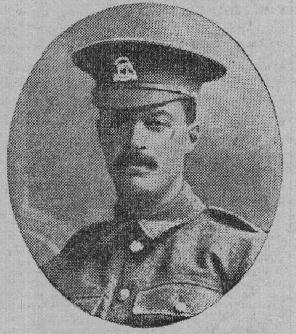
|
Walter Bertram Haigh was born in Worsborough near Barnsley, Yorkshire, in 1884, the son of Walter Haigh and his wife Sarah Ann (née Wiggins). He was baptised on 25th January 1885 at Worsbrough. He was known to his family and friends as 'Bert'. His parents were married on 12th May 1883 at St. George's Church, Barnsley. Both Bert's parents were schoolteachers and his father was headmaster at Worsborough Common School. The Haigh family lived in the School House at 35 Highstone Road, Worsborough Common. Bert had two brothers Joseph and Edward ('Ted') and a sister Ida.
After Bert's mother died in 1904 all the family except Joseph stayed on for a while at Worsborough - in 1911 both Bert and Ted were assistant teachers at their father's school while Joseph was working as an elementary school teacher in Hitchin, Hertfordshire. Sometime between 1911 and 1914, however, Ted secured a teaching position at Church Gate Boys' School in Loughborough and Bert relocated with his brother and their father to 131 Derby Road, Loughborough. Ida, meanwhile, moved to 209 Park Road, Barnsley.
Bert enlisted on 17th November 1914 at Loughborough, giving his occupation as 'musician'. He joined the 9th Battalion of the Leicestershire Regiment as Private 16059. The 9th (Service) Battalion was raised at Leicester in September 1914 as part of Kitchener's Third New Army and joined 23rd Division as Divisional Troops. The units of the Division began to assemble at Bullswater and Frensham in Hampshire from September 1914 and the King, Queen and Princess Mary visited the fledgling Division on 29 September. In early December, as the weather worsened, the Division moved into Aldershot and then, at the end of February 1915, to Shorncliffe in Kent. In April 1915 Bert's battalion became part of the newly established 37th Division of Kitchener's 2nd New Army and the Division began to concentrate on Salisbury Plain. Bert was encamped on Perham Down.
On 29th July 1915, Bert was sent to France, travelling from Folkestone to Boulogne on the SS St. Seiriol. Initially the 37th Division concentrated near Tilques. The 9th Battalion then moved via Watten, Houlie, St. Omer, Eecke and Dranoutre to Wulverghem and Bienvillers-au-Bois, a short distance from the front line. On 26th September 1915 Bert was appointed to the rank of Lance Corporal (unpaid).
In the months that followed the 9th Battalion did tours in the trenches, alternating with the 7th Leicesters who relieved them. They were Involved in operations in Bailleul, Le Bizet, Armentières, Mondicourt, Beauval and Berles-au-Bois. In April 1916 the 9th Leicesters moved to the Doullens area for six weeks for cleaning up, resting and training. In mid-May they returned once more to the trenches in the Bienvillers-Bailleulmont sector. In June there was a series of nightly excursions into No-Man's Land with patrols attempting to gather information on the enemy's dispositions. On other occasions there were working parties out repairing the British barbed wire entanglements. The situation became increasingly hazardous as the month wore on when the Germans began to use a new and more accurate type of trench mortar.
On 1st July 1916 the 9th Leicesters moved into position at Souastre in readiness to reinforce the troops attacking at Gommecourt. No orders came, however, and the men marched back to Humbercamps. Training continued on the 4th and 5th July. On 6th and 7th July they marched via Talmas to Crouy and on 8th and 9th July they rested and were addressed by the Divisional Commander on the forthcoming battle. On 10th July they moved to Ailly-sur-Somme and then entrained for Méricourt before going by bus to bivouacs in Méaulte north-east of Amiens. They then took over as Quadrangle Trench and Quadrangle support. On 11th there was heavy shelling but no infantry attack. On 12th July the 9th battalion was relieved and moved back to Fricourt.
On 14th July the battalion moved up to the south edge of Mametz Wood just as an intense bombardment of the German positions began, and on to Bazentin-Le-Petit Wood. Finally relieved on 16th July the battalion, which had suffered heavy casualties, marched to Fricourt and on to Ribemont on the following day. On 18th July they entrained at Méricourt for Saleux. After nine days of marching and some motor lorry transit the battalion arrived at Arras on 27th July, where for all of August the battalion was in the trenches or resting in billets at Arras. After some days training and resting at the beginning of September the battalion marched to Frevent and entrained for 'Edgehill' station near Dernancourt. On 16th September the battalion moved to bivouac near Fricourt and after two days moved again to bivouac in front of Bernafay Wood.
On 24th September the battalion moved up to the assembly trenches in front of Gueudecourt in preparation for an attack on the following day. Bert was killed in action on 25th September 1916, aged 31. He is remembered on the Thiepval Memorial Pier and Face 2C and 3A, and on the memorial in the former St. Peter's Church building in Loughborough as well as on the Carillon.
Bert's brother Ted was killed in action in July 1916 and his brother Joseph died of wounds in 1918. Their father died in 1917 in Loughborough.
|
|
|
|
Private 21735 Frederick Hall
|
|
2nd Bn, Leicestershire Regiment.
Died of Wounds 29th May 1918, Aged 30.
Buried Ramleh War Cemetery, Israel K. 46.
|
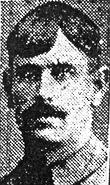
|
|
Frederick Hall was born in Loughborough in late 1888. He was one of fourteen children born to John Hall (known as 'Jack') and his wife Mary Ann (née Bowley) who were married in Loughborough in 1874. Only nine of the Hall children survived infancy; Frederick's brothers were Charles, Edwin, George and Arthur, and his sisters were Sarah, Ellen, Gertrude and Edith. Their father Jack Hall was a coal cart labourer who subsequently became a labourer in night soil for Loughborough Council. In 1891 the family lived at 8 Steeple Row, Loughborough. By 1901 they had moved to 6 Court C, Bridge Street. In1908 they lived in Moor Lane and by 1911 had moved again to 27 Moira Street.
From his teenage years onwards Frederick, who became a labourer, was often in trouble. Between 1900 and 1913 he appeared in court nine times for offences including assault, stealing, gaming in Packe Street on a Sunday, and poaching. In his earlier court appearances he was fined various amounts but as he grew older the sentences included fourteen days hard labour and three weeks in prison.
On 5th June 1911 Frederick married Daisy Yeomans at Emmanuel Church, Loughborough, and their only son Frederick was born on 20th November that same year. Frederick, Daisy and baby Frederick went to live at 78 Wellington Street, Loughborough.
Frederick enlisted at Loughborough on 22nd June 1915 and joined the Leicestershire Regiment as Private 21735. On 24th July 1915 he was posted to the 6th (Service) Battalion. After some initial training he was re-posted on 24th December 1915 to the 10th (Reserve) Battalion of the Leicestershire Regiment at Rugeley Camp, Cannock Chase, Staffordshire. In early 1916 he was disciplined twice for being absent without leave and shortly after the second occasion, he was posted to the Mediterranean Expeditionary Force.
Frederick embarked on H.T. Persic at Devonport on 17th February 1916 and arrived at Basra in the Persian Gulf on 21st March. He then travelled up the Tigris to join the 2nd Battalion of the Leicestershire Regiment, reaching them on 3rd April.
The 2nd Battalion was in the area of Hanna and the Dujaila Redoubt and still making attempts to relieve the Siege of Kut. On 5th April, there was a heavy bombardment on the enemy's position on both banks of the Tigris and the enemy retired to Fallahiya and then Sannaiyat. Frederick, who had been with the 2nd Leicesters for only two days, was part of a night march in massed formation on the enemy's new position. As dawn broke on 6th April the troops came under withering fire from the enemy. This continued throughout the whole day and Frederick was wounded in action.
Frederick was transported back to Basra and on 10th April put on board the H. T. Elephanta to be taken to hospital in or near Bombay. He recovered but did not immediately return to Mesopotamia. On 4th June 1916 he was sent to Belgaum, where at the time there was an internment camp housing Ottoman prisoners of war as well as well as German and Austrian internees, and Frederick was probably employed there.
Frederick eventually left Belgaum, sailing from Bombay on 20th January 1917, reaching Basra on 28th January, and travelling up the Tigris again to join the 2nd Leicesters.
In December 1916 the Tigris Corps had begun a long offensive operation with the purpose of dislodging the enemy from the right bank of the Tigris and severing the enemy's communication channels. By 18th December the Tigris Corps had extended their grip on the Turkish defences and had cut in opposite Kut between the outer Turkish defences and the west of the Hai, while simultaneously bombarding Sannaiyat. Frederick rejoined the 2nd Leicesters in early February 1917, just in time to take part in the capture of Sannaiyat, south of Kut, on 17th February. By the end of February 1917 Kut was reoccupied by the Tigris Corps and the final push towards Baghdad began.
On 4th March Frederick's battalion marched to Shargy and on the following day to Azizieh. Bawi was reached on the morning of the 8th March and the battalion was ordered to proceed towards Baghdad on the night of the 8th March. A halt was made at 6.00am on 9th at the Shawa ruins and one hour later the enemy began to shell the advancing troops.
Baghdad was entered on 11th March. On 8th April Balad Station was successfully taken, thus securing the line from Balad to Sidigharib. After Harba was taken on 9th April the Turks fell back to Istabulat. On 21st April the Tigris Corps was ordered to attack Istabulat. General Maude wrote in his despatch of 15th October 1917 'The assault was delivered in dashing style by the Leicesters supported by the 51st Sikhs and the 56th Rifles' and the Ottomans withdrew on 22nd, being forced also to surrender the Summarrah rail yard the following day.
On 30th April 1917 Frederick was admitted to the British Base hospital in Basra, suffering from nausea, vomiting and diarrhoea. On 8th May he was discharged to No. 1 Base Depot, Magil. He rejoined the 2nd Leicesters in the field on 30th May.
There were now five months of hot weather during which active campaigning was impractical and the battalion spent the greater part of the summer camping in and around Samarah by the Tigris. Here there was a liberal supply of water for drinking, bathing and washing and training and sports were organised during the cooler parts of the day.
In the early morning of November 1st the Leicesters were back in action driving the Turkish force out of Daur. On 5th November Tekrit was captured and the Ottoman forces went into further retreat.
After this the battalion was withdrawn to Samarah, remaining here for the rest of its time in Mesopotamia. The British Government now decided to send the battalion to Egypt.
On 8th December the battalion marched via Istabulat, Balad, Sumaikcha, Kermeah, Husaiwa and Baghdad to Hinaidi, where they remained until 18th December. They then embarked on river steamers and sailed for Magil where they remained until New Year's Day 1918. From Magil they embarked on the hired transport ships Bandra, Rossetti and Hyperia and set sail. On 3rd January, however, the three ships came to anchor somewhere off the mouth of the Tigris and the men were transferred to the Minnetonka and the Mutlah and on 8th January the voyage was resumed.
The ships reached Suez on 22nd January and the battalion travelled by train to a camp at Ismailia on the Suez Canal. The 2nd Leicesters remained at Ismailia until nearly the end of March engaged in training of all kinds. They left Ismailia on 28th March and reached Kantara a day later and then entrained for Ludd. On April 2nd they moved forward to a coastal sector of the line from near Tel-el-Mukhmar to Arsuf. On 16th April they moved to the front line and came in contact with the enemy.
During the ten days or more the battalion was in the front line the Turks were unusually aggressive. Following a period in Brigade reserve the battalion went into the attack on 29th May.
The precise point at which Frederick was wounded is not recorded on his service papers but he died of his wounds, aged 30, in Jaffa on 29th May 1918. He was buried in Ramleh War Cemetery, Israel, Grave K. 46.
Frederick's wife was remarried to William Burns at the end of 1918. Her 'Separation allowance' while her first husband Frederick was serving in the Army had been stopped on 8th January 1918 'on account of her infidelity to her husband'. An allowance for Frederick and Daisy's son continued to be paid, but to Daisy's mother, Mrs. Yeomans, of 17 Cross Street, Loughborough.
|
|
|
|
Private 203349 Percy Hall
|
|
1st Bn, Leicestershire Regiment.
Death presumed on 22nd March 1918, Aged 21.
Commemorated Arras Memorial, bay 5.
|
Percy Hall was born in Loughborough in 1896. He was the son of William Hall, a framework knitter, and his wife Clara (née Kidger), a hosiery mender, who were married at All Saints Church, Loughborough, on 30th March 1891. The Hall family lived at 24 Shakespeare Street, Loughborough, and Percy had one sister Nellie and two brothers Ernest and Harry. In 1911 Percy, aged 15, was employed as an errand boy in a hosiery warehouse.
Percy joined the 1st Battalion of the Leicestershire Regiment as Private 203349. Although his service record has not survived and the dates of his enlistment and when he was sent to France are unknown it is likely that he was sent to France sometime during.1916
Between January and July 1916 the 1st Leicesters were on the Ypres Salient. On 1st August 1916 the battalion left the trenches at Potizje on the Ypres Salient and entrained at Proven for France. They reached billets at Léalvillers, Somme, on 4th August and on the following day marched to camp in Mailly-Maillet Wood. A period of training and working parties followed. On 14th August they went into the trenches opposite Beaumont-Hamel, where they remained until 19th when they returned to the Mailly Wood camp. On 27th August they left for Flesselles. Here additional training took place. On 8th September they occupied former German trenches in the area of Trônes Wood on the northern slope of the Montaubon Ridge while in the following days the build-up for a series of major battles took place.
The battalion took part in the Battle of Flers-Courcelette (15th- 22nd September) incurring grievous losses and were also in action in the Battle of Morval (25th-28th September). During part of the Battle of Le Transloy (1st October-5th November 1916) the 1st Leicesters were employed carrying up stores and providing stretcher and other parties for the front line troops.
By 21st October the battalion was back in billets at Corbie where it entrained three days later for Sorel before moving over several days to Fouquières-les-Béthune in the La Bassée sector.
Most of November was spent in training with one brief trench tour and December in the trenches at Cuinchy, with breaks at Beuvry and Christmas Day at Noeux-les-Mines.
January 1917 was spent in turns in the trenches and at rest in Mazingarbe. From 1st to 21st February many raids on the enemy were carried out after which the battalion marched via Sailly Labourse to the Montmorency Barracks at Béthune. In March and April the battalion did trench tours on the front line north of the Double Crassier, Loos, before being withdrawn to billets at Maroc on 22nd April. May brought more trench tours in the front line at Loos, with breaks in billets at Les Brebis or Philosophe.
In June the battalion was instructed, while in training at Verquin, to mount a series of small operation to give the enemy the impression that an attack was about to take place. In July Canadian forces took over in the area to attack Hill 70 and the battalion was withdrawn to the area of Monchy-Breton, proceeding by lorries to Magnicourt-en-Compte. After being briefly ordered to assist at the time of the gas shelling of Armentières, a brief period at Fleubaix, and time in the reserve line at La Boutillerie the battalion returned to Magnicourt on August 5th. At the end of August the Division returned to the Hill 70 front and went into reserve at a camp in Houchin.
In September there were front and support line trench tours at Hill 70, Les Brebis and Cité St. Pierre. At the end of September the battalion was in south Maroc and early in October at Noeux les Mines before going into the trenches in the St. Emile sector. From Mazingarbe on 21st October the battalion moved to Ligny-lez-Aire and then to Manin for training until 14th November. On 15th November the battalion entrained at Frevent for Peronne and marched to Moislains. After a couple of days under canvas at Dessart Wood the battalion moved forward to the front line at Beaucamp and on 20th November, the first day of the Battle of Cambrai, successfully attacked part of the Hindenburg Line. The battalion was relieved on 26th November and moved to another section of the front line near Noyelles where they suffered heavy enemy bombardment and shelling but nevertheless helped to achieve an advance to Gouzeaucourt.
On 1st December the battalion was at Nine Wood and was heavily shelled before being relieved and moving to new positions on the Premy-Flesquières Ridge. On 5th December the battalion moved again to positions in the front line on the Hindenburg support system where they remained until 13th December. From 14th December until the end of the year the battalion was at Bellacourt undergoing training.
In the early part of January 1918 the battalion was at Courcelles but on 18th went into the trenches on the Moeuvres front. Rest periods were taken at Luck and Lindop Camps near Fremicourt. On February 19th and 20th the battalion moved to the Lagnicourt area, where, when out of the line, they provided large working parties for work on the defences.
There were now strong rumours that the enemy was preparing a large offensive and great efforts were made to obtain information through patrols and raids. On 15th March the front line company of the battalion managed to capture a propaganda balloon laden with ten copies of the Gazette des Ardennes, a paper published in French by the Germans for distribution among the inhabitants of occupied territory.
On 21st March 1918 the enemy launched their Spring Offensive. Percy, aged 21, was presumed to have been killed in action on 22nd March. He is commemorated on the Arras Memorial Bay 5.
|
|
|
|
Lance Corporal 16022 Wilfred Hall
|
|
9th Bn. South Staffordshire Regiment.
Killed in Action 5th July 1916, Aged 27.
Buried Bapaume Post Military Cemetery, I. C. II.
|
Wilfred Hall was born in Horncastle, Lincolnshire, in 1889, the son of Charles Hall and Mary Ann Hall (née Hutchinson) who were married in Horncastle in 1880. Wilfred's father was a shoemaker and in 1891 the Hall family was living at 25 Stourton Place, Horncastle. By 1901 they had moved to 6 Moores Yard and in 1911 were at 83 East Street. In 1911 Wilfred was employed as a labourer in the boiler industry. Wilfred had at least four brothers James, Alfred, Bertie and Allan, and at least three sisters Catherine, Maud and Lilian.
By 1913 Wilfred had moved to Loughborough. He was a member of the Dyers' Union and was well-known at the hosiery dye works of Messrs. Lacey, Godkin & Edwards in Loughborough. He married Celia Linton in Loughborough at the end of 1913 and the couple set up home at 31 Wood Gate, Loughborough. Their first child, a son called Charles, was born in 1914.
Wilfred appears to have enlisted at Loughborough Drill Hall by December 1914 and was posted to the 9th (Service) Battalion (Pioneers) of the South Staffordshire Regiment at Talavera Barracks, Aldershot. Between March and May the Pioneers were employed on the defences of London and working on trenches between Westerham and Knockholt. In addition there was hard training with inspections. On May 24th 1915 the battalion moved to Bordon, Hampshire, where the Pioneers went into camp at Oxney Farm. At the end of July all ranks were given seven days leave. On August 16th the 23rd Division of the Army, of which the Pioneers were part, formed up at Hankley Common to be inspected by the King and the following day orders were received to proceed to France. Wilfred sailed from Southampton to Le Havre on 24th August 1915.
From Le Havre the Division went by train via St. Omer to Tilques. The Division then moved to the Armentières area until April 1916 with the Pioneers occupying billets at Fort Rompu, Erquinghem-Lys. They were fully occupied building shelters, communication trenches and dug-outs and making hurdles. As winter approached the men's health began to suffer, with a number of cases of scabies reported. Between 26th January and 8th February 1916 the battalion was relieved after a lengthy five month spell in the front line. The battalion next served on the Souchez Front until June 1916 when it moved from Bouvigny to Ailly-sur-Somme, five miles west of Amiens in the Somme Department of Picardy. At some point Wilfred, who on enlistment was known as Private 16022, was promoted to Lance Corporal.
On 5th July 1916 Wilfred's battalion spent the whole day in the area of Becourt Wood, just behind the front line south-west of La Boiselle where they had been ordered to convey stores. At 5.00pm an enemy shell dropped on the transport lines killing Wilfred, six horses and four mules, and injuring a number of men.
Wilfred, who was aged 27 when he died, was buried in Bapaume Post Military Cemetery, Albert, Grave I.C.II. He is commemorated on the Memorial at Emmanuel Church, Loughborough, as well as on the Carillon.
|
|
|
|
Lance Corporal 11355 Henry Hallam
|
|
2nd Bn, Royal Scots (Lothian Regiment)
Died at Home in late 1921, Aged 26.
|
Henry Hallam, known to his family and friends as 'Harry', was born in Loughborough in late 1894 or early 1895. He was the son of Henry Hallam, a fishmonger, and his wife Emma (née Martin) who were married on the 21st August 1886 at Emmanuel Church, Loughborough). Harry had two sisters Lily and Alice. Another sibling, also called Henry or Harry, had died, aged three, in 1893. In 1901 Harry and his sisters, together with their father, were living with Harry's maternal aunt Lizzie Martin at 37 Granville Street, Loughborough. In 1911 the family group was still at the same address and Harry, aged 16, was a belt eyeletter in an elastic web factory. What became of Harry's mother after 1898 is unknown. Her last appearance is in a report of a court case in February 1898 in which she was fined 10 shillings for being drunk and disorderly.
Harry enlisted in the Army in January 1913 under the name 'Harry Henry Hallam' and joined the 2nd Battalion of the Royal Scots (Lothian Regiment) as Private 11355. He underwent training at Glencorse Barracks, Edinburgh, and by August 1914 he had been promoted to Lance Corporal.
When war broke out the battalion was stationed at Crownhill Barracks, Plymouth. After mobilisation the battalion left Friary Station, Plymouth on 13th August and travelled by train to Southampton Docks where they embarked on the SS Mombassa. The battalion disembarked at Boulogne in the early afternoon of 14th August and marched three miles to a rest camp at St. Martins.
On 15th August the battalion was inspected by a French General and then entrained at Boulogne for an unknown destination. On 16th August they detrained at Landrecies and marched to Taisnières where they were accommodated in billets. Here the 8th Brigade of the Army's 3rd Division in the British Expeditionary Force was concentrated and training was carried out daily.
Four days later the battalion marched to fresh billets at Dourlers. On 21st August they marched to Goguies via Maubeuge. On 22nd they marched to Spiennes in Belgium.
On 23rd August when the Battle of Mons began the battalion was ordered to hold the position along the Maubeuge-Mons road. Here the enemy attacked in force, especially in front of A Coy and the battalion was retired to Nouvelles where they bivouacked in a field. On 24th August the battalion moved forward to complete trenches begun by the Royal Engineers but just after they reached the trenches they were ordered to retire to a gully and subsequently to Bavay. On 25th August the battalion completed a long march via Solesmes to Audencourt. Here, on 26th August they took up a position in front of the village and began to dig trenches. The enemy, however, advanced in force and the battalion came under heavy enemy artillery fire in the Battle of Le Cateau. The battalion was again ordered to retire and gathered at Elincourt.
Harry was reported missing on 26th August. It was later established that he had been wounded in the leg and taken prisoner by the Germans. He was eventually taken to Doeberitz POW Camp at Brandenburg near Berlin where he remained until after the end of the war.
When Harry returned to Loughborough he secured employment as an iron moulder. On 6th March 1920, under the name 'Harry Henry Hallam' he married Eva Thirlwall at Emmanuel Church, Loughborough. Harry survived the war but only for a short while. He died between October and December 1921 in Loughborough, aged 26, his death being registered under the name 'Henry H. Hallam'. He may have died from the after-effects of his lengthy imprisonment (1914-1919) in Doeberitz POW Camp which would explain why he is commemorated on the Carillon.
|
|
Private 281123 James Hamilton
|
|
Queen' Own Oxfordshire Hussars.
Previously served as Trooper 2347 South Notts Hussars.
Died of Wounds 6th July 1917, Aged 20.
Buried Tincourt New British Cemetery Somme, I. A. 11.
|
|
James Hamilton was born in Nuneaton in 1897, the son of Peter Hamilton, a domestic groom and his wife Mary (née Lawson). James' father came from Glasgow and his mother from Ayrshire. James had one brother Andrew. The Hamilton family are slightly elusive, only appearing on one census record, that of 1901. In 1901 they were living at 3 Pool Bank Street, Nuneaton, Warwickshire, but it is known that they moved to 56 Derby Road, Loughborough, at some point between 1901 and 1914. Prior to enlisting James worked for Eastman's in Swann Street, Loughborough.
James enlisted in November 1915 at Nottingham and joined the South Notts Hussars (Nottinghamshire Yeomanry) as Trooper 2347. His service record has unfortunately not survived and there is some confusion in official records regarding his regiment and battalion. What seems to have happened, however, is that sometime after January/February 1917 James was transferred by the 2nd Reserve Regiment of Cavalry from the South Notts Hussars to the Queen's Own Oxfordshire Hussars (QOOH) and renumbered as Private 281123. (The 2nd Reserve Regiment of Cavalry trained both the South Notts Hussars and QOOH.)
The Queen's Own Oxfordshire Hussars, in the 2nd Cavalry Division, had once been derided by the regulars as the 'agricultural cavalry' and its QOOH title used to create the nickname 'Queer Objects on Horseback'. By 1917, however, QOOH had been hardened by three years of gruelling active service and had been raised to a degree of military efficiency previously unheard of in a yeomanry regiment.
From 1st March to 7th April 1917 QOOH, part of the 4th Cavalry Brigade, was training at Vron (Somme), Picardy. On 7th April QOOH moved to Berlcourt and on 8th to Pas. On 9th April they were ordered to move south-east of Arras in readiness and between then and 11th April received several similar orders. On 11th April they relieved the 5th Cavalry Brigade before being told to move to Wailly and then Pas on 13th. At Pas and at Warlincourt from 20th April until 12th May the horses were rested. Between 12th and 16th May the Brigade moved to the new area of Hamelet. C Squadron went into trench support and QOOH relieved the infantry in the front line at Gillemont Farm. The farm was heavily shelled by the enemy on 19th May and attacked by the enemy on 20th, causing some casualties. The Regiment was relieved from Gillemont Farm on 31st May.
For the whole of June the Regiment was based at Brusle and provided working parties for the improvement of the line at Guillemont Farm despite continued enemy bombardment and attack. Raiding parties on the enemy were carried out at the beginning of July from Guillemont Farm.
On 5th July 1917 James was with C Squadron holding an advanced post, when the enemy started a heavy bombardment of trench mortars prior to an attack. It was during this that he was wounded. He was taken to the Regimental dressing station and afterwards to the casualty clearing station, where he died the next day on 6th July, aged 20.
An officer wrote to James' parents as follows: 'James was buried in the hospital cemetery [Tincourt New British Cemetery, Somme, Grave I.A.11] and the regimental carpenter fashioned the cross, which was painted and suitably inscribed. Allow me to offer you my deepest sympathy in your great loss. You know that he died nobly for his country and this may be some consolation in your grief'.
James is remembered on the memorial in the former St. Peter's Church building, Loughborough, and on the Carillon.
James' brother Andrew, a jockey, served in the 3rd Reserve Cavalry during the war but was discharged as unfit in 1918 after injuring his knee during drill.
|
|
|
|
Private 18312 Walter Hammond MM
|
|
7th Bn, Leicestershire Regiment.
Killed in Action 14th July 1916, Aged 25.
Commemorated Thiepval Memorial, pier & face 2c & 3a.
|
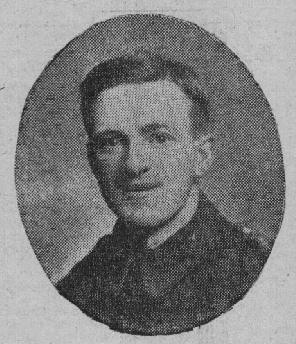
|
Walter Hammond was born in 1890 in Loughborough, the son of James Hammond, a bricklayer, and his wife Annie Maria (née Mills) who were married in Loughborough in 1881. Walter had five brothers Thomas, George, Archibald, Albert and William and four sisters Kate, Florence, Frances and Dorothy. Three other siblings died in infancy. In 1891 the family lived at 36 Moira Street, Loughborough, in 1901 at 5A Fennel Street, and in 1911 at 86 Howard Street. In 1911 Walter was a printer's apprentice at the Echo Works.
In the early summer of 1914 Walter married Ethel Lucy Sutton in Loughborough and the couple lived firstly at No. 34 then at No. 9 Shakespeare Street, Loughborough. In 1915 their first child, named Walter after his father, was born.
The exact date of Walter's enlistment is unknown but he joined the 7th (Service) Battalion of the Leicestershire Regiment as Private 18312. On enlistment he would have been sent to Aldershot, Hampshire, for training. In April 1915 the 7th Battalion became part of the 37th Division of the Army and concentrated at Cholderton on Salisbury Plain. On 25th June the 37th Division was inspected by King George V at Sidbury Hill.
Walter went to France on 25th August 1915 where his battalion gathered with the 37th Division at Tilques, near St. Omer. In September the 7th Battalion was sent to the area of Berles-au-Bois, south-west of Arras. The battalion remained in this area around Bienvillers and Bailleulmont until April 1916 and was engaged in localised operations seeking a tactical advantage. When not in the trenches being subjected to enemy shelling the 7th Leicesters received intensive training in bombing, Lewis gunnery, visual signalling and a host of other activities. In April 1916 they were moved to the Doullens area and formed working parties to cut down trees and prepare brushwood for the front line as well as preparing the support trenches in the area. In May they worked on building a new railway line between Le Bret and Bienvillers-au-Bois. Towards the end of May the battalion returned to the trenches in the Bienvillers-Bailleulmont area.
At the beginning of July the 7th Battalion moved on to the Somme. They were at Fricourt on 13th July and at Mametz Wood and in the attack on Bazentin-le-Petit on 14th July. On 14th July Walter was reported missing. The news of the award of the Military Medal to Walter was conveyed in a letter from the Captain of his company who wrote in reply to enquiries regarding Private Hammond's whereabouts. The Captain wrote: 'We supplied the information to the base that your husband was wounded and I am awfully sorry to hear that you have heard nothing of him. He was wounded when we got well forward, by a bullet in the shoulder, and was dressed and sent back. He had to pass through a fair amount of shellfire on his way back, and may have been hit again, but I can get no news of this. He did wonderfully well with his gun, and has been awarded the Military Medal. Only four men in the battalion gained this glorious distinction, and he was one of them. All the men join in the wish that we shall still hear safe news of him, and we all send our many congratulations on him gaining this distinction. He was a splendid fellow. When I hear any news I will at once let you know'.
Walter's body was never found. He was 25 when he was killed and is commemorated on the Thiepval Memorial, pier and face 2C and 3A. He is also remembered on his mother's gravestone in Loughborough Cemetery.
|
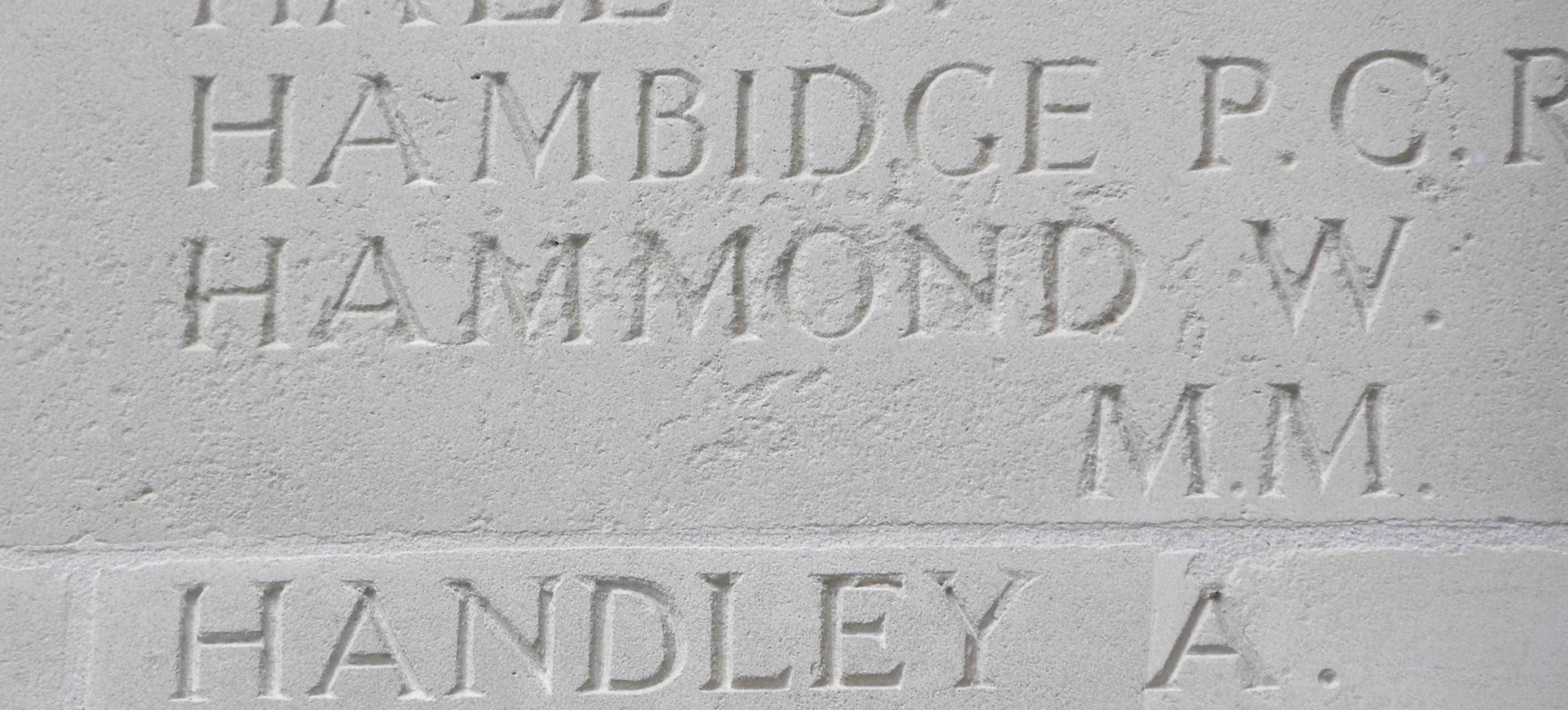
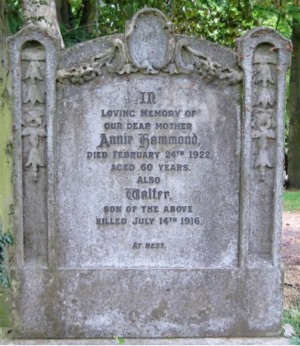 Gravestone of Walter's mother
Gravestone of Walter's mother
|
|
Private 44736 Albert Frederick Hancox
|
|
2nd Bn, Lincolnshire Regiment.
Formerly 37105 Leicestershire Regiment.
Died of Wounds 13th August 1918, Aged 19.
Buried Acheux British Cemetery, Somme, I. E. 32.
|
Albert Frederick Hancox was born in Stafford on 23rd December 1898 and baptised at St. Mary's Church, Stafford, on 24th January 1899. He was the son of Walter Hancox and his wife Annie (née Greaves) who were married on 11th April 1896 at the Church of St. John the Baptist, Keele, Staffordshire. Albert had one older brother Gordon.
Albert's father was a groom and coachman and the Hancox family lived in various locations over the years. In 1897 they were at 80 High Street, Wolstanton, in 1899 at 52 Eastgate Street, Stafford, in 1907 at 102 Dudley Road, Wolverhampton, in 1911 at School Lane, Quorn, and in 1915 at 15 Gordon Street, Loughborough. In 1907 Albert briefly attended Dudley Road Primary School in Wolverhampton before the family moved on elsewhere. By 1915 Albert's father was working as a market gardener for Mr. Chapman of Burton Street, Loughborough.
Albert's father enlisted on 8th November 1915 and initially joined the 10th (Service) Battalion of the Leicestershire Regiment. He was subsequently transferred to the 8th Battalion (Pioneers) of the Royal Sussex Regiment. Albert's brother Gordon also enlisted about the same time and joined the 1/5th Battalion of the Lincolnshire Regiment. Albert also enlisted but the precise date of his enlistment is unknown as his service papers have not survived. As he was eighteen years old in December 1916 it is possible that he joined up in early 1917.
Albert joined the Leicestershire Regiment as Private 37105 but was later transferred to the 2nd Battalion of the Lincolnshire Regiment as Private 44736. The dates when he was transferred and when he was sent abroad are unknown and the war diary of the 2nd Lincolnshires unfortunately does not usually record when reinforcements joined the battalion in the field.
If it is assumed that the earliest point at which Albert could have joined the 2nd Lincolnshires in the field was the early summer of 1917 he would have joined them at Strazeele where the battalion was training from 3rd-10th June. Training continued at Dominion Camp, south-east of Poperinghe, and at Steenvoorde until 28th June. From 29th June to 10th July the battalion was working for the Royal Engineers in the forward area. On 10th July they entrained at Reninghelst for Audricq and marched to Bonningues. Further training then took place in the Tournehem area until 23rd July. The battalion returned to Reninghelst on 24th July and spent five nights in camp before proceeding to the assembly area at Halfway House on 30th July.
The battalion went into action near Westhoek, at the start of the Battle of Pilckem Ridge, on 31st July and suffered 253 casualties from enemy machine gun fire and afterwards returned to Pioneer Camp near Dickebusch. The 2nd Lincolnshires were out of the line for just over a week at Pioneer Camp, Dominion Camp, and at Ryveld before they moved by companies to the Bellewaarde Ridge on 11th August. On the 13th August they moved forward to the trenches in the Bellewaarde area, on the Westhoek Ridge. On 14th August the enemy put down a very heavy barrage on the Bellewaarde and Westhoek Ridges, followed by an attack which caused further casualties.
For the operations west of the Hanebeek on 16th August the 2nd Lincolnshires were in Brigade reserve and then in support. After accruing 174 casualties in the operation the battalion was withdrawn to Halifax Camp near Ouderdom. They then moved by bus to Borre, near Hazebrouck on 19th August. The battalion spent September, October and part of November on working parties in Ploegsteert Wood, in the trenches around Warneton sometimes in support, or in Divisional reserve, with breaks at Hollebeque Camp and Pomarin Camp.
On 17th November the battalion relieved the Royal Canadian Regiment in the front line on the right of the brigade sector near Passchendaele. The enemy's guns shelled the sector unmercifully throughout the day using large quantities of gas shells. On the following day a mass attack by the enemy was repelled with Lewis gun and rifle fire.
The battalion was relieved on 19th November, entrained at Wieltje for Brandhoek and marched to Red Rose Camp, Vlamertinghe. On 29th November, after refitting and training the battalion moved to Machine Gun Camp, St. Jean, in Divisional support. On next day they marched to California Camp, Wieltje, where they were in Brigade reserve.
On 1st December C Company set out for the front trenches near Passchendaele to relieve a company of the 1st Royal Irish Rifles. The only way to the front was a duckboard track which had recently been registered by the enemy's guns. To step off the track was to become engulfed in deep clinging mud. C Company, therefore, had to endure the shelling as best it could with the result that about only twenty men reached the front line. Reaching the front had taken five hours.
The other three companies had been detailed to go into the attack on 2nd December. When they did so they at once came under heavy enemy machine gun fire and the advance stopped before they reached the enemy's trenches. The battalion returned to St. Jean, after 126 casualties.
On 3rd December the battalion moved by train to Wizernes, and from there to Boisdinghem west of St. Omer where three weeks were spent, with Christmas festivities on 23rd December. Toward the end of the month the battalion moved back to the front line near Passchendaele until the New Year.
During January 1918 the battalion moved briefly to Red Rose Camp before going into Divisional reserve at California and Capricorn Camps, Wieltje. After another trench tour at Passchendaele the battalion entrained at Wieltje for Abeele and marched to billets at Watou. Training took place here until 2nd February.
On 3rd February the battalion marched to Godewaersvelde, entrained for Peronne and marched to Haut-Allaines. Between 7th and 17th February the battalion worked at Gurlu Wood and then went into training at Moislains until 28th when they moved into Brigade support at Heudicourt. At Heudicourt they spent some time digging, wiring and strengthening the defences.
On 21st March, the first day of the German Spring Offensive, the battalion took up battle positions near Heudicourt. The enemy, however, broke through with a front and flank action and after repeated enemy attacks at Gurlu Wood and Clery the battalion was forced to withdraw. The retreat began through Hem and Maricourt to Suzanne and continued via Bray, Chipilly, Breble, Beaucourt and Bonnay to Poulainville. The cost to the battalion was 382 casualties.
On 1st April the battalion entrained at Hangest for Peselhoek and was conveyed from there by bus and lorry to the Locre-Kemmel area. On the night of 4/5th the battalion relieved Australian troops in the Wytschaete area. Relieved after four days they moved to Kemmel shelters. On 10th April they were ordered to occupy a gap in the line in front of Wytschaete and re-establish a presence on the Messines-Wytschaete road and advance as far as possible. This difficult operation was successfully carried out on the night of 10th/11th April but in the following days the battalion was repeatedly and heavily shelled.
Relieved on 15th April the battalion marched to camp at Rossignol Wood. On 16th April they carried out a counter-attack on the Peckham-Maedelstede line under very heavy enemy machine gun fire. After a rest at Siege Farm and Scottish Camp the battalion marched to a position in reserve near Dickebusch, moving up to the line in support near Scottish Wood on 29th April. Casualties for April numbered 301.
At the beginning of May the battalion moved to the Romigny area, having entrained at Arques near St. Omer. On detraining at Savigny they marched to billets in the neighbourhood of Lhery where reorganising, reequipping and training took place. On 12th May the battalion went into reserve at Chalons-la-Vergeur and on 21st into the front line at Sapignuel.
On 27th May, at the beginning of the Battle of the Aisne, the enemy broke through the front line posts held by the battalion and surrounded them, only two officers and thirty other ranks managing to escape. This nucleus party moved south-east of Bouvancourt and then to Pevy. On 28th a defensive position was taken up on the high ground east of Prouilly. The nucleus of the battalion was then ordered to defend a position on the River Vesle which it held for one day. Afterwards they marched to Mery-Premecy, Marfaux and Soulières.
Battalion Headquarters and the remaining nucleus of the battalion now moved to Ville Venard, Beauvais, then Sézanne, entraining at the latter for Longpré on 15th June. From Longpré they marched to Hallencourt. After another move to Aumatre fifteen officers and 574 Other Rank reinforcements joined them on 19th June. Another march to Bazinval followed on 22nd and Melville on 23rd, where the remainder of the month was spent.
During July training took place at Beauquesne, Toutencourt, Raincheval and Mailly-Maillet. From1st-9th August the battalion was in the front line near Mailly-Maillet. At some point during this time Albert was wounded. He died from his wounds, aged 19, in No. 63 Field Ambulance on 13th August 1918.
Albert was buried in Acheux British Cemetery, Somme, Grave I. E. 32. He is remembered on the memorial in All Saints Church, Loughborough, and on the Carillon.
Albert's father was listed as missing on 30th November 1917. He was subsequently found to have been wounded, taken to a hospital in Louvain, and then held as a prisoner of war. He returned home in February 1919. Albert's brother Gordon was wounded and awarded a Silver War Badge.
|
|
|
|
Private 40223 Arthur Handley
|
|
8th Bn, Leicestershire Regiment.
Killed in Action 25th September 1916, Aged 19.
Commemorated Thiepval Memorial, pier & face 2c & 3a.
|
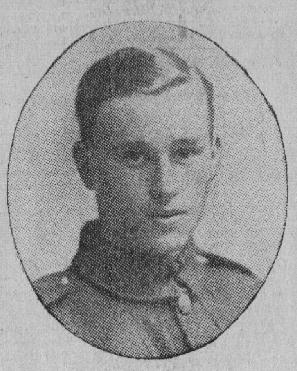
|
Arthur Handley was born in Loughborough in late 1896, the eldest child of Francis Charles William Handley, a bricklayer in the building trade, and his wife Sarah (née Thompson). Arthur's parents were married in Loughborough in 1896. Arthur had three brothers Harry, John and Harold and two sisters Nellie and Annie. He also had an older half-brother William Handley (formerly Thompson) who was born to his mother before Arthur's parents were married. In 1901 the family lived at 1 Cradock Street, Loughborough, but by 1911 had moved to 75 Gladstone Street. In 1911 Arthur, aged 14, was an office boy at John Jones and Sons' iron foundry in Meadow Lane, Loughborough, and sometime between 1911 and 1914 Arthur went to live with his maternal grandparents Joseph and Rachel Thompson at 149 Burder Street.
Arthur enlisted in early September 1914 and joined the 8th (Service) Battalion of the Leicestershire Regiment as Private 40223. From the Depot he was sent firstly to Aldershot for training. He moved to Shorncliffe in Kent at the end of February 1915. In April 1915 Arthur's battalion became part of the newly established 37th Division of Kitchener's 2nd New Army and the Division began to concentrate on Salisbury Plain. On 25th June the units were inspected by King George V at Sidbury Hill. On 22nd July the Division began to cross the English Channel and Arthur travelled to France on 29th July 1915. Initially the 37th Division concentrated near Tilques.
The 8th Battalion then moved via Watten, Houlie, St. Omer, Eecke and Dranoutre to Wulverghem and Berles-au-Bois, a short distance from the front line. In the months that followed the 8th Battalion did tours in the trenches, alternating with the 6th Leicesters who relieved them. They were Involved in operations in Bailleul, Le Bizet, Armentières, Mondicourt, Beauval and Berles-au-Bois.
In April 1916 Arthur had moved with the 8th Leicesters to the Doullens area for six weeks cleaning up, resting and training. In mid-May they returned once more to the trenches in the Bienvillers-Bailleulmont sector, but nearer Gommecourt. In June there was a series of nightly excursions into No-Man's Land with patrols attempting to gather information on the enemy's dispositions. On other occasions there were working parties out repairing the British barbed wire entanglements. The situation became increasingly hazardous as the month wore on when the Germans began to use a new and more accurate type of trench mortar.
The 8th Battalion did not participate in the first days of the Somme Offensive but was held in reserve. On 6th July Arthur's battalion left billets at Humbercamps and marched to Talmas, continuing on the following day to billets in Soues. On 10th July the battalion marched to Ailly-sur-Somme, entrained for Méricourt and travelled from there by lorry to bivouacs in Méaulte. Between 10th and 13th July the battalion was in the trenches near Fricourt and subjected to fairly continuous enemy fire.
On the 14th July the battalion was in action at the Battle of Bazentin Ridge. After the battle the battalion withdrew to Ribemont and then to Méricourt, and having entrained for Saleux, marched to Soues. From Soues the battalion moved to Longeau, Gouy-en-Ternois, Lattre St. Quentin and then to Arras where they went into the trenches on 29th July. Casualty figures for the battalion in July had been high: 17 officers and 415 other ranks had been killed, wounded or were missing.
The battalion went into Divisional Reserve at Agnez-les-Ouisans on 8th August but went back into the trenches at Arras on 18th August where they were on the receiving end of trench mortar bombs and heavy shells until 2nd September. They were relieved on 2nd September and marched to Duisans and on the following day proceeded to Lignereuil. On 13th September they marched to Frevent and entrained for Dernancourt. On 15th they reached a point between Fricourt and Méaulte before proceeding to Trônes Wood on 16th.
From 17th-23rd September the battalion was in reserve and supporting the troops in the front line by providing carrying parties. In the evening of 24th September the battalion marched up to take their position ready for an attack but before they reached this point the men were heavily shelled by the enemy. Just after midday on 25th September the 8th Leicesters launched a successful attack in waves on the right of Flers and then pressed on to Gueudecourt, Considerable losses, however, were suffered in this action.
Arthur was killed in action on 25th September, aged 26. He is commemorated on the Thiepval Memorial Pier and Face 2C and 3A and on the memorial at Emmanuel Church, Loughborough, as well as on the Carillon. He left his effects to his grandmother Rachel Thompson.
|
|
|
|
Lieutenant Albert William Hanford
|
|
15th Bn. Cheshire Regiment.
Killed in Action 22nd April 1918, Aged 30.
Buried Varennes Military Cemetery, II. C.2.
|
Albert William Hanford was born in Loughborough in the summer of 1887 and baptised on 3rd July 1887 at Emmanuel Church, Loughborough. He was the eldest son of Joseph Henry Hanford, a hosiery salesman and sample manager for Messrs Hanford and Miller, hosiery manufacturers, Loughborough, and his wife Emma (née Rodgers) who were married in Loughborough in 1882. Albert had three brothers Victor, Joseph and Frederick and one sister Beatrice. In 1891 the family lived at 3 Ward's End, Loughborough, but later moved to Hill Crest, 18 Fearon Street. Albert was the nephew of Alderman Wiliiam Hanford J.P., Mayor of Loughborough 1905 -1906.
Albert became a pupil teacher with Emmanuel Church and in 1905 and 1906 passed the annual exams set by the Diocese of Peterborough Education Board for teaching religious knowledge. He then studied at Nottingham University College. As a qualified school teacher for Leicestershire County Council he taught in several Loughborough schools before taking a position as Assistant Master at Quorn National School. In 1912 he was summoned for severely caning a ten year old scholar William Smith, but the case was dismissed.
Albert joined the colours in January 1915. He trained for a commission with the Officers Training Corps at Nottingham University College and on 25th October 1915 was gazetted as a Temporary 2nd Lieutenant. He was then sent to the 50th Training Reserve Battalion of the Cheshire Regiment at Prees Heath, Shropshire. Initially formed as a Service battalion on 10th April 1915 this became a Reserve battalion under orders of the Army's 35th Division. Albert was a musketry instructor with the 50th Battalion.
On 13th August 1917 Albert was posted to the 15th (Service) Battalion (1st Birkenhead) of the Cheshire Regiment. This was a Bantam battalion formed at Birkenhead in 1914 by Alfred Bigland MP for soldiers below the minimum Army regulation height of 160cm (5ft 3in). The battalion was adopted by the War Office on 15th August 1915 and had landed at Le Havre in January 1916. Albert was promoted to the position of Lieutenant and joined the 15th Battalion on the Ypres Salient in November 1917.
On 1st November 1917 the battalion was in the line on the south and south-east of Houthulst Forest, near the village of Koekuit, where they had just suffered two gas shell bombardments. After four days rest at De Wippe Camp on 5th November the battalion entrained at Ondank Station for Proven and marched to Putney Camp. Here training took place until 14th November. On 15th November the battalion returned by train to Ondank and marched to P Camp near Poperinghe. As there was no training ground at P Camp the men were given specialist classes in Lewis guns, rifle grenades, bombing and first aid.
On 24th November the battalion entrained on the light railway for Kempton Park station and proceeded to the front line south-west of Poelcappelle. As they moved forward they were shelled by the enemy, causing 19 casualties. Once in the line the men were positioned in muddy shell holes and no patrols were possible. The enemy artillery remained very active. After four days the battalion entrained at Hibou Farm on the light railway for Reading Siding and marched to Siege Camp at Elverdinghe.
During December 1917 the battalion was mainly in various camps (Huddlestone Camp, Siege Camp, School Camp west of Poperinghe, and Morat Camp near Brielen) training and employed on road work. Christmas and the New Year 1918 were spent at School Camp and training continued there and at Elverdinghe until 15th January. On 16th January the battalion returned to the front line trenches at Poelcappelle, on 20th went to the support trenches and on 24th into dugouts to work on shelter improvement. After a break at Huddlestone Camp there was a further trench tour during which the battalion provided wiring parties.
On 9th February the battalion entrained at Elverdinghe for Emilie Camp, moving to Cambridge Camp for working parties two days later. From 16th - 21st February there was training at Bridge Camp, after which the battalion went into the trenches at Houthulst Forest and carried out several raids on enemy positions.
From 1st-8th March the battalion was in billets at Kempton Park, Gournier Farm and Caddie dugouts while undergoing training. On 9th March they moved into G.H.Q. Reserve and took a train to Noyon Camp near Crombeke. Here they took part in training and competitions in rapid firing and guard mounting as well as playing football. On 23rd March the battalion entrained at Rousbrugge station for Méricourt l'Abbé and marched to billets in Suzanne. On the following day they were ordered to proceed at once to Maricourt to support the front line troops against the German Spring Offensive. The battalion went into position on the Bray-Méaulte road, and then on the Buire-Surancre road until 30th March and during this time incurred heavy losses.
After four days in billets at La Houssaye for cleaning up and training the battalion moved on 4th April to Herissart and on 7th April to Hedauville. On 8th April they went into the front line trenches north of Albert, with the battalion HQ in a cellar at Bouzincourt. Here they were heavily bombarded by the enemy. Following this the battalion had three quieter days in reserve at Sunken Road, Bouzincourt. On 14th April they moved into billets at Hedauville but the enemy then shelled the village, causing more casualties and the battalion was forced to move.
On 14th April the battalion returned to the trenches, this time east of Martinsart, where with another battalion, made a small advance. A concerted attack on the enemy began on 22nd April. The objective was reached but the attacking patrols under the command of Lieutenant Albert Hanford encountered strong opposition. Albert was severely wounded and died as he was being carried in by stretcher bearers. He was aged 30.
Albert was buried in Varennes Military Cemetery, Grave II. C. 2.
Albert's Lieutenant-Colonel wrote to his father: 'Your son was killed by machine gun fire whilst leading his men to the attack. The unit on our left was held up by a strong point, and your boy attacked in conjunction with the other battalion. He did his utmost and by his good leadership ensured the attempt being made in the strongest and best way possible. We all called him "Gus" and he was one of the most popular officers we had. He has done his duty consistently and well always and we miss him very much. We buried him yesterday beside his Company Commander. The deepest sympathy of all officers, N.C.O.'s and men of this battalion is extended to you and I trust God may give you and your wife extra strength to bear this terrible blow'. The Chaplain wrote later that Lieutenant Hanford was buried with full military honours, adding: 'I knew your son well and had the highest esteem for him as a man and the warmest admiration for him as a soldier'.
Albert is remembered on the Nottingham University College Officer Training Corps Memorial, on the memorial in the former St. Peter's Church building, Loughborough, and on the Carillon.
|
|
|
|
Private 308650 William Dean Hanson
|
|
11th Bn, Tank Corps.
Formerly 3036 Leicestershire Regiment.
Killed in Action 8th October 1918, Aged 22.
Buried Prospect Hill Cemetery, Gouy, III. F. 4.
|
William standing left next to his brother
|
William Dean Hanson was born on 1st January 1896 in Smethwick, Staffordshire. He was the son of Edmund Hanson and his wife Harriet (née Dean) who were married on 5th August 1895 at Harborne, Staffordshire. William had three brothers Leonard, Edmund and Herbert and four sisters Doris, Ida, Ivy and Ethel. Another sister Gertrude died in infancy in 1899.
William's father was a coach body maker and between 1896 and 1910 the Hanson family moved around between Smethwick, Handsworth, Birmingham, Lancaster and Saltley, Warwickshire. By 1911 they were living at 61 Lower Cambridge Street, Loughborough, and William and his father were both employed as coach body makers at an electrical engineering works. The family later moved to 11 Mills Yard, Wood Gate.
William's service record has not survived but he appears to have enlisted with the Leicestershire Regiment as Private 3036 at some point in 1915. Whether he went overseas with the Leicesters in 1916 or 1917 is unknown. In late January or early February 1918 William was transferred to the 11th Battalion of the Tank Corps as Private 308650.
The Tank Corps had been formed from the Heavy Branch of the Machine Gun Company on 27th July 1917 and tanks were first used successfully on a large scale on 20th November 1917 at the 1st Battle of Cambrai. Nearly 400 tanks, working closely with the advancing infantry, smashed through the Hindenburg Line positions, temporarily creating a rupture to the German lines and the chance for a breakthrough. Insufficient mobile reserves could get through in time to exploit the tanks' success, and within days the chance had gone. Cambrai, however, proved to be a key learning experience for the British command.
During the German Spring Offensive in March 1918 British tanks were little used as a defensive weapon, but played an important part in the extraordinary counter-attack at Villers-Bretonneux on 24th-25th April. During this action they faced for the first time the few German tanks that were ever produced. (The Germans also used captured British tanks, mostly from Cambrai).
On 4th July 1918 at Le Hamel and in front of Amiens on 8th August 1918 tanks played a central role in the crushing success of the Allied attacks. Before Le Hamel, the Australian Corps had carried out intensive training with the tanks in order to overcome lingering doubts after Bullecourt and to tighten up infantry/tank co-operation. 450 tanks took part in the Amiens attack, where the Whippets and various armoured cars penetrated deep behind the German defences. In conjunction with the new artillery and infantry tactics, tanks proved to be useful in crushing wire; over-running machine gun posts and strong points and helping infantry through the streets of destroyed villages.
Tank losses were, however, significant. On 23rd August the 11th Battalion of the Tank Corps had eighteen fighting tanks in action to support the 56th Division in an attack on Boyelles. All eighteen tanks started and four reached their final objective but nine were then put out of action either having been hit and burned out or broken down.
On 24th August the 11th Battalion had ten fighting tanks in action to support the 56th Division's advance on Croisilles and to take the defences of Henin Hill from the south. The attack stalled as the advance through Croisilles had to be made over a low ridge, the crossing of which provoked intense fire from the enemy. Three tanks were hit and knocked out. A renewed attack went forward with only two tanks. One had its roof blown in by a trench mortar and the other became ditched and the enemy threw phosphorus bombs on its roof.
On 26th August the 11th Battalion assisted the Canadians in an attack on the ruins of Monchy le Preux with nine tanks and five tanks were hit or knocked out. On the following day eight tanks were in action with the Canadians and all were heavily shelled and knocked out or otherwise incapacitated.
From 1st-23rd September the remaining tanks of the 11th Battalion were refitted at Blairville tankodome. It was not until late September that a large enough force had been assembled again.
The 11th Battalion was back in action with fourteen tanks at the Battle of the Canal du Nord which began on 27th September. Two tanks failed to start, twelve engaged the enemy, two broke down and eight were hit and knocked out. The enemy fought fiercely and even attempted to pull the Hotchkiss guns out of the tanks. On 29th September the battalion had seven tanks in action, One broke down and withdrew early on. Another tank going round the west of Villers Guislain was surrounded by the enemy and disabled, all the crew being taken captive. A third tank was hit and knocked out in a village. One tank, however, helped the infantry capture Villers Guislain.
On 8th October 1918 the 11th Battalion was in action again at the 2nd Battle of Cambrai with fourteen tanks. Three tanks were hit and knocked out and among the men of the battalion there were 20 casualties. William, aged 22, was one of five men who were killed.
From 21st August 1918 to the Armistice on 11th November 1918, some 2,400 men and officers of the Tank Corps became casualties.
William was buried in Prospect Hill Cemetery, Gouy, Grave III. F. 4.
|
|
|
|
Corporal 11268 Leslie George Hardy MiD
|
|
1st Bn, Coldstream Guards.
Killed in Action 8th October 1915, Aged 20.
Buried Quarry Cemetery, Vermelles, A. I.
|
Leslie George Hardy was born in 1894 at 16 Orchard Street, Tamworth, Staffordshire, the youngest child of Samuel Hardy, a grocer, and his wife Susannah Lavinia Gaunt. His parents were married in Sheffield in 1879. Leslie had one older brother William and five older sisters Mary Jane, Edith, Adelaide, Beatrice and Laura. By 1901 the family had moved to Brownhill, Burslem, and by 1911, when most of the children had left home, Samuel was living with Laura and Leslie at 109 Corporation Street, Stafford. Leslie, now aged seventeen, was an electrical engineer with Siemens Bros.
When war broke out Leslie, who was then living at 11, Western Avenue, Tring, Hertfordshire, returned home to Stafford and enlisted. He was appointed as Private 11268 in the 1st Battalion of the Coldstream Guards. He was sent to Aldershot for training and to France on 8th December 1914, around the time that his mother died. He took part in the winter operations from 1914-15. On 9th May 1915 his battalion took part in the Battle of Aubers Ridge, following which Leslie was promoted to the position of Corporal. The battalion spent the summer months at Lumbres, near St. Omer, and were then moved towards the Bethune, Lens area. Leslie lost his life, aged 20, on 8th October 1915 in action at the Battle of Loos.
Leslie's father retired to Woodbrook Cottage, Forest Road, Loughborough. Leslie's older brother William Gathorne Hardy, who was a civil engineer in Montreal, fought with the Canadian Overseas Expeditionary Force, was mentioned in despatches and survived the war.
|
|
|
|
Private 11789 Charles Henry Harris
|
|
6th Bn, Leicestershire Regiment.
Killed in Action 29th September 1916.
Commemorated Thiepval Memorial, pier & face 2c 3a.
|
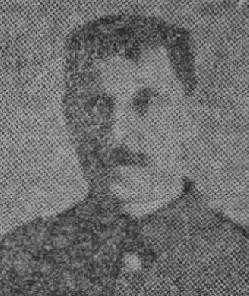
|
|
Charles Henry Harris was born in Leicester in 1882, the son of Charles Henry Harris, a hosiery trimmer, and his wife Sarah (formerly Needham, née Wragg Saywell) who were married in Leicester in 1880. Charles Henry Junior's mother Sarah had previously been married to Joseph Needham who died in 1871. Charles Henry Junior had three sisters Florence, Sarah and Lily Harris and four half-brothers from his mother's first marriage - Alfred, Edward, Libbaeus and Joseph Needham. The Harris/Needham family lived at 15 Bonners Lane, Leicester, and in 1901 Charles Henry Junior, aged 17, was a shoe pressman and between 1901 and 1908 had served for six years with the 1/4th (Territorial) Battalion of the Leicestershire Regiment.
In 1908 Charles Henry Junior married Mary Ann Fenton, a hosiery brusher, in Leicester and the couple set up home at 18 Percy Street, Leicester. The couple had five children: two (born and died between 1908 and 1910), Dorothy (born 1911), Charles (born and died 1912) and Florence (born and died 1914). After Florence died on 1st September 1914 Mary Ann moved to 10 Morley Street, Loughborough, with her only surviving child Dorothy.
When war broke out Charles Henry Junior, as a Class 1 National Reservist, was recalled by the Army. He reenlisted at Leicester as Private 11789 on 21st August 1914 and joined 6th (Service) Battalion of the Leicesters six days later. He was sent to Bordon, near Aldershot, Hampshire where the emphasis was on individual training, squadron and platoon drill. In March 1915 the battalion went into billets in Liphook.
In April 1915 the 6th Battalion became part of the 37th Division of the Army and concentrated at Cholderton on Salisbury Plain. On 25th June the 37th Division was inspected by King George V at Sidbury Hill. On 22nd July 1915 the Division began to cross the English Channel and by 2nd August all units were concentrated near Tilques not far from St.Omer in the Nord-Pas-de-Calais. Charles Henry arrived in France on on 30th July 1915.
In September Charles's battalion was sent to the area of Berles-au-Bois, south-west of Arras and near the front line. In the months that followed the 6th Battalion did tours in the trenches, alternating with the 8th Leicesters who relieved them. The battalion was engaged in localised operations seeking a tactical advantage and remained in the area around Bienvillers and Bailleulmont until July 1916.
On 1st July 1916 the 6th Battalion moved from Saulty to Humbercamps, where it was held in reserve for the Somme Offensive which had just begun. On 6th July the battalion marched to Talmas to join the Army's 21st Division. From 7th to 10th July the battalion was in Hengest-sur-Somme, and from there on 10th marched to Ailly, entrained for Méricourt, took buses to Méaulte, and then proceeded to Fricourt. Between 14th and 17th July the battalion took part in an attack on and successfully captured Bazentin-le-Petit Wood and village. On 20th July the battalion entrained at Ribemont and detrained at Saleux, after which they marched to Hengest. Travelling part of the way in lorries and part of the way on foot they reached Arras on 27th July and relieved the 8th Leicesters in the trenches on 7th August. The remainder of August was spent in the trenches and in billets in Arras.
On 4th September the battalion left Arras for Liencourt and after a week there for training moved to Fricourt and Bernafay Wood, east of Montauban-de-Picardie. Here from 19th to 24th September the men were employed in the improvement of communication and support trenches in preparation for a forthcoming attack on Gueudecourt. On 25th September the 6th Leicesters moved up to the assembly trenches in order to be ready to support the 8th and 9th Leicesters as they advanced. Progress was made north and east of Gueudecourt but as the Leicesters consolidated their position the village itself and its approaches were heavily bombarded by the enemy. This situation remained the same over the next few days and Charles was killed in action on 29th September 1916, aged 34.
Charles is commemorated on the Thiepval Memorial Pier and Face 2C and 3A.
His widow Mary Ann married Reginald E. Dean in Loughborough in 1917 and they had a daughter Mabel, born in 1917. This second marriage, however, was also shortlived as Reginald died in 1924. Mary Ann herself died four years later in 1928.
|
|
|
|
Private 242494 John Joseph Harris
|
|
1/6th Bn Sherwood Foresters (Notts & Derby Regt.)
Previously served as no. 7703.
Killed in Action 30th May 1917, Aged 23.
Buried Fosse No. 10 Communal Cemetery Extension, Sains-en-Gohelle, I. C. 1.
|
John Joseph Harris was born in late 1893 or early 1894 in Whitwick, Leicestershire. He was the second son of John Edward Harris and his wife Eliza Mary Agnes Harris (née Muston) who were married in Whitwick in 1885. John Joseph had two brothers William and Joseph and two sisters Mary and Annie. In 1901 the Harris family lived at Green Lane, Whitwick and John Joseph's father was a journeyman carpenter. By 1911 they had moved to 46 Cartwright Street, Loughborough. John Joseph, now 17, was a weaver for an elastic web manufacturer and his father was now employed as a wood machinist at a car works.
John Joseph's service papers have not survived but it is known that he enlisted in Nottingham and joined the1/6th Battalion of the Sherwood Foresters (Nottinghamshire and Derbyshire Regiment). This was a unit of the Territorial Force which was mobilised for war service on 5th August 1914 and became part of the 139 (Forester) Infantry Brigade in the Army's 46th (North Midland) Division. John Joseph joined C Coy of the 1/6th Battalion as Private 242494 but the exact date he joined is unknown. He was sent to France sometime in 1916 or early 1917. The battalion received drafts of reinforcements in March, May, July and December 1916 and in January and February 1917 and John Joseph could have been in any one of these drafts.
In the months of 1916 prior to the start of the Somme Offensive on 1st July the 1/6th Leicesters moved around between the areas of Coulonvillers, Beaumetz, Puchvillers, Mont St. Eloy, Acq, and Humbercamps. By 19th June the battalion was in the line facing Fonquevillers, where on 30th June they moved at night to battle assembly positions. On 1st July the battalion went into battle at Gommecourt but all attempts at advance were met with heavy artillery and machine gun barrage.
Withdrawn from the front line the battalion marched over three days to Bienvillers. They returned to the front line trenches on 11th July at Bretencourt, and from then on until the end of October did trench tours at Bretencourt, Bellacourt and Bailleulval. From the end of October until 6th December the battalion was in training mainly at Gapennes and Sus St. Leger before going into Divisional Reserve and then doing trench tours at Souastre until 6th February 1917.
Training continued throughout February 1917 at Halloy and Beaudricourt and in early March the battalion was back in the trenches at Foncquevillers. The battalion moved to St. Amand on 19th March and finally, after twelve days in transit on foot and by bus and train, to billets in Noeux-les-Mines. Four days later they were in the trenches near Angres before making two attacks on Lievin on 20th and 23rd April. In May the battalion was in the trenches east of Cité St. Pierre, with rest periods at Petit Sains. On 30th and 31st May the enemy made several raids on the British line.
John Joseph was killed in action on 30th May 1917, aged 23. He was buried in Fosse No. 10 Communal Cemetery Extension, Sains-en-Gohelle, Grave I. C. 1.
|
|
|
|
Private 240364 Samuel Halford Hartland
|
|
1/5th Bn, Leicestershire Regiment.
Died of Wounds 15th August 1917, Aged 35.
Buried Philosophe British Cemetery, Mazingarbe,I. U. 50.
(his brother William H. Hartland also fell see below)
|
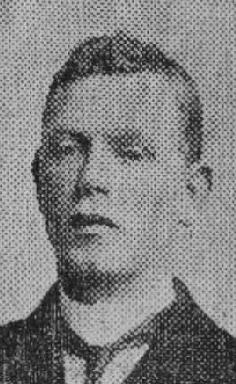
|
Samuel Halford Hartland was born in Aston, Birmingham in 1882. He was the elder son of Samuel Hartland, a bricklayer, and his wife Sarah Ann (née Halford) who were married on 2nd July 1873 at the Church of St. Peter and St. Paul, Aston. Samuel Junior had one brother William and one sister Martha. Between 1891 and 1901 the family lived at 52 Francis Street, Aston. After Samuel's mother died in 1908 his father moved to 'Hartville', Hewlett Road, Cheltenham. Samuel Junior, a bricklayer like his father, came to work in Loughborough and lived in Leicester Road, Shepshed.
On 11th September 1905 Samuel Junior married Rose Hannah Price at St. Botolph's Church, Shepshed. Samuel and Rose set up home at 10 Rosebery Street, Loughborough, and soon had three daughters Esther, Edith and Beatrice. Samuel secured employment as a labourer at the Falcon Works and became well known as a pianist and humourist in the town. Between 1911 and 1914 Samuel's younger brother William obtained employment at the Empress Works and came to live with Samuel and his family in Rosebery Street.
Samuel was a member of the local Territorials and was mobilised on the outbreak of war. As Private 2026 (later renumbered as 240344) in the 1/5th Leicestershire Regiment he was sent to Bishop's Stortford and then Luton for training. On 25th February 1915 the battalion was ordered to entrain at Harlow for Southampton. They landed at Le Havre three days later, having encountered very rough seas. They went by train to Arneke, and then marched to Hardifort. The battalion spent the first few months in France in the Armentières sector, training and doing tours in the trenches. For the whole of April they were in trenches near Wulverghem and subjected to continual sniping by the enemy. In June they moved to the Salient, firstly to Locre and Kemmel and then near Zillebeke and Ouderdom, where they remained until the beginning of October when they were ordered to move to Hesdigneul. Further moves followed to La Couture in November and Merville and Thienne in December
January 1916 was taken up with a potential move of Samuel's battalion to Egypt which was aborted at Marseilles, the battalion being returned to Candas, and the area of Vimy Ridge.
In mid-February 1916 the 1/5th Battalion took over the line north of the River Ancre opposite Beaumont-Hamel. On 29th February the battalion moved to the area of Doullens where the men worked on improving the trenches despite being subjected to a considerable bombardment from the enemy with mines and craters being blown.
From 9th March 1916 the 1/5th Leicesters were in the area of Vimy Ridge, Pas de Calais, either in the front line, in support, in reserve or at rest. On 27th April the battalion was sent to the neighbourhood of Neuville St. Vaast to work with the French and English tunnellers and then to billets in Luchaux for bayonet training. This was followed by a period at Souastre digging cable trenches, and constructing bomb stores and gun pits in preparation for a 'big push'.
On 4th June 1916 the battalion was moved up to trenches near Gommecourt. This was followed by further training at Warlincourt. During this time Samuel was allowed some home leave. On 30th June the battalion assembled in a trench near Foncquevillers Church ready for the diversionary attack at Gommecourt on the first day of the Somme Offensive planned for 1st July.
On 1st July 1916 the 46th Division of the Army, of which the 1/5th Leicesters were part, had 2445 casualties at Gommecourt. On 7th July they relieved the 4th Lincolnshires in the trenches opposite Essarts-lès-Bucquoy. The battalion remained in the area of Monchy-au-Bois until 29th October, either in the trenches or resting at Bienvillers or Pommier. The battalion's next move was to Millencourt for intensive battle training, returning to Halloy and then Souastre at the beginning of December.
The battalion remained at Souastre until 11th March 1917 and then moved once more up to the line taking over 2,600 yards of frontage from the La Brayelle road to the Hannescamps-Monchy road. On 17th March they moved into Gommecourt for road mending before moving to Bertrancourt, Raincheval and then Rainvillers not far from Amiens.
On 28th March the battalion marched to Saleux, entrained for Lillers in the north, and marched to Laires. Training took place until 13th April and continued for three further days at Manqueville, after which the battalion moved to the western outskirts of Lens. From there they marched to Bully-Grenay and went into the front line trenches where they were heavily shelled. On 29th April the battalion went into rest billets in cellars at Cité St. Pierre until 3rd May when they went into support trenches. On 8th they went into billets at Fosse 10 near Petit Sains for training and on 12th into reserve at Angres. Further trench tours south-west of Lens followed until 26th May when the battalion went into billets at Marqueffles Farm for training in bayonet fighting and bombardment and to practise methods of attack. On 6th June the battalion was back in the line and on 8th June went into the attack, suffering 96 casualties.
Apart from two breaks at Red Mill from 9th-13th and 18th-20th June the battalion was in the trenches until 22nd June. On 21st June C Coy was accidentally gassed by the Royal Engineers, resulting in 94 casualties of whom 22 died. Back at Marqueffles Farm from 22nd the battalion had Lewis gun and signalling classes as well as attack training over a flagged course. On 27th June the battalion moved up to the line ready to attack on the following day. As they climbed out of the trenches on 28th June they met with the inevitable machine gun fire and over the next two days 60 Ordinary Ranks were killed.
Relieved from the trenches at Lievin on 3rd July the battalion moved to Monchy-Breton for reorganisation and training until 22nd July when they moved to Vaudricourt before going into the line at Hulluch until 28th July. After respite at Noeux-les-Mines the battalion was at Fouquières until 14th August, practising for an attack. Moving to Noyelles the battalion went into the trenches on 15th August. On the way up to the trenches an enemy shell landed by one party of soldiers, killing eleven men instantly and wounding fourteen. Samuel, aged 35, was one of those wounded. He died the same day and was buried in Philosophe British Cemetery, Mazingarbe, Grave I. U. 50.
Samuel had been due to come home on his second leave the day after he died. His widow first received intimation in a letter from a comrade, who sent home a photograph of his wife and three children, which Pte. Hartland was carrying at the time. The Captain of Samuel's company wrote to his wife as follows: 'It is with great distress that I have to tell you of the death of your husband, Pte. Hartland, while in action. Over a week our battalion was in action and your husband was hit. I saw him when he was being carried down to the dressing station on a stretcher, and he spoke to me. I asked him if he was badly hit, and he said no, only it was difficult to breathe freely. Later in the dressing station he held up bravely, telling the doctors not to attend to him as there were others more badly hit than he. Personally I was struck by his coolness and courage, I think he was perfectly fine. Very soon afterwards he passed away. I have known him ever since he has been in my company, and have always found him a most reliable and excellent fellow. He was one of those men that one cannot spare. Please accept my deepest sympathy in your great trouble'.
Samuel is remembered on the memorial in the former St. Peter's Church building, Loughborough, as well as on the Carillon. His only brother William had been killed in action four months previously.
|
|
|
|
Private 15138 William Herbert Hartland
|
|
1st Bn, Sherwood Foresters (Notts & Derby Regt.)
Killed in Action 14th April 1917, Aged 23.
Commemorated Thiepval Memorial, pier & face 10c 10d & 11a.
(his brother Samuel H. Hartland also fell see above)
|
William Herbert Hartland was born in Birmingham on 8th June 1893 and baptised on 23rd August 1893 at the Church of St. James the Less, Ashted, Birmingham. He was the younger son of Samuel Hartland, a bricklayer, and his wife Sarah Ann (née Halford) who were married on 2nd July 1873 at the Church of St. Peter and St. Paul, Aston. William had one brother Samuel and one sister Martha. In 1901 the family lived at 52 Francis Street, Aston. After William's mother died in 1908 his father moved to 'Hartville', Hewlett Road, Cheltenham, but later moved to Loughborough. By 1911 William was an apprentice bricklayer and lodging in South Leverton, near Lincoln. Between 1911 and 1914 he obtained employment at the Empress Works in Loughborough and came to live with his brother and family at 10 Rosebery Street, Loughborough.
When William enlisted in 1914 he joined the 1st Battalion of the Sherwood Foresters as Private 15138. Although his service record has not survived it is known that he was sent to France on 11th May 1915. At that time the 1st Battalion was in the trenches near Laventie, north-east of Béthune, with rest periods at Estaires. In mid-August the battalion moved to the Fleurbaix/Bois Grenier area. Here further trench familiarisation began and the battalion went into the front line sector in mid-September. At Bois Grenier on 25th September the battalion was in action in an attack to capture part of the German front line as an adjunct to the Battle of Loos. The battalion remained in the Bois Grenier area for a considerable time instructing inexperienced troops.
On 3rd March 1916 orders were received to relieve the French 17th Division in the Carency sector, an area subject to severe shelling. After a break at Bruay in April the battalion moved back to the Souchez-Angres front line. In June the battalion went to Enguinegatte where intensive training commenced. On 25th June the battalion moved to Ailly-sur-Somme and in the Somme Offensive took part in the Battle of Albert from 1st to 10th July. On 11th July the battalion withdrew to Dernancourt and then to billets at Bresle. August was spent either resting in Béthune or in the trenches at Sailly-Labourse, September in the trenches or resting in the Fouquières area and the first half of October at Sandpits Camp near Albert before moving to Trônes Wood south of Longueval. In mid-November the battalion left Trônes Wood for the Château de Selincourt, near Dieppe, to undergo further training. On 29th December the battalion left Selincourt and entrained for Albert.
From 26th January to 4th March 1917 the battalion was operating in the Bouchevesnes sector, after which they moved via Moislains and Nurlu to Heudicourt. The Germans were retreating to the Hindenburg Line and the Allies were planning an attack on the enemy at nearby Gouzeaucourt. This attack began on the night of the 12th April and during this operation on 14th April 1917 William, aged 23, was killed in action.
William is commemorated on the Thiepval Memorial, Pier and Face 10C, 10D and 11A.
|
|
|
|
Private 419325 Everard Clarence Harvey
|
|
2/2 (North Midland) Field Ambulance, Royal Army Medical Corps.
Killed in Action 26th September 1917, Aged 24.
Buried Bridge House Cemetery, Langemark-Poelkapelle, A. 19.
|
Everard Clarence Harvey was born in Loughborough in 1893 and baptised on 6th August 1893 at All Saints Church, Loughborough. He was the son of Benjamin Harvey and his wife Eliza (née Tabb) who were married at St. Botolph's Church, Shepshed, on 28th December 1895. Everard's father was a framework knitter and in 1891 the Harvey family lived at 12 Oxford Street, Loughborough. Everard had two brothers John and Albert and two sisters Elizabeth and Jane.
After Everard's father died in 1898, aged 40, Everard's mother moved to 44 Derby Road, Loughborough, with her three youngest children and became a beer house keeper. Everard's sister Jane acted as barmaid. By 1911 Everard, now 18, had secured employment at the Empress Works as an electrical pattern maker.
Everard enlisted at Leicester on 20th January 1915, giving his address as 124 Ratcliffe Road, Loughborough. As Private 2566 (later re-numbered as Private 419325) he was posted to the 2/2 (Reserve) North Midlands Field Ambulance of the Royal Army Medical Corps and sent to Watford for training. In April 1916 he was sent with his Field Ambulance to Dublin during the Easter Rising. On 6th June, in Dublin, he was given 168 hours detention for neglect of duty. Not long after this Everard must have been granted leave as he married Nellie Adcock in Loughborough in the summer of 1916.
After the end of the fighting in Dublin the 2/2 Field Ambulance had been sent to the Curragh for further training until the end of the year. In January 1917 they returned to England and after a brief stay in Gillingham, Kent, left Southampton for France on 23rd February 1917 on the SS Southwestern Miller cargo ship.
From the Gare des Marchandises, Le Havre, the 2/2 Field Ambulance travelled by train to Bayonvillers, Somme. From there, on 8th March, they marched to Proyart, south of Albert, and took over the Divisional Main Dressing Station and the Divisional Rest Station from the 1/3 Northumbrian 1st Field Ambulance.
When away from the trenches a field ambulance's role was to keep the fighting men fit and healthy. This was achieved by setting up Divisional Rest Stations [DRS] and baths (usually sited in a brewery where up to 50 men could be bathed at a time in the large vats). They were also allocated special tasks such as providing treatment for scabies, trench foot, and other ailments. When in the trenches the field ambulance's role was similar to modern day emergency ambulance services: to collect and transport patients to someone with specialised knowledge or to specialist equipment, whilst monitoring them, and treating them if necessary to ensure their condition remained stable. Before transport the casualties were usually seen at an Advanced Dressing Station (ADS) or Post (ADP) for bandaging and morphine injections as appropriate.
By 17th March the 2/2 Field Ambulance had extended the accommodation available at Proyart to 7 Adrian huts, 2 houses, 1 store tent, 2 marquees and 2 Indian tents allowing room for 650 lying cases and 1000 patients if sufficient staff were available. The numbers of casualties passing through the 2/2nd Field Ambulance were often quite high. During the period 23rd-29th March, for example, 468 casualties (sick and wounded) were admitted. After treatment 136 were discharged to duty while 334 were transferred to Casualty Clearing Stations for evacuation to Base Hospitals.
On 10th April the 2/2 Field Ambulance took over the Advanced Dressing Station in the church at Bouvincourt from the 2/1 North Midland Field Ambulance and also took over the Advanced Dressing Posts at Hancourt and Roisel. On 14th April the right Advanced Dressing Post was moved from Hancourt to Bernes. On 24th May the 2/2 Field Ambulance was instructed to prepare for a move to Léchelle. The site at Léchelle about five miles from the front line was prepared and the move took place on 30th May. On 24th August there was another move to the Royal Engineers Camp on the Bouzincourt-Aveluy road.
On 1st September the unit left the camp for Beaucourt, entrained for Godevaersvelde, marched to Watou and took over the hospital and billets there. On 15th September they moved from Watou to Hilhoek and took over the V Corps Rest Station. On the following day many sick were admitted and at 6.00pm there were 998 patients in the hospital.
Everard was killed in action, aged 24, on 26th September 1917, in the Battle of Polygon Wood (a phase of the 3rd Battle of Ypres, or Passchendaele) He was one of three members of the 2/2 Field Ambulance killed that day. Several others were wounded and gassed. Everard was buried in Bridge House Cemetery, Langemark-Poelkapelle, Grave A. 19. He is remembered on the memorial in the former St. Peter's Church building, Loughborough, and on the Carillon.
Everard's widow was married again in 1920 to John Thomas Brooksby and their daughter Betty was born in 1927.
|
|
|
|
Private 32733 John Albert Harvey
|
|
7th Bn, South Staffordshire Regiment.
Formerly 47377 Notts & Derby Regiment.
Killed in Action 4th October 1917, Aged 24.
Commemorated Tyne Cot Memorial, Zonnebeke, panels 90-92 and 162-162A.
|
|
John Albert Harvey, known as 'Jack' to his family and friends, was born in Loughborough in 1893, the son of Joseph Harvey and his second wife Ruth Ada (née Blatherwick) who were married at All Saints Church, Loughborough, on 24th March 1881. Jack's father was a hay and corn agent in the early 1890s and the family lived at 68 Derby Road, Loughborough, but previously he had been licensee of the Clarence Inn, Nottingham Road. In 1893 the family returned to the Clarence Inn. When Jack's father died on 5th January 1900 his mother took over the running of the pub, later retiring to 139 Ratcliffe Road and then 29 Rendell Street.
Jack had three brothers Joseph, Harry and William, and four sisters Lillian, Ada, Ivy and Ethel. Another sister Minnie had died as an infant. He also had two half-sisters Ann and Florence from his father's first marriage to Ann Williams, who had died in October 1879 in a dreadful pony and trap accident at Cropston.
Jack enlisted at Derby in May 1916 and joined the Sherwood Foresters (Notts and Derby Regiment) as Private 47377. At the time of enlistment he was a hosiery foreman at the Derby factory of R. Rowley and Co., having been apprenticed with Messrs. Cartwright and Warner of Clarence Street, Loughborough. He was a former member of Stanford on Soar and Loughborough Emmanuel Church choirs, and of the Squirrel Football Club.
Jack's service record has not survived. How long he was with the Sherwood Foresters before transferring to the 7th (Service) Battalion of the South Staffordshire Regiment as Private 32733 is consequently unknown. His date of arrival in France is similarly unknown. The 7th South Staffordshires received batches of reinforcements from the 9th Infantry Base Depot in Etaples and other reinforcement depots in December 1916 and in January, March, April, May, August and September 1917. Jack could have been in any one of these batches.
From the end of November 1916 to the 20th January 1917 the 7th South Staffords were holding the line near the River Ancre, Somme, with rest periods at Englebelmer. It was intensely cold and the ground was very wet, making operations extremely difficult and casualty figures high. At first enemy shelling was only intermittent but it became more frequent towards the end of the year.
On 20th January 1917 the battalion began a three-day march to Cramont through snow and ice. At Cramont there was a training course until 15th February, after which the battalion moved to Bus-les-Artois to work on an important railway construction in the Couin-Coigneux-Courcelles area. On 5th March information was received that enemy aeroplanes were dropping sweets poisoned with arsenic. On 22nd March the battalion moved to work in the Colincamps-Serre-Puisieux area. From 24th March until mid-April training in open warfare and wood fighting took place near Sarton-Orville. The Spring Offensive had begun on the 9th and although training continued until 17th April the battalion was twice put on high alert.
On 24th April the battalion took over the line north of Boursies, after which they moved to Bancourt to support defences on the Morchies-Beaumetz-Hermies line. At Lebucqiere and Demicourt the battalion was heavily shelled. On 18th May they entrained at Albert for Caestre. From a camp at Flêtre they marched to another camp at Mont Vidaigne to provide working parties at La Clytte, Bailleul, Westoutre and Locre.
New tactics were then practised for an attack on the Messines Ridge which began on 7th June with the explosion of nineteen massive mines under the ridge. In the Battle of Messines, possibly the most successful local operation on the Western Front in WW1, 25 Ordinary Ranks of the 7th South Staffords were killed and 69 wounded.
On 18th June the battalion began moving by stages to La Commune for training until 12th July, when they marched to Watten and entrained for Poperinghe. Trench tours one mile north of Ypres took place in July and the battalion sustained yet more casualties. Following a break at Elverdinghe, St. Jans ter Riszen and E. Camp, Poperinghe, the battalion was in action again on 19th August in the action of the Cockcroft after the Battle of Langemarck.
After one more trench tour the battalion left in late August for Murat Camp, Brake Camp and finally O Camp at Vlamertinghe. After hostile aircraft bombed O Camp the battalion moved firstly to Esk Camp, Poperinghe, and then to Vanderberger Farm near Watou for training and practice attacks during September. On 1st October the battalion was resting at Houtkerque before moving by bus to Siege Camp south of Elverdinghe and then to the front and support lines at Canal Bank, Ypres. On 4th October the battalion attacked enemy positions around Poelcapelle and Jack, aged 24, was one of 41 Ordinary Ranks killed in action.
The news of his death was conveyed in a letter to Jack's parents from the Lieutenant of his company, who wrote: 'I regret having to inform you of the death of your son, Signaller John A. Harvey. He was killed after we had made a successful attack and reached our objective. He was a very good worker and was a very brave boy; every man in his platoon and company liked him. His brother signallers speak very highly of him. You have my deepest sympathy, and I hope that you will bear your bereavement bravely'. Mrs. Harvey also received a letter of condolence from her son's chum in the company.
Jack is commemorated on the Tyne Cot Memorial, Zonnebeke, Panels 90 - 92 and 162 - 162A. He is also remembered on the memorial in All Saints Church, Loughborough, and on the Carillon.
Jack's brother George served in the Leicestershire Regiment and the Labour Corps and survived the war.
|
|
|
|
Private 1978 Gilbert Edwin Hawker
|
|
1/1st Leicestershire Yeomanry.
Killed in Action 13th May 1915, Aged 22.
Commemorated Ypres (Menin Gate) Panel 5.
|
Gilbert was born in Darlington, Co. Durham, in 1893. He was the eldest son of Frank William Charles Hawker and his wife Winifred Florence (née Powell) who were married in Gloucester in 1887. Gilbert had two older sisters Evelyn and Marion and younger twin brothers Lawrence and Winfield. In 1901 the family was in Darlington where Frank Hawker had a job as a railway carriage draughtsman, but by 1911 they had moved to 65 Toothill Road, Loughborough as Frank Hawker had gained promotion to the position of estimator for a manufacturer of railway stock.
In 1911 Gilbert was living 33 Storey Square, Barrow in Furness (then in Lancashire) and was an apprentice engineer. In the summer of 1913 he joined the Leicestershire Yeomanry as Private 1978.
The Leicestershire Yeomanry was headquartered in Leicester and C Squadron was based in Loughborough.
The 1/1st Leicestershire Yeomanry was mobilised on 5th August 1914 and billeted in the village of Palgrave, Suffolk, until 1st November 1914. On 2nd November they entrained at Diss with the horses and travelled to Southampton Docks. They sailed for France, arriving at Le Havre the following day, and proceeded to No. 2 Rest Camp. On 4th November they entrained for St. Omer and marched to Esquerdes where they remained for four days to carry out bayonet and entrenching exercises.
On 11th November they marched to Eecke to join the 3rd Cavalry Division and on the following day proceeded via Poperinghe to Bellewaarde Farm on the Hooge Road east of Ypres. Here they joined the 7th Cavalry Brigade and were sent to the support and reserve trenches. On 16th they moved to billets in Ypres where they were heavily shelled. From 17th - 21st November A and C Squadrons were in the advance, support and reserve trenches east of Zillebeeke and B Squadron was in dugouts near the Menin-Ypres road. From 22nd November to 4th December they were at St. Sylvestre near Caestre refitting and exercising while being on duty in General reserve.
On 3rd December they paraded with the 7th Cavalry Brigade for an inspection by His Majesty the King. From 7th -17th December they were based at Oxlaere and then Berthen for drill and entrenching practice while again being in General reserve. On 18th December they moved to an area south of Hondeghem and the Caestre road. Here classes for reserve stretcher bearers and machine gunners took place. On 22nd December they moved to La Brearde where they remained until 2nd February 1915 for training in an advanced guard scheme, hand grenade and entrenching instruction, route marches and inspections.
On 3rd February they were transported by bus to Ypres and marched to Zillebeke where they took over the front line trenches. They spent several days draining and improving the trenches amid enemy sniping. Relieved on 8th February they moved to billets in Ypres as part of the General reserve. On 11th February there was heavy shelling near their billets and on the following day they moved by bus back to La Brearde. Training took place there until 11th April.
On 12th April they moved to Renescure and on 23rd April marched via Abeele to Godewaersvelde. On 24th they proceeded to Vlamertinghe before moving at night to Reninghelst. On 25th and 26th April they moved via Poperinghe and Watou to Forge, where they left the horses, and returned to Vlamertinghe. On 27th they were shelled out of their huts and bivouacked in a field. On 28th they moved to Abeele and over the next three days met up with the Brigade at Forge.
In early May they left the horses at Vlamertinghe and marched to Hazebrouck before going by bus to Brielen near Ypres. On 12th May, as dismounted infantry, they took over the trenches north of the railway near Bellewaarde Farm and immediately became involved in the Battle of Frezenberg Ridge (otherwise called the 2nd Battle of Ypres). During this battle on 12th and 13th May the Leicestershire Yeomanry suffered 186 casualties.
Gilbert was killed in action at the Battle of Frezenberg Ridge, aged 22. He is commemorated on the Ypres (Menin Gate) Memorial, Panel 5. He is also remembered on the memorial in All Saints Church, Loughborough.
|
|
|
|
Private 9385 Arthur Hayes
|
|
2nd Bn, Sherwood Foresters (Notts & Derby Regt.).
Previously 4th and 1st Sherwood Foresters
Killed in Action 31st July 1916, Aged 30.
Commemorated Ypres (Menin Gate) Panel 39 & 41.
|
Arthur Hayes was born in Sneinton, Nottingham, in 1886, the son of Robert Hayes and his wife Hannah (née Moore) who were married at Radford St. Peter on 13th February 1886. Arthur's father was a framework knitter and his mother a hosiery worker who subsequently became a lace hand. Arthur had a younger brother Robert and a younger sister Thirza. In 1891 the family lived at 8 Regent Hill, Nottingham, and in 1893 at 3 Florence Terrace, Nottingham.
By 1901, however, life had changed dramatically for the Hayes family: Arthur's father and his brother Robert had both died, and his sister Thirza was at St. Joseph's Catholic Home and Reformatory for Girls at Nether Hallam, Sheffield. Arthur and his mother, meanwhile, were boarding at 108 Red Lion Street, Nottingham, in the household of Samuel Greenwood, a widower with two young sons Arthur and Robert Greenwood and Arthur was working as a labourer on a potato farm. In 1903 Arthur's mother married Samuel Greenwood, a wooden box maker, and Arthur soon had twin step-brothers, Samuel and Harold. The family then moved to 29 Brassey Street, New Radford, Notts.
On 27th May 1904 Arthur, who had served with the militia in the 4th Battalion of the Sherwood Foresters (the Notts and Derby Regiment) since 17th June 1903, attested at Nottingham to join the Sherwood Foresters for a period of three years with the Colours and nine years in the Reserve. He was immediately posted to the Depot as Private 9385. On 24th November he was sent to Aldershot until 4th November 1905 when he was posted to join the 1st Battalion in Singapore and the Straits Settlements. In May 1906 he was hospitalised in Singapore for an inflamed abscess caused by an ill-fitting boot. In the same month he was awarded a Good Conduct badge. He then moved with his battalion to Bangalore, south India. On 26th May 1907 Arthur was transferred to the Army Reserve and returned to England.
In 1911 Arthur was employed as an underground collier and living at 69 Selhurst Street, Nottingham, with his mother, step-father, and twin half-brothers Samuel and Harold. In the summer of 1914 Arthur's step-father died and Arthur himself was recalled by his regiment. He rejoined the regiment at Derby on 5th August 1914 and moved on mobilisation to Cambridge. Arthur went to France on 10th October to join the 2nd Battalion of the Sherwood Foresters. On 18th-20th October the 2nd Battalion fought a major battle at Ennetières en Weppes on the way to Ypres, holding a vastly superior German force for 48 hours and losing in the process 16 officers and 710 other ranks. This action was followed by participation in the First Battle of Ypres (19th October - 22nd November 1914). On 11th November 1914 Arthur received ten days field punishment for drunkenness.
Following winter operations and extended trench warfare the 2nd Battalion was again in action on July 30th 1915 at Hooge where the enemy used 'liquid fire'. Arthur was present at Hooge although his health during the first half of 1915 had not been so good. He was wounded in the hand in February and then admitted to the Convalescent Home Base at St. Maur. In late March a septic abrasion caused him to be admitted to No. 4 Stationery Hospital at St. Omer. In June he was admitted to No. 16 Field Ambulance with facial inflammation. He returned to duty on 10th July in time for Hooge.
The battalion remained in the Ypres Salient trenches at St. Jean, Elverdinghe and Yser Canal Bank, with rest and training periods at Poperinghe until 18th March 1916 when they left Poperinghe for Herzeele and Wormhoudt. On 27th March they returned to Camp 'N' at Poperinghe for further training until 6th April when they entrained at Houpotre for Calais. Training continued at Beau Maris Camp, near Calais, until 15th April when they returned to Camp 'G' at Poperinghe and more tours in the trenches near Ypres.
On 6th May 1916 Arthur went to No. 50 Casualty Clearing Station in the field and was diagnosed as having bronchitis. He was sent by No. 17 Ambulance Train to No. 11 General Hospital at Camiers until 2nd June when he was moved to No. 6 Convalescent Depot at Etaples. By 9th July he had recovered and was attached to the 7th Battalion of the King's Own Royal (Lancaster) Regiment. Arthur joined them in the front line trenches north-east of Bazentin-le-Petit on the Somme on 30th July. He was killed in action, aged 30, the following day.
Arthur was reported to have been buried on the Somme but is commemorated on the Ypres (Menin Gate) Memorial, Panel 39 and 41. His mother, who originally came from Leicestershire, moved to 7 Cradock Street in Loughborough after her second husband died in 1914. She later moved to 12 Providence Square and then to 1 King William Yard.
|
|
|
|
Private 14058 Herbert Haywood
|
|
8th Bn, Leicestershire Regiment.
Died a Prisoner of War 9th November 1918, Aged 23.
Buried Hautrage Military Cemetery, Belgium, IV. A. 19.
|
Herbert Haywood was born in Loughborough in the summer of 1895 and baptised at All Saints Church, Loughborough, on 3rd January 1897. He was the son of Herbert Haywood and his wife Alice Annie (née Bennett) who were married at All Saints Church on 25th November 1893. Herbert Junior's father was a hosiery machinery mechanic. Herbert Junior had three sisters Ethel, Alice and Elsie.
Between 1895 and 1901 the Haywood family lived at 16 Duke Street, Loughborough. They later moved to 145 Burder Street and then to 9 Cross Street. In 1911 Herbert Junior, aged 15, was an apprentice blacksmith.
Herbert Junior enlisted at Loughborough on 5th September 1914 and joined the Leicestershire Regiment. From the Depot on 24th September he was posted to C Coy of the 8th (Service) Battalion as Private 14058 and sent to Aldershot for training. He moved to Shorncliffe in Kent at the end of February 1915.
In April 1915 Herbert's battalion became part of the newly established 37th Division of Kitchener's 2nd New Army and the Division began to concentrate on Salisbury Plain. On 25th June the units were inspected by King George V at Sidbury Hill. On 22nd July the Division began to cross the English Channel and Herbert travelled to France on 29th July 1915. Initially the 37th Division concentrated near Tilques.
The 8th Battalion then moved via Watten, Houlie, St. Omer, Eecke and Dranoutre to Wulverghem and Berles-au-Bois, a short distance from the front line. In the months that followed the 8th Battalion did tours in the trenches, alternating with the 6th Leicesters who relieved them. They were involved in operations in Bailleul, Le Bizet, Armentières, Mondicourt, Beauval and Berles-au-Bois.
In April 1916 Herbert had moved with the 8th Leicesters to the Doullens area for six weeks cleaning up, resting and training. On 1st May he was admitted to No. 50 Field Ambulance with flu but rejoined his battalion four days later.
In mid-May they returned once more to the trenches in the Bienvillers-Bailleulmont sector, but nearer Gommecourt. In June there was a series of nightly excursions into No-Man's Land with patrols attempting to gather information on the enemy's dispositions. On other occasions there were working parties out repairing the British barbed wire entanglements. The situation became increasingly hazardous as the month wore on when the Germans began to use a new and more accurate type of trench mortar.
The 8th Battalion did not participate in the first days of the Somme Offensive but was held in reserve. On 6th July Herbert's battalion left billets at Humbercamps and marched to Talmas, continuing on the following day to billets in Soues. On 10th July the battalion marched to Ailly-sur-Somme, entrained for Méricourt and travelled from there by lorry to bivouacs in Méaulte. Between 10th and 13th July the battalion was in the trenches near Fricourt and subjected to fairly continuous enemy fire.
On the 14th July the battalion was in action at the Battle of Bazentin Ridge. After the battle the battalion withdrew to Ribemont and then to Méricourt, and having entrained for Saleux, marched to Soues. From Soues the battalion moved to Longeau, Gouy-en-Ternois, Lattre St. Quentin and then to Arras where they went into the trenches on 29th July. Casualty figures for the battalion in July had been high: 17 officers and 415 other ranks had been killed, wounded or were missing.
The battalion went into Divisional Reserve at Agnez-les-Ouisans on 8th August but went back into the trenches at Arras on 18th August where they were on the receiving end of trench mortar bombs and heavy shells until 2nd September. On being relieved the battalion marched via Duisans to rest billets at Lignereuil. On 13th September they marched to Frévent and entrained for Dernancourt. On 15th they reached a point between Fricourt and Méaulte before proceeding to Trônes Wood on 16th.
From 17th-23rd September the battalion was in reserve and supporting the troops in the front line by providing carrying parties. In the evening of 24th September the battalion marched up to take their position ready for an attack but before they reached this point the men were heavily shelled by the enemy. Just after midday on 25th September the 8th Leicesters launched a successful attack in waves on the right of Flers and then pressed on to Gueudecourt. Considerable losses, however, were suffered in this action.
After Morval the battalion withdrew to Dernancourt, entrained for Longpré and marched to Pont Remy before transferring to the Hohenzollern Reserve, support and frontline trenches. The battalion remained in the Hohenzollern sector, with breaks at Mazingarbe and Vermelles until 15th December when they marched to billets in the candle factory at Béthune.
From Béthune the battalion moved to Auchel where they remained until 26th January 1917 training. On 28th December the troops were entertained by a Lena Ashwell concert party. From Auchel the men moved to Winnezeele to continue training in tactical manoeuvres before returning to Béthune and the front line trenches at Sailly Labourse.
In April 1917 the battalion moved to Hamelincourt and occupied the Outpost Line on the Hénin-Croisilles road until 13th April, then transferred to Bailleulmont for training before going into support at St. Leger. On 3rd May the battalion took part in an attack on the village of Fontaine-lès-Croisilles where casualties were high. After the attack the battalion bivouacked at St. Leger before going back into the line on 9th May. On 11th May the battalion marched to Berles-au-Bois for musketry training and practice in tactical schemes, brigade sports and inspections which lasted until the end of May.
On 1st June the battalion marched to huts in Hamelincourt for additional training in bombing and rifle grenades and field exercises until 7th June. On the night of 7th/8th the battalion went into the trenches in the Hindenburg Line. From there they attacked the enemy on 15th June but were compelled to withdraw. They remained in the front line until 19th June when they returned to camp at Hamelincourt. A period of rest at Blairville then lasted until 1st July, after which the battalion returned to Hamelincourt. On 9th July 1917 the battalion was in the trenches near Croisilles before going into Brigade Reserve. After one more front line trench tour at Croisilles the battalion moved to Camp A at Moyenville for eight days training.
From 9th-17th August the battalion was in Brigade support in the forward area and provided working parties for the front line, after which they transferred to a hutment camp in Ervillers. On 25th August the battalion moved by motor bus to Barly and from there, on the following day, marched to Ambrines. Two periods of training followed, firstly at Ambrines and then at Avesnes-le-Comte.
On 16th September the battalion marched to Savy, entrained for Caestre and went into camp for more training. On 23rd September the battalion began a series of moves, firstly to Meteren, then by bus to Hallebast before marching to Sint Hubertushoek and from there to Ridge Wood south-west of Ypres. On 30th September they moved up to the front line at Polygon Wood.
On 1st October the enemy attacked the 9th Leicesters who were nearby and got possession of their front line. The 8th Leicesters went to assist but the enemy made repeated attacks. Counter-attacks were hit by a heavy enemy barrage in the neighbourhood of Joist Farm. On the night of the 2nd/3rd October the battalion was relieved and marched to Scottish Wood Camp. On 4th October the 8th and 9th Battalions of the Leicesters were amalgamated because of their high casualty rate. On 5th October the combined battalion moved to railway dugouts at Zillebeke and on 7th they went into the front line. The weather was very wet, the men suffered severely in the open trenches and shell holes and on 8th and 9th October 53 Ordinary Ranks were killed or wounded.
Relieved on 11th October the battalion moved to Anzac Camp where the combined battalion was restored to two units. On 12th October the 8th Battalion entrained at Ouderdom station for Ebblinghem and marched to Le Croquet. From here three days later the battalion moved by motor lorry to the Gheluvelt area on the Menin Road for six days of cable trench digging. The men worked under heavy hostile barrages, moving to and from the area under shellfire. Between 17th and 22nd October 86 Ordinary Ranks were killed, wounded or went missing.
Five days at Camp A, Kruistraat crossroads, for reorganisation and training followed, after which the battalion went into Brigade Reserve in railway dugouts south-west of Zillebeke Lake to work on cable trenches. While moving into the front line on the night of 3rd/4th November the battalion suffered heavy casualties from a hostile gas shell bombardment and were withdrawn to Divisional Reserve at Camp A. Between 9th and 16th November the battalion completed another front line trench tour as well as four days in the support trenches at Zillebeke Bund. On 17th November they began a six-day march from Pioneer Camp near Scottish Wood to Coupigne for five days cleaning and reorganisation, and then marched to Monchy Breton.
On 30th November the battalion was suddenly ordered to entrain at Savy for Cambrai in order to reinforce the line there on account of a large scale German attack. From Courcelles on 1st December the battalion moved into the support line and into the front line on the following day. Four more trench tours took up most of December and in between tours the battalion concentrated on improving the village defences of Epehy with barbed wire entanglements.
From Epehy, on 4th January 1918, the battalion moved back to Middlesex Camp, Heudecourt, in Brigade Reserve. Between 11th and 20th January the battalion was in training at Haut Allaines and working on wiring and tunnelling at Saulcourt. Two more trench tours in bad weather when the sides of the trenches kept falling in completed the month.
February 1918 included trench tours at Epehy, ten days at Noislains for training, digging a fire trench near Gurlu Wood, work on new aerodromes at Cartigny and near Nurlu and digging the main line of defence near Pezière.
In early March it became clear that the enemy was preparing for a large-scale attack. On 21st March the Germans opened their Spring Offensive, advancing in formation and accompanied by a bombardment of every description. The battalion, still in the neighbourhood of Epehy, suffered heavy casualties on the front line between 21st and 23rd March. On the night of the 23rd March the battalion moved into a position north-east of Cléry-sur-Somme but was forced into a further withdrawal on the following day when the enemy began an outflanking action. After moving to Bray-sur-Somme, Chipilly, and then Bresle, the nucleus of the battalion moved to the chateau at Vadencourt while the remainder operated in the Bray-Chipilly-Morlancourt-Ribemont area. By 31st March the entire battalion, which had suffered 415 casualties since 21st March, was at rest in Allonville.
On 1st April the battalion entrained at St. Roch station, near Amiens, for Hopoutre and proceeded by lorry to Monmouthshire Camp, near Dranoutre. Between 4th and 9th April they moved via Kemmel Shelters Camp, Curragh Camp near Westoutre and Ontario Camp near Reninghelst to Manawatu Camp near Zillebeke Lake. From 10th-13th April the battalion was in close reserve at Torr Top and Canada Tunnels before taking over the front and support lines for two days. On 15th they were ordered to withdraw to Forrester Camp near the Ypres-Kruistraakhoek road but when this was shelled, moved to the trenches. Between 18th April and the end of the month the battalion valiantly defended a line of posts, covering gaps wherever the enemy broke through.
The month of May began with a two-day break at Buysscheure for seven days of training, after which the battalion entrained at Wizernes for Serzy-Savigny. Training continued at Aougny and then at D Camp, Chalons de Vergeur near Bouvancourt. On 20th May the battalion went into the trenches east of the Aisne-Marne Canal between Cauroy and Cormicy. On 26th May the enemy began a heavy bombardment along the whole of the Aisne front and began penetrating the battalion's trenches. On 27th May, during the 3rd Battle of the Aisne, Herbert went missing and was later found to have been taken as a Prisoner of War by the Germans.
Information was received via the British Red Cross that Herbert died, aged 23. on 9th November 1918 in hospital at Marche-en-Famenne, south-east of Namur, from 'grippe' i. e. influenza. He was initially buried in a cemetery next to the hospital but his body was later exhumed and re-buried in Hautrage Military Cemetery, Hainaut, Belgium, Grave IV. A. 19.
Herbert is commemorated on the memorial in All Saints Church, Loughborough, and on the Carillon.
|
|
|
|
Rifleman 322331 George Walter Hemstock
|
|
6th Bn, London Regt. (City of London Rifles.)
Killed in Action 3rd June 1917, Aged 23.
Buried H.A.C. Cemetery Ecoust-St. Mein. III. C. 12.
|
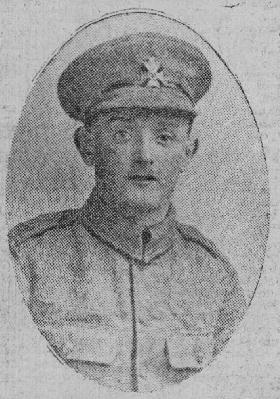
|
George Walter Hemstock was born in Loughborough in 1894 and baptised on 9th May 1894 at Emmanuel Church. He was the second son of George Hemstock and Ada Holwell Hemstock (née Wye) who were married at St. Mary's Church, Wymeswold, on 10th June 1890. George Junior had three brothers John, Arthur and Charles and two sisters Ada and Ellen. Two other brothers Alfred and Frank died young. George Junior's father was a milk seller and the family lived in Bedford Street, Loughborough, firstly at No. 7 and then at No, 22.
In 1911 George Junior was an office boy for Herbert Morris Ltd, lifting gear manufacturers, at the Empress Works in Moor Lane, Loughborough. He also worked at Beeston, Nottinghamshire, and later for a London firm. He was a member of the Emmanuel Church choir and the Church Lads Brigade.
In January 1916 he enlisted in Fulham, London and joined 1/6th Battalion (City of London Rifles) of the London Regiment, a Territorial Force. The London Regiment was the largest infantry regiment in the army with 26 battalions in peacetime, eventually increasing to 88 battalions over the course of the First World War. It was also the only regiment in the army that did not have a regimental badge - each battalion having its own individual cap badge. The 1/6th Battalion had its headquarters in the Farringdon Road, EC1, and was nicknamed as 'The Cast Iron Sixth'.
George became Rifleman 322331. The date on which he was sent to France is unknown as his service papers have not survived but it is likely to have been toward the end of 1916 as in the autumn of 1916 George married Ada Henson, a hosiery factory worker, in Loughborough. On 28th November 1916 the 1/6th Battalion received a draft of reinforcements while they were at Scottish Wood Camp, south-west of Ypres, and another on 24th December. (Scottish Wood Camp was used as a rest and training area between Dickebusch and the front line area at Vormezeele.) A further draft of men arrived in March 1917. George could have been in any of these drafts.
On 8th December 1916 the battalion went into the front line trenches at the Bluff, Zillebeke, where they experienced machine gun fire and sniping from the enemy as well as enemy aircraft surveillance. They moved to the support trenches on 21st December and provided working parties for draining, clearing and repairing the trenches. Relieved on 28th December the battalion marched to Ypres Station and entrained for Dominion Camp, proceeding to Scottish Camp on the 29th. They remained at Scottish Camp until 8th January 1917, practising a new signalling scheme and on wiring drill. The battalion then returned to the support trenches at Hill 60 before moving to the front line on January 14th. Breaks followed at Halifax and Scottish Camps, and at Dickebusch Huts and Canal Reserve Camp for training until 20th February when the battalion returned to the Bluff. Here a successful attack on the enemy took place, but not without more than a few casualties.
At the end of March the battalion was back in the Canal Sector of the Bluff, either in dugouts or in the line. They remained there for the first two weeks of April, the rest of the month being spent at Dominion Camp before a return to the trenches in the Spoil Bank sub-sector, west of Ypres, on 27th April where they were heavily shelled. Relieved on 3rd May the battalion moved to Canal Reserve Camp, Dickebusch, until 12th May when they transferred to Ontario Camp, Rehinghelst, before moving to Acquin for training until 31st May. The battalion's next move was to Ouderdom.
On 3rd June George, aged 23, was killed by a shell at Ouderdom, death being instantaneous. He was buried at the Honourable Artillery Company (H.A.C.) Cemetery, Ecoust-St. Mein, Grave III. C. 12. He is remembered on the memorials in Emmanuel Church and in the former St. Peter's Church building, Loughborough, as well as on the Carillon.
George's brother John served with the 7th Auckland Mounted Rifles of the New Zealand Forces and his brother Arthur with the Sherwood Foresters. Both survived the war. George's widow was remarried in 1927 to Frank G. Pinchien and moved to Manchester.
|
|
|
|
Driver T/260721 Reginald Henman
|
|
2nd Reserve Park, Army Service Corps.
Killed in Action 29th January 1918, Aged 19.
Buried Brandhoek New Military Cemetery, II. O. 1.
|
Reginald Henman was born in Loughborough in 1898 and baptised on 8th August 1900 at All Saints Church, Loughborough. He was the son of Philip Arthur Henman and his wife Ruth (née Giles) who were married at St. Andrew's Church, Prestwold, on 24th October 1892. Reginald's father held a succession of different jobs: in 1891 he was an itinerant telegraph labourer, from 1895 to 1905 he was a builder's clerk in Loughborough and in 1911 he was a shepherd at Rectory Farm, Tansor, Northamptonshire. In Loughborough the Henman family lived at 27 Hartington Street, then at 119 Ratcliff Road, and at some point between 1911 and 1917 moved back to 8 Glebe Street, Loughborough from Tansor. Reginald had two younger brothers Arthur and George and three sisters Ethel, Mary and Marjorie. Three other siblings Philip, James and Dorothy died young.
Reginald was employed at the Empress Works in Loughborough when he enlisted in late 1917. He joined the Army Service Corps as Driver T/260721. The Army Service Corps (ASC), sometimes referred to in a joking, disparaging way as Ally Sloper's Cavalry, were the unsung heroes of the British Army in the Great War. Soldiers could not fight without food, equipment and ammunition. They could not move without horses or vehicles and it was the job of the ASC to provide them. In the Great War, the vast majority of the supply, maintaining a vast army on many fronts, came from Britain. Every bullet, blanket, bandage, artillery battery or tin of bully beef had to be manufactured and transported where and when it was required. By 1918 each Army Division of about 12,000 men needed about 1,000 tons of supplies every day, equivalent to two supply trains each of 50 wagons.
Using horsed and motor vehicles, railways and waterways, the ASC performed prodigious feats of logistics and was one of the great strengths of organisation by which the war was won. At its peak, the ASC numbered 10,547 officers and 315,334 men.
The ASC was organised into units known as Companies, each fulfilling a specific role. Reginald's service number, prefixed with the letter 'T', indicates that he was in horse transport. Most Horse Transport Companies were under orders of Divisions, with four normally being grouped into a Divisional Train. Others were part of the Lines of Communication where they were variously known by subtitles as Auxiliary Supply Companies or Reserve Parks. The ASC Horsed Transport Reserve Parks were in the deep rear behind the battle fronts and handled rations and forage for an Army Division. The drivers usually used heavy draught horses such as Shires or Clydesdales so that their wagons could carry heavier loads.
Getting close to the front was the relatively easy part of the process. The problems really began around seven miles behind the front. Anywhere beyond this point was potentially within range of the devastating effects of long distance artillery shelling.
Reginald was based at 2 Reserve Park at Poperinghe with 30 Company of the ASC. The war diary for the company on the 29th January 1918 includes the following statement 'No T/360721 Dvr Henman R killed in action, one HD [heavy draught] horse killed and two wounded at Bellvue near Wieltje'. Reginald, aged only 19, had been taking food up to the trenches when he was hit by an enemy shell. His body was carried back to Brandhoek for burial in Brandhoek New Military Cemetery Grave II. O. 1.
Reginald had only been in service for four months when he died. He is remembered on the memorial in All Saints Church, Loughborough, and on the Carillon.
|
|
|
|
Private 77957 Frank Henson
|
|
15th Bn, Durham Light Infantry.
Formerly 37553 Leicestershire Regiment.
Killed in Action between 21st and 31st March 1918, Aged 19.
Commemorated Pozières Memorial, Somme, panel 68 - 72.
|
Frank Henson was born in Loughborough on 18th September 1898. He was the son of Edward Stevenson Henson and his wife Clara (née Pickering) who were married at All Saints Church, Loughborough, on 18th June 1898. Frank's father was a machinist in an engineering works and in 1901 the Henson family lived at 9 Rectory Place, Loughborough. By 1911 the family had moved to 19 William Street and in 1916 were living at 15 Falcon Street. Frank had two brothers George and Arthur and a sister Grace. Two other brothers Ernest and Harry died young.
Frank, a fitter, enlisted at Loughborough on 28th August 1916 when he was still only seventeen. He joined the Army Reserve and was mobilised on 22nd February 1917. He was sent to the Depot of the Leicestershire Regiment and, five days later, joined a Training Reserve Battalion of the regiment as Private 37553. Frank's service record has survived but its condition is such that much of it is completely unreadable. Frank's date of transfer to the Durham Light Infantry as Private 77957 and the date when he was sent to France have both been lost. He is known, however, to have committed an unspecified offence at Seaham Harbour, County Durham, on 20th December 1917 and it is likely, therefore, that he was sent to France to join the 15th Battalion of the Durham Light Infantry early in 1918.
In January and early February 1918 the 15th Battalion was in the front line and reserve at Epehy, with training breaks at Saulcourt and Liéramont. From 14th-27th February the battalion was at Haut Allaines for training and inspections. On 1st March, after returning to Liéramont the battalion was in Divisional Reserve, providing working parties until 20th March.
When the Germans opened their Spring Offensive on 21st March the battalion was sent to a position east of Heudicourt and on the way there passed through a gas cloud. From the assembly point the battalion went into the attack amid heavy enemy shelling. The enemy kept up an attack on the following two days and the battalion was forced to withdraw north-west of Templeux-la-Fosse, then to Aixcourt-le-Haut, then to Cléry, and finally north-east of Hem. On 24th March the remnants of the battalion, which had suffered devastating losses, was withdrawn to Suzanne, sent on 25th via Bray to Chipilly and on 27th to Ribemont-sur-Ancre. After two days in reserve at Heilly and Bonnay the battalion moved to Frechencourt on 30th March.
Between 21st and 24th March the battalion lost almost 500 men killed, wounded or missing. Frank, aged 19, was killed in action at some point between 21st and 31st March 1918. His body was never found. He is remembered on the Pozières Memorial, Somme, panels 68-72, and on the Carillon in Loughborough.
Frank's father and mother spent the rest of their lives in Loughborough. By the time they died in 1944 and 1952 respectively, of all their children only their daughter Grace was still alive and she died in 1958.
|
|
|
|
Private 7290 Leonard Henson
|
|
2nd Bn, Coldstream Guards.
Died of Wounds 25th September 1914, Aged 25.
Buried City of Paris Cemetery 6. 21. 28.
|
Leonard Henson was born on 7th August 1889 in Loughborough. He was the son of Frank Henson, a wood labourer, and Ann Henson (née Hopkins) who were married in Loughborough in 1875. Leonard had five older brothers John, Edward, William, Harry and George and two younger sisters Mary and Lilian. In 1891 the family lived at 56 Lower Cambridge Street, Loughborough. By the time Leonard was 10 years old he had sadly lost both his parents, his mother having died in 1898 and his father in 1899.
Leonard was educated at Emmanuel Boys School in Loughborough and at the age of 17, on 11th June 1907, he enlisted, joining the Coldstream Guards as Private 7290. In 1911 he was living at Ramillies Barracks, Aldershot. Sometime between 1911 and 1914 he left the Guards to join the Leicestershire Constabulary, and was stationed at New Swannington. When World War One broke out Leonard joined his old regiment the Coldstream Guards and served with them in the 2nd Battalion, landing at Le Havre, France on 13th August 1914.
Leonard was wounded by a shell on 23rd September 1914 during the Battle of Aisne, tragically dying from his injuries two days later in Claridges Hotel, Paris. Having been brought in on the night of September 23rd the doctor wrote that after being 'very brave and patient, he passed away quietly at half-past four on Friday 25th'.
Private Leonard Henson is buried in the City of Paris Cemetery, Pantin (at the N.E of the city, on the road to Le Bourget), with the grave reference 6.21.28. He is commemorated on the Carillon and at Loughborough Emmanuel Church.
|
|
|
|
Able Seaman Bristol Z/4430 Randall Henson
|
|
63rd Machine Gun Bn, Royal Naval Volunteer Reserve.
Previously 188th Bde, Machine Gun Coy.
Killed in Action 9th April 1918, Aged 19.
Buried Englebelmer Communal Cemetery Ext. B. 17.
|
Randall Henson was born in Loughborough on 9th December 1898. He was the son of James Henson, a house painter, and his wife Ellen (née Chaplin) who were married at Loughborough Register Office on 2nd February 1889. He was one of eleven children, five of whom survived to adulthood. Randall had three brothers James, Ernest and Thomas and one sister Ivy. His brothers William, twin brothers Archibald and Bernard, and sisters Cissy and Florence all died between the ages of one and two. Between 1901 and 1910 the Henson family lived at 12 Pinfold Street, Loughborough.
In June 1910, however, when Randall was eleven, his father, who had sometimes previously behaved in a violent manner. tried to strangle his mother. He also attacked a neighbour, Clara Benson, who had rushed to Ellen Henson's defence when she heard her screaming 'Murder'. Randall's father was remanded in custody in Leicester for a prison doctor's report. Randall's mother left his father and went to live in Duke Street with the children. His father, meanwhile, by the spring of 1911, was in lodgings at 47 Sparrow Hill. His mother later moved to 68 Cambridge Street.
Randall attended the Woodgate Baptist Church. When he left school he started to train as a cabinet maker, but on 11th October 1915 he joined the Royal Naval Volunteer Reserve (RNVR) as Ordinary Seaman Z/4430. He was clearly under age when he enlisted as the birth date he gave on enlistment was false. He pretended he was 19 years old when in fact he was only 16. On enlistment he also said that he was a Baptist and was unable to swim.
On 12th October 1915 Randall was attached to the 6th Battalion of the RNVR and sent to a training depot. On 9th December 1915 he was put on the list of Royal Naval Division Reserves at HMS Victory IX and posted to the 7th Reserve Battalion at Blandford, Dorset, being rated as an Able Seaman. On 16th May 1916 he was transferred to the 2nd Anson Battalion at Blandford and two weeks later transferred again to the 188th Machine Gun Company, 63rd (Royal Naval) Division. Randall was then sent to the Machine Gun Training Centre at Belton Park, Grantham, Lincolnshire.
On 31st July 1916 the 188th Machine Gun Company left Grantham for Southampton and embarked on HMT N. W. Miller. The company arrived at Le Havre on 1st August and spent two days in Rest Camp No. 2. On 3rd August they left by train for Rouen and then entrained again for Barlin, arriving on 4th August. From Barlin they marched via Fosse 10 to billets in Bully-Grenay.
After the officers had inspected the gun positions in the Angres 2 sector three sections of the company took over the guns on 7th August, while the final section remained in billets. On 18th August another emplacement of a gun was arranged. Three days later all guns were withdrawn after the enemy released a gas cloud and also shelled Bully. Some guns were then repositioned. During August there was no daytime firing but indirect fire was carried out most nights on trenches and ration dumps in the enemy lines.
From 1st-18th September rounds were fired by night along enemy communication line trenches and during the day the company worked on improving dugouts, gun positions and trenches. On 19th September the company was withdrawn from the Angres sector and moved to billets at La Comte. From 21st September to 2nd October training, kit inspection and gun cleaning took place. Between 3rd and 5th October the company moved in stages to the Englebelmer area and assembled at huts near Varennes, where training continued until 19th October. Between 20th and 30th October the company was continuously firing in the area of Englebelmer.
In early November the company had a short break at Englebelmer, Puchvillers and Hedauville before returning to operate the guns at Englebelmer. On 13th November, the first day of the Battle of the Ancre, and the night of 13th/14th one section of the company was heavily fired on by hostile machine guns and other guns were also put out of action. In the battle casualties lay in shell holes for up to eight hours.
Randall was one of 55 casualties suffered by the company. He received gunshot wounds in his left shoulder, left knee and left elbow. From No. 4 Casualty Clearing Station he was sent to No. 2 Canadian Stationary Hospital at Outreau, near Boulogne, and was so dangerously ill his mother was informed. He improved, however, and on New Year's Day 1917 was brought to England on the hospital ship Carisbrooke Castle and transferred to the Edinburgh War Hospital, Bangour. Randall was discharged from Bangour at the end of May 1917 and allowed some leave.
On 20th August 1917 Randall reported for duty to the 4th Reserve Battalion (RNVR) and took a trade test at the Woolwich Recruiting Office. On 7th January 1918 he was transferred to No. 5 Depot, Battalion Training Group B, at Grantham. On 2nd March he was posted to France to the Machine Gun Company Base Depot and on 1st April joined the 63rd Machine Gun Battalion in the line near Varennes. He was killed in action, aged 19, on 9th April 1918.
Randall was buried in Englebelmer Communal Cemetery Extension, Grave B. 17. He is remembered on the war memorial from Woodgate Baptist Church, Loughborough, and on the Carillon.
|
|
|
|
Captain Claud Raymond Heygate
|
|
10th Bn, King's Own (Yorkshire Light Infantry)
Killed in Action 1st July 1916, Aged 29.
Buried Gordon Dump Cemetery, Ovilliers-la-Boisselle, Sp. Mem. B.11.
|
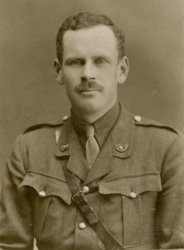 |
Claud Raymond Heygate was born on 27th July 1886 in Edinburgh. He was the son of William Howley Beaumont Heygate and his wife Helen Frances (née Dalglish) who were married on 27th July 1881 at St. Giles Church, Bubbenhall, Warwickshire, by the Reverend E. H. Harrison, Rector, and the Reverend W. E. Beaumont, Rector of Cole Orton, Leicestershire. Claud's grandfather William Unwin Heygate, a prominent Leicestershire politician and Justice of the Peace (JP), owned Roecliffe Manor, an estate in Leicestershire. Claud's father was a Captain in the Royal Artillery and he also held the office of Justice of the Peace for Leicestershire between 1883 and 1890.
Claud had two brothers Gerald and Lionel. In 1891 the Heygate family was living at The Brand, Woodhouse Eaves, Leicestershire, but from at least 1901 to 1911 Claud's parents were based at Mapledene Manor, Woodhouse Eaves.
Claud was educated at Radley College, Oxfordshire, from 1900 to 1904 and was in C Social boarding house. In 1904 he entered the Royal Military Academy, Sandhurst, as a 'Gentleman Cadet'. On 28th August 1906 he received his commission as 2nd Lieutenant in the 1st Battalion of The King's Own (Yorkshire Light Infantry) and went to South Africa. On 26th June 1909 he was promoted to Lieutenant and in 1910 went with the 1st Battalion to Hong Kong. In 1913 the battalion moved to Singapore but whether Claud went to Singapore is unconfirmed.
On 24th January 1914 Claud became engaged to Edith Mary Fox, the youngest daughter of Bohun Henry Chandler Fox, solicitor, and Mrs. Fox, of Maplewell, Woodhouse Eaves. Edith Fox was a well-known member of the Quorn and Lord Harrington's hunts.
At the outbreak of the war Claud was at the depot of the Regiment at Pontefract Barracks, Yorkshire, and went out to France with a draft from Hull in August, 1914, to join the 2nd Battalion. The 2nd Battalion had been recalled from Dublin and landed at Le Havre on 16th August.
On 18th August the battalion moved by train to Amiens and proceeded via Busigny to Maroilles. On 21st August the battalion formed the advance guard of the 13th Infantry Brigade and marched to Houdain. Two companies then went into the outpost line west of Riez de l'Erelle. On 22nd August the battalion moved into support at Boussu and on 24th August via Wasmes and Bavay to Le Cateau where they bivouacked.
On 26th August the battalion took part in the Battle of Le Cateau and suffered 600 casualties. By 4.00pm the whole Division was in retreat to just beyond the St. Quentin Canal. Between 27th August and 5th September the battalion was ordered to retreat via Noyon, Jaulzy, Crépy, Cuisy and Cuilly to Tournon-en-Brie. The retreat ended on 6th September and the battalion was ordered to advance to Buissy and to engage the enemy whenever encountered.
What followed was the First Battle of the Marne, a victory for the Allies after which the German Army was forced into retreat. On 9th September the battalion was ordered to cross the Marne at Saâcy and on the 10th September to occupy Montreuil. Having lost their way to Montreuil the battalion continued to pursue the enemy over the next two days via Gandelu, Chézy-en-Orxois, Hartennes-en-Taux and Cuiry. The enemy was then found to have taken up a very strong position to cover their retreat over the River Aisne and it was impossible to proceed further than the crossroads east of Serches.
On 13th September the Battle of the Aisne began. The battalion was ordered to seize Missy Bridge and they advanced through considerable shellfire to cross on 24th September. They remained at Missy until the end of September, attempting to establish the exact formation of the enemy. On 30th September Lieutenants Heygate and Nunnely went out at 3.00am to the Chateau and captured some prisoners.
During the first two weeks of October the battalion marched via Vasseny, Violaine, Hartennes, Lagny and Fresnoy to Verberie, where they entrained for Abbeville. From Abbeville they marched via Gueschart to Haravesnes and from there moved by bus to Valhuon before marching to Vaudricourt and Verquin. On 12th October they went into reserve at Annequin.
On 14th October the battalion cooperated with the French in an attack on Vermelles and then went into billets at Le Hamel. On 16th and 17th October they moved via Richebourg l'Avoué to the trenches facing Lannoy. On 18th, in an attack on Chateau Wood, the battalion was fired on and shelled causing 99 casualties. On 20th and 21st October the battalion moved to south-west of Neuve Chapelle and was ordered to occupy the line at Lorgies early on the 22nd October.
It was about this time that Claud received gunshot wounds to both legs. He was brought back to England and admitted to Queen Alexandra's Military Hospital, Millbank, London, on 25th October. He was discharged to 17 Park Lane, London, on 3rd November and not long afterwards promoted to Captain.
Claud was not sent back to France until June 1916. On 16th June 1916 Claud joined the 10th Battalion of the King's Own Yorkshire Light Infantry at La Neuville. On 19th June the battalion moved to Buire for working parties there and at Ribemont. On 30th June they moved up to the assembly trenches in preparation for the start of the Somme Offensive.
Claud, aged 29, was killed in action at Fricourt on 1st July 1916, the first day of the Somme. He is believed to have been buried at Gordon Dump Cemetery, Ovilliers-la-Boisselle, Sp. Mem. B.11. Claud is commemorated on the memorial at St. Paul's Church, Woodhouse Eaves, and on the memorial at Radley College.
Both Claud's brothers were also career soldiers and survived the war. Lieutenant Colonel Gerald Heygate served with the Royal Field Artillery and was awarded the D.S.O. in 1918. Major Lionel Heygate served with the Duke of Cornwall's Light Infantry. He was wounded in May 1916. In 1929 he became Aide-de-Camp to the Governor and Commander-in-Chief of the Gold Coast. Claud's father also served in WW1 between 1914 and 1916 and gained the rank of Honorary Major.
Claud's fiancée Edith Mary Fox died in April 1917 and was buried at Woodhouse Eaves.
|
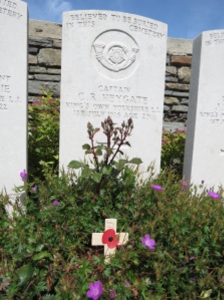 |
|
Able Seaman Bristol Z/4047 Cyril Norman Hicklin
|
|
Drake Bn, R.N. Div, Royal Navy Volunteer Reserve.
Killed in Action 21st August 1918, Aged 21.
Commemorated Vis-en-Artois Memorial, panel 1 & 2.
|
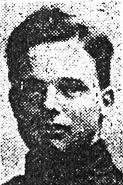
|
|
Cyril Norman Hicklin was born in Diseworth, Leicestershire, on 29th September 1896 and baptised on 1st November 1896 at the Church of St. Michael and All Angels, Diseworth. He was the son of William Hicklin and his wife Mary Jane (née Wheatley) who were married on 9th February 1892 at St. Michael and All Angels Church. Cyril had a brother William, who died aged five in 1898, and a sister Dorothy. Another sister Phyllis died in infancy in 1900. In 1901 the family lived at Hall Gate, Diseworth, but by 1911 had moved to 25 Queen Street, Loughborough.
Cyril's father was a farm labourer in 1892, a platelayer for the Midland Railway in 1896 and a horseman on a farm in 1901. In 1910 his father, who was previously of good character, was given six months' probation at the Loughborough Petty Sessions Court for stealing a quart of beer from Frank Dakin, farmer of Castle Donington. The court also advised him to become a teetotaller. Cyril's parents do not appear to have stayed together after this date and Cyril's mother and sister supported themselves by being a hosiery embroideresses. In 1911 Cyril was employed as a brickmaker and by 1915 he had progressed to bricklaying. During the war years Cyril's mother and sister lived at 41 Woodgate.
Cyril joined the Royal Naval Volunteer Reserve (RNVR) as Ordinary Seaman Z/4047 on 4th August 1915. He gave his religion as Church of England and stated that he was able to swim. After four days at the Crystal Palace Depot 1 for initial training he was attached to the 6th Battalion and sent to a training depot. On 27th September 1915 Cyril was put on the list of Royal Naval Division (RND) Reserves and posted to the 1st Reserve Battalion at Blandford, Dorset. The 1st and 2nd Reserve Battalions RND were formed at the Blandford Depot after the RND had departed to the Mediterranean Expeditionary Force in sprlng 1915. They provided reinforcement drafts to the eight RND battalions in the field.
On 5th December 1915 Cyril was drafted to Drake Battalion which in December 1915 was in the area of Gallipoli. He joined Drake Battalion for duty at Mudros, Greece, on 10th January 1916. He arrived just at the point when it had been judged necessary to establish semi-permanent garrisons on the Greek islands of Tenedos, Imbros and Mudros. Drake Battalion was sent to Imbros, operating under the HQ of 1st Royal Naval Brigade, and spent the next few months on police work and training.
In April 1916, the authorities decided to bring the troops of the Royal Naval Division back to France, and at the same time command of the Division was transferred from the Admiralty to the War Office, being redesignated as the 63rd (Royal Naval) Division on 19 July 1916.
Cyril embarked on the HT Minnewaska on 15th May 1916 and arrived at Marseilles on 20th May. The battalion moved by train to the Somme and concentrated with the Royal Naval Division at Abbeville. Stores and equipment were issued and necessary reorganisation took place. In mid-June the battalion moved north-west of Arras for training which included preliminary tours of duty in the trenches in the Souchez sub-sector. Once the battalion had reached the accepted standard it moved to Ablain St. Nazaire and occupied trenches on the Lorette Ridge until the end of July.
Further trench tours followed until 14th August when the battalion marched to Aix Noulette Wood for working parties until 18th August. Over the next four weeks the battalion completed four more trench tours during which they were bombarded by the enemy and on the receiving end of a gas attack. Cyril missed one of the trench tours as he had been hospitalised for a week with an abscess.
On 18th September the battalion began a move via Bouvigny Wood to Frévillers for training there and at Forceville until 7th October. On 8th October the battalion marched to Englebelmer for two weeks of working parties digging, making gun emplacements and carrying ammunition, both at Englebelmer and Mesnil. After a trench tour in the Hamel sector between 27th and 30th October they marched to Puchevillers for five days training.
After a return to Englebelmer for working parties the battalion moved into the front-line trenches in the Hamel sector in preparation for an attack on Beaucourt-sur-l'Ancre. On 13th and 14th November, while in the support position during the capture of the village, the battalion suffered 202 casualties.
After the battle the battalion marched back to Hédauville and were taken by lorry to Arquèves. Over the next six days they moved via Doullens, Candas and Hautvillers to St. Quentin. Here and at Le Crotoy they underwent strict all-round training until 12th January 1917. On 18th January the battalion was back in the trenches in the Beaucourt sub-sector of Hamel and took part the Operations on the Ancre. January ended with training and working parties at Forceville.
In early February the battalion, while in the Beaucourt sub-sector, suffered heavy casualties from enemy shelling. After five days in reserve and occupied with working and carrying parties the battalion moved to Spring Garden Camp near Ovillers to work on railway extensions. On 19th March they began a seven day move via Warloy, Nunq and Bours to Vendin-lèz-Béthune for training and working parties until 7th April. On 8th April they marched to Houchin and on 11th went into the line at Frévillers. Two days later they marched to Ecoivres and into close support at the Pont du Jour.
Between 16th and 22nd April, while the battalion was working on the Arras-Bailleul and Arras-Gavrelle roads, preparations were taking place for an offensive in the area of the Scarpe and Gavrelle. Drake Battalion advanced into the attack on 23rd April and Gavrelle was successfully captured but at the cost of 303 casualties. Cyril was one of the casualties, with severe gunshot wounds to his legs.
Cyril was admitted to No. 14 General Hospital at Wimereux on 25th April but swiftly transported back to England on the hospital ship HS St. Patrick and taken to the Norfolk War Hospital, Thorpe, Norwich. His mother was able to visit him there and reported that he was making very good progress. After some time at a convalescent hospital at Bedford and a period of leave Cyril reported to Blandford. On 19th November 1917 he was drafted back to Drake Battalion from the 2nd Reserve Battalion at Blandford.
On 21st November Cyril left Folkestone for France, spent four days at a Base Depot in Calais, and rejoined the Drakes on 25th November at Broxeele, twelve miles south of Dunkerque. During December the battalion was inspected at Road Camp, in training at Haplincourt, in Brigade support at Couillet Wood, near Metz-en-Couture, and repairing trenches at Highland Ridge.
On 6th January 1918 Cyril was taken to the 149th Field Ambulance and on the next day admitted to No. 5 General Hospital, Rouen, with trench foot. On 12th January he was invalided home and admitted to Regent's Park Hospital, Millbrook, Southampton. After treatment he rejoined the 2nd Reserve Battalion at Aldershot and on 17th June was drafted back to Drake Battalion. On 19th June he arrived at an Infantry Base Depot in Calais. He rejoined the Drakes again on 14th July at Auchonvillers.
After one trench tour Cyril moved with the battalion to Puchvillers and then Béhencourt for practice in attacks. Between 14th and 20th August the battalion moved via Sarton, Vauchelles and Souastre into a position north-west of Bucquoy. In the offensive which opened on 21st August 1918 good progress was made until the battalion reached Logeast Wood when enemy machine guns opened fire. Cyril, aged 21, was killed in action. By the time he died he had been promoted to the rank of Able Seaman.
Cyril's body was never found and he is commemorated on the Vis-en-Artois Memorial, Panel 1 and 2.
|
|
|
|
Private 40405 Arnold Hickling
|
|
1/5th Bn, Prince of Wales's (North Staffordshire) Regiment.
Formerly 65899 Sherwood Foresters (Notts & Derby) Regiment.
Killed in Action 21st March 1918, Aged 19.
Commemorated Arras Memorial, bay 7 & 8.
|
|
Arnold Hickling was born in Loughborough in 1898. He was the son of Robert Septimus Hickling, a blacksmith, and his wife Eliza (née Fogg) who were married at St. Mary's Church, Wymeswold, on 22nd September 1895. Arnold had five brothers Arthur, Henry, Frederick and twins Archibald and Reginald. Another sibling died in infancy. In 1901 the Hickling family lived at 38 Empress Road, Loughborough, but in around 1903 they moved to Burton on Trent, and about two years later to Bulwell in Nottinghamshire. In 1907 they were living at Radford but after Arnold's father died in 1909 they moved again to 46 Clapham Street, Nottingham, and in 1911 Arnold was employed as an errand boy for a wholesale grocer.
Arnold enlisted towards the end of 1916 and joined the Sherwood Foresters (Notts & Derby) Regiment as Private 65899. His service record has not survived and it is not known when he was sent to France. He was, however, transferred at some point to the 2/5th Battalion of the Prince of Wales's (North Staffordshire) Regiment and joined them as Private 40405. The 2/5th Battalion received reinforcements of Ordinary Rank soldiers in August and October 1917 and it is likely that Arnold joined the battalion with one of these batches.
In August 1917 the battalion was at Barastre and then Forceville for training. On 31st August they entrained at Aveluy for Hopoutre and marched to Winnizeele where training continued until 19th September. The battalion then went by bus to Derby Camp, Brandhoek, moved forward to Ypres North and on 25th September went into Capricorn trenches ready to attack. The attack cost the battalion 149 casualties and on 28th they moved back to Vlamertinghe before proceeding by bus to the Watou area on 29th. On 1st October they transferred by lorry to Guarbecque for inspections and training. On 7th October they moved on to Crépy, and on 10th October by bus to Hersin and marched to Fosse 10, Sains-en-Gohelle. After proceeding to Noulette two days later the battalion went into the front trenches at Liévin and Lens to hold the line until 21st October.
On 29th October, after eight days in support at Liévin the battalion took the light railway from Red Mill Siding for Gouy-Servins where they were billeted in the chateau and adjoining huts for training. On 6th November they returned by light railway to Red Trench and held the front at La Culotte for six days. On 16th, after three days in support and providing working and carrying parties, the battalion began a six-day transfer by march and train to Heudicourt. This was in preparation for an attack near Ribecourt, south of Bourlon Wood. On 30th November the attack took place and resulted in 54 Ordinary rank casualties.
The following month included digging defences at Flesquières, and work at Trescault before the battalion marched to Barastre for a four day break on 20th December. On Christmas Day they entrained at Bapaume station for Frevent and marched to Liencourt. Here the battalion remained until the end of January 1918 in training, with tactical exercises and bombing attack practice.
On 6th February 1918 the 2/5th Battalion of the North Staffordshire Regiment was absorbed into the 1/5th Battalion, and ceased to exist. The war diary of the 1/5th Battalion for early 1918 has unfortunately not survived but the diary of the Army's 59th (2nd North Midland) Division, of which the1/5th Battalion was part, gives some indication of the battalion's movements.
On 8th February the 1/5th Battalion moved from Liencourt to Bienvillers, and on the following day to Belfast Camp, Mory. On 11th February the 59th Division took over the front line at Bullecourt, with HQ being established at Behagnies. On the night of 16th/17th February the 1/5th Battalion moved up to the front line and remained there until the end of the month when they moved into Reserve and provided working parties strengthening the line for defence against expected enemy attack. The battalion returned to the front line from 5th until 10th March before a brief interlude at Mory.
The entire Division was now on high alert and on 21st March, the first day of the Battle of St. Quentin, the enemy opened a very heavy barrage along the entire front. On that day the Division suffered 1753 casualties and Arnold, aged 19, was one of those killed.
Arnold is remembered on the Arras Memorial, Bay 7 and 8.
|
|
|
|
Gunner 113326 John Thomas Hickling
|
|
60th Siege Bty, Royal Garrison Artillery.
Died of Wounds 4th June 1917, Aged 34.
Buried Noeux-Les-Mines Communal Cemetery, I. T. 15.
|
John Thomas Hickling was born in Wymeswold in 1882. He was the son of William Hickling and his wife Caroline (née Bishop and known as 'Carrie') who were married at St. Mary's Church, Wymeswold, on 27th November 1873. John's father was initially a labourer but by 1891 he had become a framework knitter and had moved his wife and family to 36 Russell Street, Loughborough. He then progressed to being a hosiery machine moulder and caster framesmith. John had one sister Sarah and one brother George; another sister Hannah had died under the age of one. John's parents later moved to 45 Cobden Street.
By 1901 John, aged 18, was working as a printer compositor for the Loughborough Echo printing works. By 1911 he had left Loughborough and was working as a printer in Stamford, Lincolnshire, and lodging at the home of Agnes Shaw Swanson, a widowed music teacher, in 17 Recreation Road, Stamford. On 26th December 1914 he married Clara Yates at St. Michael's Church, Stamford. John and Clara set up home at 19 Vine Street, Stamford, later moving to 6 Conduit Street.
John attested at Stamford on 10th December 1915. He was mobilised on 8th August 1916 and joined the Royal Garrison Artillery as Gunner 13326. He was undergoing training at No. 2 heavy and Siege Depot at Gosport, Hampshire, when his daughter Irene was born in Stamford on 10th November 1916.
John was posted to France on 8th March 1917 and from the base there was sent to join the 60th Siege Battery on 18th March. Siege Batteries were equipped with heavy howitzers, sending large calibre high explosive shells in high trajectory, plunging fire. The usual armaments were 6 inch, 8 inch and 9.2 inch howitzers, although some had huge railway- or road-mounted 12 inch howitzers. As British artillery tactics developed, the Siege Batteries were most often employed in destroying or neutralising the enemy artillery, as well as putting destructive fire down on strongpoints, dumps, store, roads and railways behind enemy lines.
Just under three months later on 4th June 1917 John died of wounds received in action in the area of Sailly-Labourse, south of Béthune. He was aged 34. His Major, writing to John's wife said: 'Gunner Hickling was a good soldier, much liked by all of us, and he is worthily numbered among the heroes who died for their country's service'.
John was buried in Noeux-Les-Mines Communal Cemetery, Grave I. T. 15.
|
|
|
|
Sergeant 11450 John Henry (Harry) Hill
|
|
2nd Bn, Leicestershire Regiment.
Killed in Action 13th January 1916, Aged 33.
Commemorated Basra Memorial Iraq, panel 12.
|
Registered at birth as Henry Hill but usually known as Harry, he was born in Loughborough in 1883, the youngest child and only son of John Henry Hill, an iron moulder and his wife Ellen (née Sewell). Harry's parents were married in Leicester in 1871.
Harry had four older sisters: Mary Ann, Christiana, Elizabeth and Caroline. In 1881 the family lived at 12 Rectory Place, Loughborough, but by 1891 they had moved to 33 Canal Bank, Bridge Street. His mother was widowed by 1901 but she stayed living at 33 Canal Bank with her two youngest daughters Elizabeth and Caroline and worked as a charwoman. She later moved to 7 Holland Street, Loughborough.
Harry Hill, who was a general labourer, married Emma Fallows at Loughborough Parish Church on 25th August 1906, but there do not appear to have been any children from this marriage. When war broke out in 1914 Harry and Emma were living at 4 Chapel Square, Nuneaton, Warwickshire, but after Harry enlisted his wife moved to 17 Derby Square, Loughborough.
In 1914 Harry was 32 years old and his army medical records reveal that he was just over 5ft 9in tall, and had blue eyes and brown hair. He had already been with the 3rd Leicestershire Territorial Battalion for a year and, as an Army Special Reservist, had received call-up papers at the start of the war. He reenlisted at Leicester on 7th August 1914 under his father's name of 'John Henry Hill' rather than his own official name of 'Henry Hill' and was sent immediately with the rank of Private 11450 to the regiment's Leicester Depot for recruits' training. On 12th August 1914 he was appointed a paid Lance Corporal with the 3rd Battalion of the Leicestershire Regiment and was posted on the following day to Portsmouth. On 14th September 1914 he was promoted to Corporal and appointed Acting Sergeant. On 9th November 1914 he was promoted to Sergeant and posted to the 1st Battalion of the Leicestershire Regiment which was already in Flanders. He joined the battalion which was fighting at the 1st Battle of Ypres.
On 13th February 1915 Harry was reposted to the 2nd Battalion of the Leicestershire Regiment. In 1915 the 2nd Battalion of the Leicesters, part of an Indian Army formation led by Major General Charles Blackader, took part in the Battles of Neuve Chapelle (10th-13th March) and Aubers Ridge (9th May), the first day of the Battle of Festubert. The 2nd Leicesters spent the next couple of months alternately in the trenches or in billets while war training, in the area of Calonne and Vieille Chapelle north-east of Bethune. The corps was then rested in a quiet sector before being deployed for the Battle of Loos.
The initial attack at Loos was made by three divisions, with the Meerut Division leading the attack on the Indian Front. Blackader's brigade, with two Gurkha battalions and the 2nd Leicesters was on its right flank. Whilst the attack successfully crossed no-man's land under cover of the barrage, the right flank of the brigade was caught up in defensive wire and only one battalion successfully made its way into the German trenches. Gas also affected some of the men and the smoke caused a dense fog, making direction difficult. Harry was fortunate to survive the initial attack at the Battle of Loos on 25th September 1915 - from his battalion 72 men were killed, 217 were wounded, 42 were gassed and 96 were recorded as missing.
The 2nd Battalion was rather depleted after the Battle of Loos, but was ordered to the Persian Gulf where Britain was fighting Turkish forces allied to the Germans. On 5th December 1915 Harry embarked at Marseilles and arrived at Basra on 31st December 1915. From there he travelled by boat up the River Tigris to Ali Gharbi, 150 miles south-east of Baghdad.
In Mesopotamia General Townshend and his troops were under siege at Kut. On January 4th 1916 General Aylmer's leading troops, under Major General Younghusband, began to advance from Ali Gharbi towards Sheikh Sa'ad, with the intention of relieving General Townshend at Kut.
The Turkish commander Nur-Ur-Din had, however, effectively blocked any progress by placing approximately 22,500 troops and 72 guns on both banks of the Tigris at Sheikh Sa'ad, about 16 miles downstream from Kut. General Aylmer therefore ordered an attack on the enemy and very heavy fighting ensued on 7th January at the Battle of Sheikh Sa'ad.
On January 9th, the Turks were forced to abandon their remaining positions and retired upstream, followed by Major General Younghusband's force. Heavy rain now fell, however, making the alluvial soil of the roads almost impassable, and prevented active operations for the next two days.
The enemy fell back about ten miles, to the Wadi - a tributary which joins the Tigris on the left bank. They took up a new position behind the Wadi and on the right bank of the Tigris, opposite the mouth of the Wadi. General Aylmer concentrated his whole force on the left bank and attacked the Wadi position on the 13th. Harry had only just joined his battalion in the field on 11th January 1916. Two days later he was killed in action.
Harry was awarded the 15 Star, British War and Victory Medals. He is remembered on the Basra War Memorial, Iraq, Panel 12 and on the Holy Trinity Church War Memorial, Loughborough, as well as on the Carillon.
|
|
|
|
Private 13421 John Samuel Hill
|
|
13th Bn., Canadian Mounted Rifles.
Died of appendicitis 19th March 1915, Aged 41.
Buried Lethbridge (St Augustine's) Cemetery, Canada, 17. 13 . G. 3.
|
John Samuel Hill was born in Queniborough, Leicestershire, in 1874. He was the son of Edward Henry Hill and his wife Mary Ann (née Whittle) who were married at St. Mary's Church, Queniborough, on 4th March 1872. John had one sister Eliza. In 1881 the Hill family lived in Barkby Road, Syston, but by 1891 had moved to 18 New King Street, Loughborough. Ten years later they were living at 31 Wellington Street, Loughborough. John's father was originally a farm labourer but by 1901 he was employed as a carter by Loughborough Corporation.
John became a carpenter and joiner and he married Kate Clarke at All Saints Church, Loughborough, on 23rd November 1901. By 1911 John and Kate were living at 50 Granville Street, Loughborough, and they had two children Thomas and Mabel.
John's mother died in 1911 and on 14th April 1911 John sailed from Liverpool to Halifax, Nova Scotia, Canada, on the SS Tunisian. From Halifax he travelled to Lethbridge, Alberta. Just over one year later John's wife Kate and the children travelled to Canada to join him at 619, 6th Street, Lethbridge.
When war broke out John enlisted for the Canadian Expeditionary Force. He joined the 13th Battalion of the Canadian Mounted Rifles as Private 13421. On 15th March 1915, however, he was taken ill with appendicitis and was admitted to hospital in Cardston, Alberta, where he underwent an operation on the following day. John died in hospital on 19th March 1915, aged 41.
John was buried in St. Augustine's Cemetery, Lethbridge, Grave 17. 13. G3.
John is remembered on the Canadian Virtual War Memorial and on the memorial in Lethbridge, Alberta.
After her husband's death John's widow Kate moved to Suite 8, Logan Block, Corner of Logan & Sherbrooke Street, Winnipeg, Manitoba. By 1921 she was living at 987 Sherbrooke Street, Winnipeg. She died in 1938 and was buried in Elmwood Cemetery, Winnipeg.
|
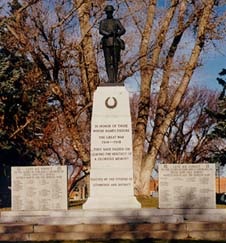
War Memorial,
Lethbridge, Alberta.
|
|
Private 46441 Harold Hipkins
|
|
15th Bn, Durham Light Infantry.
Previously served as 3987 Leicestershire Regiment
Killed in Action 15th August 1918, Aged 18.
Commemorated Vis-en-Artois Memorial, panel 9.
|
Harold Hipkins was born in West Bromwich, Staffordshire, in the autumn of 1899. He was the son of Benjamin Hipkins, an iron moulder, and his wife Mary Jane (née Morris) who were married at Holy Trinity Church, West Bromwich, on Christmas Day 1890. Harold had five brothers Percy, Albert, Benjamin, James and Bernard and four sisters Edith, Annie, Amy and Ivy. Another brother Wilfred died in infancy. In 1901 the family lived at 92 Glover Street, West Bromwich, but in August 1910 they moved to Meadow Lane, Loughborough, and in 1911 were living at 74 Howard Street. The family later moved to 35 Boyer Street.
In 1910 Harold's father was summoned by Loughborough magistrates for not sending one of his sons regularly to school. Whether or not the son was Harold is unknown but given Harold's later record for disappearing it is possible that he was the truant son. When Harold left school he became a riveter.
On 12th April 1915, when Harold was fifteen years old, he attested for the Territorial Army and joined the 3/5th Battalion of the Leicestershire Regiment as Private 3987. By 8th April 1916 this battalion had become the 5th (Reserve) Battalion and was at Grantham. On 1st September 1916 it became part of the 4th (Reserve) Battalion which later moved to Catterick and on to North Coates and Louth.
On 8th July 1917 Harold attested for the Regular Army and on 8th August 1917 was sent to the 87th Training Reserve Battalion with the service number of Private TR/5/71951, having been automatically discharged from the Territorial Force. In September and November 1917, while at Scotton Camp, Yorkshire, Harold was twice in trouble, firstly for overstaying leave and secondly for failing to report to Headquarters at the appointed time while he was a Cyclist Orderly.
On 8th December 1917 Harold was transferred to the 53rd Young Soldiers Battalion of the Durham Light Infantry and sent to Rugeley Camp, Staffordshire. Between 22nd December 1917 and 2nd March 1918, while at Rugeley, Harold was reprimanded three times for being absent from tattoo roll call.
On 5th February 1918 Harold attested for the Regular Army at Rugeley and on 8th March 1918 he was transferred to the 52nd (Graduated) Battalion of the Durham Light Infantry. By this time he had a tattoo of 'Master and Piggie' on his left arm. On 2nd April 1918, while at Stockton on Tees Harold was again punished for being absent without leave and missing parades. On 29th May 1918, while at Guisborough, Yorkshire, he overstayed his permitted leave.
On 11th June 1918 Harold proceeded overseas from Guisborough, embarking at Folkestone for Boulogne on 12th June. On 14th June 1918 Harold arrived at No. 9 Infantry Depot in Etaples and three days later was posted to the 15th Battalion of the Durham Light Infantry as Private 46441.
Harold joined the 15th battalion on 18th June at Villers-Campsart, Somme. Two days later he was admitted to No. 97 Field Ambulance with diarrhoea. He rejoined the battalion at Monchaux-Soreng on 24th June. The battalion remained there training until the end of the month. On 1st July they marched to Blangy and entrained for Puchevillers for training and sports until 24th July.
On 25th July the battalion went by bus to Acheux to relieve Drake Battalion in the Mailly sector. Here they held the front line until the night of the 1st August. After eight days in reserve for additional training the battalion returned to the front line on 9th August. Harold, aged 18, was killed in action on 15th August 1918.
Harold is commemorated on the Vis-en-Artois Memorial, Panel 9.
Harold's brother Albert served with the Staffordshire Regiment and survived the war.
|
|
|
|
Private 14061 Ernest (Dick) Hitherley
|
|
10th Bn, Leicestershire Regiment.
Died at Home 2nd March 1916, Aged 42.
Buried Loughborough Cemetery Grave 14/236
(Ernest Hitherley's nephew John Albert Hitherley also fell See below)
|
Ernest Hitherley (or Hitherly) was born in 1873, the youngest of thirteen children of John Hitherley (or Hitherly), a bricklayer's labourer, and his wife Eliza (née North) of Wellington Street, Loughborough. His parents were married in Loughborough in 1846. Ernest seems to have been known to his family and friends as 'Dick Hitherley'.
When he was five Dick had an unfortunate accident, which was reported in the Nottingham Evening Post (16th January 1879) as follows:
'Accident to a child at Loughborough - On Tuesday last an accident of a serious nature occurred to a child aged five years, named Ernest Hitherley. The child's parents live in Wellington Street and on the morning named he went downstairs unknown to his mother and went and stood against the fire with nothing on but his night shirt. The result was that a piece of burning wood fell out of the grate and set the shirt on fire. The child at once cried out and the mother immediately ran down and with difficulty extinguished the flames. Not, however, before the unfortunate little fellow had received severe injuries in the right thigh and hand and he had to be conveyed to the Dispensary, where he now lies.'
Dick fortunately recovered apart from some scarring and grew up to become a labourer. When he was nineteen and living at 77 Pinfold Gate he was fined at Loughborough Police Court for being drunk and disorderly in Pinfold Gate. After that date there is no record of him until September 1914. When war broke out he enlisted and joined the Leicestershire Regiment as Private 14061. Ernest did not give his official forename when he enlisted but gave his name as 'Dick Hitherley'. He also concealed his true age at the time (he was 40, not 33 as he stated).
On 5th September 1914 Dick was sent to the Leicestershire Regiment Depot, and on 24th September he joined the 8th Service Battalion at Bramley, near Leeds. He was transferred to the 10th Leicestershire Regiment at Castle Barnard, County Durham, on 12th June 1915. He was discharged from the Army on 28th January 1916 at Rugeley Camp, Cannock Chase, Staffordshire as 'no longer physically fit for war service'. On discharge he intended to reside at 9 Mills Yard, Loughborough. The medical report on discharge stated that he was suffering from 'tuberculosis of the lung' and was no longer able to work. He had suffered from bronchitis during the winter of 1910-11 'and the cough had never completely left him. The cough has got steadily worse since he arrived at Barnard Castle in July [sic] 1915. He is rapidly losing flesh'. His discharge papers also included a note testifying to his good character.
Dick died in Loughborough at the beginning of March. On 9th March 1916 the Loughborough Echo printed a brief report of his funeral:
'MILITARY FUNERAL,
The death took place last Thursday of Private Richard Hitherley, of the 10th Leicesters, aged 38. Deceased enlisted in September, 1914, and in January was discharged owing to ill-health. He returned to his relatives in Mills-yard, Woodgate, where he died. The funeral was on Saturday, and was attended by bearer and firing parties from Glen Parva Barracks.'
The reporter from the Echo, having heard the deceased referred to as 'Dick' must have wrongly assumed that his official forename was 'Richard'.
|
|
|
Ernest Hitherley
Has no memorial on his grave.
|
|
Lance Corporal 27967 John Albert Hitherley
|
|
12th Bn and 2/6th Bn, Sherwood Foresters (Notts & Derby Regiment)
Missing, presumed dead 21st March 1918, Aged 29.
Commemorated Arras Memorial, bay 7.
(John Albert Hitherley's uncle Ernest Hitherley also died See above)
|
John Albert Hitherley, usually known as 'Albert Hitherley' was born in Loughborough in 1889. He is likely to have been the natural son of Lizzie Bertha (otherwise known as Elizabeth or Eliza) Hitherley, a hosiery joiner. Albert had a half-brother, Walter Lawrence L. Hitherley (usually known as 'Lawrence Hitherley') ten years younger than himself.
In 1901 Albert and Lawrence were living with their widowed grandmother Eliza Hitherley and her unmarried daughter Elizabeth at 8 Market Street, Loughborough. Elizabeth died, aged 36, at Court C, Pinfold Gate, in 1902 and in 1904 Albert and Lawrence's grandmother Eliza also died.
Ten years later Albert had become a tile maker for a brick manufacturer's and was lodging at 86 Russell Street, Loughborough, while Lawrence was living with his aunt Mrs. Catherine Wakerley and her husband John and family at 62 Russell Street. In March 1914 Albert, now a labourer, confessed to police that he had set fire to a waggon containing hay at Mr. W. B. Smith's farmyard in Meadow Lane, Loughborough, and was sent for trial at the Quarter Sessions. He said that he had committed the crime because he had 'no money and nowhere to go' and did not want 'to sleep rough'. On 21st March 1914 he was sentenced to twelve months hard labour.
Albert served his punishment term and towards the end of 1915 enlisted as 'Albert Hitherley' (rather than 'John Albert Hitherley') with the 12th (Service) Battalion (Pioneers) of the Sherwood Foresters (Notts & Derby Regiment) as Private 27967. Pioneer battalions were used for various types of labouring work including deepening trenches, clearing out drains, digging tunnels and cable-laying. They underwent basic military training including firearms, but were also supplied with the necessary additional tools required for the work they were assigned to do in the field as Pioneers.
No records have survived detailing exactly when Albert was sent to France or when he was posted from 12th Battalion to the 2/6th Battalion. If he was initially sent to France to join the 12th Battalion he is likely to have been in a draft of reinforcements which arrived on 20th March 1916 when the battalion was working in the Ypres area, digging tunnels.
On 23rd March the 12th Battalion moved to Godewaersvelde for inspections and training until 29th March when they marched via Fietre, Meteren and Bailleul to Aldershot Huts. The battalion was based here until 21st June improving the trench lines and completing road repairs. The next four weeks were based at Locrehof Farm and July ended with six days training at Camps-en-Amiénois. The battalion then went by bus to Picquigny, entrained for Méricourt l'Abbé and marched to the Citadel at Morlancourt. From here the battalion worked on trench and tunnel digging and wiring in the areas of Trônes and Bernafay Woods, and Guillemont Station. On 27th August the battalion moved to a camp near Heilly for a break before marching to a camp near Fricourt on 30th. From here they worked on the Pommiers Redoubt and Crucifix Alley, repaired the road near Montauban and dug new ground at Delville Wood.
On 14th September the battalion moved to a camp near Méaulte. Three days later they travelled by bus from Buire to Pont-Remy, entrained for Pernes-Camblain and marched to billets in Ferfay.
Training and physical drill took place until 25th September when the battalion moved on to Villers-au-Bois to work on the railway in the Zouave valley. On 28th October the battalion transferred to Loos to work on the defences there, amid shelling, gas alerts and some bombardment.
The battalion remained at Loos until 14th February 1917 when it moved to Allouagne (west of Béthune) for a period of training in trench digging, bombing, musketry and bayonet fighting. On March 10th the battalion marched via Sains-en-Gohelle to Fosse 10 to clean and deepen trenches there and at St. Aubin. Nearly every day there were casualties and gas attacks were a constant threat. At the beginning of May work began at Roclincourt. This was followed by a break at Papotte prior to a move to Steenvoorde on 12th and to Ouderdom two days later for more trench work, camouflage construction, filling of shell holes in roads and unloading of ammunition.
In early June work continued at Ouderdom and also at Reninghelst and then in the area of North Camp near the Scottish Lines. From 17th- 29th June the battalion was based at Sherwood Park Camp near Ouderdom and worked amid some heavy enemy shelling, incurring a growing number of casualties. On 30th June the battalion entrained at Reninghelst for Lottinghem, where the men rested.
On 8th July the battalion moved on to Lumbres and from here on 11th July half of the battalion went to Sherwood Park Camp, for training and the other half to Dickebusch for work on Vormezeele track. The two groups joined up again on 18th July at Sherwood Park Camp and repair work continued in the area until 16th September when the battalion moved by bus to the Merris area and camped in a field to the south of the main road from Strazeele to Pradelles.
Training took place until 20th September when the battalion entrained at Caestre for Miraumont and marched to Barastre. After erecting Nissen huts and accommodation for horses the battalion moved to a camp half way between Moislains and Haut Allaines and then by lorry to Roisel. Here they worked at Templeux quarries, dug new trenches and erected more Nissen huts.
On 25th October 1917 the 12th Battalion of the Sherwood Foresters supplied a draft of 66 Ordinary Ranks to their 2/6th Battalion and it is likely that Albert was among this draft. At the time the 2/6th Battalion was in the front line at Avion, moving back to the support line on 27th October. Relieved on 7th November they moved to Alberta Camp at Carency and provided working parties until 14th when they moved to Duisans for training. On 19th November the battalion began a six-day move to Queen's Cross and went into the support trenches at the Hindenburg Line, moving into Reserve at La Vacquerie on 1st December and up to the front line on 2nd after a heavy enemy bombardment.
Between the 3rd and 17th December the battalion completed trench tours at Trescault and Flesquières. Two training sessions followed at Bertincourt and Beaulencourt and on Christmas Day the battalion entrained at Bapaume for Houvin and marched to Magnicourt where training continued until 7th February 1918. From10th-23rd February the battalion held the front line at Mory l'Abbaye. After a break at North Camp, Mory, they returned to the front line at Noreuil on 11th March.
On 21st March, as the German Spring Offensive opened with the Battle of St. Quentin, the battalion was subjected to a very heavy enemy barrage from 5.30am to 9.30am. This was followed by an enemy attack during which the battalion suffered very heavy casualties. Albert, aged 29, who had done well with the Army and had been promoted to the position of Lance Corporal, was officially presumed dead on 21st March 1918. His body was never found.
Albert is remembered on the Arras Memorial, Bay 7. His surname was incorrectly inscribed as 'Hitherby', but the Commonwealth War Graves Commission has agreed to correct this to 'Hitherley'.
Albert's half-brother Lawrence served with the Royal Flying Corps and survived the war.
|
|
|
|
|
Private 270428 Thomas Hoe
|
|
54th Bn, Canadian Infantry (Central Ontario Regiment.)
Killed in Action 30th September 1918, Aged 34.
Buried Cantimpre Canadian Cemetery, Sally, C. 27.
|
Thomas Hoe was born in Walton on the Wolds, Leicestershire, on 2nd January 1884 and baptised at St. Mary's Church, Walton on the Wolds, on 24th February 1884. He was the son of George Hoe and his wife Mary (née Dolman) who were married on 13th May 1883 at All Saints Church, Loughborough.
At the time of his marriage Thomas's father was a baker in Barrow on Soar, but not long afterwards he became a bricklayer's labourer and he and his wife initially settled in Walton on the Wolds. Between 1895 and 1898 the family lived in the Ashby de la Zouch but had moved back to Burton on the Wolds by 1901. By 1904 they had moved again, this time to 24 Charles Street, Loughborough.
Thomas had three brothers John, George and Albert. Two other brothers Arthur and Alfred and two other sisters Mary and Sabina died in infancy. Another brother William died aged six.
In 1901 Thomas, aged 17, was a brickmaker. On 10th June 1905 and now a labourer he married Lucy Burton at All Saints Church, Loughborough. On 18th June 1907 Thomas and Lucy emigrated to Canada, sailing from Liverpool for Quebec on the SS Empress of Ireland. Thomas's parents and his brothers John, George and Albert joined Thomas and Lucy in Canada in 1910. The entire Hoe family took up residence at 59 Albion Street, Brantford, Brant County, Ontario. Between 1910 and 1915 Thomas and Lucy moved to 53 Duke Street, Brantford.
Thomas Hoe enlisted to join the Canadian Expeditionary Force on 12th June 1916 and his brother John enlisted on the following day. Both had previously served in the militia. Thomas was posted to the 215th Battalion of the Canadian Infantry as Private 270428. After initial training Thomas sailed for England on 29th April 1917 and arrived on 7th May. Thomas and Lucy's son Richard was born in Brantford in 1917. Whether Thomas ever saw his son is unknown.
From Otterpool Camp near Shorncliffe, Kent, Thomas was transferred to the 2nd Canadian Reserve Battalion and taken on strength at North Sandling Camp, Saltwood, Kent. On 27th May he was transferred to the 125th Battalion at Witley Common, Surrey.
On 4th April 1918 Thomas proceeded overseas for service with the 54th Battalion of the Canadian Infantry. He joined the battalion at Ecurie, near the Oppy front where the men were occupied burying cables or in training.
On 11th April the battalion went into the support trenches in the Acheville sector. Amid some enemy shelling patrols were carried out and the battalion provided wiring and carrying parties. From 23rd-28th April the battalion was in the front line before moving to Cellar Camp in the Acheville sector.
On 1st May the battalion moved to Neuville St. Vaast for training in open warfare and instruction in a new type of rifle grenade. From 7th-24th May they were based at Cambligneul for intensive training in musketry, close order drill and warfare manoeuvres. There were also Lewis gun classes, rifle range exercises and special classes for signallers. Training continued until 9th July at Beugin, Monchy-Breton, Ourton and Pernes.
On 10th July the battalion marched to Dieval, entrained for Maroeuil, and marched to billets at St. Aubin. During the rest of July the battalion completed two trench tours in the Oppy-Gavrelle sector as well as a period of duty in Divisional reserve.
During the first week of August the battalion moved between Warlus, Oisement, Prouzel and Bois de Boves. On 7th August they went into position in the Bois de Gentelles in preparation for an attack on Amiens. The attack took place on 8th August and after some very hard fighting all objectives were gained, with the battalion establishing an HQ in Beaucourt. After a break at Meharicourt and a short trench tour in the nearby front line the battalion entrained at Longeau for Acq and went by bus to Dainville on 28th August. On 29th they moved to a concentration area at Neuville-Vitasse and then on 1st September to the assembly positions.
On 2nd September the attack began and the enemy retaliated with heavy artillery and machine gun fire on the battalion all day. From 3rd September the battalion held the line west of the Canal du Nord. On 6th September the battalion was withdrawn to Neuville Vitasse for training until 24th September. On 27th September the battalion again went into the attack, moving forward past Inchy Wood to Bourlon Wood. The attack was renewed on 30th September and Thomas, aged 34, was killed in action.
Thomas was buried in Cantimpre Canadian Cemetery, Sally, Grave C. 27. He is commemorated on the County of Brant Honor Roll, on the memorial plaque at Massey-Harris, Toronto, and on the Canadian Virtual War Memorial.
When the news of Thomas's death reached Canada Thomas's wife Lucy was ill with influenza which made the situation doubly difficult. On 4th March 1919 Lucy and her son Richard travelled to England on the SS Metagama. They stayed with Lucy's widowed mother at 8 Warner's Lane, Loughborough, until 31st July 1926 and then returned to Canada aboard the SS Montclare. Lucy died on 9th December 1928 at 322 St. Paul Avenue, Brantford. What became of 11 year old Richard is unknown but he is likely to have been looked after by his father's brothers in Canada.
Thomas's brother John survived the war and returned to Canada.
|
|
|
|
2nd Lieutenant Fred Holland
|
|
1st Bn, Sherwood Foresters (Notts & Derby Regiment)
Previously 18738 Leicestershire Regiment.
Died of Wounds 22nd August 1917, Aged 22.
Buried Etaples Military Cemetery XVII. D. 27.
|
Fred Holland was born in Loughborough in the summer of 1895 and baptised on 8th October 1895 at All Saints Church, Loughborough. He was the son of Walter Edwin Holland and his second wife Ada Dexter Holland (née Broughton) who were married on 19th March 1891 at St. Mark's Church, Leicester.
In 1901 the Holland family lived at 22 Hastings Street, Loughborough, and Fred's father was a police sergeant. Between 1907 and 1911 Fred's father was promoted to the position of Superintendent of Police at Lutterworth, Leicestershire, and the family moved to the Police Station at Lutterworth. Fred had three brothers John, Walter and William and two sisters Amy and Ada. He also had a half-brother Charles and a half-sister Florence from his father's first marriage to Sarah Jane Burditt who had died in 1889.
Fred's mother died in 1912 and on 9th February 1916 his father was married for the third time to Gertrude Annie Buckle. Gertrude produced two more half-siblings of Fred, Gilbert and Winifred. By 1920 the family had moved to West View, Leicester Road, Lutterworth.
Fred attended Lutterworth Grammar School. What he did between leaving school and enlisting to serve in the war is unknown. His service papers have not survived and his precise date of enlistment is unknown but he would appear to have enlisted sometime during 1915. He joined the Leicestershire Regiment and was posted to the 6th (Service) Battalion as Private 18738.
After initial training Fred was sent to France on 15th March 1916. In March 1915 the battalion was in the area of Berles-au-Bois, south-west of Arras and near the front line. For some months they had been on tours in the trenches, alternating with the 8th Leicesters who relieved them. The battalion was engaged in localised operations seeking a tactical advantage and remained in the area around Bienvillers and Bailleulmont until July 1916.
On 1st July 1916 the 6th Battalion moved from Saulty to Humbercamps, where it was held in reserve for the Somme Offensive which had just begun. On 6th July the battalion marched to Talmas to join the Army's 21st Division. From 7th to 10th July the battalion was in Hengest-sur-Somme, and from there on 10th proceeded by route march, bus and train to Fricourt, Between 14th and 17th July the battalion took part in an attack on and successfully captured Bazentin-le-Petit Wood and village. On 20th July the battalion entrained at Ribemont for Saleux, after which they marched to Hengest. Travelling part of the way in lorries and part of the way on foot they reached Arras on 27th July and relieved the 8th Leicesters in the trenches on 7th August. The remainder of August was spent in the trenches and in billets at Arras.
On 4th September the battalion left Arras for Liencourt and after a week there for training moved to Fricourt and Bernafay Wood, east of Montauban-de-Picardie. Here from 19th to 24th September the men were employed in the improvement of communication and support trenches in preparation for a forthcoming attack on Gueudecourt. On 25th September the 6th Leicesters moved up to the assembly trenches in order to be ready to support the 8th and 9th Leicesters as they advanced. Progress was made north and east of Gueudecourt but as the Leicesters consolidated their position the village itself and its approaches were heavily bombarded by the enemy. This situation remained the same over the next few days. After the attack the battalion returned to bivouac at Bernafay Wood.
On 4th October the battalion began a three-day transfer by train and route march to Sailly La Bourse and began trench tours in the Hohenzollern Sector near Vermelles. They remained in the front line, in the support trenches or in Reserve until mid-December. Fred, however, returned to England sometime in late October 1916 to join an Officer Cadet Unit and train for a Commission.
Fred gained his commission on 27th March 1917 and joined the Sherwood Foresters (Notts & Derby Regiment) as a Temporary 2nd Lieutenant. Initially he served with the 3rd (Reserve) Battalion, a depot and training battalion in Sunderland and part of the Tyne Garrison.
Between April and August 1917, however, he was attached to the 1st Battalion of the Sherwood Foresters and sent to join them in France. The war diary of the 1st Battalion does not, however, note when Fred joined them.
In early April the 1st Battalion was in the area of Heudicourt and Gouzeaucourt, filling in craters for the Royal Engineers, repairing the Sorel-Heudicourt road and holding the outpost line. On 12th April the battalion attacked and took Gouzeaucourt in spite of strong enemy resistance. The battalion was then ordered to make a further advance but encountered heavy machine gun and rifle fire and was forced to retire to Gouzeaucourt. The remainder of April was spent at Aizecourt-le-Bas, Lieramont and Villers-Guislain working on road repairs, providing carrying and digging parties and on trench improvement.
At the beginning of May the battalion held the front and outpost lines and also gave instruction in patrolling. On 12th May they marched to Aizecourt-le-Haut and underwent training until 28th May. Between 29th May and 1st June they moved via Suzanne and Chipilly to La Neuville and on 3rd June entrained for Godwaersvelde. From there they marched to Moolenacker for further training until 10th June. On 11th and 12th June they proceeded via Caestre to Camp Ouderdom and on 14th June marched into the Ypres sector for the first time.
Three days of cable laying at The Esplanade, Ypres, followed, during which the area was heavily shelled by the enemy. On 20th June the battalion marched to Camp L but that too was shelled and they were moved to Linde Goed Farm. A Coy was then attached to the 177th Tunnelling Company and the other Coys provided working parties for the Royal Engineers until 27th June. On 28th June the battalion returned to Lille Gate, Ypres and went into the front and support lines amid enemy shelling.
Between 8th and 10th July the battalion moved via Vancouver Camp to Poperinghe and then went by bus to Beaumetz-les-Aire for practising an attack. On 22nd July the battalion marched to St. Hilaire and then to Lillers where they entrained for Reninghelst and went into a canvas camp. On 24th July the Archbishop of York, Dr. Lang, gave a sermon, after which the battalion moved to huts in Halifax Camp near Ypres.
Over the next three days the battalion moved up to the assembly trenches and the attack near Bellewaarde Ridge began on 31st July, the opening day of the 3rd Battle of Ypres in the Passchendaele Offensive. On 1st and 2nd August the battalion held the line at Westhoek before being relieved and moving to Steenvoorde. After training until 13th August the battalion returned to Halifax Camp. On 16th August some men were sent back into the front line near Bellewaarde Ridge for an attack on the Hanebeek.
The exact point when Fred was wounded is unknown but he was transferred to a hospital in Etaples where he died of his wounds on 22nd August 1917, aged 22. He was buried in Etaples Military Cemetery, Grave XVII. D. 27.
Fred is commemorated on the Lutterworth War Memorial and on the Lutterworth Grammar School memorial plaque.
Fred's brother John also served with the Sherwood Foresters in the war but was severely wounded and discharged from the Army as unfit for service in August 1916.
|
|
|
|
Gunner 231482 Charles Sidney Holmes
|
|
C Bty. 82nd Bde., Royal Field Artillery.
Killed in Action 21st March 1918, Aged 25.
Commemorated Pozières Memorial, Somme, panel 7 - 10.
|
Charles Sidney Holmes was born in 1892 in Barrow upon Soar and baptised at Holy Trinity Church, Barrow, on 8th September 1892. He was the son of John Holmes and his wife Emma (née Headland) who were married at All Saints Church, Loughborough, on 19th August 1883. Charles had two brothers Alfred and John William and four sisters Elizabeth, Ellen, Florence, Frances and Mary. Five other siblings died young. Charles' father was a carter in 1883 but subsequently became a labourer. When Charles was born the family lived in Church Street, Barrow, but by 1894 had moved to Loughborough, and in 1901 were living at 2, Court C, Wards End. By 1911 they had moved again to 24 Granville Street, Charles was now an elastic weaver and his mother a school caretaker.
In late 1915, a few months after his father died, Charles married Elsie M. Grant in Loughborough and their daughter Gwendoline was born in early 1916. Although his service record has not survived Charles appears to have enlisted in Loughborough in the late summer of 1916. He joined the Royal Field Artillery as Gunner 231482 and was sent to one of their training depots. He was then posted to C Battery of the 82nd Brigade, part of the Army's 18th (Eastern) Division. The 82nd Brigade received reinforcements in April, August, September, October and November 1917 and it is likely that Charles was among the April batch.
From 9th -23rd April 1917 the 82nd Brigade was training at Morbecque. On 24th April they began a five-day march to Boisleux St. Marc, seven miles south of Arras, and moved forward into positions near the Hindenburg Line in preparation for supporting an advance on 3rd May. After a short break the brigade began preparing guns at sniping points. On 11th May hostile shelling forced the battery back but on 20th May they supported one successful attack on the Hindenburg Line as far south as the Croisilles-Hendecourt road and another on 27th May near the Sensée River. In June the Brigade remained in action in the same positions, with breaks taken at Hendicourt Rest Camp.
The war diary for July 1917 has been lost, but the Brigade is known to have taken part in the Battle of Pilckem Ridge from 31st July - 2nd August, the opening attack of the 3rd Battle of Ypres. The first entry of the Brigade diary for August 1917 gives their location as Zillebeke and the brigade was in action at the Battle of Langemarck (16th-18th August) and at Glencorse Wood after the battle. From 24th August to 20th September the brigade was resting at Dickebusch and Oudezeele. On 21st the brigade began a five day march and on 26th took up positions near Poperinghe. On 28th they moved to the wagon lines near Vlamertinghe and on 4th October resumed the offensive until 9th. On 11th October the brigade took over the guns and howitzers north-east of Ypres and on 12th October fired an opening barrage at the 1st Battle of Passchendaele. The brigade continued to bombard the enemy day and night during the following week, and supported another full scale attack on 22nd. Further bombardments took place from 28th-30th October in the 2nd battle of Passchendaele in which the brigade suffered severe losses from enemy shellfire and gas shelling.
On 2nd November the brigade moved back to the Reserve Gun Park at Trois Tour and remained there until 26th November when they took up positions at Cane Post. From 12th-30th December the brigade rested at Rousbrugge before returning to action at Lapin Farm, Bixschoote on New Year's Eve. They supported infantry attacks on 8th, 22nd and 25th January 1918. Relieved on 1st February the brigade moved to Bensons Camp until 10th and 11th February when they entrained at Proven for Noyon and marched to Pont l'Evêque. Moving on to Guivry they provided working parties before beginning training on 27th.
On 1st March the brigade was suddenly ordered to move to Villequier Aumont and take up positions to aim at the crossroads at Choigny. On 21st March the Germans began their Spring Offensive with the Battle of St. Quentin and Charles, aged 25, was killed in action. He is commemorated on the Pozières Memorial, Somme, Panels 7-10.
Charles' widow was remarried in Loughborough in 1922 to Frederick J. Norton. |
|
|
|
Corporal 216751 Harry Holmes MM
|
|
78th Bn, Canadian Infantry (Manitoba Regiment.)
Killed in Action 30th March 1918, Aged 35.
Buried Villers Station Cemetery XII. B. 7.
|
Harry Holmes was born in Belper, Derbyshire, on 2nd July 1882. He was the son of Herbert Holmes and his wife Hannah Maria (née Harrison) who were married at St. Peter's Church, Belper, on 9th September 1879. In 1879 Harry's father was a hosiery mechanic and between 1881 and 1891 the Holmes family moved between Belper, Nottingham and 82 Cobden Street, Loughborough. By 1891, however, the family had settled at the Blacksmiths Arms Public House at 47 Wards End, Loughborough, and Harry's father remained the licensed victualler there for more than thirty years. Harry had four brothers Harold, Ernest, Fred and Sydney and one sister Edith.
By 1901 Harry, aged 18, was an assistant librarian at the Free Library in Loughborough. He then left for a better position in Birmingham before going to Canada. Between 1905 and 1910 Harry's brothers Fred and Sydney also emigrated to Canada, all three settling in the Winnipeg area of Manitoba.
While still in Loughborough Harry had been with the Leicestershire Yeomanry for four years and in Canada he also served in the militia with the 100th Winnipeg Grenadiers. Harry became a rancher at Reaburn, Woodlands, Manitoba, and on 17th February 1915 he married Jessie Dyer in Woodlands. Their son Ernest Dyer Holmes was born on 7th March 1916, five days after Harry had enlisted in Winnipeg to join the Canadian Expeditionary Force.
Harry joined the 100th (Overseas) Battalion as Private 216751. After six months preliminary training he embarked on the SS Olympic at Halifax, Nova Scotia, on 18th September 1916. He arrived at Liverpool on 25th September and was sent to Witley Camp on Witley Common, Surrey, for further military training. While Harry was at Witley he was promoted to Acting Lance Corporal. He then proceeded to Seaford Camp, Sussex, on 13th October, and reverted to the rank of Private at his own request.
On 20th January 1917 Harry was transferred to the 11th Reserve Infantry Battalion at Shorncliffe in Kent and on 6th March was sent to France to join the 78th Battalion, part of the 12th Brigade, 4th Canadian Division. He joined the 78th Battalion at Eastern Huts, Chateau de la Haie, west of Vimy, on 9th March and on the next day went into the trenches. Two further trench tours followed with a break at Niagara Camp, Chateau de la Haie.
From 31st March - 13th April Harry was temporarily transferred to the 4th Entrenching Battalion at Villers-au-Bois for work on the light railway and roads. He rejoined the 78th Battalion at Vancouver Camp, Chateau de la Haie, just before it moved to Coupigny Huts for reequipping and training. Four days in Brigade Reserve on Vimy Ridge were then spent carrying ammunition to the forward area before another trench tour when the battalion was on the receiving end of an intense enemy bombardment.
May 1917 included further trench tours, training at Berthonval Wood and at Vancouver Camp, and working parties and trench digging in the Zouave valley. In June there was revetting work on Vimy Ridge, trench maintenance, and attack practice at Chateau de la Haie. On 25th June the battalion was ordered to move forward to support the position for an attack on La Culotte and the outskirts of Avion. The attack was successful and the rest of June was occupied with working parties.
From 1st-24th July the battalion was in billets at Villers-au-Bois for cleaning up, inspections, training and drill as well as divisional sports at Chateau de la Haie. The men were also allowed to line the route for HM King George as he passed through the area. July ended with a return to the front line in the Zouave valley.
During a trench tour in early August the battalion was subjected to two enemy gas attacks and working parties were compelled to withdraw. In mid-August the battalion cleaned out and deepened trenches on Avion Hill and then provided carrying parties for the forward area. On 28th August Harry was promoted to Acting Corporal but two days later he became ill with an unexplained fever and was admitted to the 11th Canadian Field Ambulance.
On 18th September Harry was transferred to No. 22 Casualty Clearing Station and sent to No. 4 General Hospital at Camiers. Discharged to No. 6 Convalescent Depot at Etaples on 23rd September, he was sent to No. 5 Convalescent Depot at Cayeux two days later. Simultaneously he was confirmed in the rank of Corporal. On 30th October 1917 the award to Harry of the Military Medal for bravery in the field was announced in the London Gazette.
On 3rd November 1917 Harry was discharged to the base at Etaples and given a month's 'TB treatment', which meant a light work load and plenty of fresh air. When he rejoined the 78th Battalion on 15th December he was granted two weeks leave and came back to Loughborough to see his family.
Harry returned to his battalion from leave on 5th January 1918. The battalion was at Niagara Camp, Chateau de la Haie, training in heavy snow, and on the evening of Harry's return enjoyed a performance of 'Aladdin in France' by the 4th Divisional Concert Party. On 9th January the battalion entrained on the light railway at Chateau de la Haie for Victoria Dump and went into the trenches at Méricourt in a blinding snow storm. Trench maintenance took up most of their time. Moving on to Alberta Camp, Souchez, the battalion carried out similar work in the Lens sector. January ended with a break at Vancouver Camp, Chateau de la Haie.
Following a return to the Lens trenches where an enemy gas attack caused twenty casualties the battalion went into Brigade Support at Liévin on 4th February and carried out wiring work amid considerable hostile activity. After a break at Canada Camp, Chateau de la Haie, from 10th-17th February for cleaning up and training the battalion marched to Raimbert for further training until 11th March. This was followed by trench work in the Cité St. Emile sector, working parties, a front line trench tour, and two days at Hills Camp, Neuville St. Vaast.
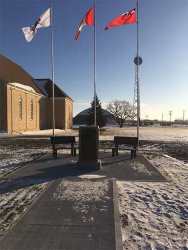
War Memorial, St. Eustache, Manitoba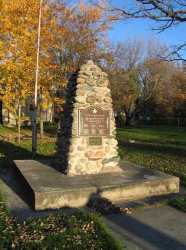
War Memorial, Woodlands, Manitoba
On 29th March the battalion proceeded to the support line trenches in front of Gavrelle. Harry was killed in action the following day, aged 35. He was buried in Villers Station Cemetery, Villers-au-Bois, Grave XII. B. 7. Harry is commemorated on the war memorial in Woodlands, Manitoba, on the St. Eustache War Memorial, Manitoba, on the memorial in Emmanuel Church, Loughborough, and on the Carillon.
Harry's brothers Fred and Sydney also served with the Canadian Expeditionary Force. Fred was wounded in 1915 but both survived the war.
|
|
|
|
Gunner 89026 Stephen Thomas Holt
|
|
116th Heavy Bty. Royal Garrison Artillery.
Died of Wounds 24th February 1918, Aged 32.
Buried Maroeuil British Cemetery IV. G.1.
|
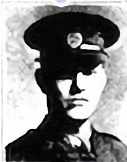
|
Stephen Thomas Holt was born in 1886 in Loughborough. He was the son of Walter Holt and his wife Fanny (née Machin) who were married on 30th January 1882 at the Wesleyan Chapel, Bourne, Lincolnshire. Stephen had one brother Herbert and one sister Hilda Maud, another sibling having died young. Stephen's father was initially a farm labourer and in 1891 the Holt family was living at Far Parks, Nanpantan, but by 1901 he had progressed to the position of farm bailiff at Nanpantan Hall Farm.
In 1901 Stephen, aged 15, was a groom and garden lad and by 1911 and now a full-time groom, was lodging at the Model Farm, Nanpantan. On Christmas Day, 1912 he married Sarah Lizzie Mills, a laundress, at Emmanuel Church, Loughborough. At the time of his marriage Stephen was working as a chauffeur and gardener. Stephen and Sarah went to live at Elm Villa, Forest Road, Loughborough.
Stephen attested at Loughborough on 5th December 1915 and was classed as Army Reserve. He was mobilised on 25th May 1916 and sent, as Gunner 89026, to the Royal Garrison Artillery (RGA) for four months training at their No. 4 Training Depot at Ripon. Here Stephen was part of 175 Heavy Battery.
The Heavy Batteries of the RGA were equipped with heavy guns, sending large calibre high explosive shells in fairly flat trajectory fire. The usual armaments were 60 pounder (5 inch) guns, although some batteries had obsolescent 5 inch howitzers. As British artillery tactics developed, the Heavy Batteries were most often employed in destroying or neutralising the enemy artillery, as well as putting destructive fire down on strongpoints, dumps, store, roads and railways behind enemy lines. These weapons became the first to be hauled by motor tractors rather than horse power and some of the guns were so large that they could only be deployed on railway tracks.
Stephen was sent to France at the beginning of October 1916 and joined 116 Heavy Battery, part of 48 Heavy Artillery Group (HAG), in the field on 4th October. 116 Heavy Battery, part of the 83rd Brigade, was with the Fourth Army and was equipped with six 60-pounder guns. On 28th October Stephen's 116 Heavy Battery moved to 18 HAG and on 2nd December to 62 HAG. Six further moves followed in 1917: to 73 HAG (28th January), 23 HAG (6th February), 45 HAG (22nd May), 24 HAG (7th June), 92 HAG (8th July) and 83 HAG (21st October). 83 HAG subsequently became 83 Brigade.
In 1917 and early 1918 116 Heavy Battery operated in the areas of Sainte- Catherine-lès-Arras and then Ecurie, north of Arras. From 27th October to 5th November 1917 Stephen was granted leave to the UK and on 8th December he was granted Class 1 Professional Pay.
On 16th February 1918 Stephen was admitted to No. 94 Field Ambulance with gunshot wounds to the thigh, hand and face. He died, aged 32, from septicaemia on 24th February in No, 57 Casualty Clearing Station at Anzin-Saint-Aubin, north-west of Arras. He was buried in Maroeuil British Cemetery Grave IV. G. 1.
He is remembered on the memorial in the churchyard of St. Mary's in Charnwood, and on the memorial in Emmanuel Church, Loughborough, as well as on the Carillon.
Stephen's widow moved to 37 Willoughby Road, Bourne, Lincolnshire, and in 1923 married George E. Hemsell, a widowed baker from Austerby, Bourne.
|
|
|
|
Second Lieutenant William Leslie Holt
|
|
10th Bn. York and Lancaster Regiment.
Killed in Action 22nd December 1917, Aged 19.
Buried Spoilbank Cemetery, Zillebeke, II. B. 8.
|
William Leslie Holt was born in 1898 in Leicester and baptised at St Nicholas' Church, Leicester on 2nd April 1898. He was the son of Alfred Holt and his wife Sarah Annie (née Walters) who were married on 16th December 1883 at St. Werburgh's Church, Derby. In 1881 William's father was an Assistant Master at Wyggeston Boys School, Leicester, but he later took Holy Orders and in 1889 became Curate at St. Nicholas' Church, Leicester, while continuing to teach at Wyggeston. When William was born the family was living at 8 Upper King Street, Leicester, William's father later became Vicar of St. Nicholas' Church and the family moved into St. Nicholas' Vicarage until 1911 when he was appointed Vicar of St. James the Greater Church, Oaks-in-Charnwood. William had three sisters Margaret, Dorothy and Millicent. An older brother Alfred Bonham Holt had died in infancy and his sister Dorothy died in 1911 aged 21.
William was educated at Wyggeston Boys' School, Leicester, between 1905 and 1911 and then at Loughborough Grammar School. He joined the Nottingham University Officer Training Corps in June 1916, and was gazetted as a 2nd Lieutenant in the York and Lancaster Regiment on the 28th March 1917.
Posted to the 10th (Service) Battalion of the Regiment William joined his battalion at Beaufort as a Platoon Commander on 2nd June 1917. On 5th and 6th June the battalion moved via Croisette and Heuchin to the training area at Bomy, a village about six miles from Fruges. Here they remained for reorganisation and training until 22nd June when they began marching via Westrehen, Thiennes and Chestre to the Garden Farm Camp at Brulooze. On 28th June the battalion went into the front line trenches at Wystchaete. Several more trench tours followed in July, with breaks at a camp in Kemmel Dranoutre area, but William was sent away on a course of instruction for at least part of July.
From 3rd to 8th August the battalion was in training at Locre. This was followed by the provision of working parties from Rossignol and from the support line at Wystchaete. After three days in Reserve at Kemmel the battalion went into the front line at Hollebeeke at the end of August.
From 2nd- 7th September the battalion was in the support area at Bois Confluent, following which they moved to the Kemmel shelters and then to the camp at Mont Kokereele in the Boeschepe training area until 27th September. The battalion then returned to the trenches on the right of the Ypres-Menin road near Shrewsbury Forest. William, however, was evacuated sick at some point in September. Whether he was with the battalion for all or part of October in the Willebeke trenches, at the camp at Mont Kokereele and at Meteren for road work in the forward area north-east of Ypres is unknown.
November began with the battalion in dugouts at Bois Confluent, followed by time at Dezon Camp on the Locre-La Clytte road and then a trench tour at the Ypres Canal near Klein Zillebeke. In November, however, William was granted leave to the UK. The extent of his leave is unknown but he rejoined his battalion on 30th November.
December commenced with the battalion in the front line, support and reserve trenches at Hollebeke, followed by six days work for the Royal Engineers. From 13th-21st December the battalion was in reserve at De Zon Camp, Scherpenburg, before returning to the front line trenches. William, aged 19, was killed in action south east of Ypres on the 23rd December 1917. He was buried at Spoilbank Cemetery, Zillebeke, Grave II. B. 8.
His Commanding Officer wrote to his parents as follows: 'I need hardly say he is a loss to this battalion as he was so cheerful and willing to do anything for anybody'. Four brother officers, in a joint letter, said: 'Your son proved himself a most excellent soldier and comrade'. An extract from the Loughburian (his old School Magazine) noted: 'He was a mixture of strength and gentleness. Here he was liked and respected and trusted by all'.
William is remembered on memorials at Wyggeston Grammar School, Leicester, Loughborough Grammar School, and St. James the Greater Church, Oaks-in-Charnwood, on the Shepshed War Memorial and on the Carillon.
|
|
|
|
Private 42954 Harry Hopewell
|
|
1st Bn, Cambridgeshire Regiment.
Previously 48225 Leicestershire Regiment.
Died of Wounds 17th October 1918, Aged 37.
Buried Houchin British Cemetery, III. A. 9.
|
Harry Hopewell was born in Loughborough in 1882 and baptised on 10th March 1882 at All Saints Church, Loughborough. He was the son of Henry Hopewell and his wife Alice Mary (née Guess) who were married on 15th October 1881 at All Saints Church, Loughborough. The Hopewell family lived at 98 Leopold Street, Loughborough, for about thirty years and Harry's father was firstly a trimmer at a hosiery dye works and then a shirt trimmer. Harry had two brothers George and Sidney.
In 1911 Harry was living with his brother George, sister-in-law Edith and family at 8 Vicarage Street, Luton, Bedfordshire, and was employed as a labourer in the motor car industry.
Harry was called up in the late summer or early autumn of 1916. He initially joined the Leicestershire Regiment as Private 48225 and was posted to the 6th Battalion of the Leicesters. The dates on which Harry was sent to France and transferred to the 1/1st Battalion of the Cambridgeshire Regiment as Private 42954 are unknown. The 1/1st Battalion, however, received batches of reinforcements from an Infantry Base in the summer and autumn of 1917 and in April and May 1918. Harry could have been in any one of these batches.
In May 1917 the 1st Cambridges were on the Ypres Salient in the Canal Bank and Hill Top Farm area, carrying out night-time raids and patrols. The battalion left the line on 29th May and moved to Wormhoudt. In June the battalion moved to Lumbres and spent time training for trench attacks and open country fighting. While away from the front line they also provided working parties for the Royal Engineers Tunnelling Companies. By the end of June the battalion was back in the trenches around the Hill Top sector.
The battalion remained in the Hill Top and Canal Bank areas until the 15th July when they moved to a camp at Brandhoek and then on to Houlle. At Houlle they spent one week training for a coming offensive. On the 22nd the battalion moved to a camp at St Jan-ter-Biezen for further training and then back to the Brandhoek camp on the 29th. On 30th the battalion moved up to Canal Bank.
When the 3rd Battle of Ypres (or Passchendaele) began on 31st July at Pilckem Ridge the battalion moved out, following the assaulting battalions. In spite of gallant efforts the battalion was eventually forced to pull back, having suffered about 265 casualties.
The residue of the battalion remained at the front until the 5th August when they were relieved. Numerous drafts of replacements reached them from the UK in an attempt to get the battalion back up to strength. The battalion spent the next few weeks resting, refitting and training at various camps behind the Salient. They returned to the front line on the 19th August in the Klein Zillebeke Sector where they remained either in the front line or in reserve for the rest of the month.
During September the battalion completed several trench tours in the area of Hill 60, with breaks in a camp at Dezon. On 25th September they moved into the line in preparation for another attack. After hours of heavy fighting on 26th September the battalion succeeded in occupying much of the German strongpoint Joist Redoubt, but again suffered serious losses.
In early October the battalion was moved to a camp near Kruisstraat where they worked on railway construction. They returned to the line on 28th, initially in reserve but by the 31st they were in the front line
For nearly all of November the battalion remained in the Menin Road - Tower Hamlets area of the Salient, either in the line or at camp. Conditions around the Menin Road were appalling and the trenches and shell holes were mostly flooded. The Salient was quietening down but shelling continued and several enemy night raids were beaten back.
During December the battalion was moved out to Henneveux near Boulogne. They arrived there on the 9th and spent much of the next several weeks training. Christmas Day was spent at rest and a large turkey and goose dinner was organised for the men served by the officers. A heavy snow fall the following day led to an organised battalion snowball fight described by one officer as 'almost as hazardous as Ypres'. On 29th December the battalion began the journey back to Ypres for duty in the Canal Bank area.
In mid-January 1918 the battalion was told it was to move away from the Ypres Salient. On 21st January they marched to Houtkerque and after a few days moved by train to Chipilly. They went into the trenches in the line around Gouzeaucourt, south of Cambrai, on 31st January.
Much of February was spent in the front line around Gouzeaucourt, with breaks at a camp near Dessart Wood. Conditions in the line at Gouzeaucourt were an improvement on life in the Ypres Salient but the cold, shelling and raiding activity caused casualties most days when the battalion was in the line.
The battalion's stay in the line around Gouzeaucourt continued until the 12th March when they were relieved and moved back to Moislains. They were still at Moislains when the German Spring Offensive began on 21st March. The battalion was immediately ordered to move to Longavesnes and prepare an emergency defence line. By 23rd March, with casualties mounting, the battalion was ordered to fight a rearguard action to hold up the enemy. The next week was spent in constant action and slowly the German advance was stalled. The battalion was finally pulled out of the line, having suffered over 380 casualties, on 31st March to Longueau.
The remains of the battalion were joined with the residue from other units into a composite battalion until it could be rebuilt. The composite battalion was slowly moved to Vormezeele, south of Ypres. On 15th April they entered the front line there and remained in the area until 29th April. During this time they were subjected to fierce artillery and gas attack and casualties were heavy. After further mergers of units the battalion took its place in a quieter area in the trenches near Hallebast.
On the 3rd May the battered remnants of the battalion's 39th Division were pulled out and moved to Ruminghem. Here the men were told that the Division would not be rebuilt and the Brigades were being split up, with many battalions merged together. 11 Officers and 408 Other Ranks from the 7th Suffolks were to join the 1/1st Cambridge Battalion. The battalion moved by train to Lealvillers and on to Acheux where the men from the 7th Suffolks joined them. On 20th the reinforced battalion went into the line near Mailly-Maillet. They left the line on the 27th and moved to billets around Raincheval. From 28th May to 21st June the battalion was in training, being formed into a new fighting unit. On 22nd June they moved into the front line.
The battalion left the front on the 9th July and moved back to Herissart, Rumigny and then Canaples. During their stay at the various camps and billets the intense training and preparations continued.
The Allied offensive known as the Hundred Days Offensive was launched on the 8th August. In the sector allotted to the 1/1st Battalion the Germans had launched a surprise attack on the 6th August and captured an area of the British line near the village of Morlancourt. The battalion's role was to take part in the assault on the lost positions and the village of Morlancourt. The attack initially stalled due to stiff defence, and the fighting was brutal but the enemy positions were slowly captured.
The battalion remained in the line until the 19th August when they were moved into reserve. After several days resting and re-equipping they moved into position for the next attack. On the 22nd August the battalion was ordered to attack the area east of Morlancourt, towards the Méaulte Road. The attack began badly as the promised tank support was not there. Progress was slow. Casualties for 22nd August numbered about 137 men. A week of bitter fighting followed, with the battalion making a further attack at Maltz Horn Ridge.
The fighting towards Bapaume continued and the Cambs returned to the line after a day to recover. Slowly the offensive ground down the enemy positions and it was looking like there would be a breakthrough. In torrential rain the assaulting battalions continued to hammer at the German lines and the Cambs held their positions from fierce counter-attacks. After nearly a week of bitter fighting and constant artillery fire the Cambs were ordered to attack once again, this time at Maltz Horn Ridge. The battalion was then withdrawn from the front line to reorganise and rebuild.
In early September the battalion returned to the line and into the attack on 5th September around Nurl amid a heavy enemy gas bombardment. The attack stalled and 87 losses occurred. Another attack on 6th September was much more successful and the Germans retreated.
The battalion's next assault took place on 17th September on the German line running through Epehy. Brutal close quarter fighting took place and eventually, after two more days, Epehy was cleared.
After establishing new posts in front of the line the battalion was relieved on 23rd September and moved back to Epehy. On 26th September they went into support in the Little Priel Farm sector where there was heavy hostile shelling. After being withdrawn from the line to Guyencourt on 30th September the battalion moved by bus to Proyart for reorganisation and refitting.
On 3rd October the battalion entrained at Merignolles for Aubigny and marched to Surburban Camp, Villers-au-Bois. On 5th October they moved by bus to Monument at Thelus and marched to the line near Vimy. From the front line between Fresnoy and Oppy they pushed forward to the Fresnes-Reuvty line and then reached the front of the Quéant-Procourt line. On 12th October they advanced east of Beaumont to the Flers-Hénin-Liétard road where they were very heavily shelled. On 14th October they attacked Auby and encountered heavy hostile artillery.
The exact point when Harry was wounded is unknown but it is likely to have been between 12th and 14th October. Harry died from his wounds, aged 37, in the 6th Casualty Clearing Station at Ruitz on 17th October 1918.
Harry was buried in Houchin British Cemetery, Grave III. A. 9. He is remembered on the memorial in the former St. Peter's Church building, Loughborough, and on the Carillon.
|
|
|
|
Private 12077 Ernest Hopkins
|
|
7th Bn, Leicestershire Regiment.
Died of Wounds 14th July 1916, Aged 20.
Buried Heilly Station Cemetery Somme, II. B. 20.
|
|
Ernest Hopkins was born in 1896 in Loughborough, the son of William Henry Hopkins, a stonemason, and his wife Charlotte (née Condon) who were married in Loughborough in 1886. Ernest had four brothers Walter, Frederick, Thomas and William and four sisters Winifred, Lilian, Nellie and Ivy. In 1901 the family lived at 53 New King Street, Loughborough. Ernest's father died in 1903 and by 1911 his widowed mother had moved with the family to 81 King Street.
Ernest enlisted at Loughborough and joined the 7th (Service) Battalion of the Leicestershire Regiment as Private 12077. On enlistment he would have been sent to Aldershot, Hampshire, for training. In April 1915 the 7th Battalion became part of the 37th Division of the Army and concentrated at Cholderton on Salisbury Plain. On 25th June the 37th Division was inspected by King George V at Sidbury Hill.
Ernest went to France on 25th August 1915 where his battalion gathered with the 37th Division at Tilques, near St. Omer. In September the 7th Battalion was sent to the area of Berles-au-Bois, south-west of Arras. The battalion remained in this area around Bienvillers and Bailleulmont until April 1916 and was engaged in localised operations seeking a tactical advantage. When not in the trenches being subjected to enemy shelling the 7th Leicesters received intensive training in bombing, Lewis gunnery, visual signalling and a host of other activities. In April 1916 they were moved to the Doullens area and formed working parties to cut down trees and prepare brushwood for the front line as well as preparing the support trenches in the area. In May they worked on building a new railway line between Le Bret and Bienvillers-au-Bois. Towards the end of May the battalion returned to the trenches in the Bienvillers-Bailleulmont area.
At the beginning of July the 7th Battalion moved on to the Somme. They were at Fricourt on 13th July and at Mametz Wood and in the attack on Bazentin-le-Petit on the following day. Ernest was hit by a shell in the Battle of Bazentin Ridge near Albert on 14th July and lost both his legs. He died from his wounds, aged 20, and is buried in Heilly Station Cemetery, Méricourt-L'Abbé, Grave II. B. 20.
|
|
|
|
Sergeant 10 Joe Tom Hopkins
|
|
2nd Canadian Divisional Ammunition Column, Canadian Artillery.
Killed in Action 29th October 1917, Aged 31.
Buried Lijssenthoek Military Cemetery, Poperinghe, XXI. AA. 12A.
|
Joe Tom Hopkins was born in Loughborough on 22nd May 1886 and baptised on Christmas Eve 1886 at Emmanuel Church, Loughborough. He was the son of William Hopkins and his wife Mary Ann (née Adkins) who were married on 10th August 1875 at All Saints Church, Loughborough. Joe's father was a millwright and Joe was one of thirteen children in the Hopkins family, eleven of whom survived to adulthood. Joe had seven brothers Ernest, Alfred, Arthur, Percy, Leonard, Bertie and Wilfred and three sisters Florence, Harriett and Ethel. In 1881 the family lived at 18 Union Street, Loughborough, but by 1891 had moved to 19 Broad Street. Ten years later they were living at 5 Dead Lane. The family remained in Dead Lane after Joe's father died in 1910.
In 1901 Joe, aged 15, was a hosiery trimmer but around 1904/5 he left Loughborough and emigrated to Canada. When he attested in Toronto to join the Canadian Expeditionary Force on 2nd March 1915 he was employed as a plasterer's labourer and his medical report noted that he was missing one toe on each foot. He gave his name as 'Joseph Hopkins' rather than 'Joe Tom Hopkins' and said that he was two years younger than he actually was. His religion was said to be Church of England.
After enlistment Joe, now officially Gunner 10 in the Canadian Artillery, was billeted at the Armoury of the Grenadier Guards in Montreal. On 15th May 1915 Joe who was now with the 2nd Canadian Divisional Ammunition Column, Sections 2 and 4, embarked on the SS Corinthian which sailed for England, arriving on 27th May.
In England Joe's unit was sent to Otterpool Camp near Hythe, Kent, for intensive training in the grooming and breaking-in of horses, riding and driving skills, gun drill and gun-laying (including familiarisation with Howitzers), signalling and map reading. On 15th September Joe's unit moved by train to Shorncliffe station and then to Southampton and embarked for Le Havre on 16th September. After concentrating in Le Havre at the prison ship Bassin Belloc the unit entrained again for St. Omer, marched to Hazebrouck and bivouacked.
By 22nd September 1915 the unit was in billets at Berthen and receiving and organising distribution of supplies for different parts of the Canadian Expeditionary Force, including ammunition, road materials, salvage and other essentials. They also arranged for transport of troops and assessed the suitability of buildings for safe storage.
On 20th March 1916 Joe was still at Berthen when he was attached to the 2nd Division Ammunition Sub-Park at Meteren. Here his duties extended to the maintenance of lorries and transport equipment including an official Daimler. On 6th May the Sub-Park moved to Steenvoorde, on 3rd June to Boeschepe, returned to Steenvoorde on 1st July, and moved again to a site on the Abeele-Poperinghe Road on 11th July. On 4th August the Park moved to Quintin Siding and on 6th September relocated further south in the area of Albert and Aveluy.
On 22nd September 1916 Joe was promoted to the rank of Corporal, taken on the strength of the Canadian Artillery Pool and attached to the 4th Canadian Division Ammunition Sub-Park at Mont Rouge Hill near Locre. On 3rd October the Park moved to Rubempré, with the lorries parked on the Puchvillers road. On 13th October the Park received instruction to move to Houdain. On 20th November, while Joe was at Houdain, he was granted leave and may have come to Loughborough to see his family. He rejoined his unit on 3rd December. The Park remained until 8th March 1917 when they moved to Hersin. In Hersin thirty-two lorries were parked in the town square and seventeen on wooden skids at the side of a road in a field they filled with shale. On 8th May 1917 the Park moved to Mount St. Eloi at the junction of Carency road. On 28th July 1917 Joe was granted ten days leave possibly because his mother died around this time.
On 6th September 1917 Joe was promoted to the rank of Sergeant and on 27th September transferred to the 2nd Division Ammunition Sub-Park at Auchel. This unit moved to Steenvoorde on 26th October. Three days later, on 29th October Joe, aged 31, was killed by shellfire while on duty. He was buried at Lijssenthoek Military Cemetery, Poperinghe, Grave 21. AA.12A and is remembered on the Canadian Virtual War Memorial as well as on the Carillon, Loughborough
Most of Joe's brothers also served in the war, Ernest being with the Bedfordshire Regiment, Arthur with the Royal Army Medical Corps and Wilfred with the Army Service Corps. Bertie contracted trench fever and Leonard suffered from gas poisoning. His brothers all seem to have survived the war.
|
|
|
Joseph's Memorial Plaque.
|
|
Private 53075 Tom Edgar Houlson
|
|
20th Bn, The King's (Liverpool Regiment).
Formerly 18786 Leicestershire Regiment.
Killed in Action 13th December 1916, Aged 21.
Buried Berles Position Military Cemetery. B. 3.
|
Tom Edgar Houlson was born in Openshaw, Manchester in 1895. In some records his surname is misspelt as 'Houlston'. He was the youngest son of George Houlson, a schoolmaster from Bristol, and his wife Emily (née Turl) from Rockbeare, Devon, who were married at Bath Register Office in 1879. Tom had three brothers Alfred, Vere and Cyril and one sister Emma. Two other brothers Ernest and Reginald had died young.
Tom's mother died in 1899 and in early 1901 Tom, aged six, was living with his widowed father and Alfred and Cyril at 28 Station Road, Higher Openshaw. Vere had already enlisted with the Royal Engineers and was in Chattenden Barracks, Strood, Kent and Emma's whereabouts are unknown. After Tom's father died later in 1901 the family appears to have split up. In 1911 Tom, aged 14, was in the National Children's Home, Crowthorne Road, Edgworth, near Bolton, Lancashire and working as a farm labourer. Alfred was married and living in Lincoln, Cyril, who in 1906 had been living in Hartington Street, Loughborough, was in lodgings in Lincoln, Vere was in lodgings in Gorton, Manchester and Emma was in service in Gorton.
Between 1911 and 1915 Tom left Lancashire for employment with the Brush electrical engineering company in Loughborough. He enlisted in Loughborough but his service record has not survived and his date of enlistment is unknown. He initially joined the 10th (Service) Battalion of the Leicestershire Regiment as Private 18786 but at some point was transferred to the 20th (Service) Battalion (4th City) of the King's (Liverpool Regiment), a Pals battalion, as Private 53075.
On 10th April 1915 the 10th Battalion of the Leicesters was converted into a Reserve Battalion, moving to Barnard Castle in June and to Rugeley Camp, Cannock Chase in November. Exactly when Tom was transferred to the King's (Liverpool Regiment) is unknown but he appears not to have gone to France before 1916 as he was not awarded the 1914/15 Star medal. Between 4th March and 24th October 1916 the 20th Battalion of the King's received substantial drafts of men as reinforcements on fourteen occasions and Tom could have been among any of these drafts.
During March 1916 the battalion was in the trenches at Maricourt and subjected to fierce enemy fire. Breaks from the trenches were at Etinhem Camp and billets at Corbie. In April the battalion assisted the Royal Engineers with construction work on the light railway, pipelines, roads and shelters at Bray and unloading barges at Froissy Quay. In early May the battalion was back in the Maricourt trenches. This was followed by work with the Royal Engineers Tunnelling Company. From 27th May until 11th June practice attacks on the enemy took place after which the battalion entrained at Ailly-sur-Somme for Heilly and Billon Wood to provide carrying and entrenching parties. By 24th June the battalion had returned to the Maricourt trenches.
At the opening of the Somme Offensive on 1st July the battalion took part in the assault on Montauban and suffered heavy losses, compounded by further losses on the following days until ordered to move to Etinhem on 19th July. Ten days later they were in action again in an attack on Maltz Horn Ridge in the first battle for Guillemont, with further massive losses of men. For most of August the remainder of the battalion was withdrawn from the front line for training but returned to the support lines at Cuinchy on 27th August where they were heavily shelled. From 4th-18th September the battalion was in Brigade Reserve at Hingette, Le Touret and La Pierrière after which they entrained for Doullens and Gezaincourt, marched to Vignacourt and underwent further training until the end of September. On 4th October they moved to Dernancourt to await orders for the Battle of Le Transloy. On 10th October the battalion went into the support position at Bazentin Le Grand, moving up to the assembly trenches at Eaucourt l'Abbaye the next day.
On 12th October the battalion went into the attack at Gueudecourt and came under intense enemy machine gun fire. Two days later they moved away from the front line to a position between Montauban and Bazentin Le Grand. After another two days part of the battalion went into support at Flers and the rest to bivouacs near the transport lines. The whole battalion was in Mametz Wood camp by 22nd October and on 26th October entrained for Doullens to take billets in Halloy. A few days in Divisional Reserve at Pommier followed, with a return to the front line trenches at Fonquevillers on 4th November. Here they remained, with rest periods at Humbercamps and Berles until mid-December.
On 13th December, following a concentrated bombardment on the Monchy Salient by the Corps Artillery a raiding party from the battalion went forward to inspect the enemy trenches. Three men in the raiding party were killed, one of them being Tom Houlson, aged 21. Tom was buried in Berles Position Military Cemetery, Grave B. 3. He is remembered on the Brush Company memorial (in the Carillon War Memorial Museum) as well as on the Carillon.
|
|
|
|
Private 12838 Cephas Howard
|
|
7th Bn, Leicestershire Regiment.
Died 8th November 1918, Aged 33.
Buried Loughborough Cemetery 38/313.
|
Cephas Howard was born in Huddersfield, Yorkshire, on 12th May 1885 and baptised at All Saints Church, Paddock, Huddersfield, on 11th June 1885. He was the son of William Howard and his wife Eliza (née Jackson) who were married in the Melton Mowbray registration area in 1878. Cephas had one brother William and two sisters Eliza Jane and Mary Ann.
When Cephas was baptised his father's occupation was given as 'Operative' (probably in a manufacturing industry). The Howard family moved from Huddersfield to Hindley, Lancashire between 1885 and 1887. Between 1887 and 1891 Cephas' father died and in 1891 Cephas' mother was living with her children at 29 Fidler's Lane, Barton upon Irwell, Lancashire, and taking in lodgers. By 1901 the family had relocated to Wellington Street, Loughborough, and Cephas, aged 15, was a van lad. In 1911 Cephas, who was now known as 'George', was employed as a labourer at the Empress Works in Loughborough, and living with his mother and sister Mary Ann at 3 Moira Street.
Cephas enlisted in Loughborough on 1st September 1914, describing himself as a 'Fitter' from Wellington Street, Loughborough. He joined the 7th (Service) Battalion of the Leicestershire Regiment as Private 12838. From the depot at Glen Parva he was sent to the Salamanca Barracks at Aldershot for training as a signaller. After being sent to the Andover area in March 1915 the battalion moved to Salisbury Plain in April where on 25th June they were inspected by King George V at Sidbury Hill. On 29th July 1915 they received orders to proceed to France. The 7th Leicesters set sail for France on the SS Onward 'in utter darkness and complete silence'. There was no-one to see off the 110th Brigade as ships leaving full of 'Tommies bound for France' were no longer exciting.
In September the 7th Battalion was sent to the area of Berles-au-Bois, south-west of Arras. The battalion remained in this area around Bienvillers and Bailleulmont until April 1916 and was engaged in localised operations seeking a tactical advantage. When not in the trenches being subjected to enemy shelling the 7th Leicesters received intensive training in bombing, Lewis gunnery, visual signalling and a host of other activities. In April 1916 they were moved to the Doullens area and formed working parties to cut down trees and prepare brushwood for the front line as well as preparing the support trenches in the area. In May they worked on building a new railway line between Le Bret and Bienvillers-au-Bois. Towards the end of May the battalion returned to the trenches in the Bienvillers-Bailleulmont area.
At the beginning of July the 7th Battalion moved on to the Somme. They were at Fricourt on 13th July and at Mametz Wood and in the attack on Bazentin-le-Petit on 14th July. After the Bazentin Ridge battle the battalion marched away from the Somme and entrained for part of the journey to Hangest. On 6th August they took over a section of battered trenches at Agnez-lès-Duisans, near Arras. After ten days training at Denier and Sars-le-Bois the battalion entrained for the Somme on 12th September and bivouacked outside Montauban north-east of Bernafay Wood. On 25th September they fought very bravely and successfully at Gueudecourt in an action which was part of the Battle of Morval.
On 4th October the battalion entrained once more for the north and the countryside of Loos, taking over positions opposite the Hohenzollern Redoubt with rest billets at Mazingarbe, Philosophe, or Vermelles. On 7th October Cephas was given 14 days of Field Punishment No. 1 for drunkenness. One month later he was promoted to the rank of Lance Corporal, a rank later revoked at his own request.
Training at Cauchy-à-la-Tour and Houtkerque followed until 12th February 1917. On 13th February the battalion entrained at Proven for Fouquerieul and marched to billets in the tobacco factory in Béthune. Moving on to Labourse they were back in the trenches in the Hohenzollern sector on 15th February, going up to the front line on 21st February. Breaks from the trenches were taken in Noyelles. In March 1917 the battalion experienced what one soldier called 'the bombardment of our lives'.
On 29th March the battalion entrained at Noyelles for Saulty-L'Arbret and marched to La Cauchie and on to Moyenville. On 4th April the battalion went into the front line at St. Leger Croisilles, with breaks at Moyenville. From 15th to 23rd April the battalion was in training at Bailleulval before returning to the trenches at St. Leger Croisilles.
On 28th April the battalion was in action at the Battle of Arleux and on 3rd May at the 2nd Battle of Bullecourt, taking part in an attack on Fontaine-lès-Croisilles. On 3rd May Cephas was one of 116 casualties, with a gunshot wound to his hand. From No. 44 Field Ambulance he was sent to No. 22 Casualty Clearing Station at Bruay and then admitted to No. 3 General Hospital at Le Tréport. On 13th May he was discharged to No. 3 Convalescent Depot at Le Tréport and on 5th June joined No. 12 Infantry Base Depot at Calais.
Cephas rejoined his battalion on 28th June which was in Reserve south-east of Croisilles and undergoing training. During July the battalion was in the front and support line trenches at Adinfer Wood and on 28th July, Cephas was admitted to No. 64 Field Ambulance with debility. He rejoined the battalion in the trenches at Moyenville on 12th August. Relieved on 18th August the battalion moved to Hamelincourt.
On 25th and 26th August the battalion marched to Gouy-en-Artois and then Beaufort for training. After a further move to Hauteville for more training and a football tournament and boxing competition, both of which the 7th Leicesters won, on 16th September the battalion entrained at Savy station for Caestre.
On 23rd September the battalion marched to Berthen. On 26th September they moved by bus to Scottish Wood and then to Bedford House as reserve in the forward area. After two days rest at Micmac Camp the battalion was back in the forward area on 29th. The 3rd Battle of Ypres had been raging for two months and the ground was full of water-logged shell holes, which had to be negotiated over duckboards. The 7th Leicesters joined the battle on the night of the 30th September, marching up to Polygon Wood, which had been captured by the Australians. The 9th Leicesters took over positions in the right half of the Polygon sector just outside the wood with the 7th Battalion behind them in support and the 6th Leicesters in reserve.
On 1st October the enemy began a heavy barrage. The Leicesters nevertheless pushed forward. An intense artillery duel followed on 2nd October before the battalion was relieved and marched south-east of Zillebeke Lake to Wiltshire Farm. On 4th October the battalion moved up again to south of Zillebeke Lake, bivouacking there. On the following day they were back in the support line west of Polygon Wood.
On 6th October, when two companies moved up to the front line at Reutel with the other two companies in support, Cephas was wounded in action, with gunshot wounds to his hand and face. From No. 64 Field Ambulance he was sent to No. 37 Casualty Clearing Station, Godewaersvelde, and from there to No. 5 General Hospital, Rouen. From 27th October until the end of 1917 Cephas was in a Convalescent Depot. On 1st January 1918 he joined K Infantry Base Depot and on 19th January 1918 rejoined the 7th Leicesters at Haut Allaines.
On the 20th January the battalion moved to Epehy by light railway and began another trench tour before moving into Brigade Reserve at Saulcourt on 28th. From 4th-13th February Cephas was granted leave and may have returned to Loughborough. When he returned from leave his battalion was in training at Moislains, after which they moved to B Camp, Templeux-la-Fosse to work on the trenches and railway at Flamincourt.
On 24th February, when the battalion had just arrived at Adrian Camp, Villers-Faucon, for wiring work and trench digging, Cephas was admitted to a field ambulance with trench fever. On 5th March he was sent to No. 12 General Hospital, Rouen, and on 13th March returned to England on the hospital ship St. Andrew. Two days later he was admitted to the Northumberland War Hospital, Gosforth, Newcastle upon Tyne.
Trench fever infected more than 1 million frontline troops in WW1. Symptoms included a relapsing fever, headache, dizziness, lumbago, and shin pain. In 1918 two commissions identified that the disease was louse-borne by the bacterium Rickettsia Quintana, later renamed Bartonella Quintana. The bacterium was also found to cause endocarditis, peliosis hepatis, and bacillary angiomatosis.
Cephas had a very severe case of trench fever which caused vascular damage to his heart. He spent over four months in hospital confined to bed. On 27th August 1918 he was discharged from the Army with a pension and returned home to Loughborough. He died in Loughborough, aged 33, on 8th November 1918.
Cephas was given a military funeral and was buried in Loughborough Cemetery, Grave 38/313. In addition to the 15 Star, British War and Victory Medals he was also awarded a Silver War Badge.
|
|
|
|
Private G/15074 Harry Howard
|
|
12th Bn, Royal Sussex Regiment.
Killed in Action 17th October 1916, Aged 28.
Commemorated Thiepval Memorial, Somme, pier & face 7 C.
|
Harry Howard was born in 1888 in Loughborough, the son of Henry Howard and his wife Elizabeth (née Mills) who were married at All Saints Church, Loughborough, on 15th November 1879. In 1881 Harry's father was a labourer in an iron foundry but ten years later he was a joiner's labourer, later becoming a sawyer and then a filler's labourer. His mother was a hosiery seamer. Harry had an older brother Arthur and an older sister Alice. In 1891 the Howard family lived at 18 Queen Street, Loughborough, but by 1901 had moved to 26 Union Street.
Harry's mother unfortunately died in 1903, aged 47, and in the following year Harry's father married a widow Alice Pollard, who brought three of her younger children Arthur, Elizabeth and Ernest Pollard into the household which was now at 26 Havelock Street, Loughborough. By 1911 Harry's brother Arthur and sister Alice were living with relations elsewhere in Loughborough, but where Harry was at this time is unknown.
Harry's service papers have not survived and it is therefore impossible to establish when he enlisted with the Leicestershire Regiment as Private 4607. At some point he transferred to the 12th (Service) Battalion of the Royal Sussex Regiment (2nd South Down) as Private G/15074 but again the date of transfer is unknown. It is possible, however, that he was sent to France in March 1916 when the 39th Division of the Army received substantial reinforcements which included the 12th Battalion of the Royal Sussex Regiment. Alternatively he may have joined the 12th Battalion of the Royal Sussex Regiment in France on 24th July 1916 or 4th or 12th September 1916 when the battalion received drafts of extra men. One detail is certain - Harry was not in France before 1916 as he was not awarded the 1914/15 Star Medal.
In March 1916 the 12th Battalion of the Royal Sussex Regiment, having landed at Le Havre, joined its Army division which was concentrating at Blaringhem. The battalion then moved via Morbecque, Estaires, Fleurbaix, La Gorgue, Caudescure and Riez- du-Vinage to the Givenchy sector where it went into the front line from 15th -30th April. The month of May was spent in the village line at Festubert with rest periods at Le Touret or Chocques. In June the battalion was in the village line or front line at Cuinchy and Ferme du Bois with rest periods at Le Quesnay. On 30th June the battalion attacked the enemy at Ferme du Bois near Richebourg l'Avoué and suffered heavy casualties.
July was spent in village trenches at Annequin and the front line trenches near Cuinchy with billets at Festubert and Le Hamel. On 6th August the battalion took over the village line at Givenchy. Between 14th and 22nd August training took place in Monchy-Breton following which the battalion moved to Englebelmer and reconstructed the front line in front of Hamel amid continual enemy shelling.
On 3rd September the battalion successfully attacked the enemy's position near the River Ancre but were unable to hold the position. They returned to Englebelmer for a period of training until 10th September when they took over the front line at Auchonvillers. After a break in billets at Beausart they went into the trenches at Redan where they were heavily shelled.
They remained in the Auchonvillers area in October and moved to the Schwaben Redoubt on 15th where a heavy enemy barrage caused many casualties. On 17th October the enemy began a particularly heavy bombardment of the Redoubt with 28 inch shells. The casualty figures were 5 officers and 156 other ranks. Harry Howard, aged 28, was one of those killed in action. Harry is commemorated on the Thiepval Memorial, Pier and Face 7C |
|
|
|
Gunner 189659 James Howlett
|
|
3rd Siege Bty, Royal Garrison Artillery
Died of Wounds 5th October 1918, Aged 33.
Buried Unicorn Cemetery, Vendhuile, Aisne, I. A. 16.
|
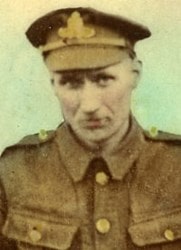 |
James Howlett was born in New Quorn in 1885. He was the youngest child of Thomas Howlett and his wife Mary Ann (née Deeming) who were married at St. Peter's Church, Claybrooke Parva, Leicestershire, on 7th February 1869. In 1871 James's father was a house servant at Hale Farm, Copt Oak, before moving with his wife to New Quorn and becoming a farm labourer. In 1901 James, aged 15, was a market gardener's assistant. James had two older brothers William and John and two older sisters Sarah and Elizabeth. Three other siblings died young.
On Christmas Day 1907 James married Eliza Tyler at the Church of St. Mary the Virgin, Wymeswold. James and Eliza went to live with James's parents at 6 Sarson Street, Quorn, and by 1911 had two children Thomas James (known as 'Jim') and Sidney. Between 1911 and 1917 they had three more children Edward, Doris and John.
James enlisted on 11th December 1915. At the time of his enlistment he was a quarryman. He was counted as Army Reserve and was subsequently posted to the Royal Garrison Artillery (RGA) for training as Gunner 189659. James's service record has survived but is very fire-damaged and much of the text is unreadable. It seems, however, that James was trained at No. 4 Depot of the Royal Garrison Artillery (RGA) at Ripon and that in 1917 he was admitted to hospital with a fracture. He was sent to France on 27th April 1918 and on 15th May 1918 joined No. 3 Siege Battery from the artillery base.
Siege Batteries only kept separate diaries until the beginning of 1918, when Heavy Artillery Groups were redesignated as Brigades of the RGA. In March 1918 the 3rd Siege Battery was under 85th Heavy Brigade, RGA, attached to the 2nd Army, and the brigade was moved up and down the front to positions where the commanders thought it would be of most use. Between August and September 1918 the 2nd Army was involved in the Advance in Flanders.
The point at which James was wounded is unknown but he died in the Field Hospital at Bellenglise on 5th October 1918, aged 33. He was buried in Unicorn Cemetery, Vendhuile, Aisne, Grave I. A. 16.
James is also commemorated on the Quorn Memorial.
|
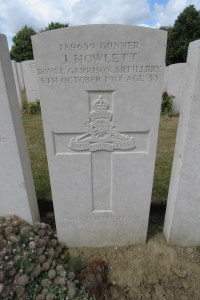 |
|
Private 8/11942 Thomas Hudson
|
|
8th Bn, Leicestershire Regiment.
Killed in Action 16th May 1916, Aged 21.
Buried Bienvillers Military Cemetery, I. A. 89.
|
Thomas Hudson was born in Loughborough in 1894 and registered at birth as 'Tom Hudson'. He was the son of Thomas Hudson, an engine fitter in the hosiery business, and his wife Fanny Hudson (née Hunt) who were married in Loughborough in 1893.
Tom had one younger brother George and three younger sisters Elizabeth, Doris and Nellie. In 1901 the family lived at 50 Cobden Street, Loughborough, but by 1911 they had moved to 20 Queen's Road. In 1911 Tom was an assistant in Hurst's boot shop, Church Gate.
Tom enlisted at Loughborough in 1914 as 'Thomas Hudson' and joined the 8th (Service) Battalion of the Leicestershire Regiment as Private 11942. He was initially sent to Aldershot for training and then to Shorncliffe in Kent at the end of February 1915. In April 1915 Tom's battalion became part of the newly established 37th Division of the Second New Army and the Division began to concentrate on Salisbury Plain. On 25th June the units were inspected by King George V at Sidbury Hill. On 22nd July 1915 the Division began to cross the English Channel and Tom travelled to France on 29th July 1915. The 8th Battalion then moved via Watten, Houlle, St. Omer, Eecke and Dranoutre to Wulverghem and Berles-au-Bois, a short distance from the front line. In the months that followed the 8th Battalion did tours in the trenches, alternating with the 6th Leicesters who relieved them.
In April 1916 the 8th Leicesters moved to the Doullens area for six weeks for cleaning up, resting and training. In mid-May the 8th Leicesters returned once more to the trenches in the Bienvillers-Bailleulmont sector. It was here that Tom was killed in action by the explosion of an enemy trench mortar bomb on 16th May 1916, aged 21. He is buried at Bienvillers Military Cemetery, Pas de Calais, Grave I. A. 89. The same bomb also caused the death of Tom's friend and comrade, Private Albert Wilkinson of Chapman Street, from the Empress Works. Tom and Albert were buried in adjacent graves.
At the time Tom died his younger brother George was in the King George Military Hospital, Stamford Street, London. He was recovering from wounds in the head caused by shrapnel (sustained three months previously) and was not immediately told of his brother's death. George survived the war.
|
|
|
|
Corporal 46699 Frank Hueck
|
|
8th Bn, Northumberland Fusiliers.
Formerly 12058 Leicestershire Regiment.
Died of Wounds 19th June 1917, Aged 19.
Buried Bailleul Communal Cemetery III. D. 66.
|
Frank Hueck was born in Burton on Trent, Staffordshire, on 15th August 1897 and baptised at St. Paul's Church, Burton on Trent on 11th July 1898. He was the son of Jean (or John) Baptiste Hueck (or Heuck, or Husek, or Hughes) and his partner Jane Coates. Evidence suggests that Frank's father Jean Baptiste Hueck was born in Charlotte Amalie, St. Thomas, Virgin Islands, and that he was the son of Charles Hueck, an unmarried cigar maker of Dutch origin, and Janey Bagagoine, a former black slave. Frank's parents had met when his father, who had come to England, was lodging at Mount Pleasant Inn, Canal Side, Burton on Trent. Jane Coates was the publican's stepdaughter.
Frank had three brothers John William, Albert and Edwin and three sisters Jane, Annie and Margaret. Jean Baptise Hueck was a builders' labourer and the Hueck family moved around from Burton on Trent, to London and to Loughborough. In 1891 they lived at 5 Greenclose Lane, Loughborough, in 1901 at 8 Hallam's Row, Albert Street, Horninglow, and by 1911 had returned to 5 Greenclose Lane. Frank became a member of the Emmanuel Church Lads Brigade.
Frank enlisted in Loughborough in August 1914 when he was 17 years old and joined the Leicestershire Regiment as Private 12058. He later transferred as Private 46699 to the 8th (Service) Battalion of the Northumberland Fusiliers and was subsequently promoted to Acting Corporal. His service records have not survived and his date of transfer and promotion are unknown but at the time he enlisted he was employed by the Nottingham Manufacturing Company Ltd. in Loughborough.
It is likely that Frank joined the Northumberland Fusiliers which was part of the Army's 11th (Northern) Division sometime after July 1916. In late July 1916 the 8th Battalion was centred at Flesselles, Somme and In August the battalion was doing trench tours in the area of Wailly, south-west of Arras. In the evening of 14th September they took part in the storming and capture of German trenches including the Wundt-Werk (Wonder Work). They were also in action at the Battle of Flers-Courcelette on 15th-22nd September, and the Battle of Thiepval Ridge on 26th-28th September. In the latter battle they suffered heavy casualties in operations at Zollern Redoubt and Stuff Redoubt on 27th September. At the end of September the battalion returned to trench tours in the area of Acheux. From January to March 1917 the Division was involved in the Operations on the Ancre and from 7th to 14th June in the Battle of Messines.
Frank was wounded in June 1917 while his battalion was holding the line near Bailleul. He was taken to No. 2 Casualty Clearing Station at Bailleul where he died of his wounds on 19th June 1917. He was only 19 years old. He was buried in Bailleul Communal Cemetery Extension, Grave III. D. 66.
Frank is remembered on the memorial in Emmanuel Church, Loughborough, and on the Carillon. His name also appears on a bell in the Carillon, the gift of the Nottinghamshire Manufacturing Company Ltd, in memory of their employees lost in the war. Frank is also listed on the war memorial in St. Luke's Church, Parliament Street, Derby, possibly because his brother Albert lived in Derby. Albert Hueck served with the Leicestershire Regiment and survived the war.
|
|
|
|
Private 15774 William Caleb Hulin
|
|
7th Bn, Leicestershire Regiment.
Killed in Action 6th October 1917, Aged 34.
Commemorated Tyne Cot Memorial, panel 50 - 51.
|
William Caleb Hulin was born in Loughborough in 1883, He was the son of Sidney Joseph Hulin, a coachbuilder, and his wife Sarah Ann (née Howell) who were married at St. Thomas' Church, Birmingham, on 20th March 1876. William had one brother Charles and two sisters Sarah and Lilian. In 1891 the Hulin family lived at 30 Canal Bank, Bridge Street, Loughborough, but by 1901 had moved to 30-31 High Street. By 1901 both William and his brother Charles had followed their father and become coach builders. William's mother died in 1909 and by 1914 William had become engaged to marry Rachel Betsy Yeomans, daughter of Arthur Yeomans, licensee of the Station Hotel, Derby Road. William was secretary of the Station Hotel Bowling Club.
William enlisted on 30th October 1914 at Leicester and joined the Leicestershire Regiment as Private 15774. From the depot at Glen Parva he was sent on 7th November to the Salamanca Barracks at Aldershot to join the 7th (Service) Battalion in training. After being sent to the Andover area in March 1915 the battalion moved to Salisbury Plain in April where on 25th June they were inspected by King George V at Sidbury Hill. On 29th July 1915 they received orders to proceed to France. The 7th Leicesters set sail for France on the SS Onward 'in utter darkness and complete silence'. There was no-one to see off the 110th Brigade as ships leaving full of 'Tommies bound for France' were no longer exciting.
On 9th August William was sent to No. 86 1/2nd Northumbrian Field Ambulance with stomach problems. He recovered and in September was sent with the 7th Leicesters to the area of Berles-au-Bois, south-west of Arras. The battalion remained in this area around Bienvillers and Bailleulmont until April 1916 and was engaged in localised operations seeking a tactical advantage. When not in the trenches being subjected to enemy shelling the 7th Leicesters received intensive training in bombing, Lewis gunnery, visual signalling and a host of other activities. In April 1916 they were moved to the Doullens area and formed working parties to cut down trees and prepare brushwood for the front line as well as preparing the support trenches in the area. In May they worked on building a new railway line between Le Bret and Bienvillers-au-Bois. Towards the end of May the battalion returned to the trenches in the Bienvillers-Bailleulmont area.
On 12th June William was sent to the 37th Infantry Base Depot at Etaples and on 28th June was attached to the 13th (County of London) Battalion (Princess Louise's Kensington Battalion) of the London Regiment. At the time the 13th Londons were at Souastre. On 30th June the battalion moved up to the assembly area at Hébuterne. On 1st July, the start of the Somme Offensive, the battalion went into attack and casualties numbered 17 Officers and 310 Ordinary Ranks. Four days in the trenches opposite Fonquevillers and the north-east side of Gommecourt Park followed before a return to billets in Souastre. Further trench work and working parties at Sailly and Bayencourt ensued.
On 20th August the battalion moved to Halloy and from there on 22nd marched to Doullens, entrained for St. Riquier and marched to billets in Millancourt. Training took place at Millancourt until 2nd September, after which the battalion entrained at St. Riqueur for Corbie and marched to Sailly-le-Sec. From the front line trenches at the Citadel on the Bray-Fricourt road they were ordered to take the front line enemy trench but were withdrawn from an attack on Ginchy as the trenches were too crowded. On 14th September they were ordered to protect the flank of the 6th Division near Combles and establish a line south and east of Morval as soon as a forthcoming operation to capture Morval was completed. This operation on 25th September was successful but the battalion was not required apart from providing carrying parties and afterwards moved via Morlancourt for training at the Citadel.
Back in the front line from 3rd October the battalion mounted an attack in the area of Le Transloy but were twice repulsed and subsequently began a series of moves via Trônes Wood, Mansel Camp, and Ville sur Ancre to Vaux en Amienois, Wanel and then Laventie for training until 30th October. On 1st November the battalion was back in the Fauquissart sector.
On 12th November William was in the Casualty Receiving Section with inflamed leg tissue and on 26th November was transferred to the Casualty Clearing Station. On 9th December he was admitted to No. 64 Field Ambulance. After he recovered he was posted to No. 12 Ordnance Depot on 22nd January 1917 and then to No. 8 Ordnance Depot on 21st February. His service record from this point is unclear although he appears to have remained with No. 8 Ordnance Depot until 4th May 1917. Whether he was subsequently posted back to the 7th Leicesters is therefore unknown.
William was killed in action, aged 34, on 6th October 1917 near Ypres. He is commemorated on the Tyne Cot Memorial, Zonnebeke, Panels 50-51, and on the Carillon.
His Lieutenant wrote to his father as follows: 'I am a poor hand at sympathy, but I can tell you one thing. Out yonder the regiment and myself have lost a splendid fellow. We are more companions than anything else. He was killed instantly by a bullet, which went just below the heart. Although I had to leave the line that night I gave strict instructions that he was to be properly buried. He was well loved by all the boys'.
|
|
|
William's Memorial Plaque.
|
|
Trooper 423 Walter Hutt
|
|
3rd Australian Light Horse
Died from an aneurysm of the aorta and cardiac failure 13th June 1915 at Base Hospital, St. Kilda Road, Melbourne, Australia.
Buried Coburg Pine Ridge Cemetery, Coburg, Victoria, Australia, Grave C.E.D. 442.
|
Walter Hutt (occasionally called Walter Hutt Perkins) was born on 21st September 1868 in Loughborough. He was brought up by his grandmother Elizabeth Hutt (née Collins) and her husband Thomas Hutt, a hosiery framework knitter of 29 Union Street, Loughborough. Walter's mother is likely to have been Elizabeth Hutt's own daughter Elizabeth, latterly of 4 Court B, Baxtergate, Loughborough. His grandmother, her husband and Walter's probable mother had all died by 1910.
Walter attested on 22nd November 1885 and joined the 3rd Leicestershire (Militia) Regiment, aged 17 years 2 months, as Private No. 956. At the time he was a hosiery worker for a Mr. Morley and was living at 29 Union St, Loughborough. He then served for a number of years with the 7th Hussars, in Secunderabad and Mhow, India.
On 20th August 1895 Walter made a declaration for the Civil Service as a Candidate for the position of Prison Officer and in the same year he married Fanny Wardle in Loughborough. Walter and Fanny went to live in Leicester where their children Walter, Doris, Arthur, Cecil and Dorothy were all born. In 1901 Walter was living with his family and was a gaoler.
In 1914 Walter was working as a prison gaoler in Tasmania and living at 46 Bathurst Street, Hobart. On 18th August 1914 he attested at Pontville, Tasmania, and was appointed as Private No. 423 in C Squadron of the Third Australian Light Horse Regiment. He stated that his wife lived at 9 Dover Street, Leicester, England and also that he had worked for 10 years in the Colonial Foreign Office and had served for 16 years with the 7th Hussars.
The Third Australian Light Horse C Squadron embarked from Hobart, Tasmania, on board HMAT A2 Geelong on 20th October 1914 for Egypt.
On 18th February 1915 at the 1st Australian General Hospital in Heliopolis Walter was diagnosed as having a heart problem. He said that he had first noticed something wrong when he was at Albany Encampment, Victoria, Australia, in 1913.
He was given two months leave and the Medical Board recommended that he be discharged from service. He left from Suez for Australia on the Ulysses on 22nd March 1915. On 13th June 1915 he died at the Base Hospital, St. Kilda Road, Melbourne from an aneurysm of the aorta and cardiac failure. Walter Hutt is commemorated on the Australian War Memorial at Canberra as well as on the Carillon.
|
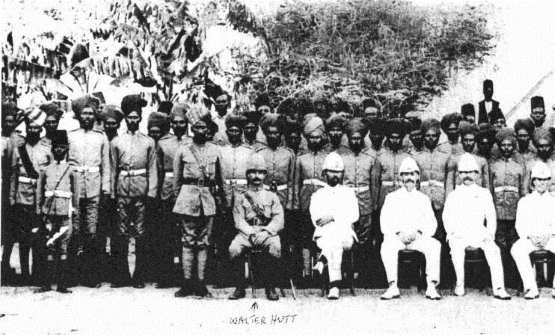 Front row, second from the left - Walter Hutt serving with the 7th Hussars in India
Front row, second from the left - Walter Hutt serving with the 7th Hussars in India
|
|
Private 7121 Thomas Hutton
|
|
2nd Bn, Royal Scots.
Killed in Action 26th September 1917, Aged 39.
Buried La Brique Military Cemetery no 2, I. M. 29.
|
Thomas Hutton was born in Quorn in 1881, the son of James Hutton and his wife Emma (née Scotney) who were married in Quorn in 1877. He was baptised on 20th April 1888 at St. Bartholomew's Church, Quorn. Thomas's father was a carpenter and joiner and in 1891 the family lived in New Quorn, moving later to a cottage in Loughborough Road, Quorn. Thomas had one brother James and four sisters Clara, Eliza, Edith and Ethel. Two other brothers Albert and Harry and two other sisters Alice and Mary had died young.
Thomas enlisted with the Royal Scots (Lothian Regiment) in 1900. He was sent as Private 7121 to join the 1st Battalion of the Regiment in South Africa for service in the 2nd Boer War and remained there until 1903. The battalion was placed in the 3rd Division under the command of Sir William Gatacre and much of the time was spent on mobile column work, patrolling and raiding expeditions rather than being engaged in any major battles. They provided support in the relief of Wepener in April 1900, cleared the enemy from Zwaggershoch in September 1900 and from the autumn of 1900 to the close of the war operated in the Eastern Transvaal, some doing garrison work around Balmoral and Middleburg and some companies trekking. Thomas was awarded the King's South Africa Medal.
In 1906 Thomas was transferred to the Army Reserve, became a brickyard labourer and came to live at 6 Park Row, Loughborough. On 3rd July 1909 he married Mary Ann Page (known as 'Polly') at Emmanuel Church, Loughborough. In 1911 Thomas and Polly were living with Polly's parents at 120 Belvoir Road, Coalville. With them was Polly's son Thomas Charles who was born in March 1909 not long before Thomas and Polly were married and whose father has never been disclosed. They subsequently moved to 19 Chapel Terrace, Southfield Road, Loughborough.
When war broke out in 1914 Thomas, as a Reservist, was recalled. Posted to the 2nd Battalion of the Royal Scots he was sent to France with a batch of reinforcements on 7th September 1914 and joined the battalion at Chauffry on the advance towards the River Aisne. Having crossed the river but unable to penetrate the German defensive position on the heights and after suffering from much German artillery fire the battalion withdrew back across the Aisne on 25th September and marched to Courcelles.
In early October 1914 the battalion was moved to Cornet Malo, north of Béthune, with orders to advance north-east to secure the Pont du Hem - Neuve Chapelle road. Following action in the Battles of La Bassée and Messines the battalion moved into reserve at Aubers and La Pluiche. Trench tours in the area of Chapigny-Fauquissart road ensued. In early November the battalion was in support near Le Tournay and Richebourg St. Vaast and in the front line trenches at Neuve Chapelle with breaks at La Couture and Bailleul. After a move to Neuve Eglise in mid-November the battalion was in the trenches at Messines and Wulverghem before moving to Westoutre and then Locre. From the trenches at Kemmel the battalion attacked the enemy on 14th December incurring more than a few casualties.
1915 began with training at Scherpenberg followed by trench tours at Kemmel, Wyschaete, and Vierstraat with breaks at La Clytte until 12th May, The battalion next moved to trenches north of Hill 60 in the Zillebeke sector. On 16th June the battalion was in action at the 1st Battle of Bellewaarde before moving to bivouac near Poperinghe for several weeks training. On 12th July they were ordered to take over trenches south of Hooge where they remained, apart from one break at Brandhoek, until 7th August. The remainder of August and first part of September were spent at Dickebusch resting, route marching and practising attacks. On 12th September the battalion returned to the trenches at Hooge before a break at huts on the Ouderdom road. By 24th September the battalion was in the trenches at Sanctuary Wood and took part in an attack on 25th September in which casualties were very high. A further attempt to drive the enemy out of the Salient was made on 30th September. Trench tours in the Sanctuary Wood area continued until 23rd October when the battalion moved to Steenvoorde for rest, parades and sporting activities.
From 29th November 1915 to 5th February 1916 the battalion did trench tours at St. Eloi, with breaks at Reninghelst camp, after which they moved via Bayenghem and Poperinghe to Dickebusch. From 27th March to 16th April they took part in the actions of the Bluff and St. Eloi Craters, where large explosive charges were blown under the German defences. May included trench tours at Vierstraat. On 21st June they left the Ypres Salient, entraining at Hopoutre for Moulle in the Pas de Calais. After instruction at Moulle they entrained at Wizernes for Candas, Somme, on 1st July and marched to billets in Berneuil.
Over the summer and autumn of the Somme Offensive they were in action at the Battles of Albert, Bazentin (where they helped to capture Longueval), Delville Wood and the Ancre (where they met stiff resistance). At the end of August the battalion moved by train and march to Mazingarbe and the trenches in the Hulluch sector to hold the line near the Hohenzollern Redoubt. After training in Coyecque at the end of September they moved again to Acheux for further instruction and working parties until 18th October. A further move for trench tours in the Serre sector took place on 23rd October, where they were heavily shelled, with breaks at Vauchelles.
On 29th November 1916 until 28th January 1917 the battalion did trench tours at Hébuterne, with rest and training at Berteaucourt. Training continued at La Thieuloye until 9th February, followed by trench digging at Beaufort and Liencourt and working parties at Arras, with breaks at Magnicourt and Liencourt, until 4th April. In April the battalion was in action in three battles of the Arras Offensive - the 1st and 2nd Battles of the Scarpe and the Battle of Arleux, after which there was a short period when they provided working parties at Tilloy. Much of May was spent in training at Izel-lès-Hameau prior to a return to the trenches at Arras and Monchy for repair work, followed by instruction at Estrée-Wamin in June. By 1st July the battalion had moved to the Louverval sector for trench tours, with breaks at a camp near Vélu, north-west of Haplincourt. On 28th August the battalion transferred to huts in the area of Ytres-Léchelle for attack practice and tactical exercises and on 19th September marched via Proven to a camp near Poperinghe. Having transferred to a camp south of Ypres on 23rd September the battalion went into the support line trenches on either side of the Ypres-Zonnebeke road.
On 26th September 1917 the Battle of Polygon Wood (a phase in the 3rd Battle of Ypres or Passchendaele) began. Thomas, aged 39, was killed in this action. He was buried in La Brique Military Cemetery No. 2, St. Jean-Les-Ypres, Grave I. M. 29. Thomas is commemorated on the Carillon Memorial in Loughborough and on two war memorials in Quorn (the War Memorial at The Cross and the memorial at St. Bartholomew's Church) near where members of his mother's family lived.
Thomas's brother James who served with the Royal Field Artillery was killed in action only ten days after Thomas and is remembered on the Tyne Cot Memorial. Thomas's widow Polly was remarried to William Mellors in 1920 in Loughborough and she and William had a daughter Violet that same year.
|
|
|
|
|


